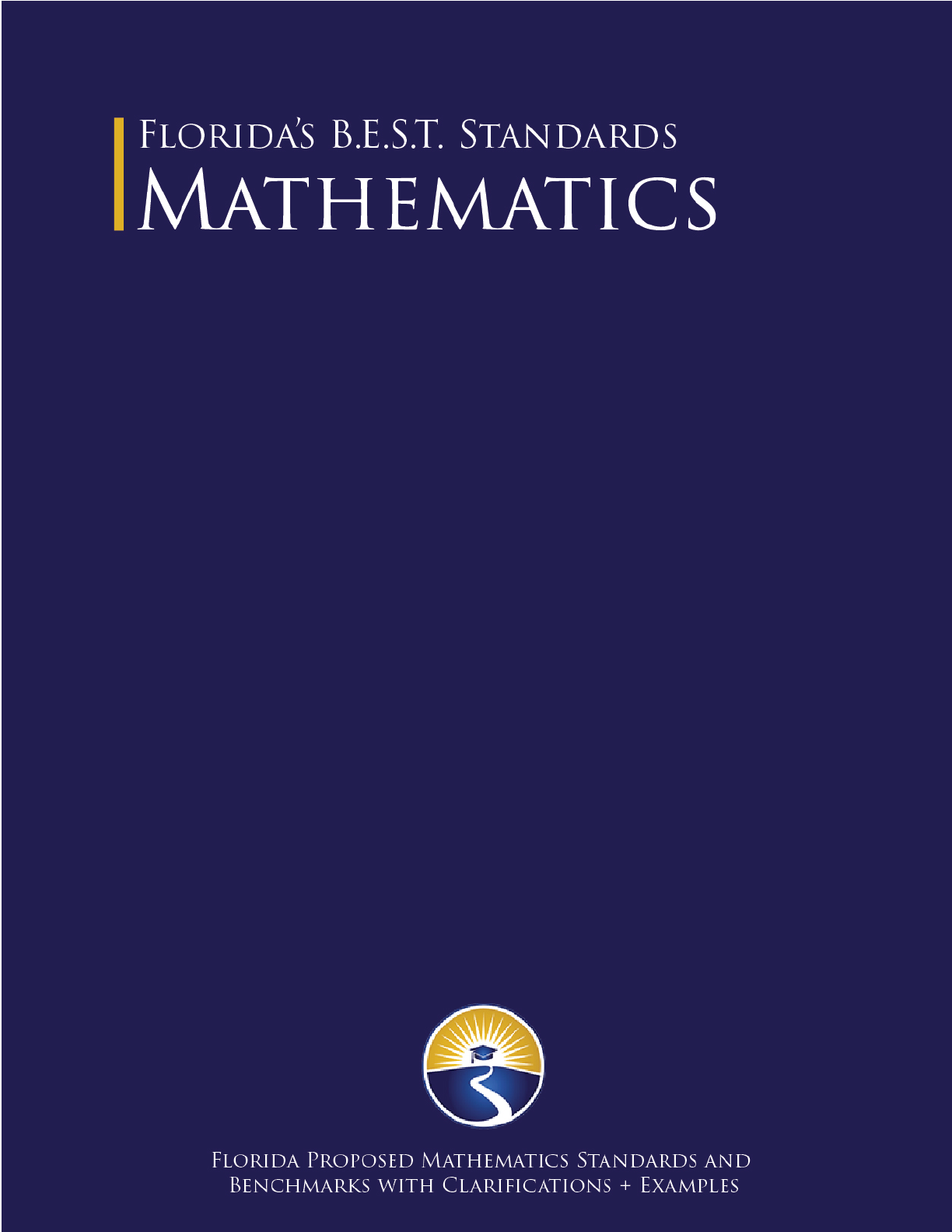

Table of Contents
An Introduction ................................................................................................................... 1
Florida’s B.E.S.T. Standards for Mathematics Coding Scheme ..................................... 3
Progression of Florida’s B.E.S.T. Standards for Mathematics ....................................... 4
Fluency with Arithmetic Operations and Automaticity with Basic Arithmetic Facts .... 5
Mathematical Thinking and Reasoning Standards ............................................................ 7
Mathematical Thinking and Reasoning Standards ......................................................... 8
Standards for Mathematics K-5 ........................................................................................ 12
Kindergarten ................................................................................................................. 13
Number Sense and Operations .................................................................................. 13
Algebraic Reasoning ................................................................................................. 15
Measurement ............................................................................................................. 16
Geometric Reasoning ................................................................................................ 17
Data Analysis and Probability .................................................................................. 18
Grade 1 .......................................................................................................................... 19
Number Sense and Operations .................................................................................. 19
Fractions .................................................................................................................... 21
Algebraic Reasoning ................................................................................................. 21
Measurement ............................................................................................................. 23
Geometric Reasoning ................................................................................................ 24
Data Analysis and Probability .................................................................................. 25
Grade 2 .......................................................................................................................... 26
Number Sense and Operations .................................................................................. 26
Fractions .................................................................................................................... 28
Algebraic Reasoning ................................................................................................. 28
Measurement ............................................................................................................. 30
Geometric Reasoning ................................................................................................ 31
Data Analysis and Probability .................................................................................. 32
Grade 3 .......................................................................................................................... 34
Number Sense and Operations .................................................................................. 34
Fractions .................................................................................................................... 36

Algebraic Reasoning ................................................................................................. 38
Measurement ............................................................................................................. 40
Geometric Reasoning ................................................................................................ 41
Data Analysis and Probability .................................................................................. 43
Grade 4 .......................................................................................................................... 44
Number Sense and Operations .................................................................................. 44
Fractions .................................................................................................................... 46
Algebraic Reasoning ................................................................................................. 49
Measurement ............................................................................................................. 51
Geometric Reasoning ................................................................................................ 52
Data Analysis and Probability .................................................................................. 53
Grade 5 .......................................................................................................................... 55
Number Sense and Operations .................................................................................. 55
Fractions .................................................................................................................... 57
Algebraic Reasoning ................................................................................................. 59
Measurement ............................................................................................................. 62
Geometric Reasoning ................................................................................................ 62
Data Analysis and Probability .................................................................................. 64
Mathematics 6-8................................................................................................................ 66
Grade 6 .......................................................................................................................... 67
Number Sense and Operations .................................................................................. 67
Algebraic Reasoning ................................................................................................. 70
Geometric Reasoning ................................................................................................ 74
Data Analysis and Probability .................................................................................. 76
Grade 7 .......................................................................................................................... 78
Number Sense and Operations .................................................................................. 78
Algebraic Reasoning ................................................................................................. 79
Geometric Reasoning ................................................................................................ 82
Data Analysis and Probability .................................................................................. 84
Grade 8 .......................................................................................................................... 87
Number Sense and Operations .................................................................................. 87

Algebraic Reasoning ................................................................................................. 89
Functions ................................................................................................................... 91
Geometric Reasoning ................................................................................................ 92
Data Analysis and Probability .................................................................................. 94
Mathematics 9-12 Courses: Algebra 1 and Geometry ..................................................... 96
9-12 Course Overview .................................................................................................. 97
Algebra I ................................................................................................................... 97
Geometry ................................................................................................................. 109
Mathematics 9-12............................................................................................................ 116
9-12 Overview ............................................................................................................ 117
9-12 Number Sense and Operations Strand ............................................................ 118
9-12 Algebraic Reasoning Strand ........................................................................... 121
9-12 Functions Strand ............................................................................................. 133
9-12 Financial Literacy Strand ................................................................................ 137
9-12 Geometric Reasoning Strand .......................................................................... 140
9-12 Trigonometry Strand ....................................................................................... 147
9-12 Data Analysis and Probability Strand ............................................................. 150
9-12 Logic and Theory Strand ................................................................................ 157
9-12 Calculus Strand ............................................................................................... 160
Appendix A: Situations Involving Operations with Numbers ........................................ 164
Situations Involving Addition and Subtraction .......................................................... 165
Situations Involving Multiplication and Division ...................................................... 166
Appendix B: Fluency and Automaticity Chart .............................................................. 167
Fluency and Recall with Automaticity throughout Grade Levels .............................. 168
Appendix C: K-12 Mathematics Glossary ...................................................................... 171
K-5 Mathematics Glossary ......................................................................................... 172
6-12 Mathematics Glossary ........................................................................................ 184
Appendix D: Properties of Operations, Equality and Inequality ................................... 204
Properties of Operations ............................................................................................. 205
Properties of Equality ................................................................................................. 206
Properties of Inequality ............................................................................................... 207

1
Introduction
Access to high-quality education is a fundamental value provided to Florida’s students through
the Florida Constitution. It is in the best interest of all Floridians to give our children the
B.E.S.T., Benchmarks for Excellent Student Thinking, an education fully preparing them for
success. Florida leaders have a duty to ensure students are prepared to be civically engaged and
knowledgeable citizens who positively impact our communities.
To reach these goals, Florida’s B.E.S.T. Standards for Mathematics were developed with input
from thousands of Floridians and countless hours of work from dedicated Florida educational
leaders and mathematics teachers. Through this work, Florida’s leaders are sending a strong,
clear message that they are unwilling to be complacent. Our students are capable of
unprecedented success. It is our responsibility to implement the infrastructure necessary to help
them thrive.
High-quality academic standards are the foundation of a high-quality system to which
assessments and instructional materials must be aligned. With these new and improved
standards, Florida builds on past strengths and learns from past lessons. Built on the foundations
of reading, writing, and arithmetic, our state standards are the B.E.S.T. in the nation.
Florida’s B.E.S.T. Standards for Mathematics reflect the concerns of parents, feedback from
stakeholders and the practical experience of teachers. These new standards will lay the
foundation for higher quality instructional materials, streamlined assessments, and ultimately
high school graduates fully prepared for the responsibilities associated with American
citizenship.
Throughout this year-long process of evaluating, listening, rethinking and ultimately rewriting
Florida’s standards, the Department engaged numerous stakeholders, including many educators,
repeatedly, through a multi-faceted public input process. The success of this process was rooted
therein, in the collective thought and input of many Floridians who held student-centered results
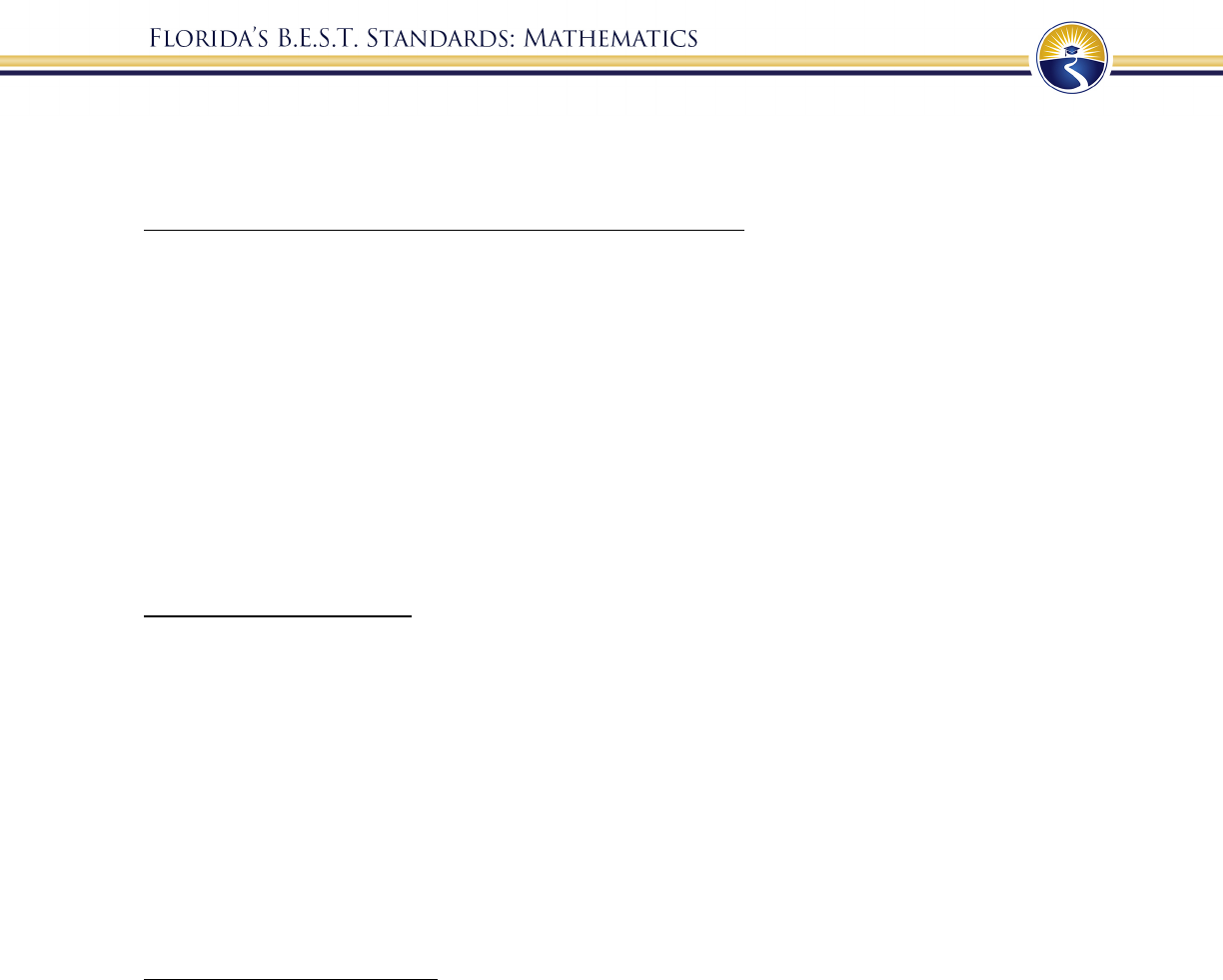
2
close to heart. Therefore, in addition to the B.E.S.T. standards herein, it is also recommended
that this review process be repeated every seven years, if not sooner.
Development of Florida’s B.E.S.T. Standards for Mathematics
The development of these standards and benchmarks is based upon Executive Order 19-32
issued by Governor Ron DeSantis on January 31, 2019. Florida’s B.E.S.T. Standards for
Mathematics were written by workgroups consisting of Florida mathematics teacher experts. The
teacher experts represent the individuals in Florida who have leadership roles in K-12
mathematics and the Florida College System. Throughout the development of the proposed
standards and benchmarks, the workgroups were focused on writing standards and benchmarks
that are clear, concise and provide enough guidance so that districts, test developers, publishers
and other related stakeholders are able to align curriculum, instruction and assessment. The
mathematics teacher expert workgroups drew on the work of the National Council of Teachers of
Mathematics (NCTM); expectations from national and international assessments such as ACT,
SAT, NAEP and TIMSS; comments from public and specialty stakeholders and feedback from
national mathematics and standards experts.
Changes and Improvements
• Simplicity
There is less emphasis now on students using multiple strategies just for the sake of
multiple strategies. Parents will better understand their children’s work in
mathematics.
• Practicality
Statements that were unnecessarily complicated, or too difficult to implement, are
streamlined. Statements are more focused now on the learning goal, with less
verbiage than before about the means to get there.
• Specificity
Florida’s B.E.S.T. Standards for Mathematics 9-12 are organized in a way that allows
for multiple pathways for the students of Florida.
Guiding Principles for Change
• High Expectations
Florida’s B.E.S.T. standards were designed to provide students with a world class
education. These standards maintain high expectations for Florida’s students,
ensuring equity and access for all.
• Clarity
Florida’s B.E.S.T. standards were written to provide clear and concise language for students,
parents, and educators. Clarifications were included to ensure a comprehensive understanding
of the intentions of the benchmarks and to increase transparency of expectations.
• Alignment
Florida’s B.E.S.T. standards are a consistent progression of mathematical strands, ensuring
vertical alignment across grade levels and horizontal alignment at the course level.
The Florida Department of Education would like to thank all of the Floridians that contributed to
this project. In particular, we would like to thank the teacher experts who served on review
committees to represent Florida teachers and students.
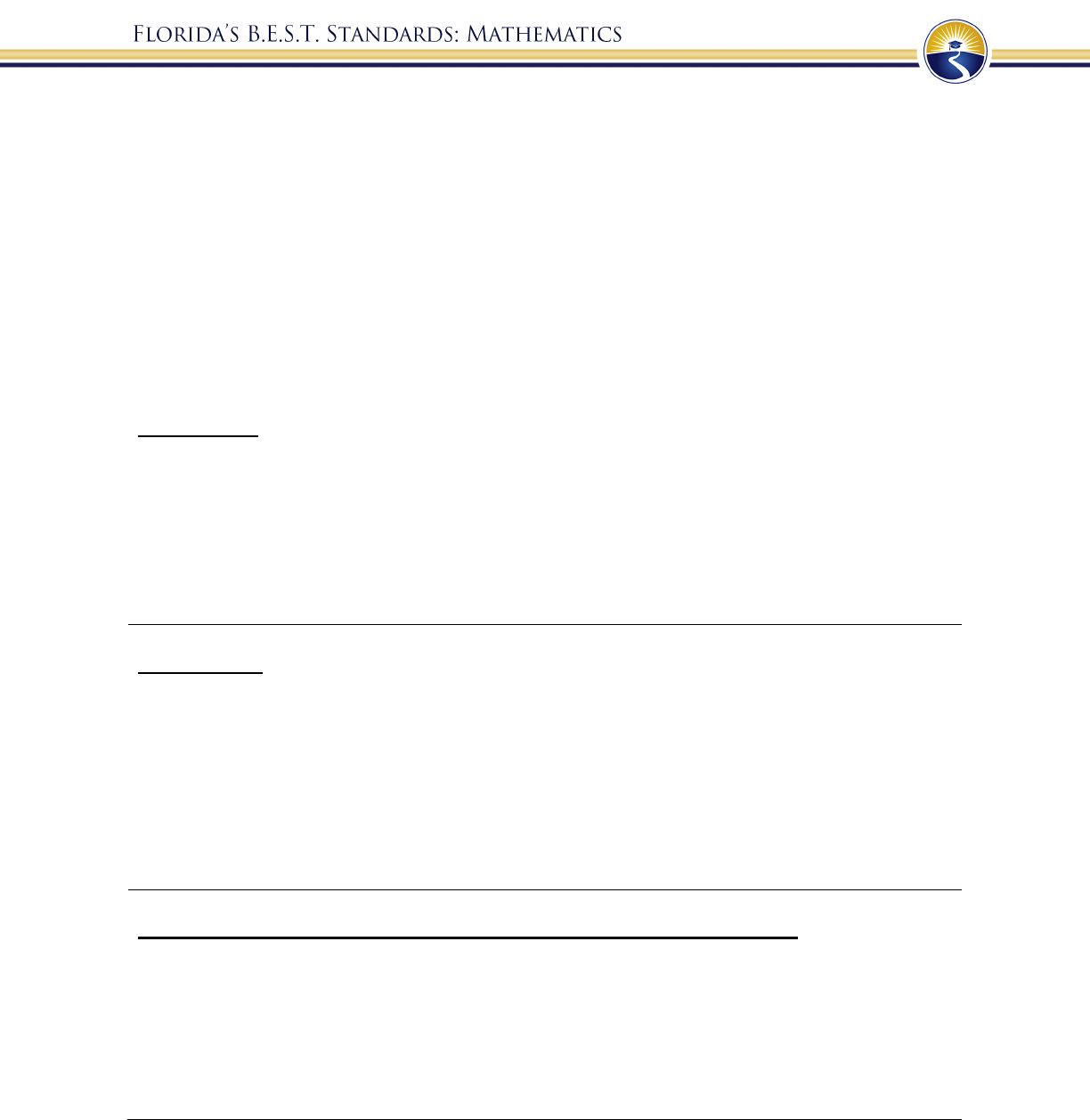
3
Florida’s B.E.S.T. Standards for
Mathematics Coding Scheme
Florida has a unique coding scheme defined by 5-character places in an alphanumeric
coding: the subject, grade level, strand, standard and benchmark. For Kindergarten through grade
8, the coding scheme is defined by each individual grade level. For grades 9-12, the scheme is
banded and organized by strands. The strand is a focal group of related standards. Standards are
overarching criteria for the grade level or grade band. The benchmark is a specific expectation
for the grade level or grade band that falls within the standard. The mathematical content within
the benchmarks is to be learned during the year and mastered by the end of the year. It is
important to note that benchmarks from different strands may be closely related because
mathematics is an interconnected subject.
K-8 Example
Subject
Grade Level
Strand
Standard
Benchmark
MA.
2.
NSO.
2.
1
Mathematics Grade 2
Number Sense
and
Operations
Add and subtract
two- and three-
digit whole
numbers.
Recall addition facts
with sums to 20 and
related subtraction facts
with automaticity.
9-12 Example
Subject
Grade Level
Strand
Standard
Benchmark
MA.
912.
GR.
3.
4
Mathematics Grades 9-12
Geometric
Reasoning
Use coordinate
geometry to solve
problems or prove
relationships.
Solve mathematical and
real-world problems on
the coordinate plane
involving perimeter or
area of polygons.
Mathematical Thinking and Reasoning Standards for Students Example
Subject
Grade Level
Strand
Standard
Benchmark
MA. K12. MTR. 6. 1
Mathematics
Kindergarten
through grade
12
Mathematical
Thinking and
Reasoning
Assess the
reasonableness of
solutions.
no meaning
It is important to note that the 5th place will always be a “1” for the Mathematical Thinking and
Reasoning Standards for Students. The “1” has no meaning but serves as a placeholder in
fulfilling Florida’s unique coding scheme.
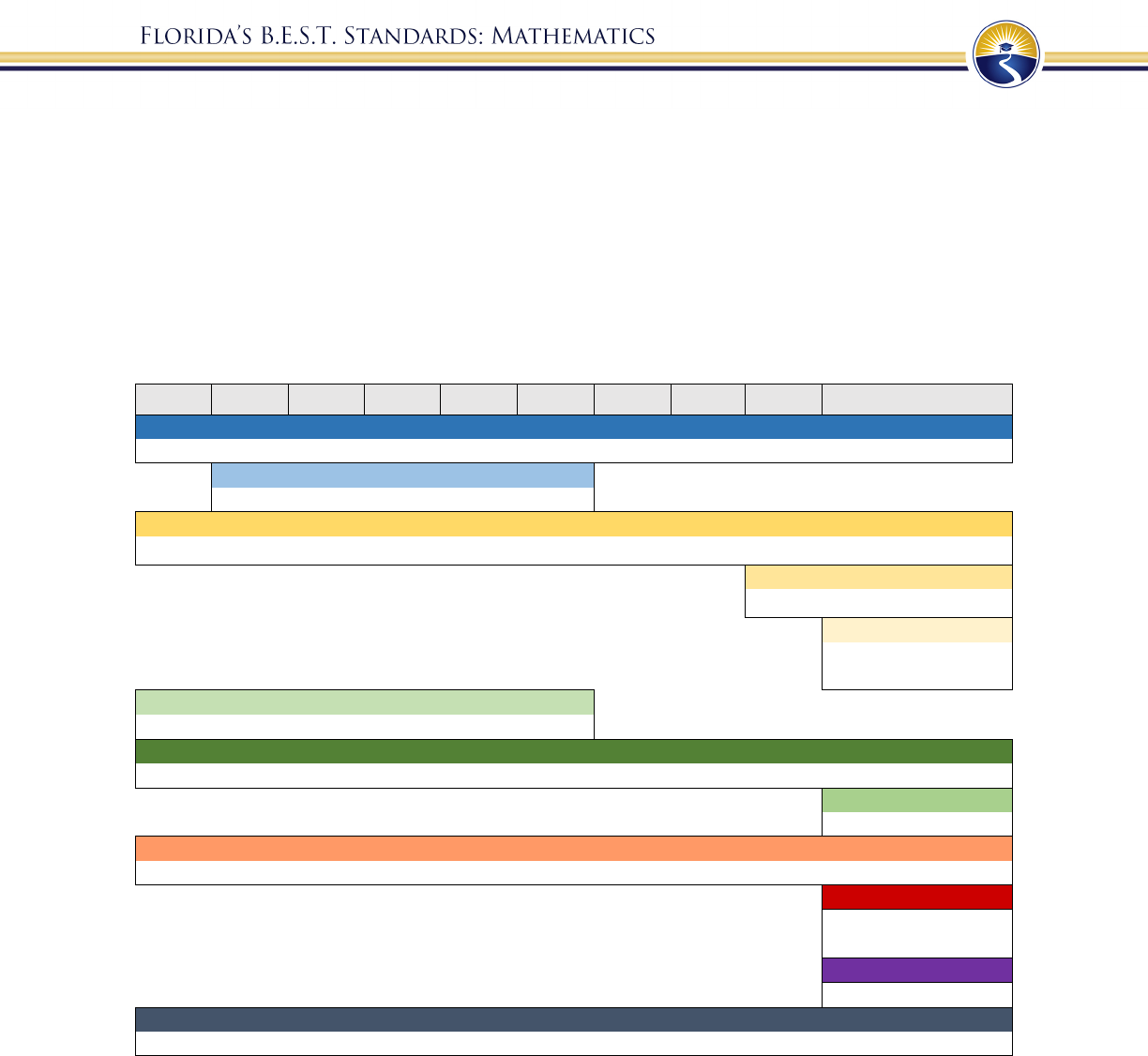
4
Progression of Florida’s B.E.S.T. Standards
for Mathematics
The table below illustrates the Florida’s B.E.S.T. strands. For each strand in Kindergarten
through grade 12, the shaded areas indicate the grade levels where it is addressed. Strands with
similar mathematical content are shaded with a different variation of color. These strands support
the major strands (Number Sense and Operations, Algebraic Reasoning, Geometric Reasoning
and Data Analysis and Probability) in various grade bands. Most of the strands span multiple
grade levels, which lends itself to the progression of mathematics and the coherence across
courses.
K
1
2
3
4
5
6
7
8
9-12
Number Sense and Operations (NSO)
Fractions (FR)
Algebraic Reasoning (AR)
Functions (F)
Financial Literacy
(FL)
Measurement (M)
Geometric Reasoning (GR)
Trigonometry (T)
Data Analysis and Probability (DP)
Logic and Theory
(LT)
Calculus (C)
Mathematical Thinking and Reasoning Standards (MTR)
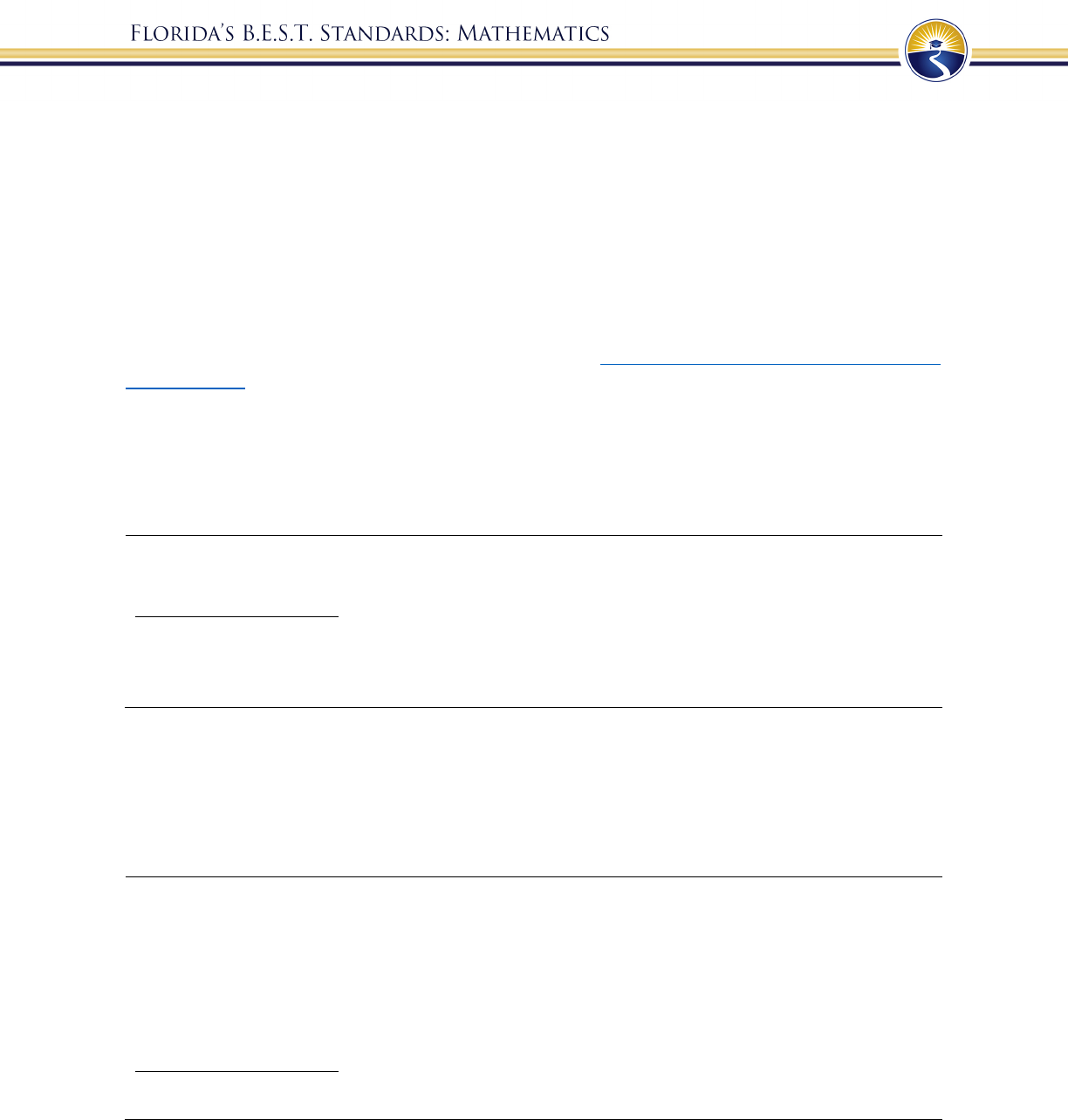
5
Fluency with Arithmetic Operations and
Automaticity with Basic Arithmetic Facts
Throughout this document, benchmark expectations regarding arithmetic operations
within the Number Sense and Operations (NSO) strand have been developed with a hierarchy in
mind consisting of three stages: exploration, procedural reliability and procedural fluency.
Students will first explore arithmetic operations with no fluency expectations, then will be able
to show procedural reliability and finally they will carry out these operations with procedural
fluency. Interwoven into this hierarchy is the development of direct recall of basic arithmetic
facts. Basic arithmetic facts are first derived, then utilized while becoming procedurally reliable
or fluent and finally recalled with automaticity. Refer to Appendix B: Proficiency and Procedural
Fluency Chart.
Stage 1: Exploration
The expectation is to develop understanding through the use of manipulatives, visual models,
discussions, estimation and drawings. An example of an “exploration” benchmark is shown
below.
MA.1.NSO.2.4
Explore the addition of a two-digit number and a one-digit number with
sums to 100.
Benchmark Clarifications:
Clarification 1: Instruction focuses on combining ones and tens and composing new tens from ones,
when needed.
Clarification 2: Instruction includes the use of manipulatives, number lines, drawings or models.
Stage 2: Procedural reliability
The expectation is to utilize skills from the exploration stage to develop an accurate, reliable
method that aligns with the student’s understanding and learning style. Students may need the
teacher’s help to choose a method, and they will learn how to use a method without help. An
example of a “procedural reliability” benchmark is shown below.
MA.2.NSO.2.3
Add two whole numbers with sums up to 100 with procedural reliability.
Subtract a whole number from a whole number, each no larger than 100, with
procedural reliability.
Example: The sum 41 + 23 can be found by using a number line and “jumping up”
by two tens and then by three ones to “land” at 64.
Example: The difference 87 25 can be found by subtracting 20 from 80 to get 60
and then 5 from 7 to get 2. Then add 60 and 2 to obtain 62.
Benchmark Clarifications:
Clarification 1: Instruction focuses on helping a student choose a method they can use reliably.
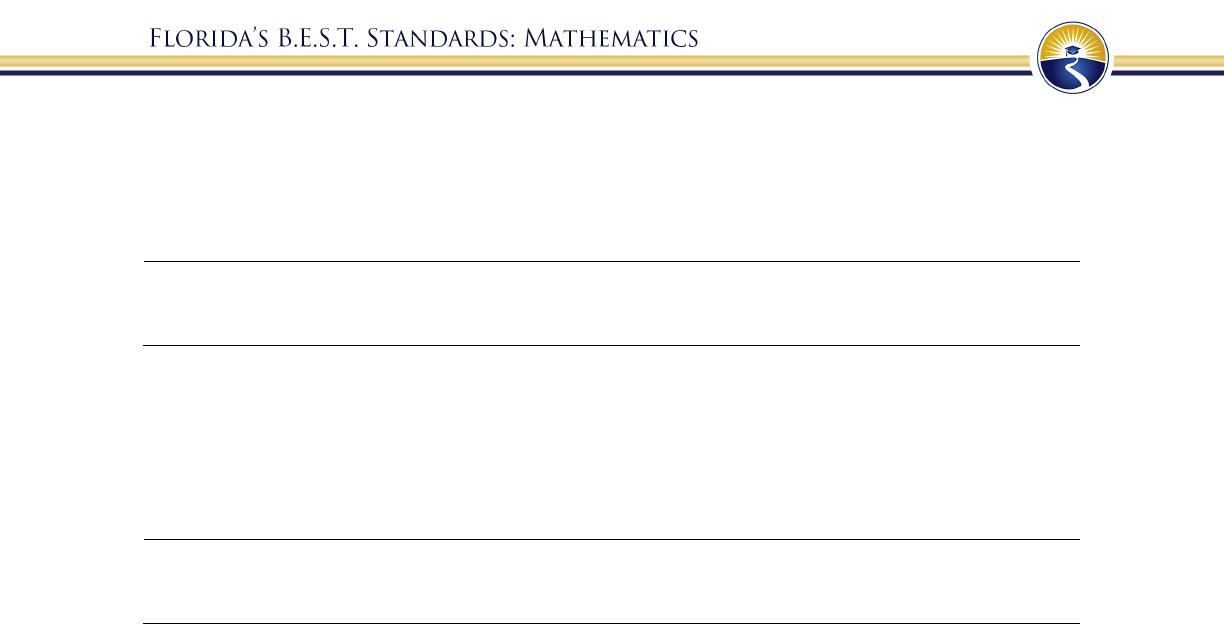
6
Stage 3: Procedural fluency
The expectation is to utilize skills from the procedural reliability stage to become fluent with an
efficient and accurate procedure, including a standard algorithm. An example of a “procedural
fluency” benchmark is shown below.
MA.3.NSO.2.1
Add and subtract multi-digit whole numbers including using a standard
algorithm with procedural fluency.
Embedded within Stage 1 – Stage 3: Automaticity
The expectation is to directly recall basic arithmetic facts from memory. Automaticity is the
ability to act according to an automatic response which is easily retrieved from long-term
memory. It usually results from repetition and practice. An example of an “automaticity”
benchmark is shown below.
MA.2.NSO.2.1
Recall addition facts with sums up to 20 and related subtraction facts with
automaticity.
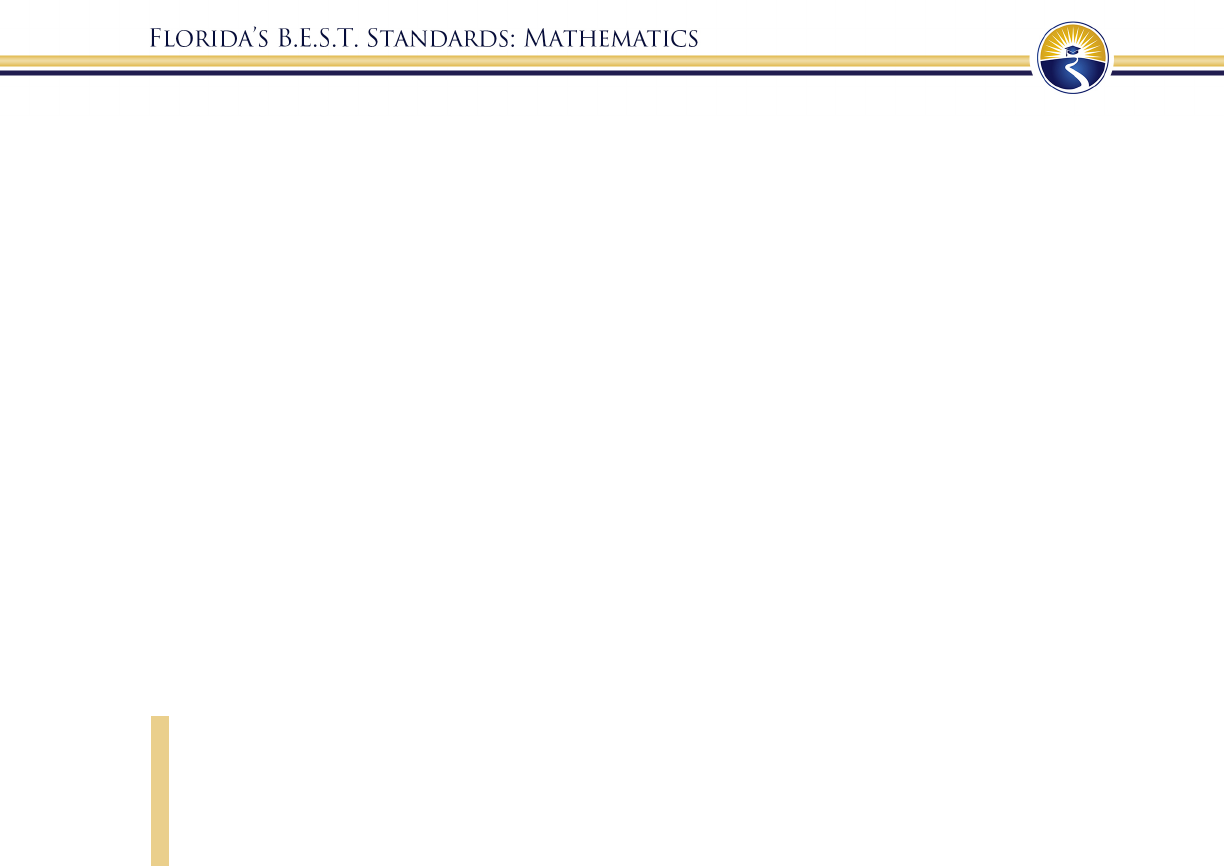
7
Mathematical Thinking and
Reasoning Standards
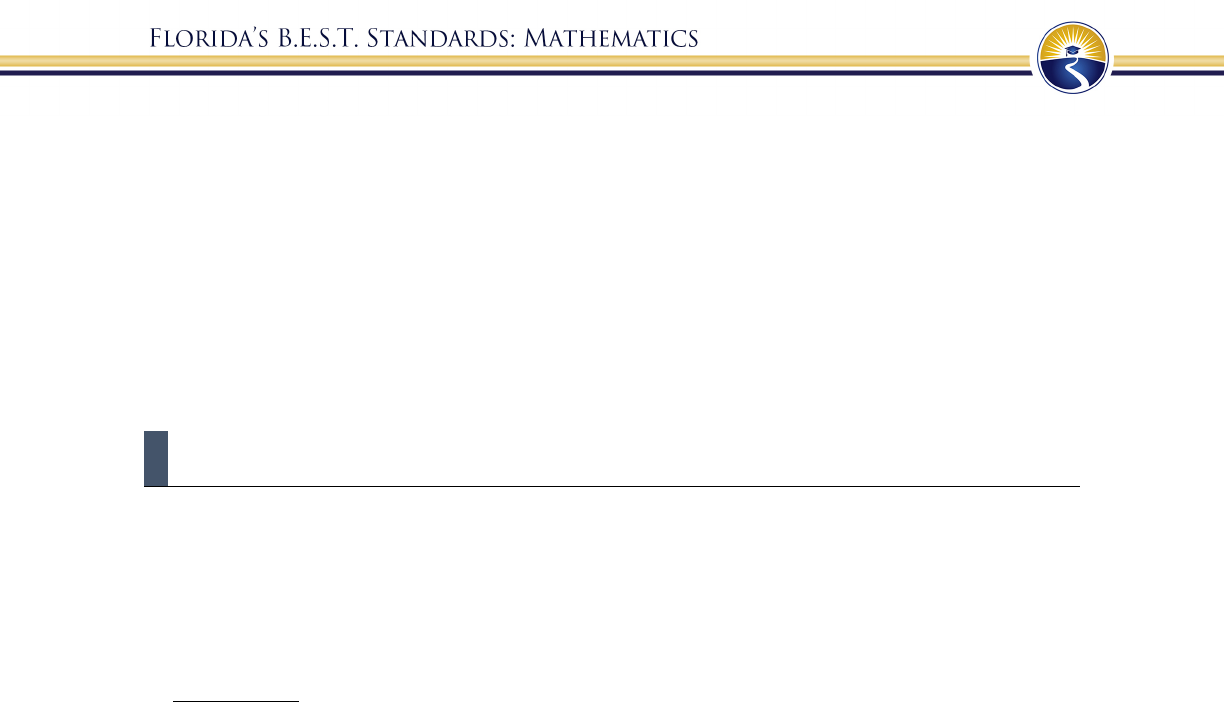
8
Mathematical Thinking and Reasoning Standards
MTR: Because Math Matters
Florida students are expected to engage with mathematics through the Mathematical
Thinking and Reasoning (MTR) Standards. These standards are written in clear language so all
stakeholders can understand them and students can use them as self-monitoring tools. The MTR
Standards promote deeper learning and understanding of mathematics. The clarifications are
included to guide teachers in the integration of the MTR Standards within mathematics
instruction.
MA.K12.MTR.1.1 Actively participate in effortful learning both individually and
collectively.
Mathematicians who participate in effortful learning both individually and with others:
• Analyze the problem in a way that makes sense given the task.
• Ask questions that will help with solving the task.
• Build perseverance by modifying methods as needed while solving a challenging task.
• Stay engaged and maintain a positive mindset when working to solve tasks.
• Help and support each other when attempting a new method or approach.
Clarifications:
Teachers who encourage students to participate actively in effortful learning both individually and
with others:
• Cultivate a community of growth mindset learners.
• Foster perseverance in students by choosing tasks that are challenging.
• Develop students’ ability to analyze and problem solve.
• Recognize students’ effort when solving challenging problems.
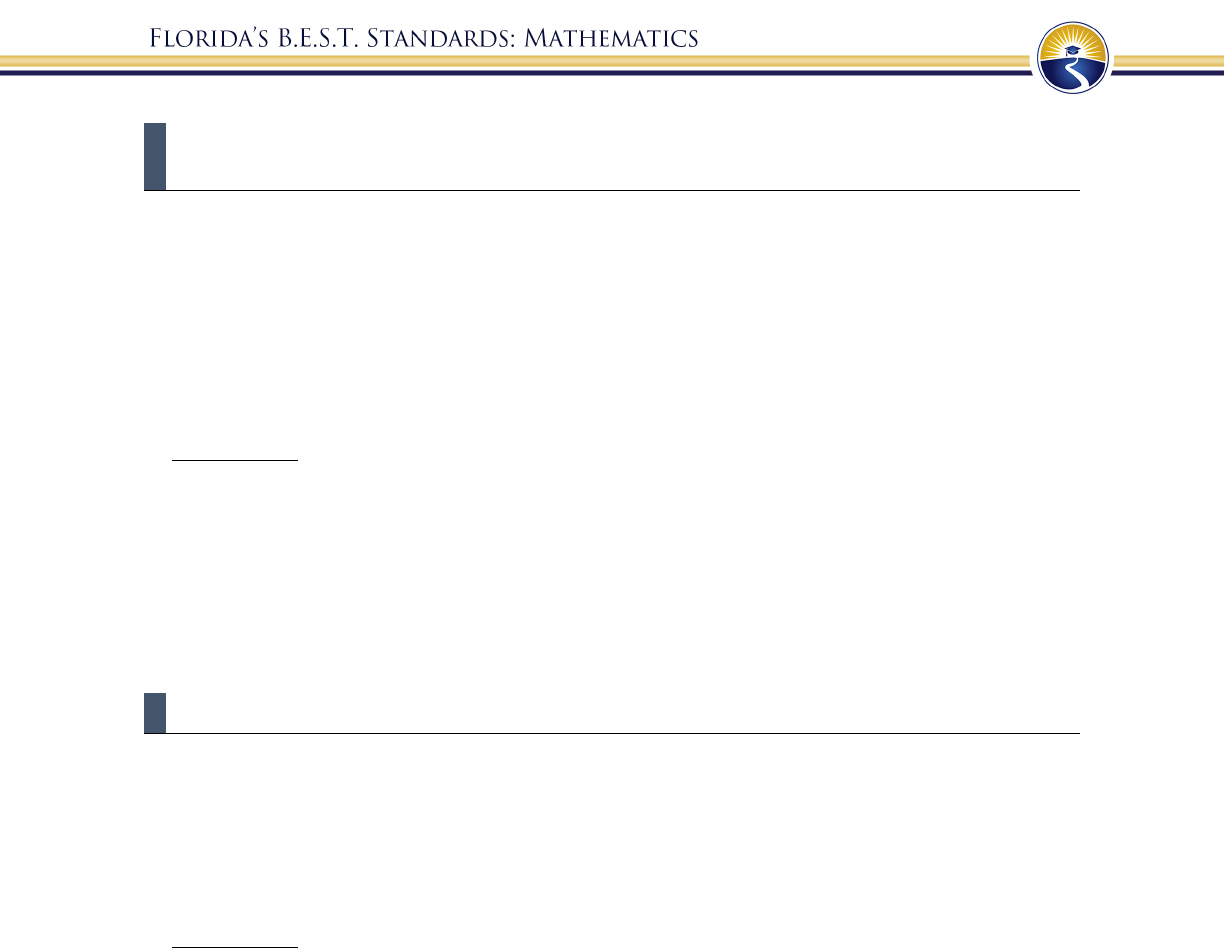
9
MA.K12.MTR.2.1 Demonstrate understanding by representing problems in multiple
ways.
Mathematicians who demonstrate understanding by representing problems in multiple ways:
• Build understanding through modeling and using manipulatives.
• Represent solutions to problems in multiple ways using objects, drawings, tables, graphs
and equations.
• Progress from modeling problems with objects and drawings to using algorithms and
equations.
• Express connections between concepts and representations.
• Choose a representation based on the given context or purpose.
Clarifications:
Teachers who encourage students to demonstrate understanding by representing problems in multiple
ways:
• Help students make connections between concepts and representations.
• Provide opportunities for students to use manipulatives when investigating concepts.
• Guide students from concrete to pictorial to abstract representations as understanding progresses.
• Show students that various representations can have different purposes and can be useful in
different situations.
MA.K12.MTR.3.1 Complete tasks with mathematical fluency.
Mathematicians who complete tasks with mathematical fluency:
• Select efficient and appropriate methods for solving problems within the given context.
• Maintain flexibility and accuracy while performing procedures and mental calculations.
• Complete tasks accurately and with confidence.
• Adapt procedures to apply them to a new context.
• Use feedback to improve efficiency when performing calculations.
Clarifications:
Teachers who encourage students to complete tasks with mathematical fluency:
• Provide students with the flexibility to solve problems by selecting a procedure that allows them
to solve efficiently and accurately.
• Offer multiple opportunities for students to practice efficient and generalizable methods.
• Provide opportunities for students to reflect on the method they used and determine if a more
efficient method could have been used.
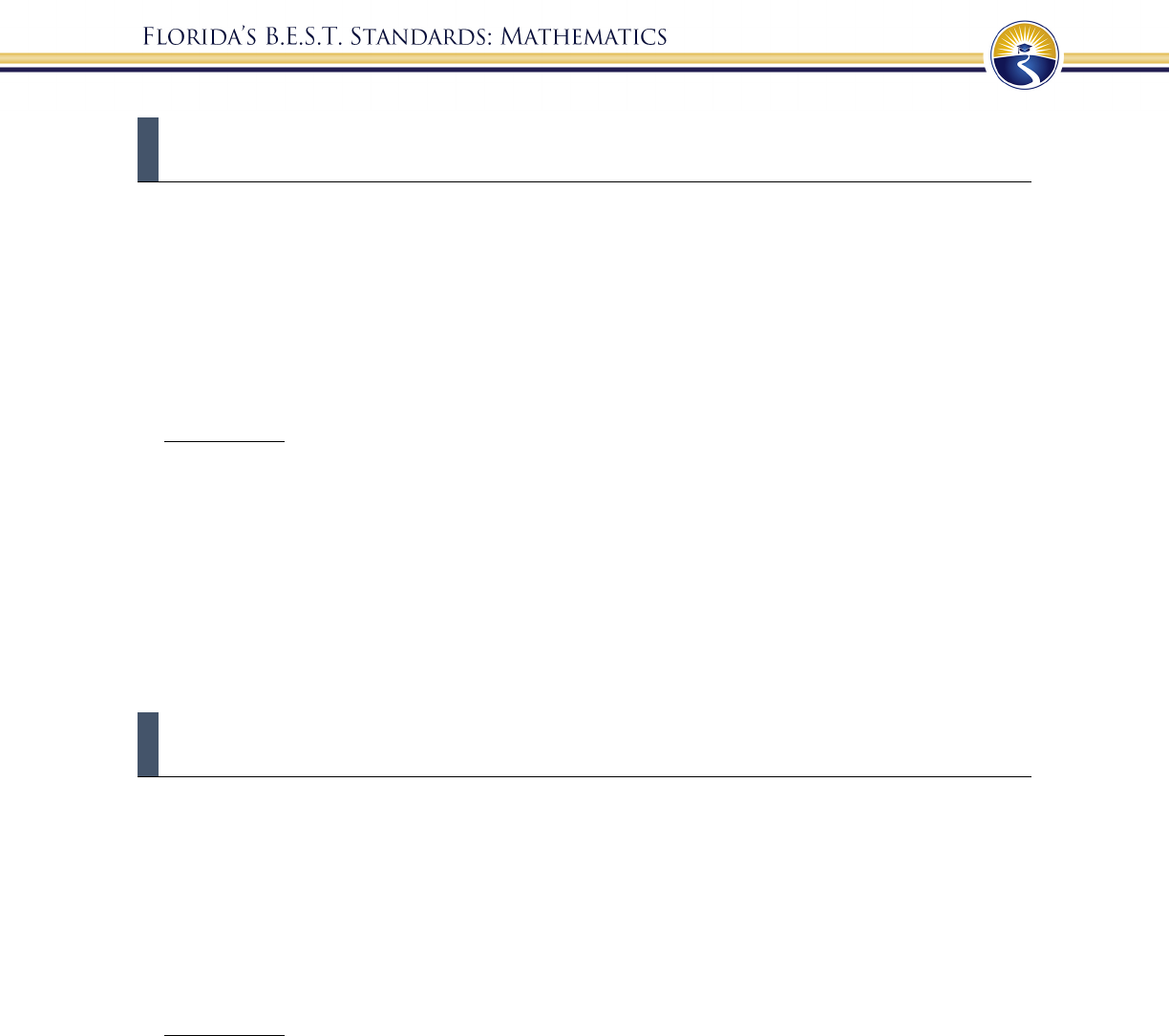
10
MA.K12.MTR.4.1 Engage in discussions that reflect on the mathematical thinking of
self and others.
Mathematicians who engage in discussions that reflect on the mathematical thinking of self
and others:
• Communicate mathematical ideas, vocabulary and methods effectively.
• Analyze the mathematical thinking of others.
• Compare the efficiency of a method to those expressed by others.
• Recognize errors and suggest how to correctly solve the task.
• Justify results by explaining methods and processes.
• Construct possible arguments based on evidence.
Clarifications:
Teachers who encourage students to engage in
discussions that reflect on the mathematical thinking of
self and others:
• Establish a culture in which students ask questions of the teacher and their peers, and error is an
opportunity for learning.
• Create opportunities for students to discuss their thinking with peers.
• Select, sequence and present student work to advance and deepen understanding of correct and
increasingly efficient methods.
• Develop students’ ability to justify methods and compare their responses to the responses of their
peers.
MA.K12.MTR.5.1 Use patterns and structure to help understand and connect
mathematical concepts.
Mathematicians who use patterns and structure to help understand and connect mathematical
concepts:
• Focus on relevant details within a problem.
• Create plans and procedures to logically order events, steps or ideas to solve problems.
• Decompose a complex problem into manageable parts.
• Relate previously learned concepts to new concepts.
• Look for similarities among problems.
• Connect solutions of problems to more complicated large-scale situations.
Clarifications:
Teachers who encourage students to use patterns and structure to help understand and connect
mathematical concepts:
• Help students recognize the patterns in the world around them and connect these patterns to
mathematical concepts.
• Support students to develop generalizations based on the similarities found among problems.
• Provide opportunities for students to create plans and procedures to solve problems.
• Develop students’ ability to construct relationships between their current understanding and more
sophisticated ways of thinking.
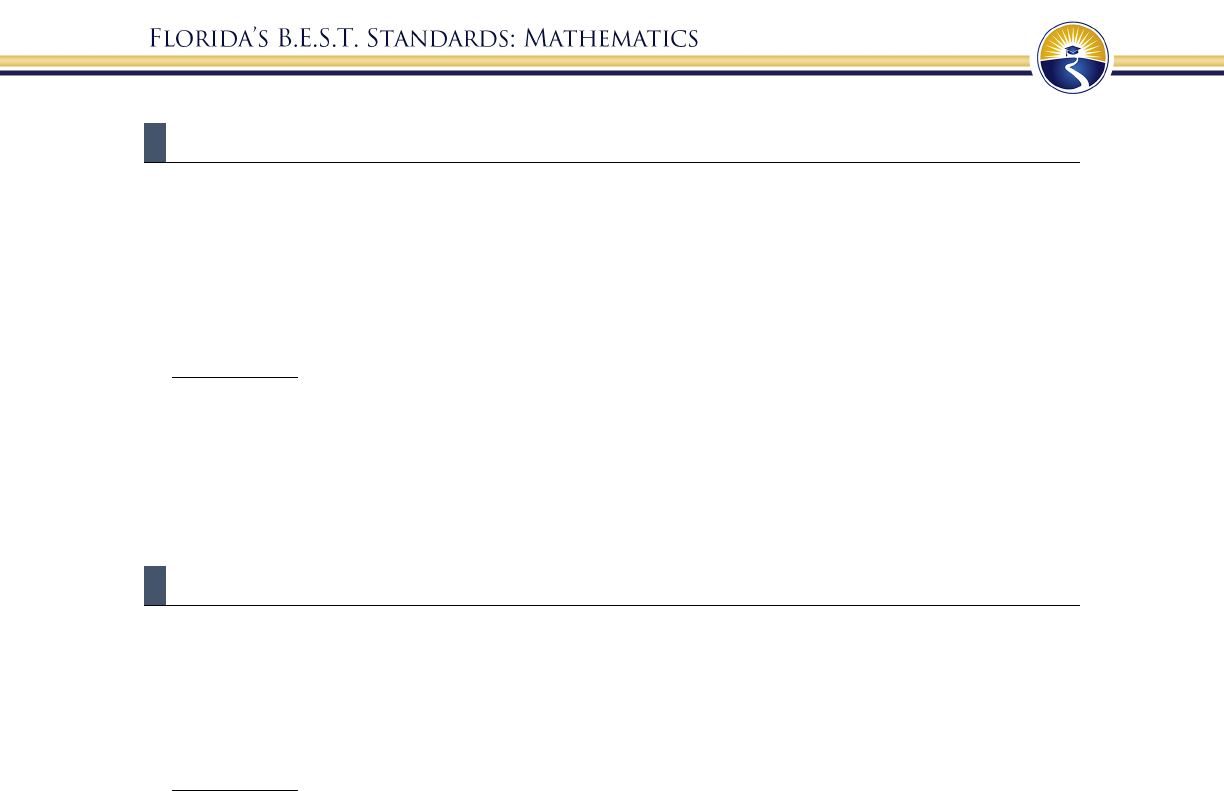
11
MA.K12.MTR.6.1 Assess the reasonableness of solutions.
Mathematicians who assess the reasonableness of solutions:
• Estimate to discover possible solutions.
• Use benchmark quantities to determine if a solution makes sense.
• Check calculations when solving problems.
• Verify possible solutions by explaining the methods used.
•
Evaluate results based on the given context.
Clarifications:
Teachers who encourage students to assess the reasonableness of solutions:
• Have students estimate or predict solutions prior to solving.
• Prompt students to continually ask, “Does this solution make sense? How do you know?”
• Reinforce that students check their work as they progress within and after a task.
• Strengthen students’ ability to verify solutions through justifications.
MA.K12.MTR.7.1 Apply mathematics to real-world contexts.
Mathematicians who apply mathematics to real-world contexts:
• Connect mathematical concepts to everyday experiences.
• Use models and methods to understand, represent and solve problems.
• Perform investigations to gather data or determine if a method is appropriate.
• Redesign models and methods to improve accuracy or efficiency.
Clarifications:
Teachers who encourage students to apply mathematics to real-world contexts:
• Provide opportunities for students to create models, both concrete and abstract, and perform
investigations.
• Challenge students to question the accuracy of their models and methods.
• Support students as they validate conclusions by comparing them to the given situation.
• Indicate how various concepts can be applied to other disciplines.
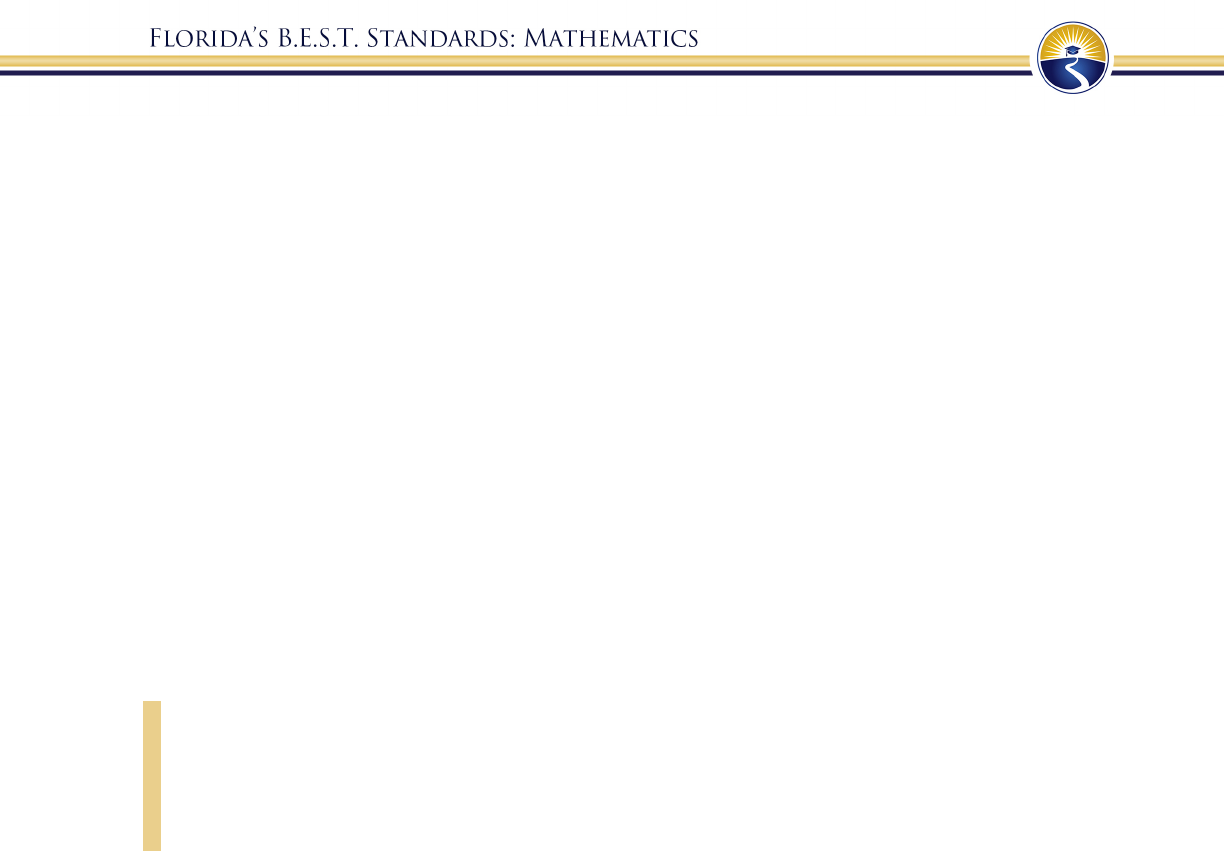
12
Standards for Mathematics K-5

13
Kindergarten
In Kindergarten, instructional time will emphasize three areas:
(1) developing an understanding of counting to represent the total number of objects in a
set and to order the objects within a set;
(2) developing an understanding of addition and subtraction and the relationship of these
operations to counting and
(3) measuring, comparing and categorizing objects according to various attributes,
including their two- and three-dimensional shapes.
Number Sense and Operations
MA.K.NSO.1 Develop an understanding for counting using objects in a set.
MA.K.NSO.1.1
Given a group of up to 20 objects, count the number of objects in that group
and represent the number of objects with a written numeral. State the
number of objects in a rearrangement of that group without recounting.
Benchmark Clarifications:
Clarification 1: Instruction focuses on developing an understanding of cardinality and one-to-one
correspondence.
Clarification 2: Instruction includes counting objects and pictures presented in a line, rectangular array,
circle or scattered arrangement. Objects presented in a scattered arrangement are limited to 10.
Clarification 3: Within this benchmark, the expectation is not to write the number in word form.
MA.K.NSO.1.2
Given a number from 0 to 20, count out that many objects.
Benchmark Clarifications:
Clarification 1: Instruction includes giving a number verbally or with a written numeral.
MA.K.NSO.1.3
Identify positions of objects within a sequence using the words “first,”
“second,” “third,” “fourth” or “fifth.”
Benchmark Clarifications:
Clarification 1: Instruction includes the understanding that rearranging a group of objects does not
change the total number of objects but may change the order of an object in that group.
MA.K.NSO.1.4
Compare the number of objects from 0 to 20 in two groups using the terms
less than, equal to or greater than.
Benchmark Clarifications:
Clarification 1: Instruction focuses on matching, counting and the connection to addition and
subtraction.
Clarification 2: Within this benchmark, the expectation is not to use the relational symbols =, > or <.
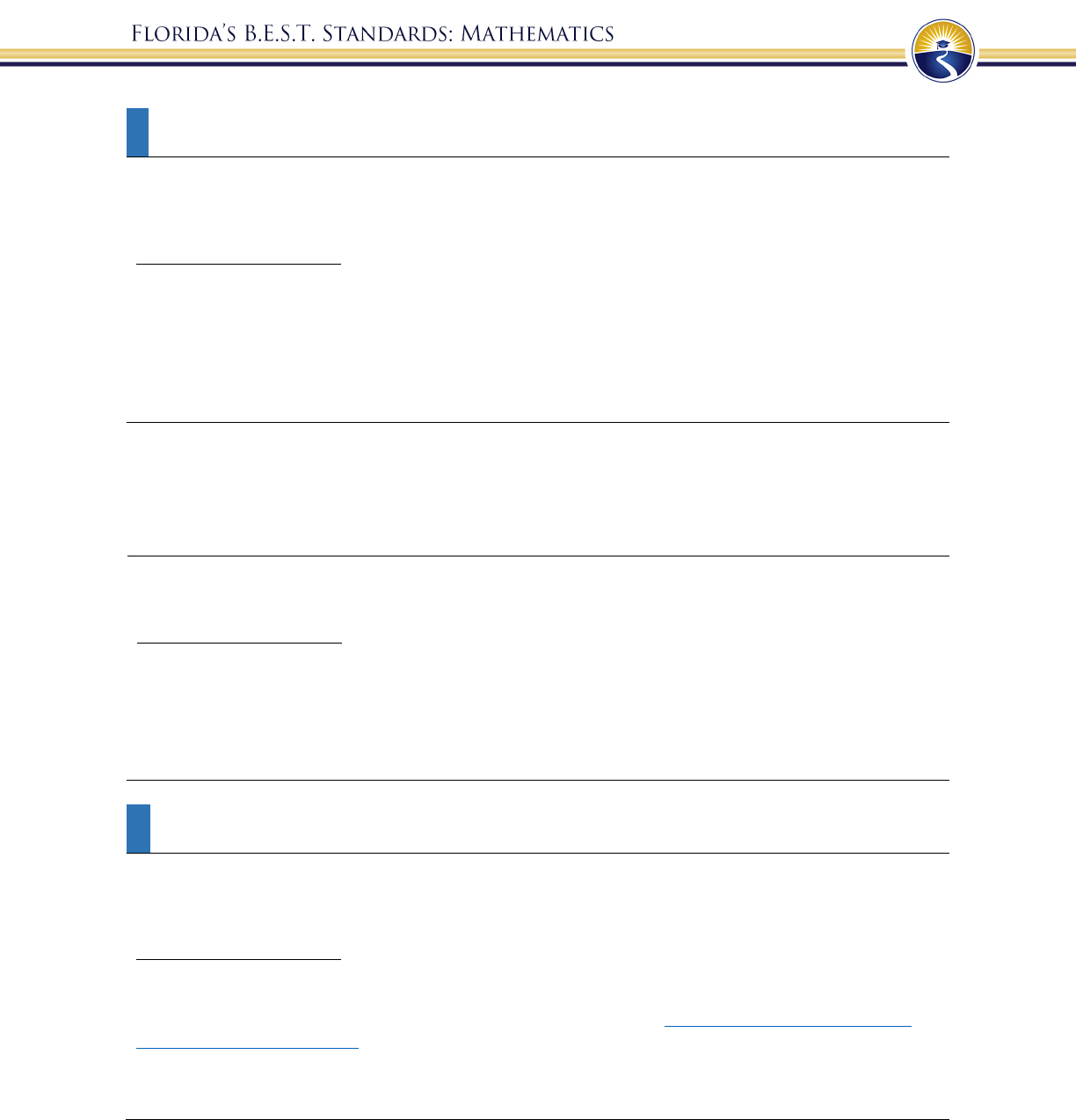
14
MA.K.NSO.2 Recite number names sequentially within 100 and develop an
understanding for place value.
MA.K.NSO.2.1
Recite the number names to 100 by ones and by tens. Starting at a given
number, count forward within 100 and backward within 20.
Benchmark Clarifications:
Clarification 1: When counting forward by ones, students are to say the number names in the standard
order and understand that each successive number refers to a quantity that is one larger. When counting
backward, students are to understand that each succeeding number in the count sequence refers to a
quantity that is one less.
Clarification 2: Within this benchmark, the expectation is to recognize and count to 100 by the end of
Kindergarten.
MA.K.NSO.2.2
Represent whole numbers from 10 to 20, using a unit of ten and a group of
ones, with objects, drawings and expressions or equations.
Example: The number 13 can be represented as the verbal expression “ten ones and
three ones” or as “1 ten and 3 ones”.
MA.K.NSO.2.3
Locate, order and compare numbers from 0 to 20 using the number line and
terms less than, equal to or greater than.
Benchmark Clarifications:
Clarification 1: Within this benchmark, the expectation is not to use the relational symbols =, > or <.
Clarification 2: When comparing numbers from 0 to 20, both numbers are plotted on the same number
line.
Clarification 3: When locating numbers on the number line, the expectation includes filling in a
missing number by counting from left to right on the number line.
MA.K.NSO.3 Develop an understanding of addition and subtraction operations with one-
digit whole numbers.
MA.K.NSO.3.1
Explore addition of two whole numbers from 0 to 10, and related subtraction
facts.
Benchmark Clarifications:
Clarification 1: Instruction includes objects, fingers, drawings, number lines and equations.
Clarification 2: Instruction focuses on the connection that addition is “putting together” or “counting
on” and that subtraction is “taking apart” or “taking from.” Refer to Situations Involving Operations
with Numbers (Appendix A).
Clarification 3: Within this benchmark, it is the expectation that one problem can be represented in
multiple ways and understanding how the different representations are related to each other.
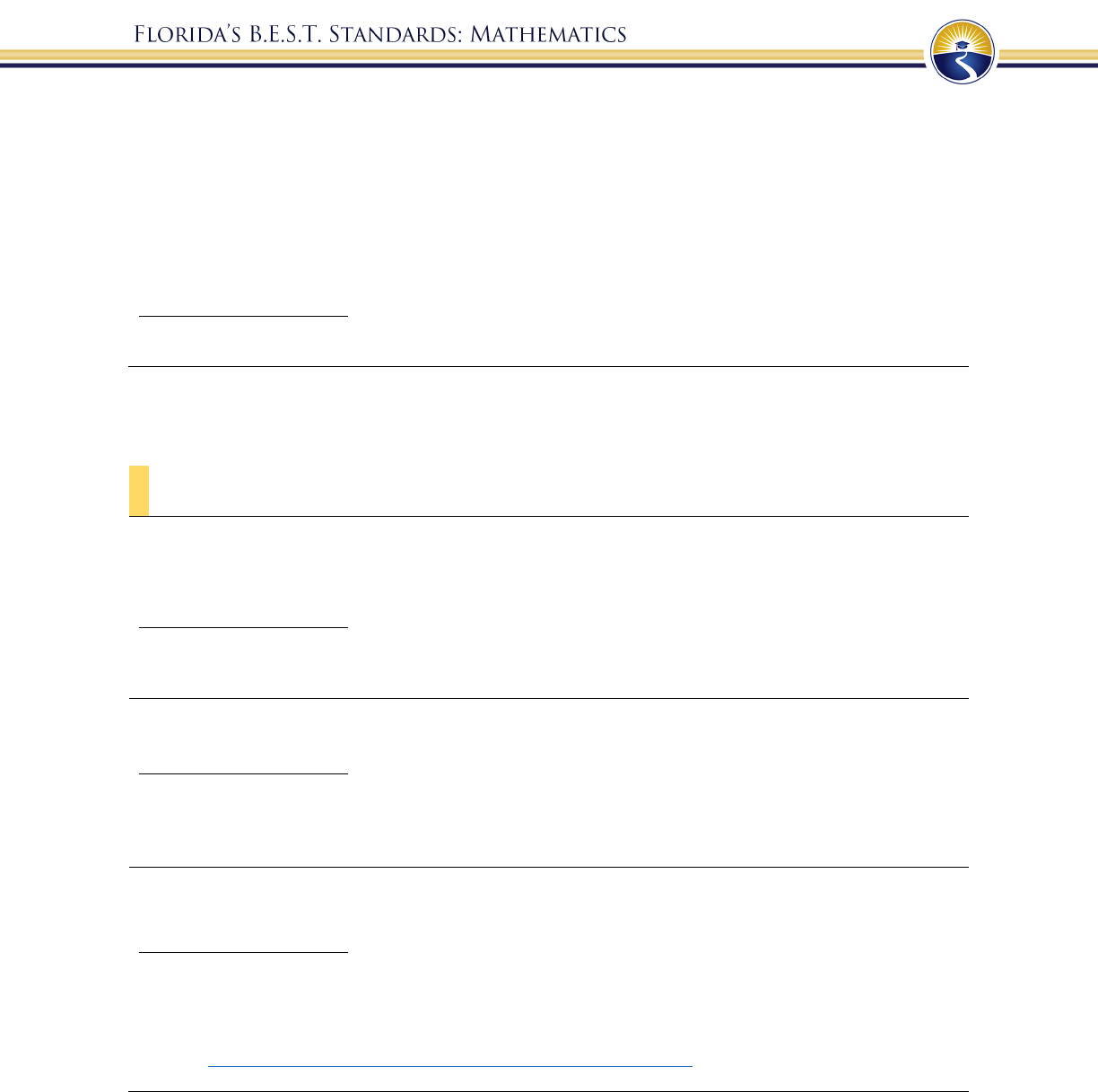
15
MA.K.NSO.3.2
Add two one-digit whole numbers with sums from 0 to 10 and subtract using
related facts with procedural reliability.
Example: The sum 2 + 7 can be found by counting on, using fingers or by “jumps”
on the number line.
Example: The numbers 3, 5 and 8 make a fact family (number bonds). It can be
represented as 5 and 3 make 8; 3 and 5 make 8; 8 take away 5 is 3; and 8
take away 3 is 5.
Benchmark Clarifications:
Clarification 1: Instruction focuses on helping a student choose a method they can use reliably.
Algebraic Reasoning
MA.K.AR.1 Represent and solve addition problems with sums between 0 and 10 and
subtraction problems using related facts.
MA.K.AR.1.1
For any number from 1 to 9, find the number that makes 10 when added to the
given number.
Benchmark Clarifications:
Clarification 1: Instruction includes creating a ten using manipulatives, number lines, models and
drawings.
MA.K.AR.1.2
Given a number from 0 to 10, find the different ways it can be represented as
the sum of two numbers.
Benchmark Clarifications:
Clarification 1: Instruction includes the exploration of finding possible pairs to make a sum using
manipulatives, objects, drawings and expressions; and understanding how the different representations
are related to each other.
MA.K.AR.1.3
Solve addition and subtraction real-world problems using objects, drawings or
equations to represent the problem.
Benchmark Clarifications:
Clarification 1: Instruction includes understanding the context of the problem, as well as the quantities
within the problem.
Clarification 2: Students are not expected to independently read word problems.
Clarification 3: Addition and subtraction are limited to sums within 10 and related subtraction facts.
Refer to Situations Involving Operations with Numbers (Appendix A)
.

16
MA.K.AR.2 Develop an understanding of the equal sign.
MA.K.AR.2.1
Explain why addition or subtraction equations are true using objects or
drawings.
Example: The equation 7 = 9 2 can be represented with cupcakes to show that it is
true by crossing out two of the nine cupcakes.
Benchmark Clarifications:
Clarification 1: Instruction focuses on the understanding of the equal sign.
Clarification 2: Problem types are limited to an equation with two or three terms. The sum or
difference can be on either side of the equal sign.
Clarification 3: Addition and subtraction are limited to sums within 20 and related subtraction facts.
Measurement
MA.K.M.1 Identify and compare measurable attributes of objects.
MA.K.M.1.1
Identify the attributes of a single object that can be measured such as length,
volume or weight.
Benchmark Clarifications:
Clarification 1: Within this benchmark, measuring is not required.
MA.K.M.1.2
Directly compare two objects that have an attribute which can be measured in
common. Express the comparison using language to describe the difference.
Benchmark Clarifications:
Clarification 1: To directly compare length, objects are placed next to each other with one end of each
object lined up to determine which one is longer.
Clarification 2: Language to compare length includes short, shorter, long, longer, tall, taller, high or
higher. Language to compare volume includes has more, has less, holds more, holds less, more full,
less full, full, empty, takes up more space or takes up less space. Language to compare weight includes
heavy, heavier, light, lighter, weighs more or weighs less.
MA.K.M.1.3
Express the length of an object, up to 20 units long, as a whole number of
lengths by laying non-standard objects end to end with no gaps or overlaps.
Example: A piece of paper can be measured using paper clips.
Benchmark Clarifications:
Clarification 1: Non-standard units of measurement are units that are not typically used, such as paper
clips or colored tiles. To measure with non-standard units, students lay multiple copies of the same
object end to end with no gaps or overlaps. The length is shown by the number of objects needed.
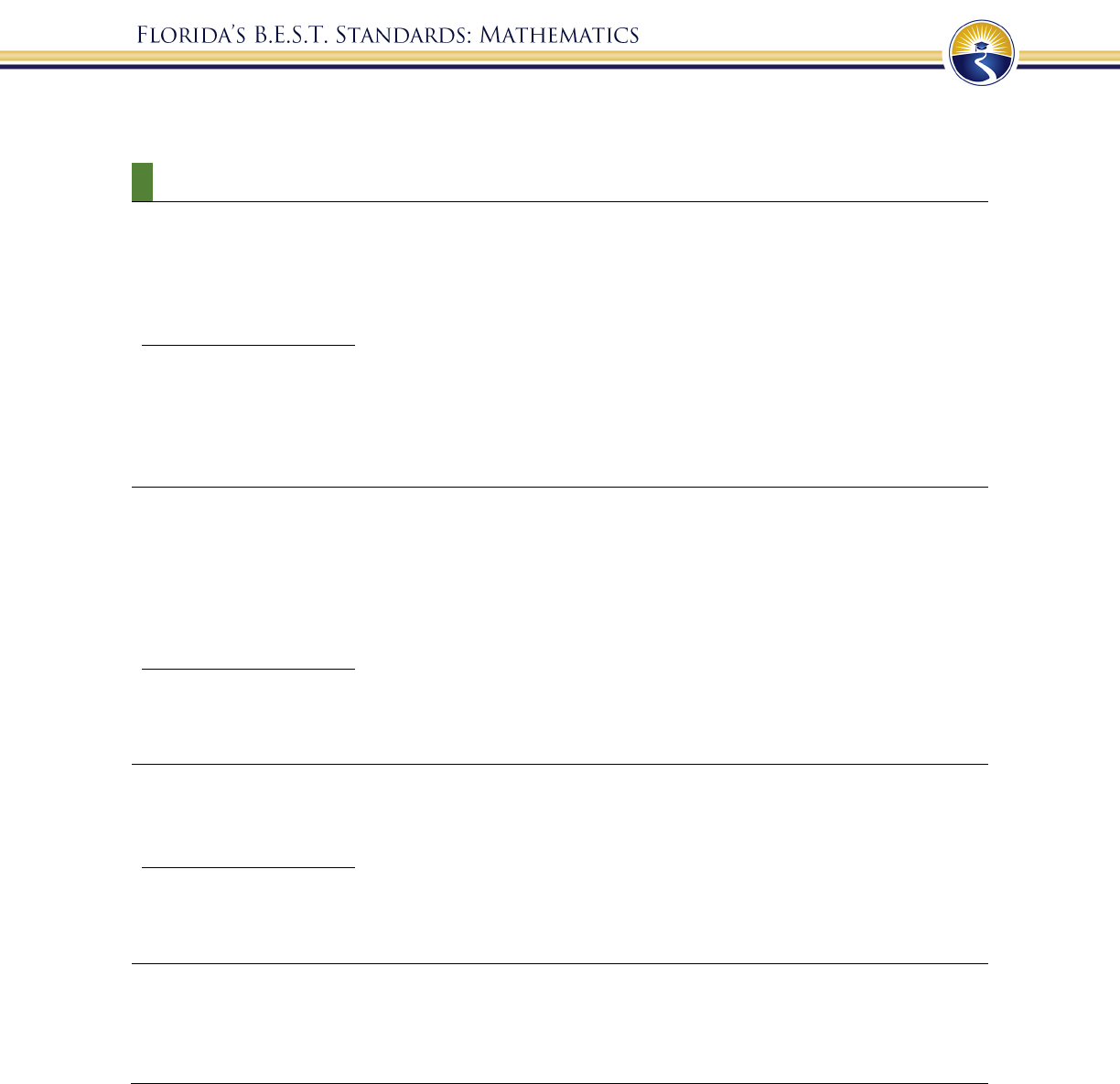
17
Geometric Reasoning
MA.K.GR.1 Identify, compare and compose two- and three-dimensional figures.
MA.K.GR.1.1
Identify two- and three-dimensional figures regardless of their size or
orientation. Figures are limited to circles, triangles, rectangles, squares,
spheres, cubes, cones and cylinders.
Benchmark Clarifications:
Clarification 1: Instruction includes a wide variety of circles, triangles, rectangles, squares, spheres,
cubes, cones and cylinders.
Clarification 2: Instruction includes a variety of non-examples that lack one or more defining
attributes.
Clarification 3: Two-dimensional figures can be either filled, outlined or both.
MA.K.GR.1.2
Compare two-dimensional figures based on their similarities, differences and
positions. Sort two-dimensional figures based on their similarities and
differences. Figures are limited to circles, triangles, rectangles and squares.
Example: A triangle can be compared to a rectangle by stating that they both have
straight sides, but a triangle has 3 sides and vertices, and a rectangle has 4
sides and vertices.
Benchmark Clarifications:
Clarification 1: Instruction includes exploring figures in a variety of sizes and orientations.
Clarification 2: Instruction focuses on using informal language to describe relative positions and the
similarities or differences between figures when comparing and sorting.
MA.K.GR.1.3
Compare three-dimensional figures based on their similarities, differences and
positions. Sort three-dimensional figures based on their similarities and
differences. Figures are limited to spheres, cubes, cones and cylinders.
Benchmark Clarifications:
Clarification 1: Instruction includes exploring figures in a variety of sizes and orientations.
Clarification 2: Instruction focuses on using informal language to describe relative positions and the
similarities or differences between figures when comparing and sorting.
MA.K.GR.1.4
Find real-world objects that can be modeled by a given two- or three-
dimensional figure. Figures are limited to circles, triangles, rectangles,
squares, spheres, cubes, cones and cylinders.
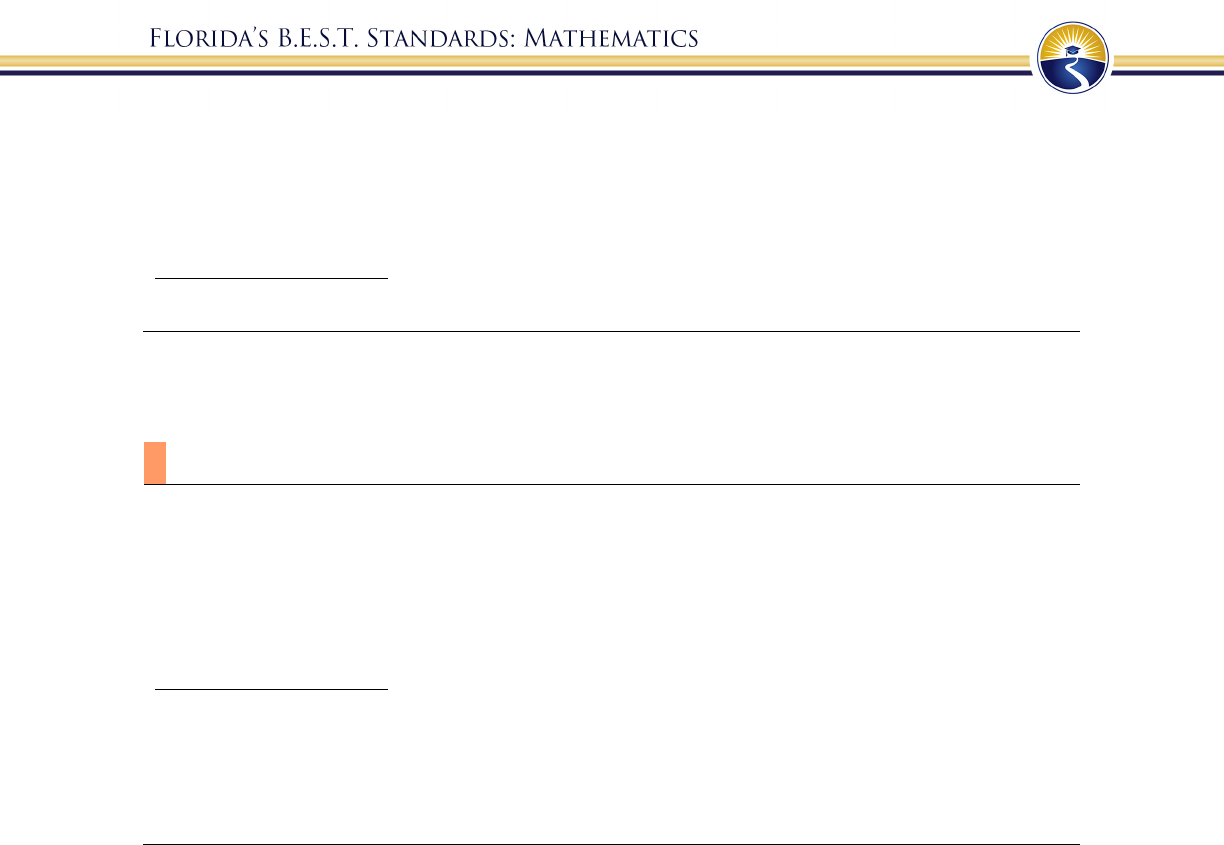
18
MA.K.GR.1.5
Combine two-dimensional figures to form a given composite figure. Figures
used to form a composite shape are limited to triangles, rectangles and
squares.
Example: Two triangles can be used to form a given rectangle.
Benchmark Clarifications:
Clarification 1: This benchmark is intended to develop the understanding of spatial relationships.
Data Analysis and Probability
MA.K.DP.1 Develop an understanding for collecting, representing and comparing data.
MA.K.DP.1.1
Collect and sort objects into categories and compare the categories by
counting the objects in each category. Report the results verbally, with a
written numeral or with drawings.
Example: A bag containing 10 circles, triangles and rectangles can be sorted by shape
and then each category can be counted and compared.
Benchmark Clarifications:
Clarification 1: Instruction focuses on supporting work in counting.
Clarification 2: Instruction includes geometric figures that can be categorized using their defining
attributes.
Clarification 3: Within this benchmark, it is not the expectation for students to construct formal
representations or graphs on their own.

19
Grade 1
In grade 1, instructional time will emphasize four areas:
(1) understanding the place value of tens and ones within two-digit whole numbers;
(2) extending understanding of addition and subtraction and the relationship between
them;
(3) developing an understanding of measurement of physical objects, money and time
and
(4) categorizing, composing and decomposing geometric figures.
Number Sense and Operations
MA.1.NSO.1 Extend counting sequences and understand the place value of two-digit
numbers.
MA.1.NSO.1.1
Starting at a given number, count forward and backwards within 120 by
ones. Skip count by 2s to 20 and by 5s to 100.
Benchmark Clarifications:
Clarification 1: Instruction focuses on the connection to addition as “counting on” and subtraction as
“counting back”.
Clarification 2: Instruction also focuses on the recognition of patterns within skip counting which helps
build a foundation for multiplication in later grades.
Clarification 3: Instruction includes recognizing counting sequences using visual charts, such as a 120
chart, to emphasize base 10 place value.
MA.1.NSO.1.2
Read numbers from 0 to 100 written in standard form, expanded form and
word form. Write numbers from 0 to 100 using standard form and expanded
form.
Example: The number seventy-five written in standard form is 75 and in expanded
form is 70 + 5.
MA.1.NSO.1.3
Compose and decompose two-digit numbers in multiple ways using tens and
ones. Demonstrate each composition or decomposition with objects,
drawings and expressions or equations.
Example: The number 37 can be expressed as 3 + 7 , 2 + 17
or as 37 .
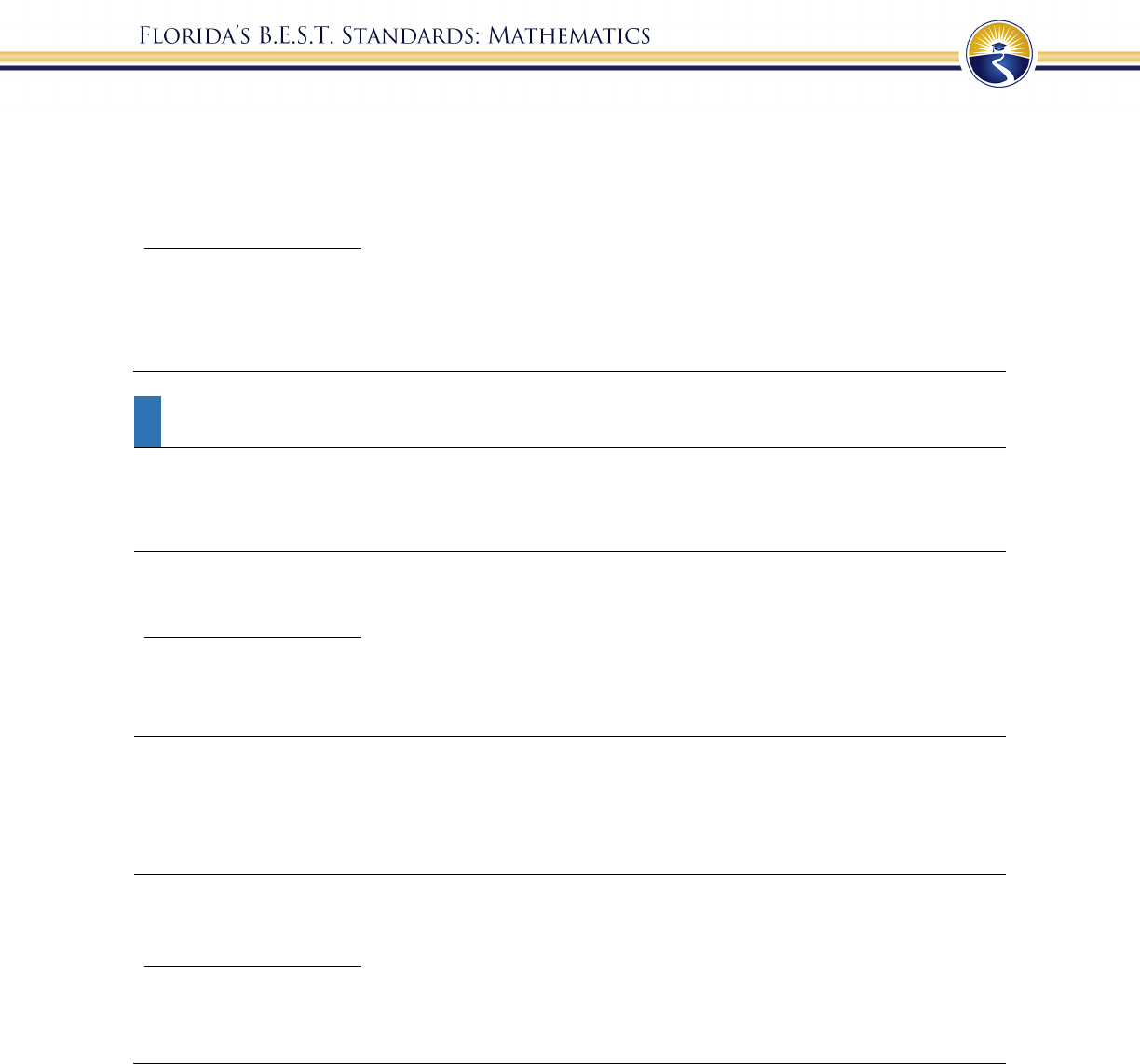
20
MA.1.NSO.1.4 Plot, order and compare whole numbers up to 100.
Example: The numbers 72, 35 and 58 can be arranged in ascending order as 35, 58
and 72.
Benchmark Clarifications:
Clarification 1: When comparing numbers, instruction includes using a number line and using place
values of the tens and ones digits.
Clarification 2: Within this benchmark, the expectation is to use terms (e.g., less than, greater than,
between or equal to) and symbols (<, > or =).
MA.1.NSO.2 Develop an understanding of addition and subtraction operations with one-
and two-digit numbers.
MA.1.NSO.2.1
Recall addition facts with sums to 10 and related subtraction facts with
automaticity.
MA.1.NSO.2.2
Add two whole numbers with sums from 0 to 20, and subtract using related
facts with procedural reliability.
Benchmark Clarifications:
Clarification 1: Instruction focuses on helping a student choose a method they can use reliably.
Clarification 2: Instruction includes situations involving adding to, putting together, comparing and
taking from.
MA.1.NSO.2.3
Identify the number that is one more, one less, ten more and ten less than a
given two-digit number.
Example: One less than 40 is 39.
Example: Ten more than 23 is 33.
MA.1.NSO.2.4
Explore the addition of a two-digit number and a one-digit number with sums
to 100.
Benchmark Clarifications:
Clarification 1: Instruction focuses on combining ones and tens and composing new tens from ones,
when needed.
Clarification 2: Instruction includes the use of manipulatives, number lines, drawings or models.

21
MA.1.NSO.2.5 Explore subtraction of a one-digit number from a two-digit number.
Example: Finding 37 6 is the same as asking “What number added to 6 makes
37?”
Benchmark Clarifications:
Clarification 1: Instruction focuses on utilizing the number line as a tool for subtraction through
“counting on” or “counting back”. The process of counting on highlights subtraction as a missing
addend problem.
Clarification 2: Instruction includes the use of manipulatives, drawings or equations to decompose tens
and regroup ones, when needed.
Fractions
MA.1.FR.1 Develop an understanding of fractions by partitioning shapes into halves and
fourths.
MA.1.FR.1.1
Partition circles and rectangles into two and four equal-sized parts. Name the
parts of the whole using appropriate language including halves or fourths.
Benchmark Clarifications:
Clarification 1: This benchmark does not require writing the equal sized parts as a fraction with a
numerator and denominator.
Algebraic Reasoning
MA.1.AR.1 Solve addition problems with sums between 0 and 20 and subtraction
problems using related facts.
MA.1.AR.1.1
Apply properties of addition to find a sum of three or more whole numbers.
Example: 8 + 7 + 2 is equivalent to 7 + 8 + 2 which is equivalent to 7 + 10 which
equals 17.
Benchmark Clarifications:
Clarification 1: Within this benchmark, the expectation is to apply the associative and commutative
properties of addition. It is not the expectation to name the properties or use parentheses. Refer to
Properties of Operations, Equality and Inequality (Appendix D)
.
Clarification 2: Instruction includes emphasis on using the properties to make a ten when adding three
or more numbers.
Clarification 3: Addition is limited to sums within 20.
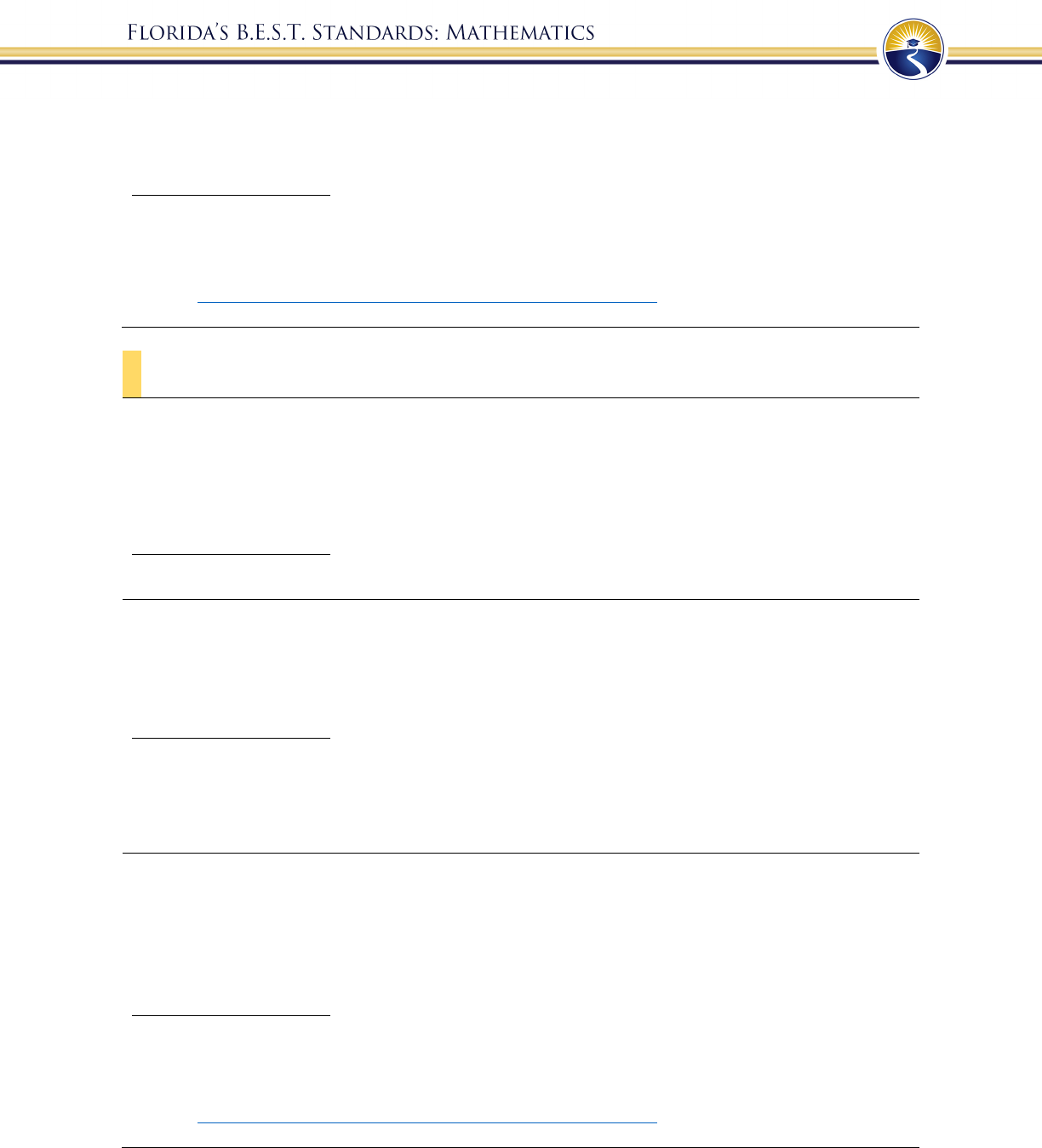
22
MA.1.AR.1.2
Solve addition and subtraction real-world problems using objects, drawings or
equations to represent the problem.
Benchmark Clarifications:
Clarification 1: Instruction includes understanding the context of the problem, as well as the quantities
within the problem.
Clarification 2: Students are not expected to independently read word problems.
Clarification 3: Addition and subtraction are limited to sums within 20 and related subtraction facts.
Refer to Situations Involving Operations with Numbers (Appendix A)
.
MA.1.AR.2 Develop an understanding of the relationship between addition and
subtraction.
MA.1.AR.2.1
Restate a subtraction problem as a missing addend problem using the
relationship between addition and subtraction.
Example: The equation 12 7 =? can be restated as 7+? = 12 to determine the
difference is 5.
Benchmark Clarifications:
Clarification 1: Addition and subtraction are limited to sums within 20 and related subtraction facts.
MA.1.AR.2.2
Determine and explain if equations involving addition or subtraction are true
or false.
Example: Given the following equations,
8 = 8, 9 1 = 7, 5 + 2 = 2 + 5 and 1 = 9 8,
9 1 = 7 can be determined to be false.
Benchmark Clarifications:
Clarification 1: Instruction focuses on understanding of the equal sign.
Clarification 2: Problem types are limited to an equation with no more than four terms. The sum or
difference can be on either side of the equal sign.
Clarification 3: Addition and subtraction are limited to sums within 20 and related subtraction facts.
MA.1.AR.2.3
Determine the unknown whole number in an addition or subtraction equation,
relating three whole numbers, with the unknown in any position.
Example: 9+? = 12
Example: 17 = + 5
Example: ? 4 = 8
Benchmark Clarifications:
Clarification 1: Instruction begins the development of algebraic thinking skills where the symbolic
representation of the unknown uses any symbol other than a letter.
Clarification 2: Problems include the unknown on either side of the equal sign.
Clarification 3: Addition and subtraction are limited to sums within 20 and related subtraction facts.
Refer to Situations Involving Operations with Numbers (Appendix A)
.
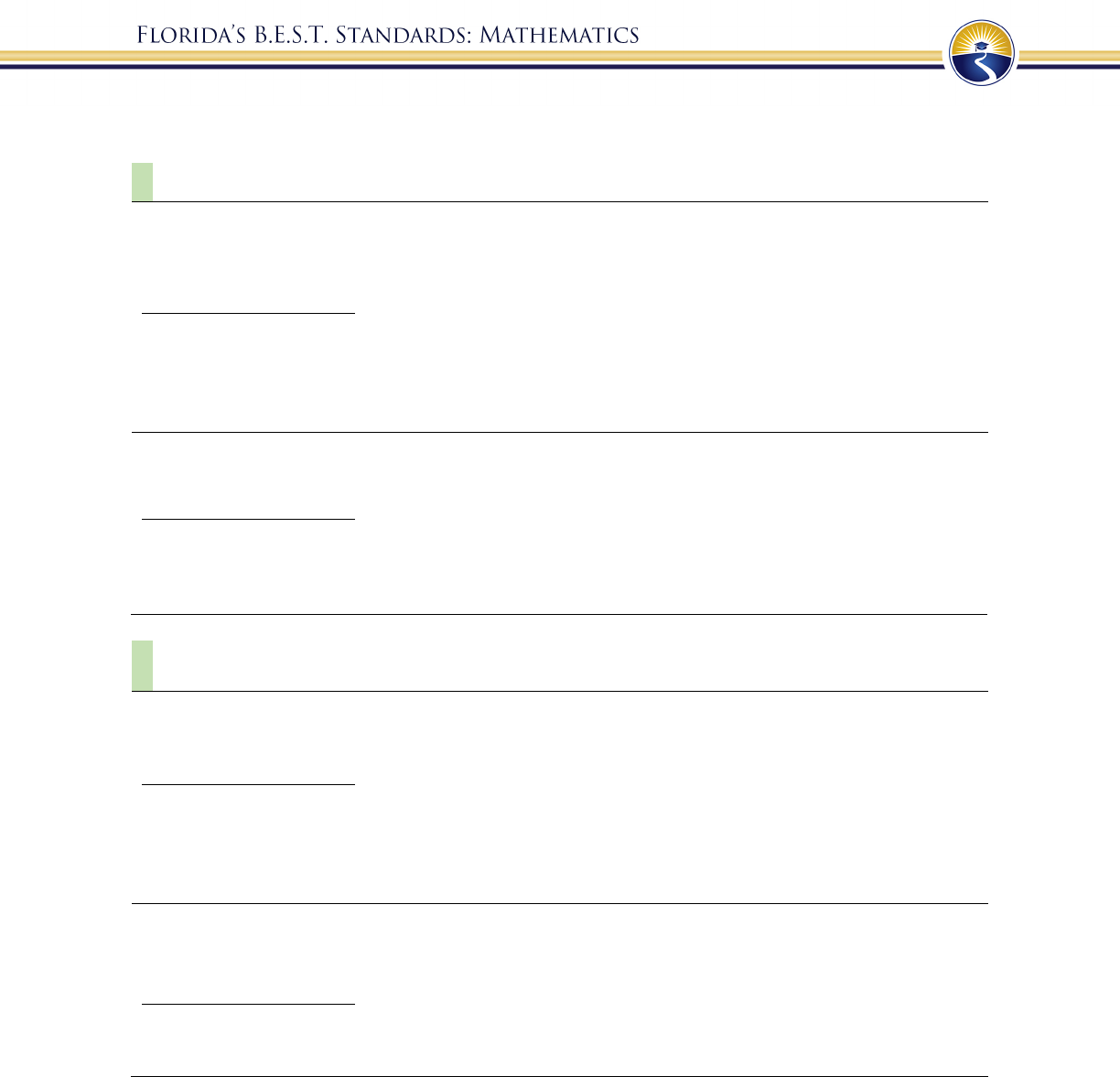
23
Measurement
MA.1.M.1 Compare and measure the length of objects.
MA.1.M.1.1
Estimate the length of an object to the nearest inch. Measure the length of an
object to the nearest inch or centimeter.
Benchmark Clarifications:
Clarification 1: Instruction emphasizes measuring from the zero point of the ruler. The markings on the
ruler indicate the unit of length by marking equal distances with no gaps or overlaps.
Clarification 2: When estimating length, the expectation is to give a reasonable number of inches for
the length of a given object.
MA.1.M.1.2
Compare and order the length of up to three objects using direct and indirect
comparison.
Benchmark Clarifications:
Clarification 1: When directly comparing objects, the objects can be placed side by side or they can be
separately measured in the same units and the measurements can be compared.
Clarification 2: Two objects can be compared indirectly by directly comparing them to a third object.
MA.1.M.2 Tell time and identify the value of coins and combinations of coins and dollar
bills.
MA.1.M.2.1 Using analog and digital clocks, tell and write time in hours and half-hours.
Benchmark Clarifications:
Clarification 1: Within this benchmark, the expectation is not to understand military time or to use a.m.
or p.m.
Clarification 2: Instruction includes the connection to partitioning circles into halves and to semi-
circles.
MA.1.M.2.2
Identify pennies, nickels, dimes and quarters, and express their values using the
¢ symbol. State how many of each coin equal a dollar.
Benchmark Clarifications:
Clarification 1: Instruction includes the recognition of both sides of a coin.
Clarification 2: Within this benchmark, the expectation is not to use decimal values.
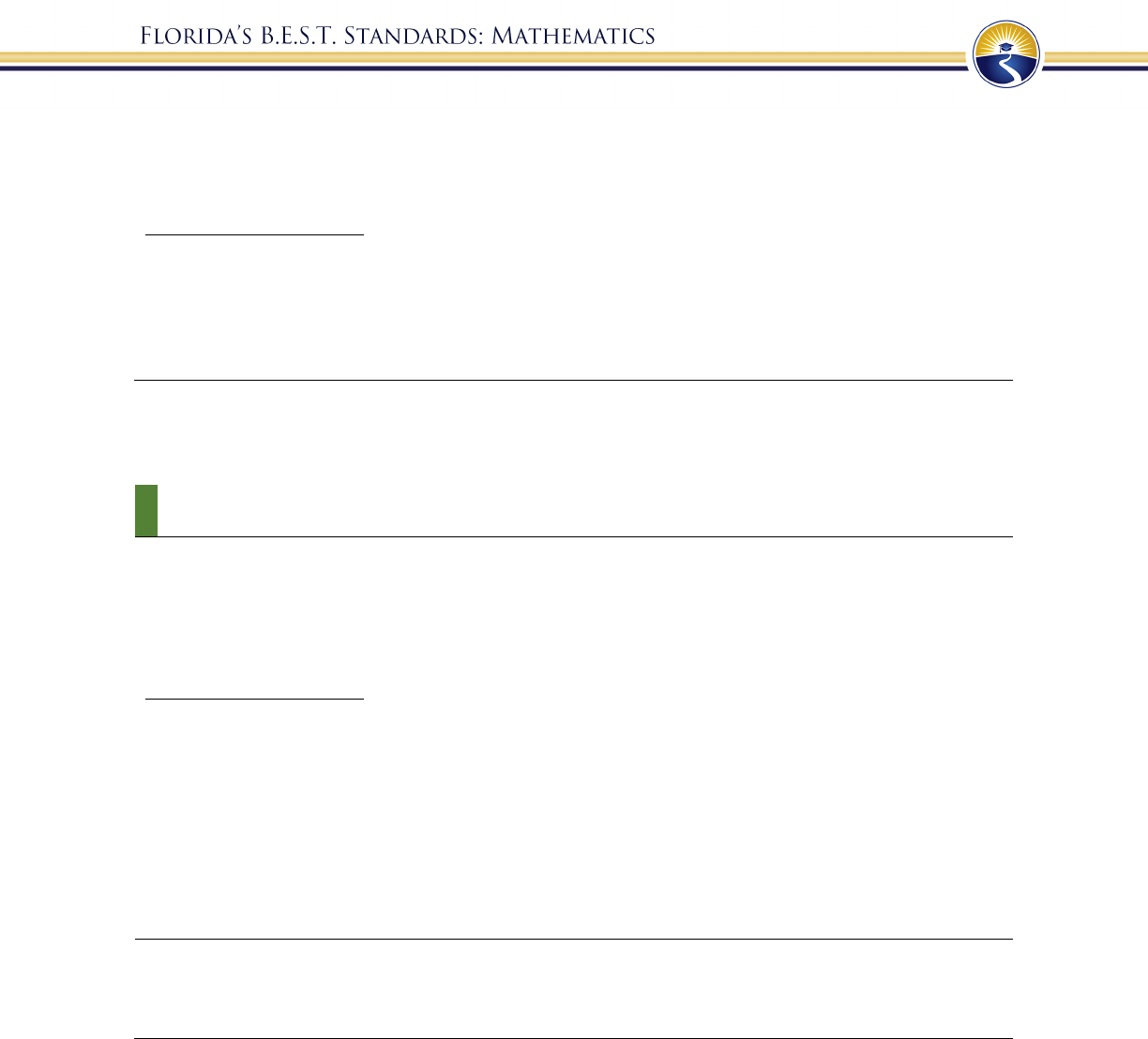
24
MA.1.M.2.3
Find the value of combinations of pennies, nickels and dimes up to one dollar,
and the value of combinations of one, five and ten dollar bills up to $100. Use
the ¢ and $ symbols appropriately.
Benchmark Clarifications:
Clarification 1: Instruction includes the identification of a one, five and ten-dollar bill and the
computation of the value of combinations of pennies, nickels and dimes or one, five and ten dollar bills.
Clarification 2: Instruction focuses on the connection to place value and skip counting.
Clarification 3: Within this benchmark, the expectation is not to use decimal values or to find the value
of a combination of coins and dollars.
Geometric Reasoning
MA.1.GR.1 Identify and analyze two- and three-dimensional figures based on their
defining attributes.
MA.1.GR.1.1
Identify, compare and sort two- and three-dimensional figures based on their
defining attributes. Figures are limited to circles, semi-circles, triangles,
rectangles, squares, trapezoids, hexagons, spheres, cubes, rectangular prisms,
cones and cylinders.
Benchmark Clarifications:
Clarification 1: Instruction focuses on the defining attributes of a figure: whether it is closed or not;
number of vertices, sides, edges or faces; and if it contains straight, curved or equal length sides or
edges.
Clarification 2: Instruction includes figures given in a variety of sizes, orientations and non-examples
that lack one or more defining attributes.
Clarification 3: Within this benchmark, the expectation is not to sort a combination of two- and three-
dimensional figures at the same time or to define the attributes of trapezoids.
Clarification 4: Instruction includes using formal and informal language to describe the defining
attributes of figures when comparing and sorting.
MA.1.GR.1.2
Sketch two-dimensional figures when given defining attributes. Figures are
limited to triangles, rectangles, squares and hexagons.
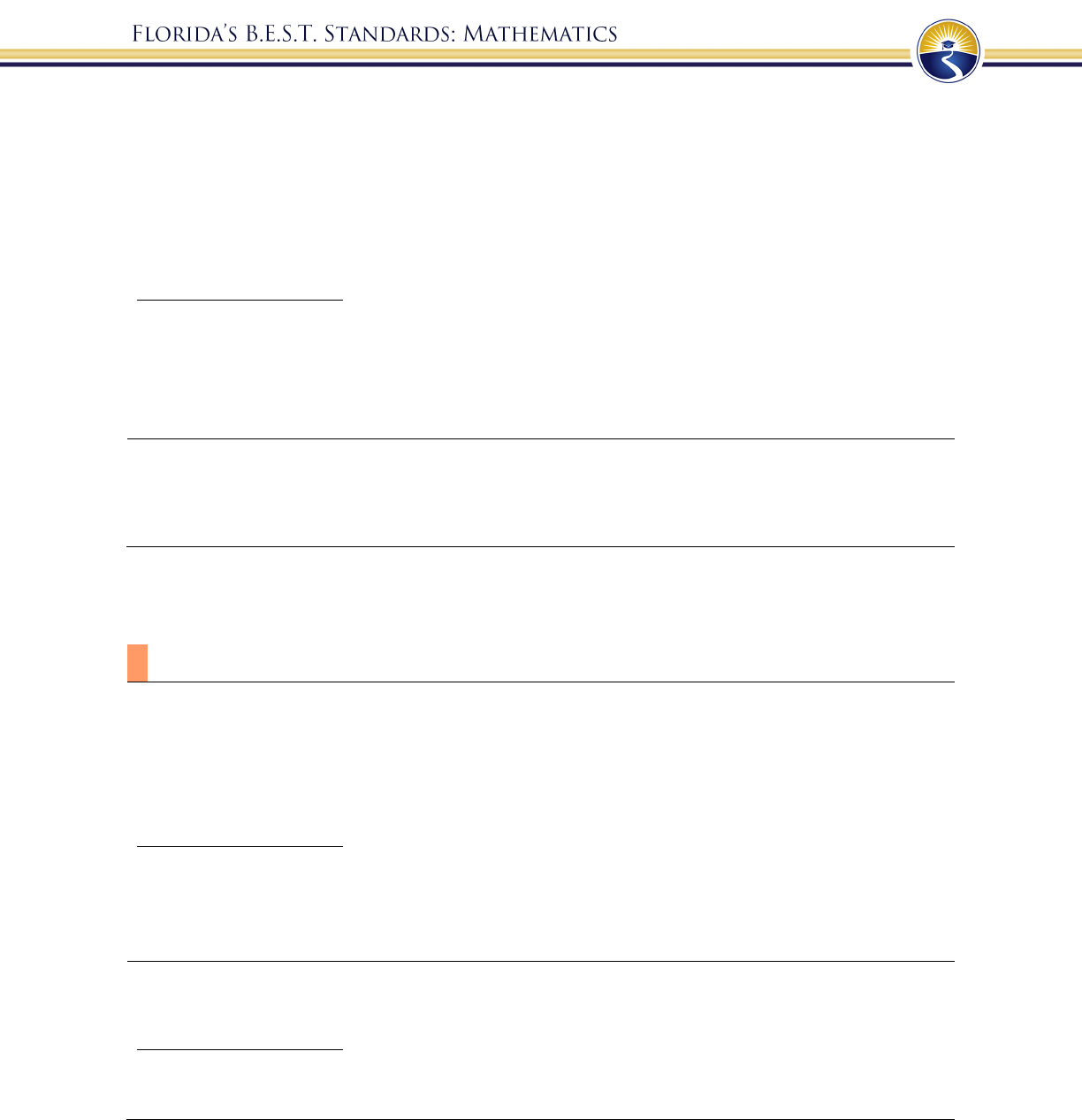
25
MA.1.GR.1.3
Compose and decompose two- and three-dimensional figures. Figures are
limited to semi-circles, triangles, rectangles, squares, trapezoids, hexagons,
cubes, rectangular prisms, cones and cylinders.
Example: A hexagon can be decomposed into 6 triangles.
Example: A semi-circle and a triangle can be composed to create a two-dimensional
representation of an ice cream cone.
Benchmark Clarifications:
Clarification 1: Instruction focuses on the understanding of spatial relationships relating to part-whole,
and on the connection to breaking apart numbers and putting them back together.
Clarification 2: Composite figures are composed without gaps or overlaps.
Clarification 3: Within this benchmark, it is not the expectation to compose two- and three-
dimensional figures at the same time.
MA.1.GR.1.4
Given a real-world object, identify parts that are modeled by two- and three-
dimensional figures. Figures are limited to semi-circles, triangles, rectangles,
squares and hexagons, spheres, cubes, rectangular prisms, cones and cylinders.
Data Analysis and Probability
MA.1.DP.1 Collect, represent and interpret data using pictographs and tally marks.
MA.1.DP.1.1
Collect data into categories and represent the results using tally marks or
pictographs.
Example: A class collects data on the number of students whose birthday is in each
month of the year and represents it using tally marks.
Benchmark Clarifications:
Clarification 1: Instruction includes connecting tally marks to counting by 5s.
Clarification 2: Data sets include geometric figures that are categorized using their defining attributes
and data from the classroom or school.
Clarification 3: Pictographs are limited to single-unit scales.
MA.1.DP.1.2
Interpret data represented with tally marks or pictographs by calculating the
total number of data points and comparing the totals of different categories.
Benchmark Clarifications:
Clarification 1: Instruction focuses on the connection to addition and subtraction when calculating the
total and comparing, respectively.
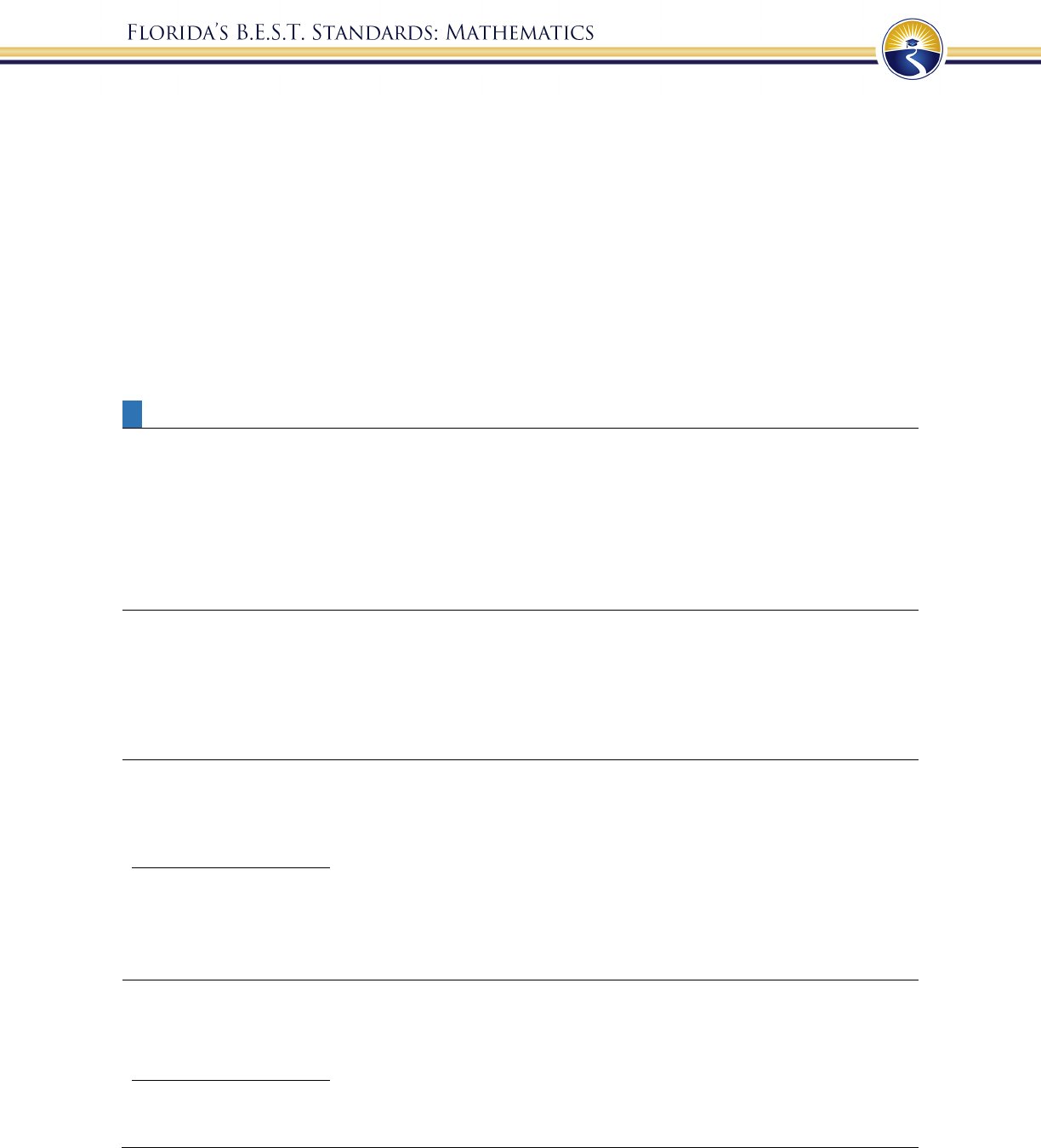
26
Grade 2
In grade 2, instructional time will emphasize four areas:
(1) extending understanding of place value in three-digit numbers;
(2) building fluency and algebraic reasoning with addition and subtraction;
(3) extending understanding of measurement of objects, time and the perimeter of
geometric figures and
(4) developing spatial reasoning with number representations and two-dimensional
figures.
Number Sense and Operations
MA.2.NSO.1 Understand the place value of three-digit numbers.
MA.2.NSO.1.1
Read and write numbers from 0 to 1,000 using standard form, expanded form
and word form.
Example: The number four hundred thirteen written in standard form is 413 and in
expanded form is 400 + 10 + 3.
Example: The number seven hundred nine written in standard form is 709 and in
expanded form is 700 + 9.
MA.2.NSO.1.2
Compose and decompose three-digit numbers in multiple ways using
hundreds, tens and ones. Demonstrate each composition or decomposition
with objects, drawings and expressions or equations.
Example: The number 241 can be expressed as 2 + 4 + 1 or
as 24 + 1 or as 241 .
MA.2.NSO.1.3 Plot, order and compare whole numbers up to 1,000.
Example: The numbers 424, 178 and 475 can be arranged in ascending order as 178,
424 and 475.
Benchmark Clarifications:
Clarification 1: When comparing numbers, instruction includes using a number line and using place
values of the hundreds, tens and ones digits.
Clarification 2: Within this benchmark, the expectation is to use terms (e.g., less than, greater than,
between or equal to) and symbols (<, > or =).
MA.2.NSO.1.4 Round whole numbers from 0 to 100 to the nearest 10.
Example: The number 65 is rounded to 70 when rounded to the nearest 10.
Benchmark Clarifications:
Clarification 1: Within the benchmark, the expectation is to understand that rounding is a process that
produces a number with a similar value that is less precise but easier to use.

27
MA.2.NSO.2 Add and subtract two- and three-digit whole numbers.
MA.2.NSO.2.1
Recall addition facts with sums to 20 and related subtraction facts with
automaticity.
MA.2.NSO.2.2
Identify the number that is ten more, ten less, one hundred more and one
hundred less than a given three-digit number.
Example: The number 236 is one hundred more than 136 because both numbers
have the same digit in the ones and tens place, but differ in the hundreds
place by one.
MA.2.NSO.2.3
Add two whole numbers with sums up to 100 with procedural reliability.
Subtract a whole number from a whole number, each no larger than 100,
with procedural reliability.
Example:
The sum 41 + 23 can be found by using a number line and “jumping up”
by two tens and then by three ones to “land” at 64.
Example: The difference 87 25 can be found by subtracting 20 from 80 to get 60
and then 5 from 7 to get 2. Then add 60 and 2 to obtain 62.
Benchmark Clarifications:
Clarification 1: Instruction focuses on helping a student choose a method they can use reliably.
MA.2.NSO.2.4
Explore the addition of two whole numbers with sums up to 1,000. Explore
the subtraction of a whole number from a whole number, each no larger than
1,000.
Example: The difference 612 17 can be found by rewriting it as 612 12 5
which is equivalent to 600 5 which is equivalent to 595.
Example: The difference 1,000 17 can be found by using a number line and
making a “jump” of 10 from 1,000 to 990 and then 7 “jumps” of 1 to
983.
Benchmark Clarifications:
Clarification 1: Instruction includes the use of manipulatives, number lines, drawings or properties of
operations or place value.
Clarification 2: Instruction focuses on composing and decomposing ones, tens and hundreds when
needed.
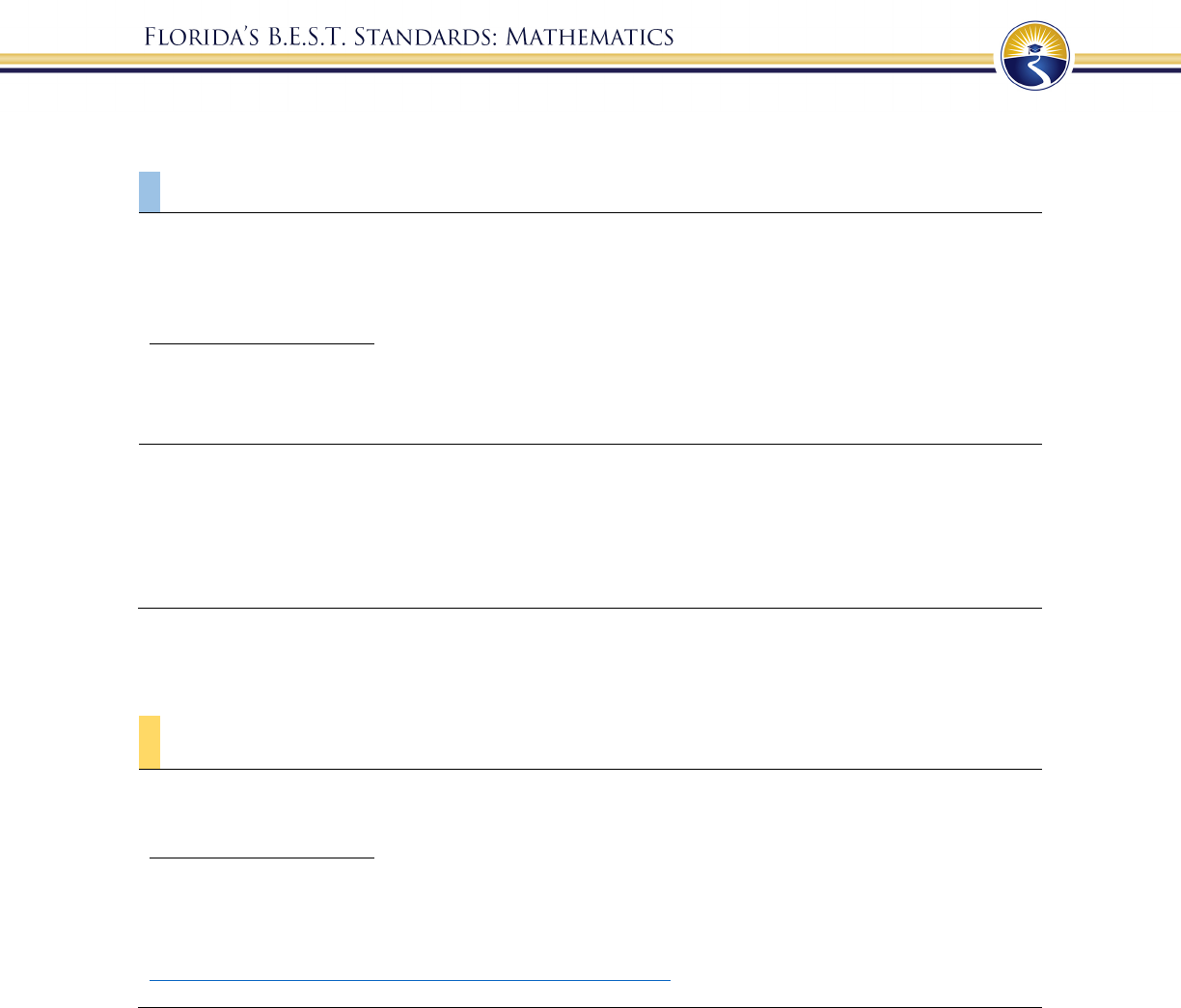
28
Fractions
MA.2.FR.1 Develop an understanding of fractions.
MA.2.FR.1.1
Partition circles and rectangles into two, three or four equal-sized parts. Name
the parts using appropriate language, and describe the whole as two halves,
three thirds or four fourths.
Benchmark Clarifications:
Clarification 1: Within this benchmark, the expectation is not to write the equal-sized parts as a
fraction with a numerator and denominator.
Clarification 2: Problems include mathematical and real-world context.
MA.2.FR.1.2
Partition rectangles into two, three or four equal-sized parts in two different
ways showing that equal-sized parts of the same whole may have different
shapes.
Example: A square cake can be cut into four equal-sized rectangular pieces or into
four equal-sized triangular pieces.
Algebraic Reasoning
MA.2.AR.1 Solve addition problems with sums between 0 and 100 and related subtraction
problems.
MA.2.AR.1.1 Solve one- and two-step addition and subtraction real-world problems.
Benchmark Clarifications:
Clarification 1: Instruction includes understanding the context of the problem, as well as the quantities
within the problem.
Clarification 2: Problems include creating real-world situations based on an equation.
Clarification 3: Addition and subtraction are limited to sums up to 100 and related differences. Refer to
Situations Involving Operations with Numbers (Appendix A)
.
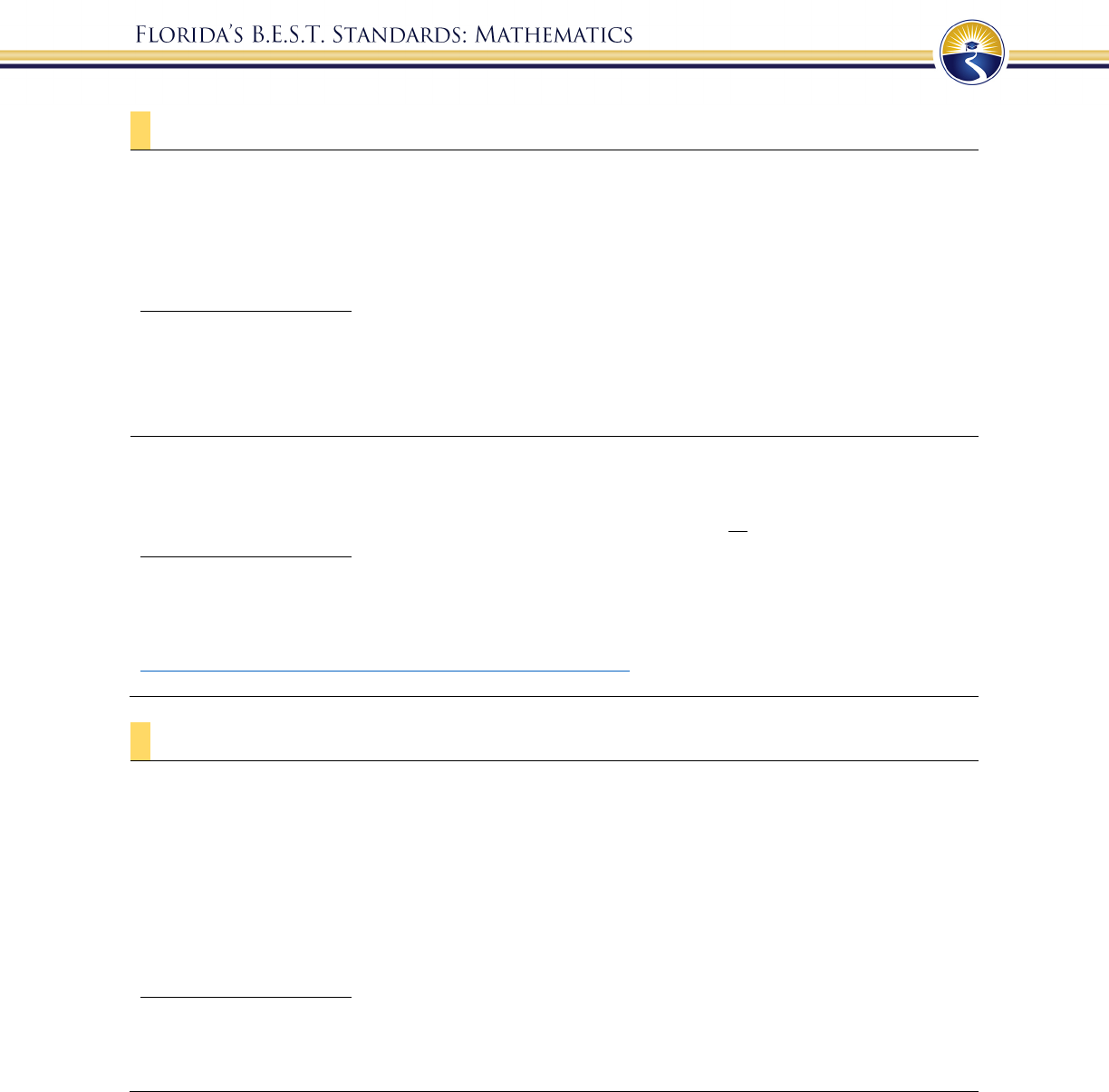
29
MA.2.AR.2 Demonstrate an understanding of equality and addition and subtraction.
MA.2.AR.2.1
Determine and explain whether equations involving addition and subtraction
are true or false.
Example: The equation 27 + 13 = 26 + 14 can be determined to be true because 26
is one less than 27 and 14 is one more than 13.
Benchmark Clarifications:
Clarification 1: Instruction focuses on understanding of the equal sign.
Clarification 2: Problem types are limited to an equation with three or four terms. The sum or
difference can be on either side of the equal sign.
Clarification 3: Addition and subtraction are limited to sums up to 100 and related differences.
MA.2.AR.2.2
Determine the unknown whole number in an addition or subtraction equation,
relating three or four whole numbers, with the unknown in any position.
Example: Determine the unknown in the equation 45 + = 23 + 46.
Benchmark Clarifications:
Clarification 1: Instruction extends the development of algebraic thinking skills where the symbolic
representation of the unknown uses any symbol other than a letter.
Clarification 2: Problems include having the unknown on either side of the equal sign.
Clarification 3: Addition and subtraction are limited to sums up to 100 and related differences. Refer to
Situations Involving Operations with Numbers (Appendix A)
.
MA.2.AR.3 Develop an understanding of multiplication.
MA.2.AR.3.1
Represent an even number using two equal groups or two equal addends.
Represent an odd number using two equal groups with one left over or two
equal addends plus 1.
Example: The number 8 is even because it can be represented as two equal groups of
4 or as the expression 4 + 4.
Example: The number 9 is odd because it can be represented as two equal groups with
one left over or as the expression 4 + 4 + 1.
Benchmark Clarifications:
Clarification 1: Instruction focuses on the connection of recognizing even and odd numbers using skip
counting, arrays and patterns in the ones place.
Clarification 2: Addends are limited to whole numbers less than or equal to 12.
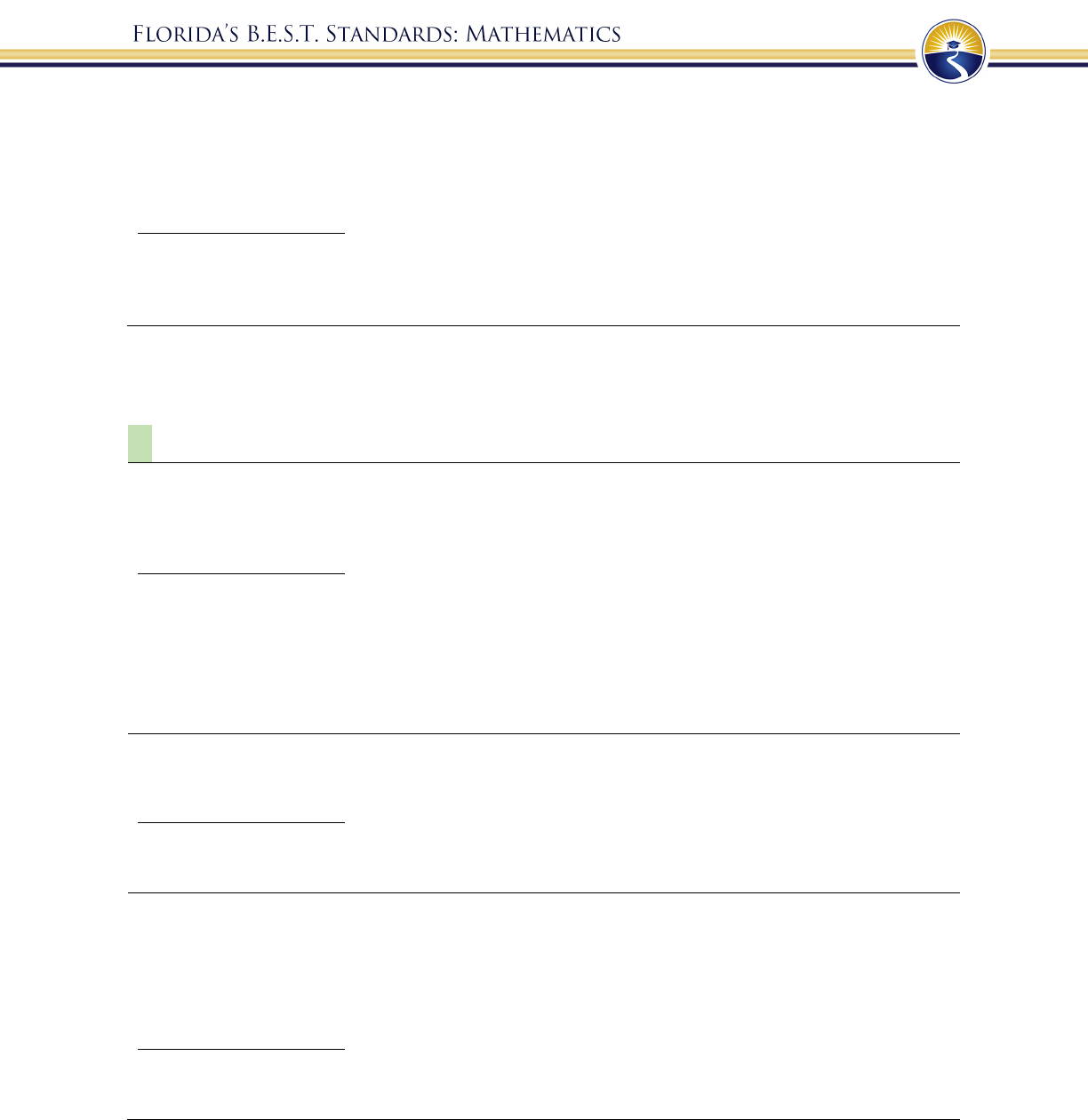
30
MA.2.AR.3.2
Use repeated addition to find the total number of objects in a collection of
equal groups. Represent the total number of objects using rectangular arrays
and equations.
Benchmark Clarifications:
Clarification 1: Instruction includes making a connection between arrays and repeated addition, which
builds a foundation for multiplication.
Clarification 2: The total number of objects is limited to 25.
Measurement
MA.2.M.1 Measure the length of objects and solve problems involving length.
MA.2.M.1.1
Estimate and measure the length of an object to the nearest inch, foot, yard,
centimeter or meter by selecting and using an appropriate tool.
Benchmark Clarifications:
Clarification 1: Instruction includes seeing rulers and tape measures as number lines.
Clarification 2: Instruction focuses on recognizing that when an object is measured in two different
units, fewer of the larger units are required. When comparing measurements of the same object in
different units, measurement conversions are not expected.
Clarification 3: When estimating the size of an object, a comparison with an object of known size can
be used.
MA.2.M.1.2
Measure the lengths of two objects using the same unit and determine the
difference between their measurements.
Benchmark Clarifications:
Clarification 1: Within this benchmark, the expectation is to measure objects to the nearest inch, foot,
yard, centimeter or meter.
MA.2.M.1.3
Solve one- and two-step real-world measurement problems involving addition
and subtraction of lengths given in the same units.
Example: Jeff and Larry are making a rope swing. Jeff has a rope that is 48 inches
long. Larry’s rope is 9 inches shorter than Jeff’s. How much rope do they
have together to make the rope swing?
Benchmark Clarifications:
Clarification 1: Addition and subtraction problems are limited to sums within 100 and related
differences.
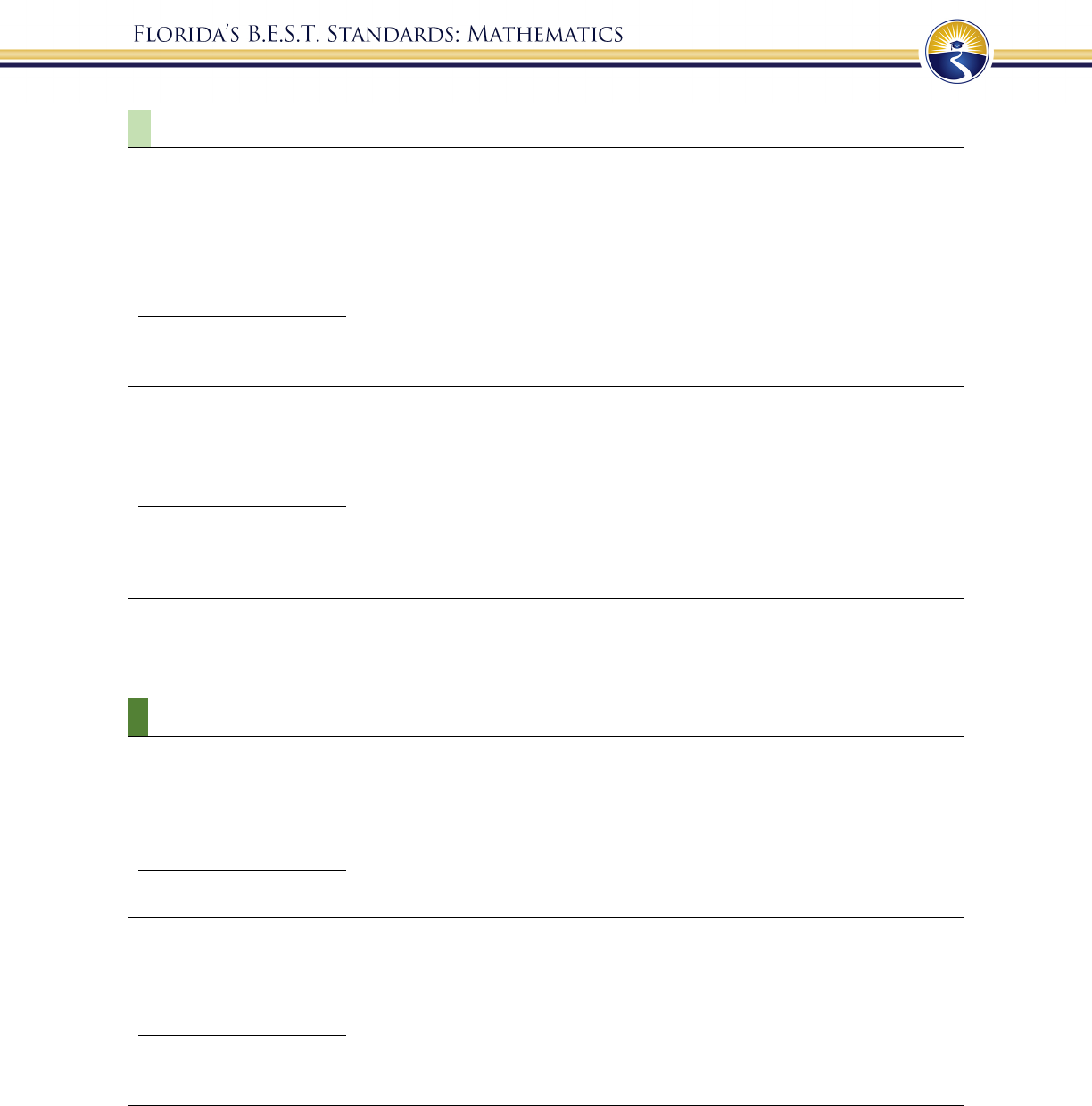
31
MA.2.M.2 Tell time and solve problems involving money.
MA.2.M.2.1
Using analog and digital clocks, tell and write time to the nearest five minutes
using a.m. and p.m. appropriately. Express portions of an hour using the
fractional terms half an hour, half past, quarter of an hour, quarter after and
quarter til.
Benchmark Clarifications:
Clarification 1: Instruction includes the connection to partitioning of circles and to the number line.
Clarification 2: Within this benchmark, the expectation is not to understand military time.
MA.2.M.2.2
Solve one- and two-step addition and subtraction real-world problems involving
either dollar bills within $100 or coins within 100¢ using $ and ¢ symbols
appropriately.
Benchmark Clarifications:
Clarification 1: Within this benchmark, the expectation is not to use decimal values.
Clarification 2: Addition and subtraction problems are limited to sums within 100 and related
differences. Refer to Situations Involving Operations with Numbers (Appendix A)
.
Geometric Reasoning
MA.2.GR.1 Identify and analyze two-dimensional figures and identify lines of symmetry.
MA.2.GR.1.1
Identify and draw two-dimensional figures based on their defining attributes.
Figures are limited to triangles, rectangles, squares, pentagons, hexagons and
octagons.
Benchmark Clarifications:
Clarification 1: Within this benchmark, the expectation includes the use of rulers and straight edges.
MA.2.GR.1.2
Categorize two-dimensional figures based on the number and length of sides,
number of vertices, whether they are closed or not and whether the edges are
curved or straight.
Benchmark Clarifications:
Clarification 1: Instruction focuses on using formal and informal language to describe defining
attributes when categorizing.
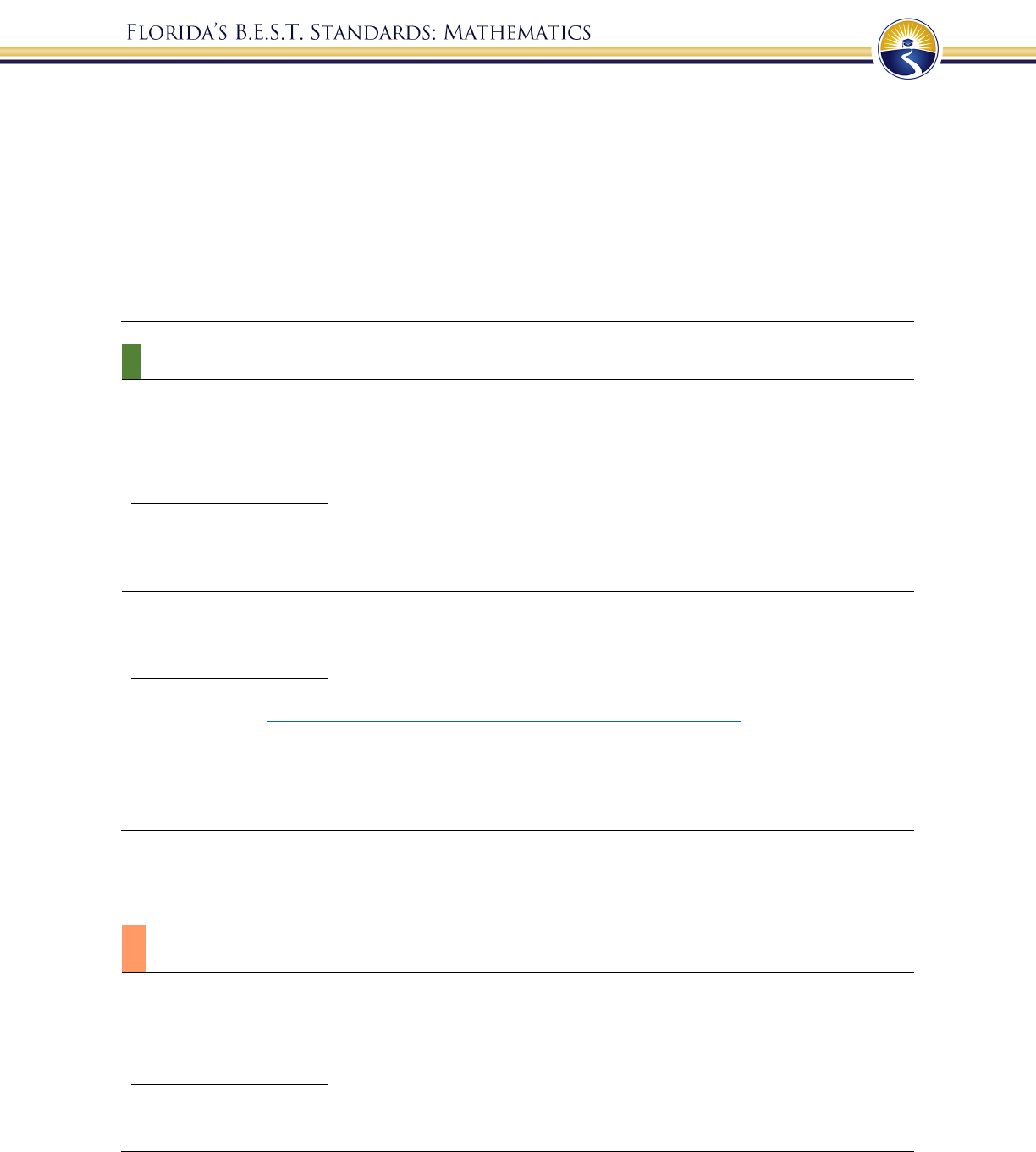
32
MA.2.GR.1.3 Identify line(s) of symmetry for a two-dimensional figure.
Example: Fold a rectangular piece of paper and determine whether the fold is a line of
symmetry by matching the two halves exactly.
Benchmark Clarifications:
Clarification 1: Instruction focuses on the connection between partitioning two-dimensional figures
and symmetry.
Clarification 2: Problem types include being given an image and determining whether a given line is a
line of symmetry or not.
MA.2.GR.2 Describe perimeter and find the perimeter of polygons.
MA.2.GR.2.1
Explore perimeter as an attribute of a figure by placing unit segments along the
boundary without gaps or overlaps. Find perimeters of rectangles by counting
unit segments.
Benchmark Clarifications:
Clarification 1: Instruction emphasizes the conceptual understanding that perimeter is an attribute that
can be measured for a two-dimensional figure.
Clarification 2: Instruction includes real-world objects, such as picture frames or desktops.
MA.2.GR.2.2
Find the perimeter of a polygon with whole-number side lengths. Polygons are
limited to triangles, rectangles, squares and pentagons.
Benchmark Clarifications:
Clarification 1: Instruction includes the connection to the associative and commutative properties of
addition. Refer to Properties of Operations, Equality and Inequality (Appendix D)
.
Clarification 2: Within this benchmark, the expectation is not to use a formula to find perimeter.
Clarification 3: Instruction includes cases where the side lengths are given or measured to the nearest
unit.
Clarification 4: Perimeter cannot exceed 100 units and responses include the appropriate units.
Data Analysis and Probability
MA.2.DP.1 Collect, categorize, represent and interpret data using appropriate titles,
labels and units.
MA.2.DP.1.1
Collect, categorize and represent data using tally marks, tables, pictographs or
bar graphs. Use appropriate titles, labels and units.
Benchmark Clarifications:
Clarification 1: Data displays can be represented both horizontally and vertically. Scales on graphs are
limited to ones, fives or tens.

33
MA.2.DP.1.2
Interpret data represented with tally marks, tables, pictographs or bar graphs
including solving addition and subtraction problems.
Benchmark Clarifications:
Clarification 1: Addition and subtraction problems are limited to whole numbers with sums within 100
and related differences.
Clarification 2: Data displays can be represented both horizontally and vertically. Scales on graphs are
limited to ones, fives or tens.

34
Grade 3
In grade 3, instructional time will emphasize four areas:
(1) adding and subtracting multi-digit whole numbers, including using a standard
algorithm;
(2) building an understanding of multiplication and division, the relationship between
them and the connection to area of rectangles;
(3) developing an understanding of fractions and
(4) extending geometric reasoning to lines and attributes of quadrilaterals.
Number Sense and Operations
MA.3.NSO.1 Understand the place value of four-digit numbers.
MA.3.NSO.1.1
Read and write numbers from 0 to 10,000 using standard form, expanded
form and word form.
Example: The number two thousand five hundred thirty written in standard form is
2,530 and in expanded form is 2,000 + 500 + 30.
MA.3.NSO.1.2
Compose and decompose four-digit numbers in multiple ways using
thousands, hundreds, tens and ones. Demonstrate each composition or
decomposition using objects, drawings and expressions or equations.
Example: The number 5,783 can be expressed as
5 + 7 + 8 + 3 or as
56 + 183 .
MA.3.NSO.1.3 Plot, order and compare whole numbers up to 10,000.
Example: The numbers 3,475; 4,743 and 4,753 can be arranged in ascending order
as 3,475; 4,743 and 4,753.
Benchmark Clarifications:
Clarification 1: When comparing numbers, instruction includes using an appropriately scaled number
line and using place values of the thousands, hundreds, tens and ones digits.
Clarification 2: Number lines, scaled by 50s, 100s or 1,000s, must be provided and can be a
representation of any range of numbers.
Clarification 3: Within this benchmark, the expectation is to use symbols (<, > or =).
MA.3.NSO.1.4 Round whole numbers from 0 to 1,000 to the nearest 10 or 100.
Example: The number 775 is rounded to 780 when rounded to the nearest 10.
Example: The number 745 is rounded to 700 when rounded to the nearest 100.
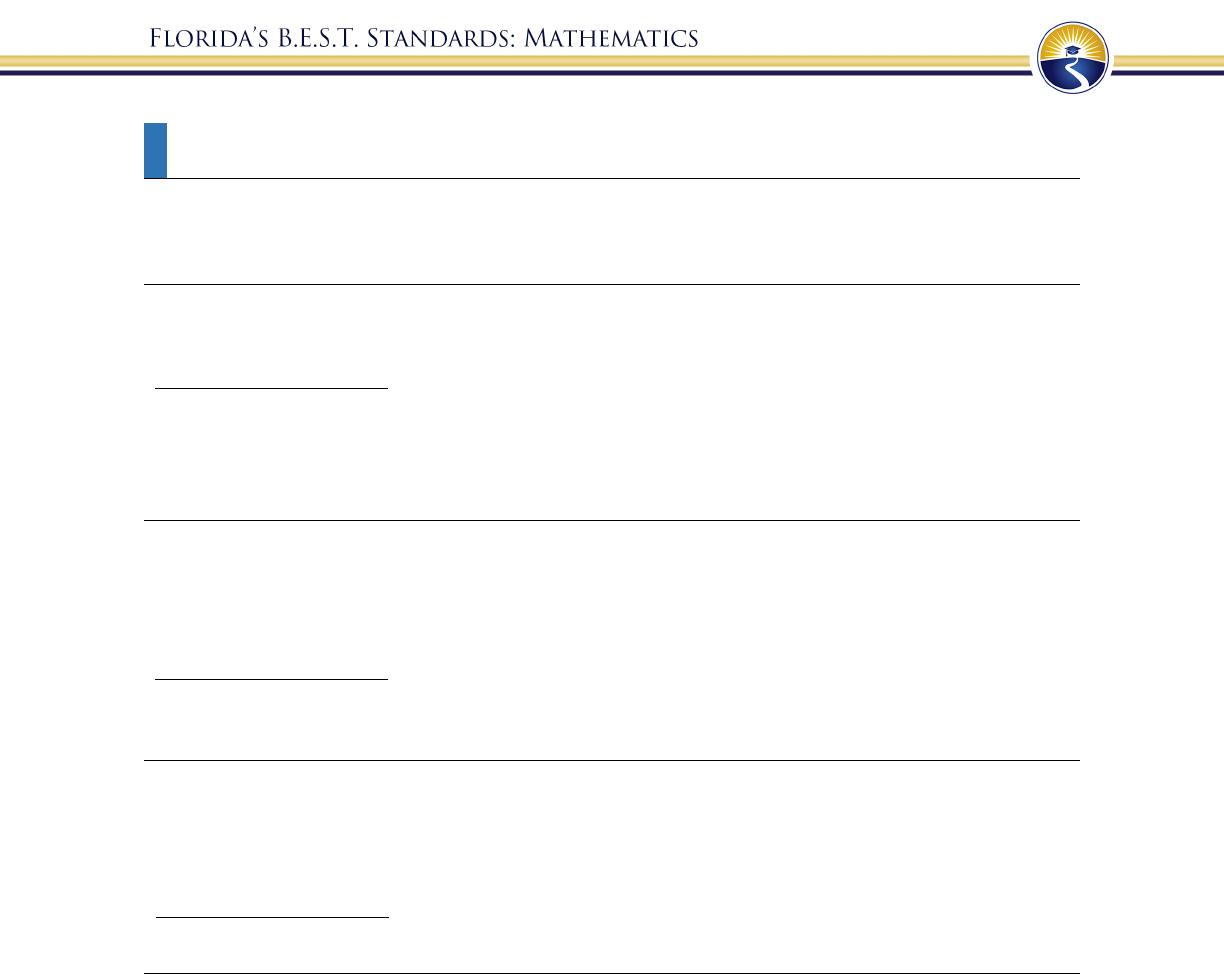
35
MA.3.NSO.2 Add and subtract multi-digit whole numbers. Build an understanding of
multiplication and division operations.
MA.3.NSO.2.1
Add and subtract multi-digit whole numbers including using a standard
algorithm with procedural fluency.
MA.3.NSO.2.2
Explore multiplication of two whole numbers with products from 0 to 144,
and related division facts.
Benchmark Clarifications:
Clarification 1: Instruction includes equal groups, arrays, area models and equations.
Clarification 2: Within the benchmark, it is the expectation that one problem can be represented in
multiple ways and understanding how the different representations are related to each other.
Clarification 3: Factors and divisors are limited to up to 12.
MA.3.NSO.2.3
Multiply a one-digit whole number by a multiple of 10, up to 90, or a
multiple of 100, up to 900, with procedural reliability.
Example: The product of 6 and 70 is 420.
Example: The product of 6 and 300 is 1,800.
Benchmark Clarifications:
Clarification 1: When multiplying one-digit numbers by multiples of 10 or 100, instruction focuses on
methods that are based on place value.
MA.3.NSO.2.4
Multiply two whole numbers from 0 to 12 and divide using related facts with
procedural reliability.
Example: The product of 5 and 6 is 30.
Example: The quotient of 27 and 9 is 3.
Benchmark Clarifications:
Clarification 1: Instruction focuses on helping a student choose a method they can use reliably.
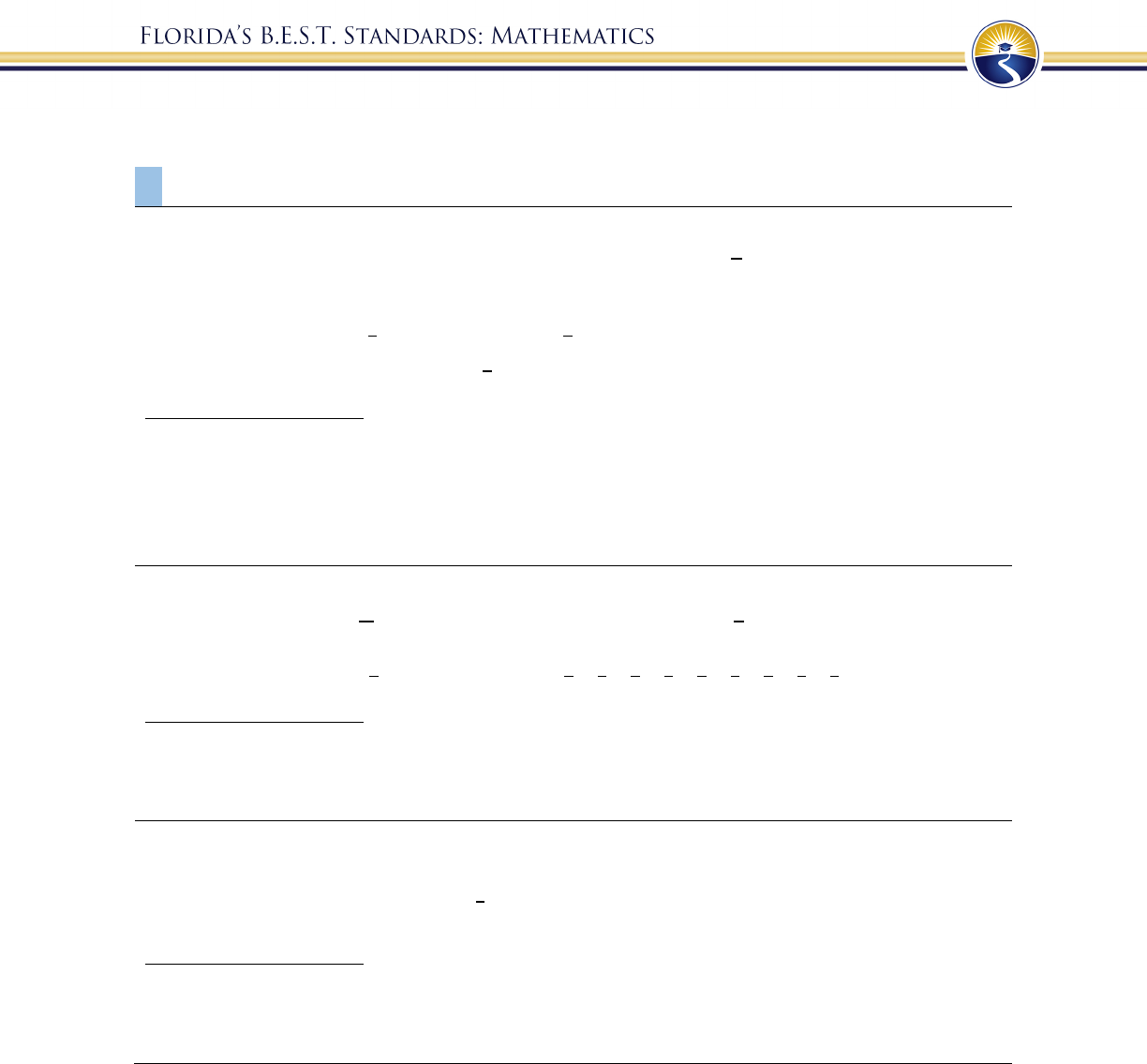
36
Fractions
MA.3.FR.1 Understand fractions as numbers and represent fractions.
MA.3.FR.1.1
Represent and interpret unit fractions in the form
as the quantity formed by
one part when a whole is partitioned into n equal parts.
Example:
can be represented as
of a pie (parts of a shape), as 1 out of 4 trees (parts
of a set) or as
on the number line.
Benchmark Clarifications:
Clarification 1: This benchmark emphasizes conceptual understanding through the use of
manipulatives or visual models.
Clarification 2: Instruction focuses on representing a unit fraction as part of a whole, part of a set, a
point on a number line, a visual model or in fractional notation.
Clarification 3: Denominators are limited to 2, 3, 4, 5, 6, 8, 10 and 12.
MA.3.FR.1.2
Represent and interpret fractions, including fractions greater than one, in the
form of
as the result of adding the unit fraction
to itself times.
Example:
can be represented as
+
+
+
+
+
+
+
+
.
Benchmark Clarifications:
Clarification 1: Instruction emphasizes conceptual understanding through the use of manipulatives or
visual models, including circle graphs, to represent fractions.
Clarification 2: Denominators are limited to 2, 3, 4, 5, 6, 8, 10 and 12.
MA.3.FR.1.3
Read and write fractions, including fractions greater than one, using standard
form, numeral-word form and word form.
Example: The fraction
written in word form is four-thirds and in numeral-word form
is 4 .
Benchmark Clarifications:
Clarification 1: Instruction focuses on making connections to reading and writing numbers to develop
the understanding that fractions are numbers and to support algebraic thinking in later grades.
Clarification 2: Denominators are limited to 2, 3, 4, 5, 6, 8, 10 and 12.

37
MA.3.FR.2 Order and compare fractions and identify equivalent fractions.
MA.3.FR.2.1
Plot, order and compare fractional numbers with the same numerator or the
same denominator.
Example: The fraction
is to the right of the fraction
on a number line so
is
greater than
.
Benchmark Clarifications:
Clarification 1: Instruction includes making connections between using a ruler and plotting and
ordering fractions on a number line.
Clarification 2: When comparing fractions, instruction includes an appropriately scaled number line
and using reasoning about their size.
Clarification 3: Fractions include fractions greater than one, including mixed numbers, with
denominators limited to 2, 3, 4, 5, 6, 8, 10 and 12.
MA.3.FR.2.2 Identify equivalent fractions and explain why they are equivalent.
Example: The fractions
and
can be identified as equivalent using number lines.
Example: The fractions
and
can be identified as not equivalent using a visual
model.
Benchmark Clarifications:
Clarification 1: Instruction includes identifying equivalent fractions and explaining why they are
equivalent using manipulatives, drawings, and number lines.
Clarification 2: Within this benchmark, the expectation is not to generate equivalent fractions.
Clarification 3: Fractions are limited to fractions less than or equal to one with denominators of 2, 3, 4,
5, 6, 8, 10 and 12. Number lines must be given and scaled appropriately.

38
Algebraic Reasoning
MA.3.AR.1 Solve multiplication and division problems.
MA.3.AR.1.1
Apply the distributive property to multiply a one-digit number and two-digit
number. Apply properties of multiplication to find a product of one-digit
whole numbers.
Example:
The product 4 × 72 can be found by rewriting the expression as
4 × (70 + 2) and then using the distributive property to obtain
(
4 × 70
)
+ (4 × 2)
which is equivalent to 288.
Benchmark Clarifications:
Clarification 1: Within this benchmark, the expectation is to apply the associative and commutative
properties of multiplication, the distributive property and name the properties. Refer to
K-12 Glossary
(Appendix C).
Clarification 2: Within the benchmark, the expectation is to utilize parentheses.
Clarification 3: Multiplication for products of three or more numbers is limited to factors within 12.
Refer to Properties of Operations, Equality and Inequality (Appendix D)
.
MA.3.AR.1.2
Solve one- and two-step real-world problems involving any of four operations
with whole numbers.
Example: A group of students are playing soccer during lunch. How many students
are needed to form four teams with eleven players each and to have two
referees?
Benchmark Clarifications:
Clarification 1: Instruction includes understanding the context of the problem, as well as the quantities
within the problem.
Clarification 2: Multiplication is limited to factors within 12 and related division facts. Refer to
Situations Involving Operations with Numbers (Appendix A)
.
MA.3.AR.2 Develop an understanding of equality and multiplication and division.
MA.3.AR.2.1
Restate a division problem as a missing factor problem using the relationship
between multiplication and division.
Example: The equation 56 ÷ 7 =? can be restated as 7 ×? = 56 to determine the
quotient is 8.
Benchmark Clarifications:
Clarification 1: Multiplication is limited to factors within 12 and related division facts.
Clarification 2: Within this benchmark, the symbolic representation of the missing factor uses any
symbol or a letter.
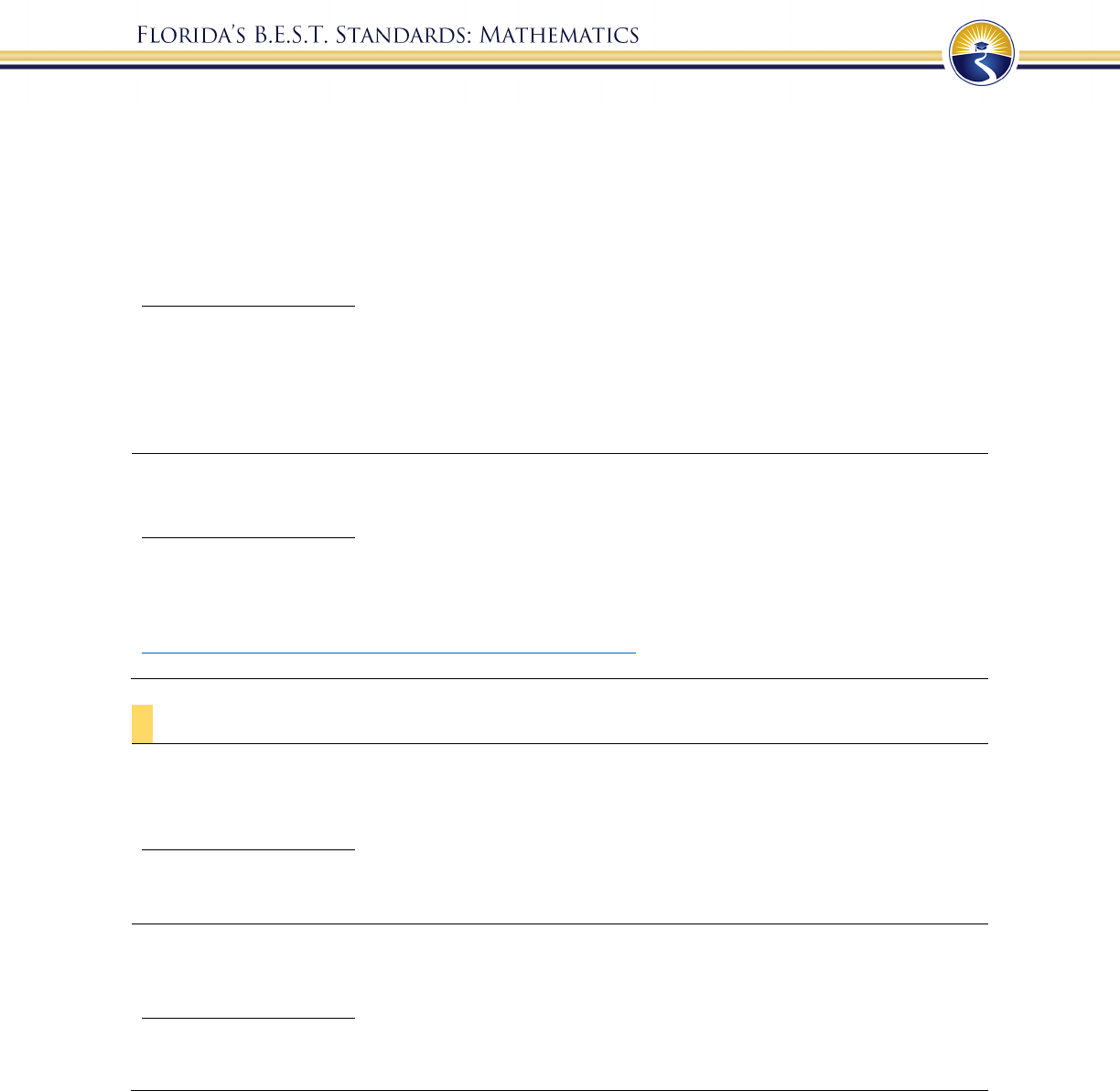
39
MA.3.AR.2.2
Determine and explain whether an equation involving multiplication or
division is true or false.
Example:
Given the equation 27 ÷ 3 = 3 × 3 , it can be determined to be a true
equation by dividing the numbers on the left side of the equal sign and
multiplying the numbers on the right of the equal sign to see that both sides
are equivalent to 9.
Benchmark Clarifications:
Clarification 1: Instruction extends the understanding of the meaning of the equal sign to multiplication
and division.
Clarification 2: Problem types are limited to an equation with three or four terms. The product or
quotient can be on either side of the equal sign.
Clarification 3: Multiplication is limited to factors within 12 and related division facts.
MA.3.AR.2.3
Determine the unknown whole number in a multiplication or division
equation, relating three whole numbers, with the unknown in any position.
Benchmark Clarifications:
Clarification 1: Instruction extends the development of algebraic thinking skills where the symbolic
representation of the unknown uses any symbol or a letter.
Clarification 2: Problems include the unknown on either side of the equal sign.
Clarification 3: Multiplication is limited to factors within 12 and related division facts. Refer to
Situations Involving Operations with Numbers (Appendix A)
.
MA.3.AR.3 Identify numerical patterns, including multiplicative patterns.
MA.3.AR.3.1
Determine and explain whether a whole number from 1 to 1,000 is even or
odd.
Benchmark Clarifications:
Clarification 1: Instruction includes determining and explaining using place value and recognizing
patterns.
MA.3.AR.3.2
Determine whether a whole number from 1 to 144 is a multiple of a given one-
digit number.
Benchmark Clarifications:
Clarification 1: Instruction includes determining if a number is a multiple of a given number by using
multiplication or division.
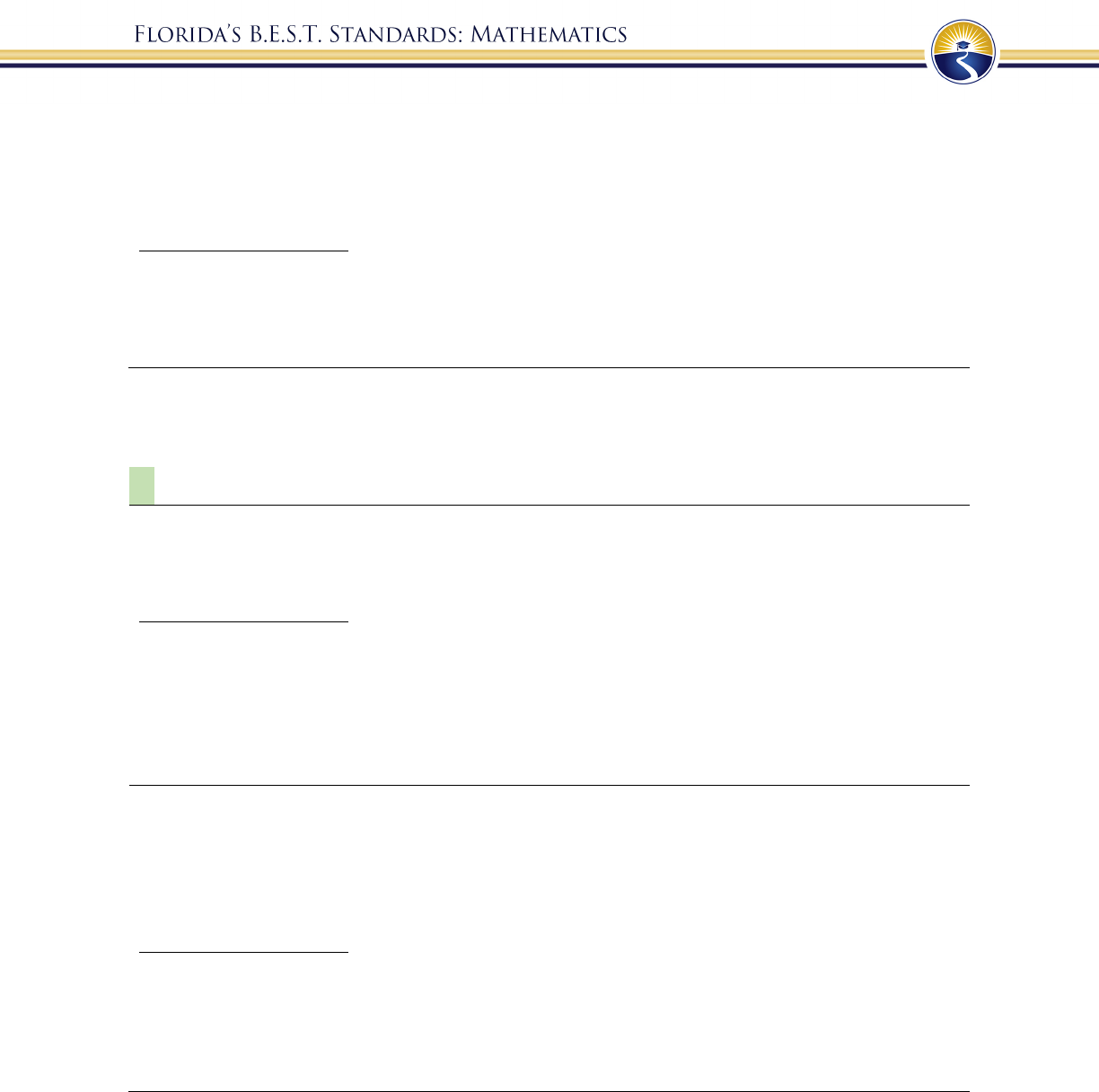
40
MA.3.AR.3.3
Identify, create and extend numerical patterns.
Example: Bailey collects 6 baseball cards every day. This generates the pattern
6, 12, 18, … How many baseball cards will Bailey have at the end of the
sixth day?
Benchmark Clarifications:
Clarification 1: The expectation is to use ordinal numbers (1
st
, 2
nd
, 3
rd
, …) to describe the position of a
number within a sequence.
Clarification 2: Problem types include patterns involving addition, subtraction, multiplication or
division of whole numbers.
Measurement
MA.3.M.1 Measure attributes of objects and solve problems involving measurement.
MA.3.M.1.1
Select and use appropriate tools to measure the length of an object, the volume
of liquid within a beaker and temperature.
Benchmark Clarifications:
Clarification 1: Instruction focuses on identifying measurement on a linear scale, making the
connection to the number line.
Clarification 2: When measuring the length, limited to the nearest centimeter and half or quarter inch.
Clarification 3: When measuring the temperature, limited to the nearest degree.
Clarification 4: When measuring the volume of liquid, limited to nearest milliliter and half or quarter
cup.
MA.3.M.1.2
Solve real-world problems involving any of the four operations with whole-
number lengths, masses, weights, temperatures or liquid volumes.
Example: Ms. Johnson’s class is having a party. Eight students each brought in a 2-liter
bottle of soda for the party. How many liters of soda did the class have for the
party?
Benchmark Clarifications:
Clarification 1: Within this benchmark, it is the expectation that responses include appropriate units.
Clarification 2: Problem types are not expected to include measurement conversions.
Clarification 3: Instruction includes the comparison of attributes measured in the same units.
Clarification 4: Units are limited to yards, feet, inches; meters, centimeters; pounds, ounces; kilograms,
grams; degrees Fahrenheit, degrees Celsius; gallons, quarts, pints, cups; and liters, milliliters.

41
MA.3.M.2 Tell and write time and solve problems involving time.
MA.3.M.2.1
Using analog and digital clocks tell and write time to the nearest minute using
a.m. and p.m. appropriately.
Benchmark Clarifications:
Clarification 1: Within this benchmark, the expectation is not to understand military time.
MA.3.M.2.2 Solve one- and two-step real-world problems involving elapsed time.
Example: A bus picks up Kimberly at 6:45 a.m. and arrives at school at 8:15 a.m. How
long was her bus ride?
Benchmark Clarifications:
Clarification 1: Within this benchmark, the expectation is not to include crossing between a.m. and
p.m.
Geometric Reasoning
MA.3.GR.1 Describe and identify relationships between lines and classify quadrilaterals.
MA.3.GR.1.1
Describe and draw points, lines, line segments, rays, intersecting lines,
perpendicular lines and parallel lines. Identify these in two-dimensional
figures.
Benchmark Clarifications:
Clarification 1: Instruction includes mathematical and real-world context for identifying points, lines,
line segments, rays, intersecting lines, perpendicular lines and parallel lines.
Clarification 2: When working with perpendicular lines, right angles can be called square angles or
square corners.
MA.3.GR.1.2
Identify and draw quadrilaterals based on their defining attributes.
Quadrilaterals include parallelograms, rhombi, rectangles, squares and
trapezoids.
Benchmark Clarifications:
Clarification 1: Instruction includes a variety of quadrilaterals and a variety of non-examples that lack
one or more defining attributes when identifying quadrilaterals.
Clarification 2: Quadrilaterals will be filled, outlined or both when identifying.
Clarification 3: Drawing representations must be reasonably accurate.
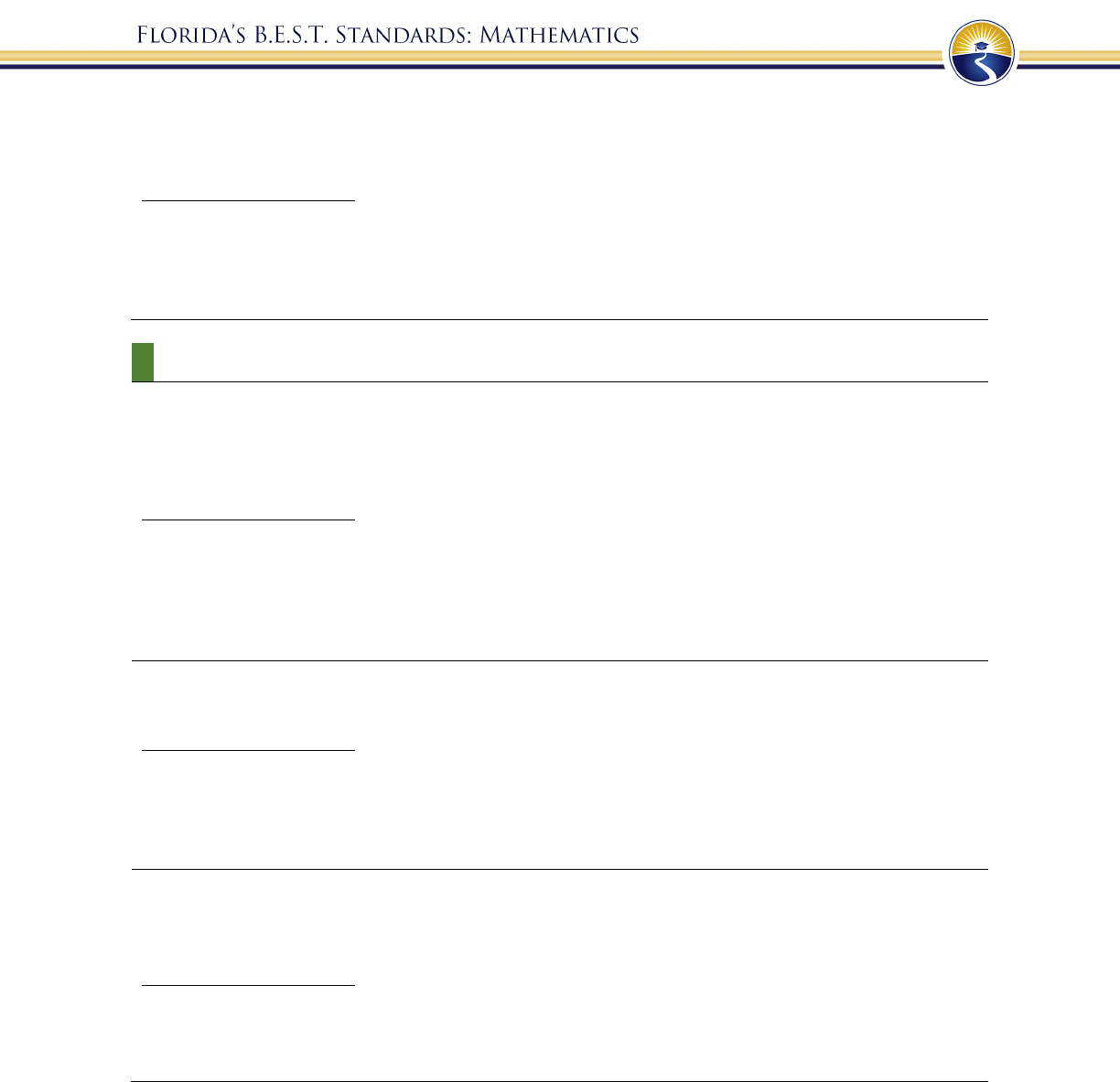
42
MA.3.GR.1.3
Draw line(s) of symmetry in a two-dimensional figure and identify line-
symmetric two-dimensional figures.
Benchmark Clarifications:
Clarification 1: Instruction develops the understanding that there could be no line of symmetry, exactly
one line of symmetry or more than one line of symmetry.
Clarification 2: Instruction includes folding paper along a line of symmetry so that both halves match
exactly to confirm line-symmetric figures.
MA.3.GR.2 Solve problems involving the perimeter and area of rectangles.
MA.3.GR.2.1
Explore area as an attribute of a two-dimensional figure by covering the figure
with unit squares without gaps or overlaps. Find areas of rectangles by
counting unit squares.
Benchmark Clarifications:
Clarification 1: Instruction emphasizes the conceptual understanding that area is an attribute that can
be measured for a two-dimensional figure. The measurement unit for area is the area of a unit square,
which is a square with side length of 1 unit.
Clarification 2: Two-dimensional figures cannot exceed 12 units by 12 units and responses include the
appropriate units in word form (e.g., square centimeter or sq.cm.).
MA.3.GR.2.2
Find the area of a rectangle with whole-number side lengths using a visual
model and a multiplication formula.
Benchmark Clarifications:
Clarification 1: Instruction includes covering the figure with unit squares, a rectangular array or
applying a formula.
Clarification 2: Two-dimensional figures cannot exceed 12 units by 12 units and responses include the
appropriate units in word form.
MA.3.GR.2.3
Solve mathematical and real-world problems involving the perimeter and area
of rectangles with whole-number side lengths using a visual model and a
formula.
Benchmark Clarifications:
Clarification 1: Within this benchmark, the expectation is not to find unknown side lengths.
Clarification 2: Two-dimensional figures cannot exceed 12 units by 12 units and responses include the
appropriate units in word form.
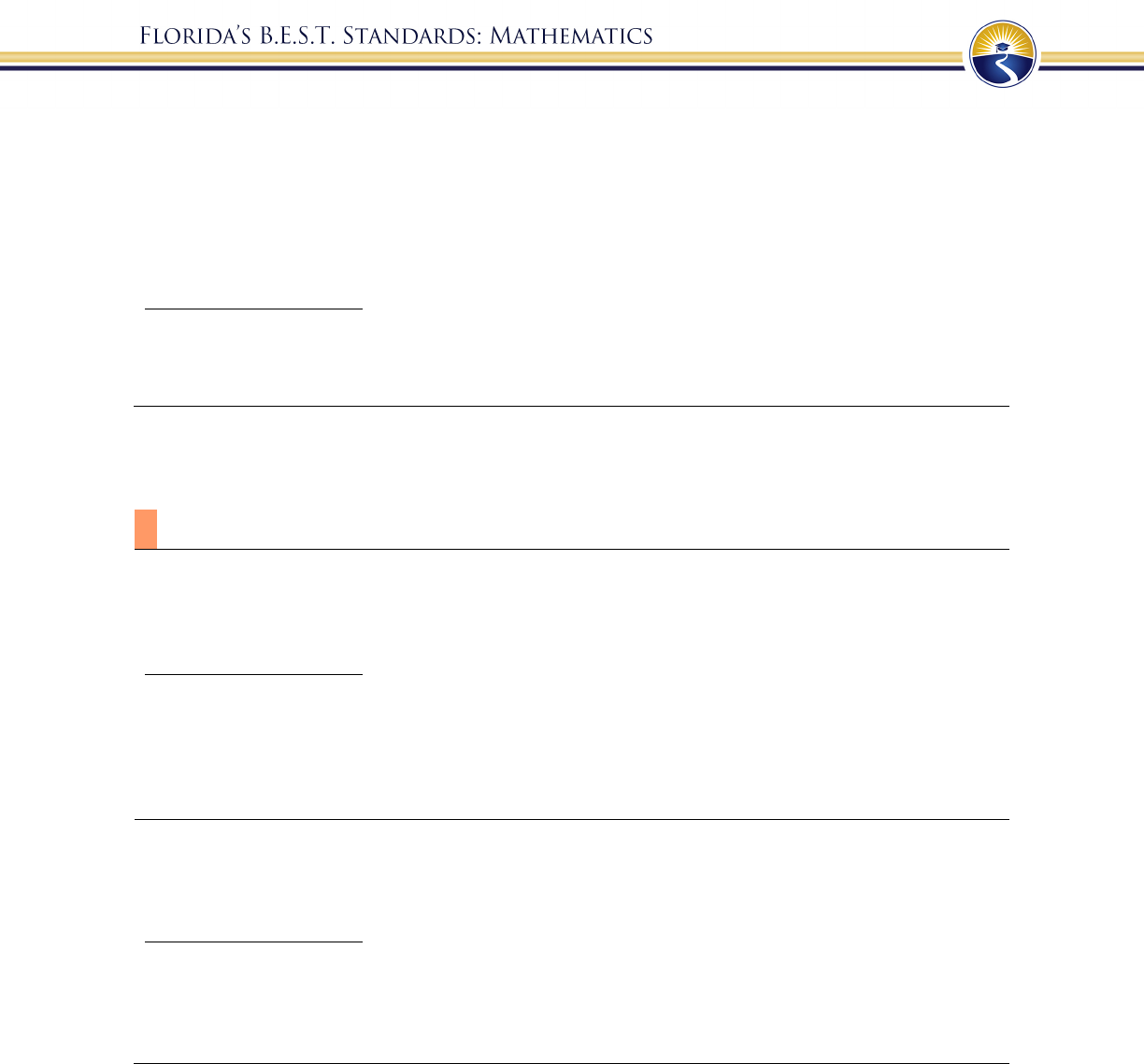
43
MA.3.GR.2.4
Solve mathematical and real-world problems involving the perimeter and area
of composite figures composed of non-overlapping rectangles with whole-
number side lengths.
Example: A pool is comprised of two non-overlapping rectangles in the shape of an
“L”. The area for a cover of the pool can be found by adding the areas of
the two non-overlapping rectangles.
Benchmark Clarifications:
Clarification 1: Composite figures must be composed of non-overlapping rectangles.
Clarification 2: Each rectangle within the composite figure cannot exceed 12 units by 12 units and
responses include the appropriate units in word form.
Data Analysis and Probability
MA.3.DP.1 Collect, represent and interpret numerical and categorical data.
MA.3.DP.1.1
Collect and represent numerical and categorical data with whole-number
values using tables, scaled pictographs, scaled bar graphs or line plots. Use
appropriate titles, labels and units.
Benchmark Clarifications:
Clarification 1: Within this benchmark, the expectation is to complete a representation or construct a
representation from a data set.
Clarification 2: Instruction includes the connection between multiplication and the number of data
points represented by a bar in scaled bar graph or a scaled column in a pictograph.
Clarification 3: Data displays are represented both horizontally and vertically.
MA.3.DP.1.2
Interpret data with whole-number values represented with tables, scaled
pictographs, circle graphs, scaled bar graphs or line plots by solving one- and
two-step problems.
Benchmark Clarifications:
Clarification 1: Problems include the use of data in informal comparisons between two data sets in the
same units.
Clarification 2: Data displays can be represented both horizontally and vertically.
Clarification 3: Circle graphs are limited to showing the total values in each category.
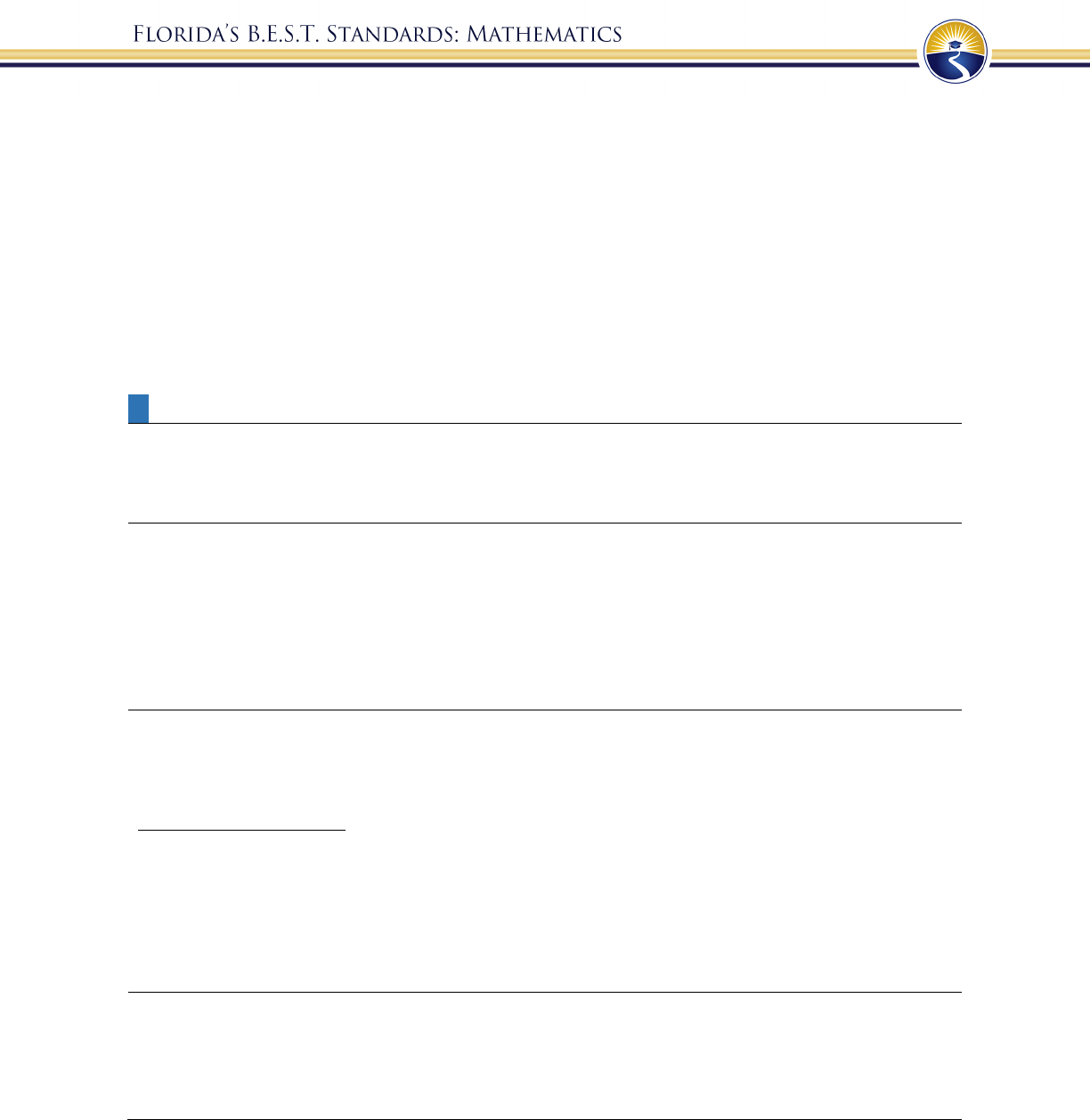
44
Grade 4
In grade 4, instructional time will emphasize four areas:
(1) extending understanding of multi-digit multiplication and division;
(2) developing the relationship between fractions and decimals and beginning operations
with both;
(3) classifying and measuring angles and
(4) developing an understanding for interpreting data to include mode, median and range.
Number Sense and Operations
MA.4.NSO.1 Understand place value for multi-digit numbers.
MA.4.NSO.1.1
Express how the value of a digit in a multi-digit whole number changes if the
digit moves one place to the left or right.
MA.4.NSO.1.2
Read and write multi-digit whole numbers from 0 to 1,000,000 using
standard form, expanded form and word form.
Example: The number two hundred seventy-five thousand eight hundred two written
in standard form is 275,802 and in expanded form is
200,000 + 70,000 + 5,000 + 800 + 2 or
(2 × 100,000) + (7 × 10,000) + (5 × 1,000) + (8 × 100) + (2 × 1).
MA.4.NSO.1.3 Plot, order and compare multi-digit whole numbers up to 1,000,000.
Example: The numbers 75,421; 74,241 and 74,521 can be arranged in ascending
order as 74,241; 74,521 and 75,421.
Benchmark Clarifications:
Clarification 1: When comparing numbers, instruction includes using an appropriately scaled number
line and using place values of the hundred thousands, ten thousands, thousands, hundreds, tens and
ones digits.
Clarification 2: Scaled number lines must be provided and can be a representation of any range of
numbers.
Clarification 3: Within this benchmark, the expectation is to use symbols (<, > or =).
MA.4.NSO.1.4 Round whole numbers from 0 to 10,000 to the nearest 10, 100 or 1,000.
Example: The number 6,325 is rounded to 6,300 when rounded to the nearest 100.
Example: The number 2,550 is rounded to 3,000 when rounded to the nearest 1,000.
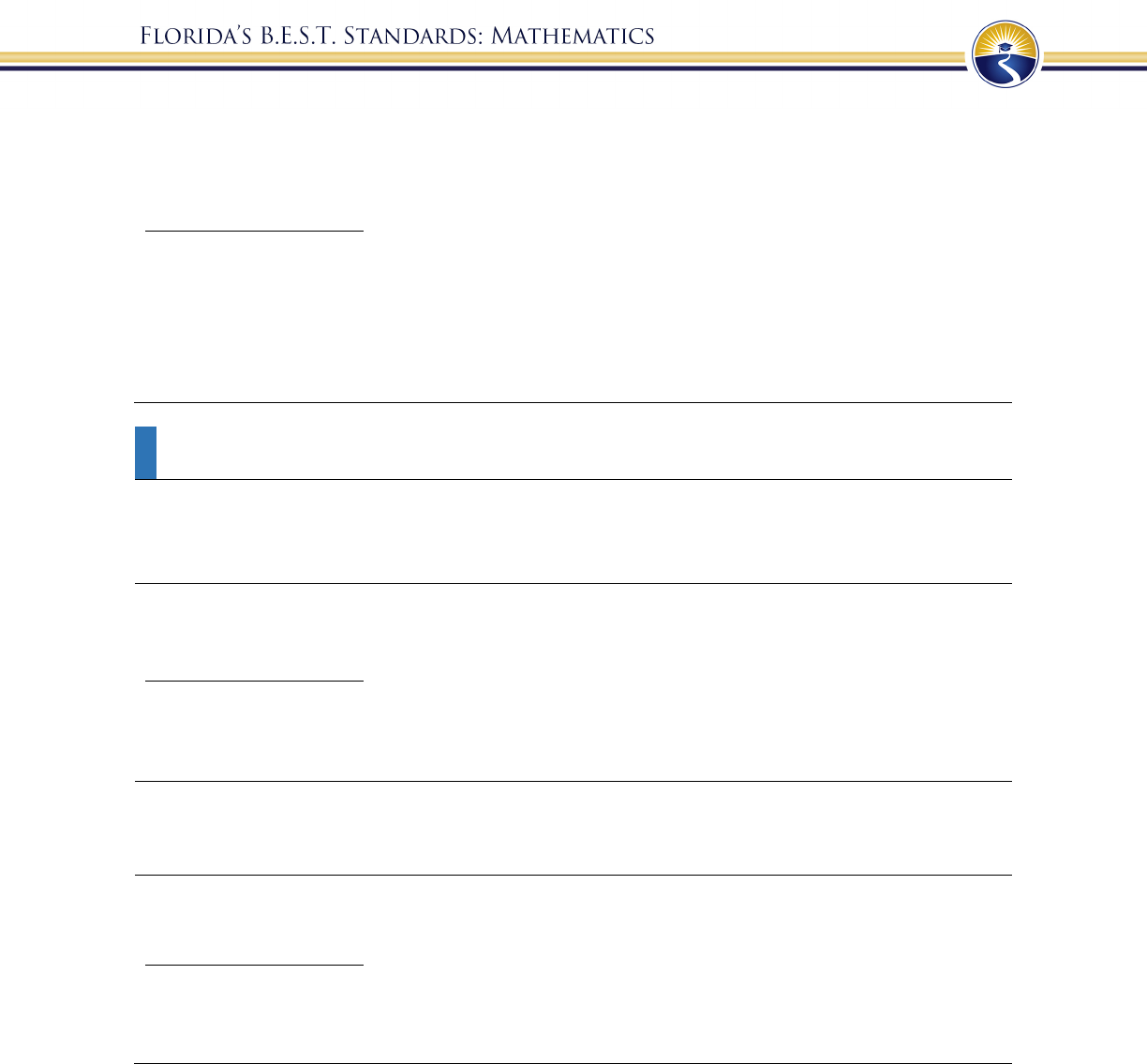
45
MA.4.NSO.1.5
Plot, order and compare decimals up to the hundredths.
Example: The numbers 3.2; 3.24 and 3.12 can be arranged in ascending order as
3.12; 3.2 and 3.24.
Benchmark Clarifications:
Clarification 1: When comparing numbers, instruction includes using an appropriately scaled number
line and using place values of the ones, tenths and hundredths digits.
Clarification 2: Within the benchmark, the expectation is to explain the reasoning for the comparison
and use symbols (<, > or =).
Clarification 3: Scaled number lines must be provided and can be a representation of any range of
numbers.
MA.4.NSO.2 Build an understanding of operations with multi-digit numbers including
decimals.
MA.4.NSO.2.1
Recall multiplication facts with factors up to 12 and related division facts
with automaticity.
MA.4.NSO.2.2
Multiply two whole numbers, up to three digits by up to two digits, with
procedural reliability.
Benchmark Clarifications:
Clarification 1: Instruction focuses on helping a student choose a method they can use reliably.
Clarification 2: Instruction includes the use of models or equations based on place value and the
distributive property.
MA.4.NSO.2.3
Multiply two whole numbers, each up to two digits, including using a
standard algorithm with procedural fluency.
MA.4.NSO.2.4
Divide a whole number up to four digits by a one-digit whole number with
procedural reliability. Represent remainders as fractional parts of the divisor.
Benchmark Clarifications:
Clarification 1: Instruction focuses on helping a student choose a method they can use reliably.
Clarification 2: Instruction includes the use of models based on place value, properties of operations or
the relationship between multiplication and division.
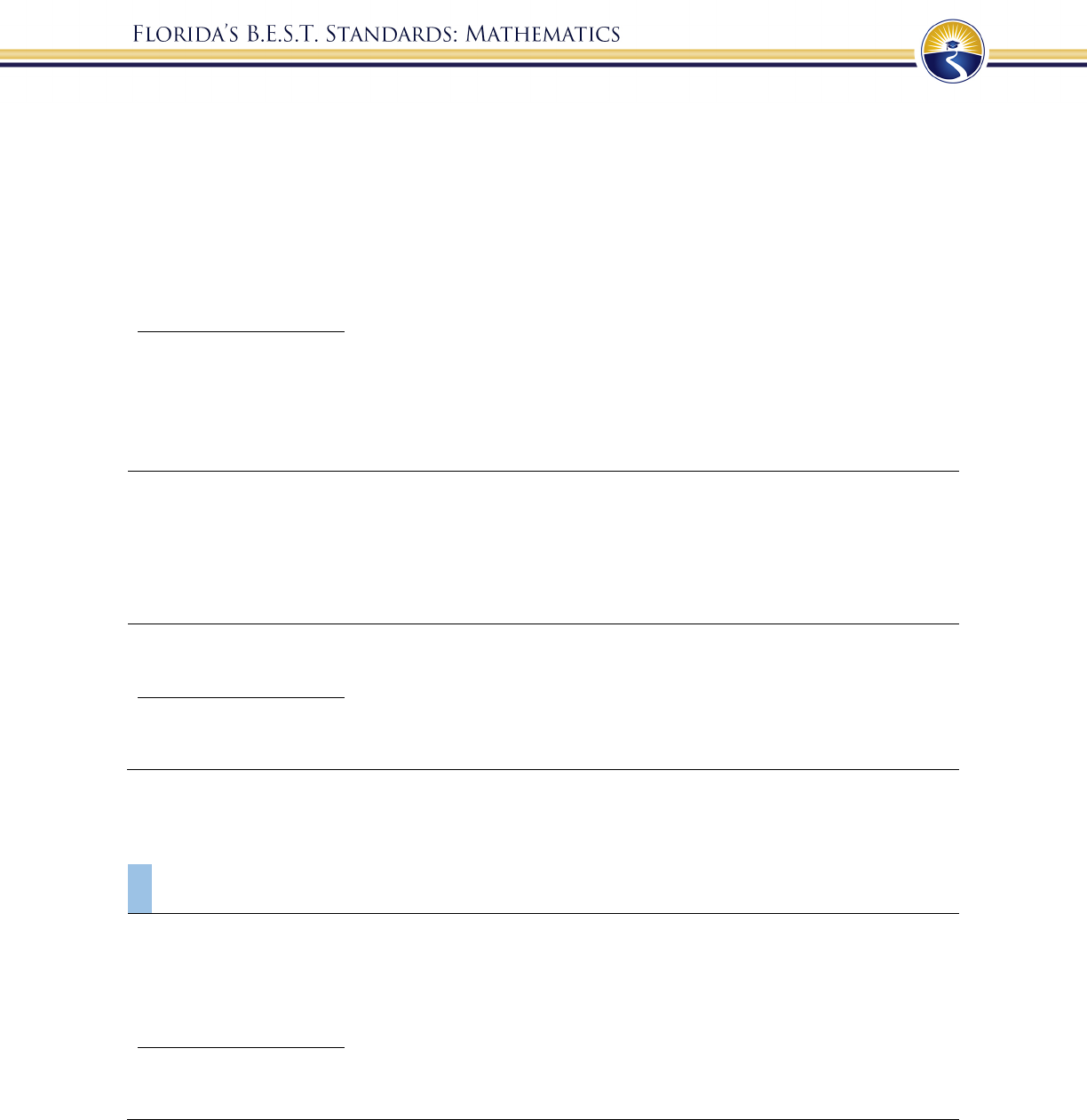
46
MA.4.NSO.2.5
Explore the multiplication and division of multi-digit whole numbers using
estimation, rounding and place value.
Example: The product of 215 and 460 can be estimated as being between 80,000
and 125,000 because it is bigger than 200 × 400 but smaller than 250 ×
500.
Example: The quotient of 1,380 and 27 can be estimated as 50 because 27 is close to
30 and 1,380 is close to 1,500. 1,500 divided by 30 is the same as
150 divided by 3 which is 5 , or 50.
Benchmark Clarifications:
Clarification 1: Instruction focuses on previous understanding of multiplication with multiples of 10
and 100, and seeing division as a missing factor problem.
Clarification 2: Estimating quotients builds the foundation for division using a standard algorithm.
Clarification 3: When estimating the division of whole numbers, dividends are limited to up to four
digits and divisors are limited to up to two digits.
MA.4.NSO.2.6
Identify the number that is one-tenth more, one-tenth less, one-hundredth
more and one-hundredth less than a given number.
Example: One-hundredth less than 1.10 is 1.09.
Example: One-tenth more than 2.31 is 2.41.
MA.4.NSO.2.7
Explore the addition and subtraction of multi-digit numbers with decimals to
the hundredths.
Benchmark Clarifications:
Clarification 1: Instruction includes the connection to money and the use of manipulatives and models
based on place value.
Fractions
MA.4.FR.1 Develop an understanding of the relationship between different fractions and
the relationship between fractions and decimals.
MA.4.FR.1.1
Model and express a fraction, including mixed numbers and fractions greater
than one, with the denominator 10 as an equivalent fraction with the
denominator 100.
Benchmark Clarifications:
Clarification 1: Instruction emphasizes conceptual understanding through the use of manipulatives,
visual models, number lines or equations.
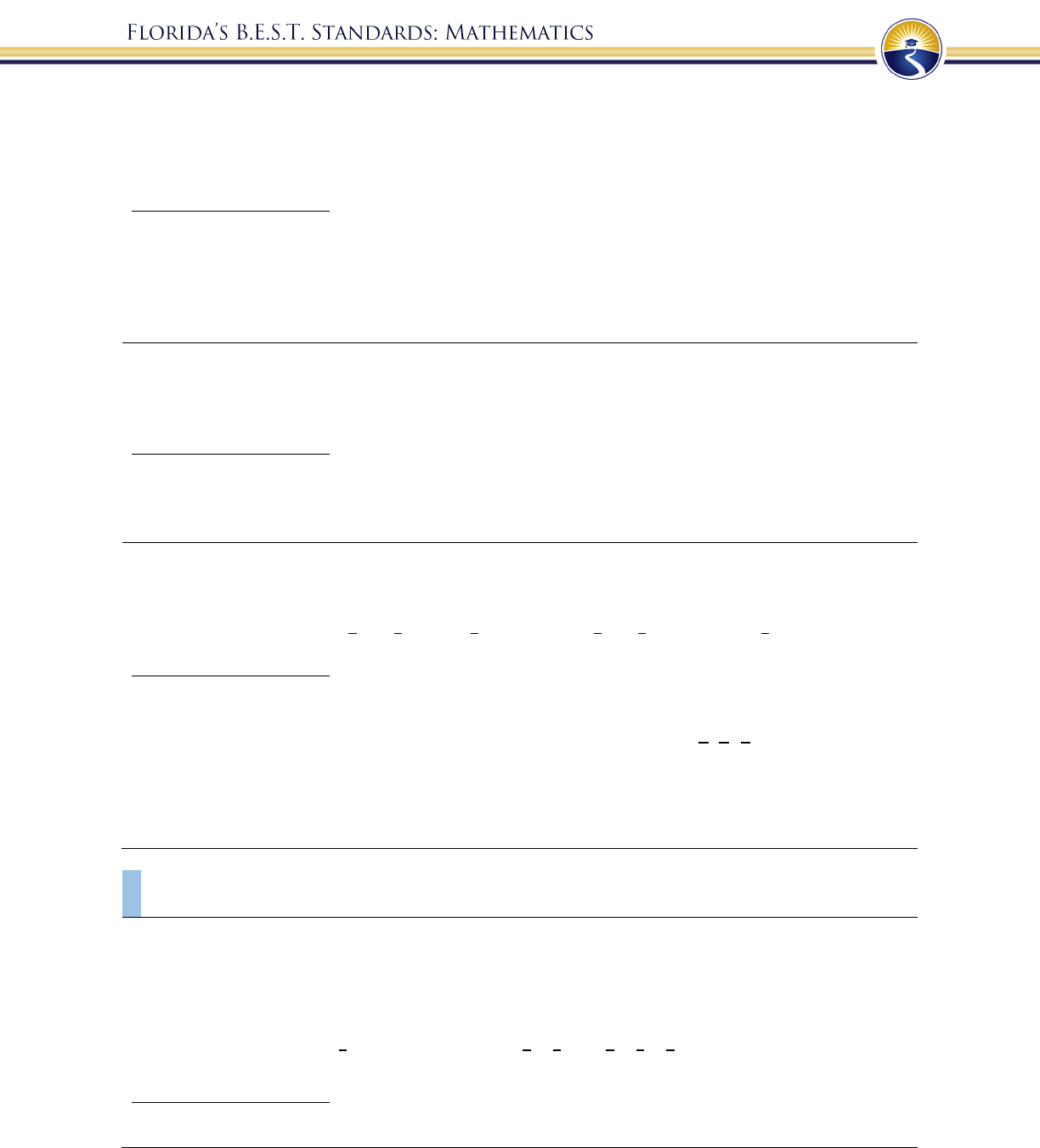
47
MA.4.FR.1.2
Use decimal notation to represent fractions with denominators of 10 or 100,
including mixed numbers and fractions greater than 1, and use fractional
notation with denominators of 10 or 100 to represent decimals.
Benchmark Clarifications:
Clarification 1: Instruction emphasizes conceptual understanding through the use of manipulatives
visual models, number lines or equations.
Clarification 2: Instruction includes the understanding that a decimal and fraction that are equivalent
represent the same point on the number line and that fractions with denominators of 10 or powers of 10
may be called decimal fractions.
MA.4.FR.1.3
Identify and generate equivalent fractions, including fractions greater than one.
Describe how the numerator and denominator are affected when the equivalent
fraction is created.
Benchmark Clarifications:
Clarification 1: Instruction includes the use of manipulatives, visual models, number lines or equations
.
Clarification 2: Instruction includes recognizing how the numerator and denominator are affected when
equivalent fractions are generated.
MA.4.FR.1.4
Plot, order and compare fractions, including mixed numbers and fractions
greater than one, with different numerators and different denominators.
Example: 1
> 1
because
is greater than
and
is greater than
.
Benchmark Clarifications:
Clarification 1: When comparing fractions, instruction includes using an appropriately scaled number
line and using reasoning about their size.
Clarification 2: Instruction includes using benchmark quantities, such as 0,
,
,
and 1, to compare
fractions.
Clarification 3: Denominators are limited to 2, 3, 4, 5, 6, 8, 10, 12, 16 and 100.
Clarification 4: Within this benchmark, the expectation is to use symbols (<, > or =).
MA.4.FR.2 Build a foundation of addition, subtraction and multiplication operations with
fractions.
MA.4.FR.2.1
Decompose a fraction, including mixed numbers and fractions greater than
one, into a sum of fractions with the same denominator in multiple ways.
Demonstrate each decomposition with objects, drawings and equations.
Example:
can be decomposed as
+
or as
+
+
.
Benchmark Clarifications:
Clarification 1: Denominators are limited to 2, 3, 4, 5, 6, 8, 10, 12, 16 and 100.
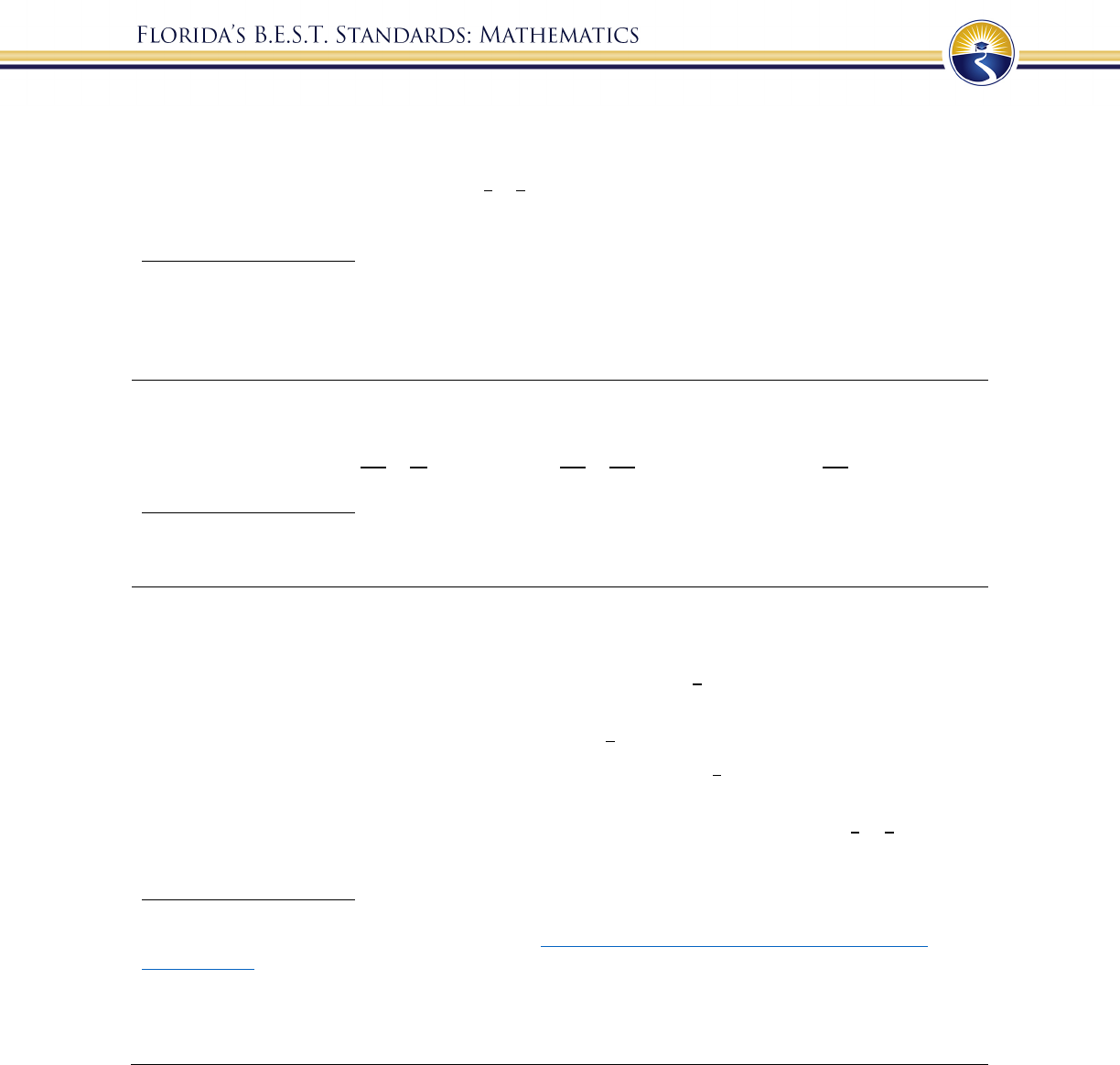
48
MA.4.FR.2.2
Add and subtract fractions with like denominators, including mixed numbers
and fractions greater than one, with procedural reliability.
Example: The difference
can be expressed as 9 minus 4 which is
5 , or .
Benchmark Clarifications:
Clarification 1: Instruction includes the use of word form, manipulatives, drawings, the properties of
operations or number lines.
Clarification 2: Within this benchmark, the expectation is not to simplify or use lowest terms.
Clarification 3: Denominators are limited to 2, 3, 4, 5, 6, 8, 10, 12, 16 and 100.
MA.4.FR.2.3
Explore the addition of a fraction with denominator of 10 to a fraction with
denominator of 100 using equivalent fractions.
Example:
+
is equivalent to
+
which is equivalent to
.
Benchmark Clarifications:
Clarification 1: Instruction includes the use of visual models.
Clarification 2: Within this benchmark, the expectation is not to simplify or use lowest terms.
MA.4.FR.2.4
Extend previous understanding of multiplication to explore the multiplication
of a fraction by a whole number or a whole number by a fraction.
Example: Shanice thinks about finding the product
× 8 by imagining having 8 pizzas
that she wants to split equally with three of her friends. She and each of her
friends will get 2 pizzas since
× 8 = 2.
Example: Lacey thinks about finding the product 8 ×
by imagining having 8 pizza
boxes each with one-quarter slice of a pizza left. If she put them all
together, she would have a total of 2 whole pizzas since 8 ×
=
which is
equivalent to 2.
Benchmark Clarifications:
Clarification 1: Instruction includes the use of visual models or number lines and the connection to the
commutative property of multiplication. Refer to
Properties of Operation, Equality and Inequality
(Appendix D).
Clarification 2: Within this benchmark, the expectation is not to simplify or use lowest terms.
Clarification 3: Fractions multiplied by a whole number are limited to less than 1. All denominators are
limited to 2, 3, 4, 5, 6, 8, 10, 12, 16, 100.

49
Algebraic Reasoning
MA.4.AR.1 Represent and solve problems involving the four operations with whole
numbers and fractions.
MA.4.AR.1.1
Solve real-world problems involving multiplication and division of whole
numbers including problems in which remainders must be interpreted within
the context.
Example: A group of 243 students is taking a field trip and traveling in vans. If each
van can hold 8 students, then the group would need 31 vans for their field
trip because 243 divided by 8 gives 30 with a remainder of 3.
Benchmark Clarifications:
Clarification 1: Problems involving multiplication include multiplicative comparisons. Refer to
Situations Involving Operations with Numbers (Appendix A)
.
Clarification 2: Depending on the context, the solution of a division problem with a remainder may be
the whole number part of the quotient, the whole number part of the quotient with the remainder, the
whole number part of the quotient plus 1, or the remainder.
Clarification 3: Multiplication is limited to products of up to 3 digits by 2 digits. Division is limited to
up to 4 digits divided by 1 digit.
MA.4.AR.1.2
Solve real-world problems involving addition and subtraction of fractions with
like denominators, including mixed numbers and fractions greater than one.
Example: Megan is making pies and uses the equation 1
+ 3
= when baking.
Describe a situation that can represent this equation.
Example: Clay is running a 10K race. So far, he has run 6
kilometers. How many
kilometers does he have remaining?
Benchmark Clarifications:
Clarification 1: Problems include creating real-world situations based on an equation or representing a
real-world problem with a visual model or equation.
Clarification 2: Fractions within problems must reference the same whole.
Clarification 3: Within this benchmark, the expectation is not to simplify or use lowest terms.
Clarification 4: Denominators limited to 2, 3, 4, 5, 6, 8, 10, 12, 16 and 100.
MA.4.AR.1.3
Solve real-world problems involving multiplication of a fraction by a whole
number or a whole number by a fraction.
Example: Ken is filling his garden containers with a cup that holds
pounds of soil. If
he uses 8 cups to fill his garden containers, how many pounds of soil did
Ken use?
Benchmark Clarifications:
Clarification 1: Problems include creating real-world situations based on an equation or representing a
real-world problem with a visual model or equation.
Clarification 2: Fractions within problems must reference the same whole.
Clarification 3: Within this benchmark, the expectation is not to simplify or use lowest terms.
Clarification 4: Fractions limited to fractions less than one with denominators of 2, 3, 4, 5, 6, 8, 10, 12,
16 and 100.
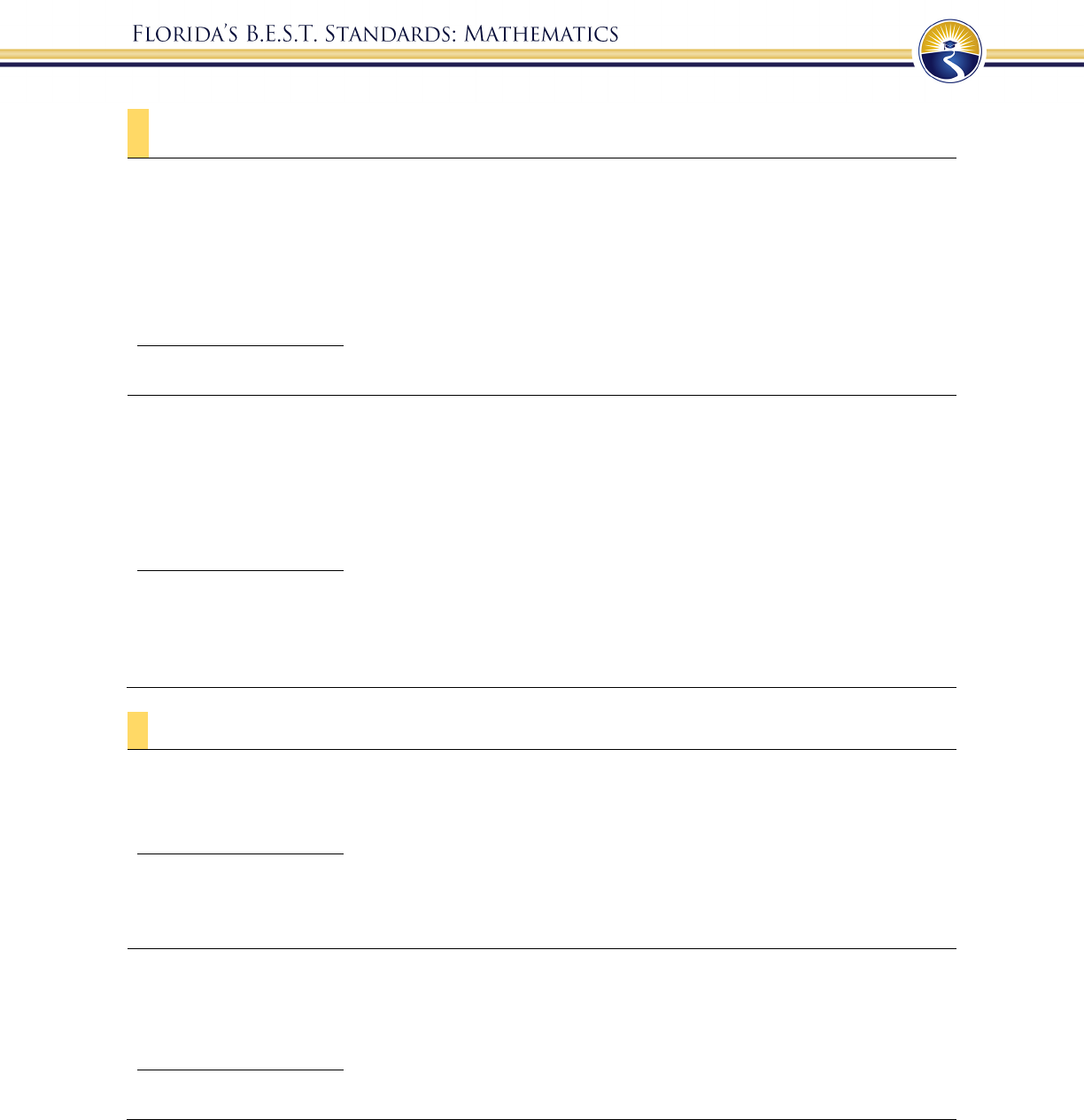
50
MA.4.AR.2 Demonstrate an understanding of equality and operations with whole
numbers.
MA.4.AR.2.1
Determine and explain whether an equation involving any of the four
operations with whole numbers is true or false.
Example: The equation 32 ÷ 8 = 32 8 8 8 8 can be determined to be false
because the expression on the left side of the equal sign is not equivalent to
the expression on the right side of the equal sign.
Benchmark Clarifications:
Clarification 1: Multiplication is limited to whole number factors within 12 and related division facts.
MA.4.AR.2.2
Given a mathematical or real-world context, write an equation involving
multiplication or division to determine the unknown whole number with the
unknown in any position.
Example: The equation 96 = 8 × can be used to determine the cost of each movie
ticket at the movie theatre if a total of $96 was spent on 8 equally priced
tickets. Then each ticket costs $12.
Benchmark Clarifications:
Clarification 1: Instruction extends the development of algebraic thinking skills where the symbolic
representation of the unknown uses a letter.
Clarification 2: Problems include the unknown on either side of the equal sign.
Clarification 3: Multiplication is limited to factors within 12 and related division facts.
MA.4.AR.3 Recognize numerical patterns, including patterns that follow a given rule.
MA.4.AR.3.1
Determine factor pairs for a whole number from 0 to 144. Determine whether
a whole number from 0 to 144 is prime, composite or neither.
Benchmark Clarifications:
Clarification 1: Instruction includes the connection to the relationship between multiplication and
division and patterns with divisibility rules.
Clarification 2: The numbers 0 and 1 are neither prime nor composite.
MA.4.AR.3.2 Generate, describe and extend a numerical pattern that follows a given rule.
Example: Generate a pattern of four numbers that follows the rule of adding 14
starting at 5.
Benchmark Clarifications:
Clarification 1: Instruction includes patterns within a mathematical or real-world context.

51
Measurement
MA.4.M.1 Measure the length of objects and solve problems involving measurement.
MA.4.M.1.1 Select and use appropriate tools to measure attributes of objects.
Benchmark Clarifications:
Clarification 1: Attributes include length, volume, weight, mass and temperature.
Clarification 2: Instruction includes digital measurements and scales that are not linear in appearance.
Clarification 3: When recording measurements, use fractions and decimals where appropriate.
MA.4.M.1.2
Convert within a single system of measurement using the units: yards, feet,
inches; kilometers, meters, centimeters, millimeters; pounds, ounces; kilograms,
grams; gallons, quarts, pints, cups; liter, milliliter; and hours, minutes, seconds.
Example: If a ribbon is 11 yards 2 feet in length, how long is the ribbon in feet?
Example: A gallon contains 16 cups. How many cups are in 3
gallons?
Benchmark Clarifications:
Clarification 1: Instruction includes the understanding of how to convert from smaller to larger units or
from larger to smaller units.
Clarification 2: Within the benchmark, the expectation is not to convert from grams to kilograms,
meters to kilometers or milliliters to liters.
Clarification 3: Problems involving fractions are limited to denominators of 2, 3, 4, 5, 6, 8, 10, 12, 16
and 100.
MA.4.M.2 Solve problems involving time and money.
MA.4.M.2.1
Solve two-step real-world problems involving distances and intervals of time
using any combination of the four operations.
Benchmark Clarifications:
Clarification 1: Problems involving fractions will include addition and subtraction with like
denominators and multiplication of a fraction by a whole number or a whole number by a fraction.
Clarification 2: Problems involving fractions are limited to denominators of 2, 3, 4, 5, 6, 8, 10, 12, 16
and 100.
Clarification 3: Within the benchmark, the expectation is not to use decimals.
MA.4.M.2.2
Solve one- and two-step addition and subtraction real-world problems involving
money using decimal notation.
Example: An item costs $1.84. If you give the cashier $2.00, how much change should
you receive? What coins could be used to give the change?
Example: At the grocery store you spend $14.56. If you do not want any pennies in
change, how much money could you give the cashier?
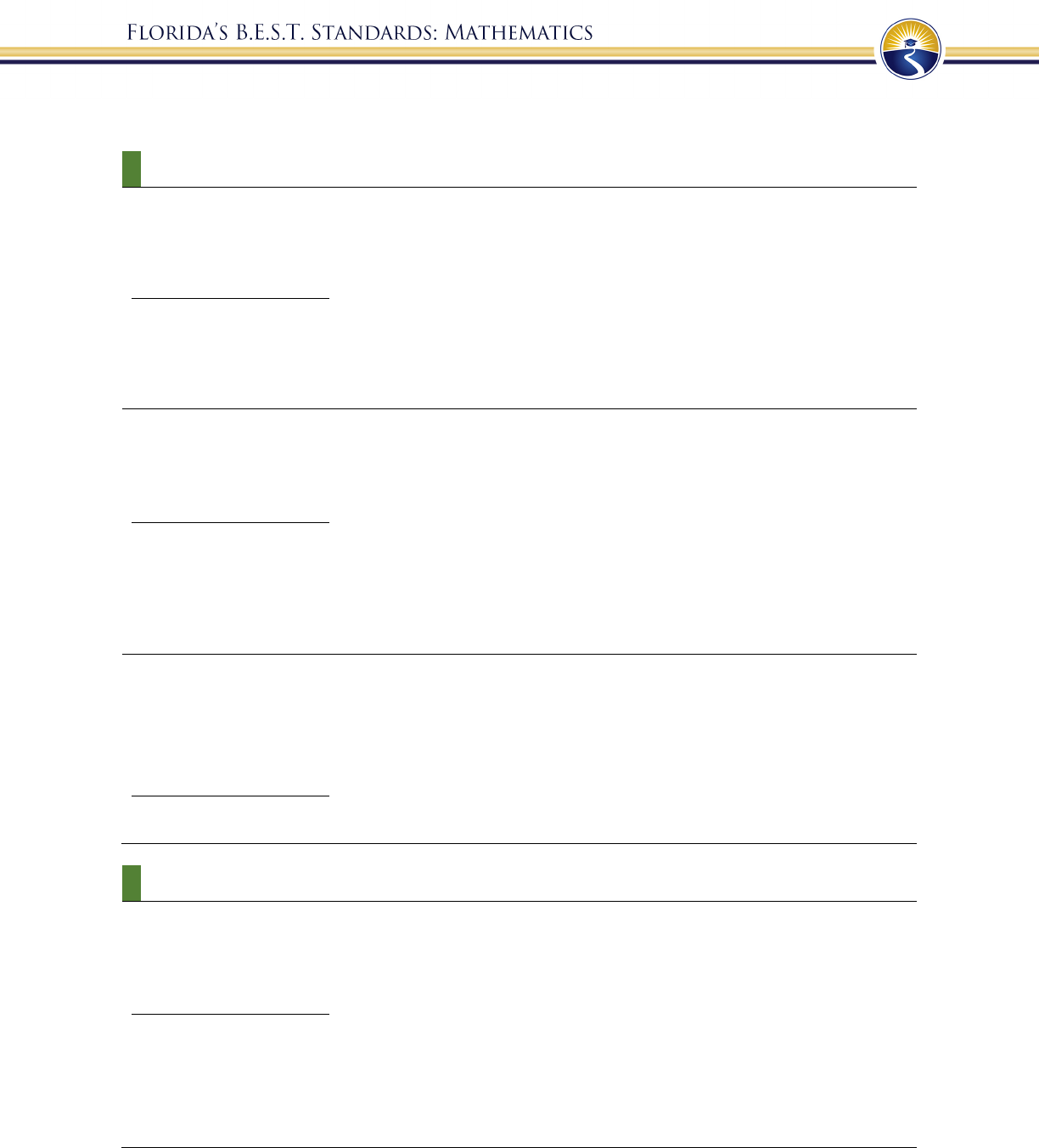
52
Geometric Reasoning
MA.4.GR.1 Draw, classify and measure angles.
MA.4.GR.1.1
Informally explore angles as an attribute of two-dimensional figures. Identify
and classify angles as acute, right, obtuse, straight or reflex.
Benchmark Clarifications:
Clarification 1: Instruction includes classifying angles using benchmark angles of 90° and 180° in two-
dimensional figures.
Clarification 2: When identifying angles, the expectation includes two-dimensional figures and real-
world pictures.
MA.4.GR.1.2
Estimate angle measures. Using a protractor, measure angles in whole-number
degrees and draw angles of specified measure in whole-number degrees.
Demonstrate that angle measure is additive.
Benchmark Clarifications:
Clarification 1: Instruction includes measuring given angles and drawing angles using protractors.
Clarification 2: Instruction includes estimating angle measures using benchmark angles (30°, 45°, 60°,
90° and 180°).
Clarification 3: Instruction focuses on the understanding that angles can be decomposed into non-
overlapping angles whose measures sum to the measure of the original angle.
MA.4.GR.1.3
Solve real-world and mathematical problems involving unknown whole-
number angle measures. Write an equation to represent the unknown.
Example: A 60° angle is decomposed into two angles, one of which is 25°. What is
the measure of the other angle?
Benchmark Clarifications:
Clarification 1: Instruction includes the connection to angle measure as being additive.
MA.4.GR.2 Solve problems involving the perimeter and area of rectangles.
MA.4.GR.2.1
Solve perimeter and area mathematical and real-world problems, including
problems with unknown sides, for rectangles with whole-number side lengths.
Benchmark Clarifications:
Clarification 1: Instruction extends the development of algebraic thinking where the symbolic
representation of the unknown uses a letter.
Clarification 2: Problems involving multiplication are limited to products of up to 3 digits by 2 digits.
Problems involving division are limited to up to 4 digits divided by 1 digit.
Clarification 3: Responses include the appropriate units in word form.
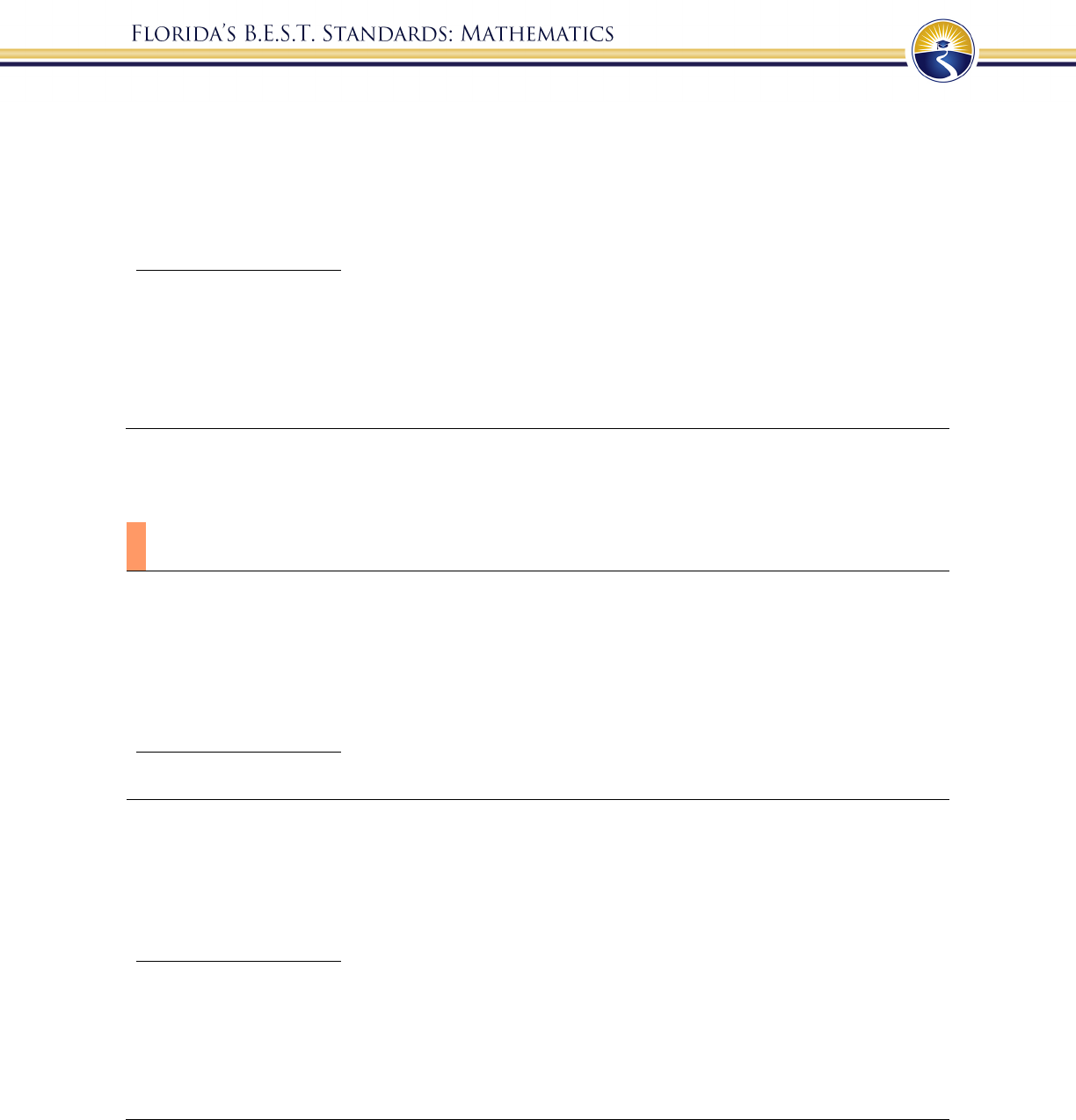
53
MA.4.GR.2.2
Solve problems involving rectangles with the same perimeter and different
areas or with the same area and different perimeters.
Example: Possible dimensions of a rectangle with an area of 24 square feet include 6
feet by 4 feet or 8 feet by 3 feet. This can be found by cutting a rectangle
into unit squares and rearranging them.
Benchmark Clarifications:
Clarification 1: Instruction focuses on the conceptual understanding of the relationship between
perimeter and area.
Clarification 2: Within this benchmark, rectangles are limited to having whole-number side lengths.
Clarification 3: Problems involving multiplication are limited to products of up to 3 digits by 2 digits.
Problems involving division are limited to up to 4 digits divided by 1 digit.
Clarification 4: Responses include the appropriate units in word form.
Data Analysis and Probability
MA.4.DP.1 Collect, represent and interpret data and find the mode, median and range of
a data set.
MA.4.DP.1.1
Collect and represent numerical data, including fractional values, using tables,
stem-and-leaf plots or line plots.
Example: A softball team is measuring their hat size. Each player measures the
distance around their head to the nearest half inch. The data is collected and
represented on a line plot.
Benchmark Clarifications:
Clarification 1: Denominators are limited to 2, 3, 4, 5, 6, 8, 10, 12, 16 and 100.
MA.4.DP.1.2
Determine the mode, median or range to interpret numerical data including
fractional values, represented with tables, stem-and-leaf plots or line plots.
Example: Given the data of the softball team’s hat size represented on a line plot,
determine the most common size and the difference between the largest and
the smallest sizes.
Benchmark Clarifications:
Clarification 1: Instruction includes interpreting data within a real-world context.
Clarification 2: Instruction includes recognizing that data sets can have one mode, no mode or more
than one mode.
Clarification 3: Within this benchmark, data sets are limited to an odd number when calculating the
median.
Clarification 4: Denominators are limited to 2, 3, 4, 5, 6, 8, 10, 12, 16 and 100.
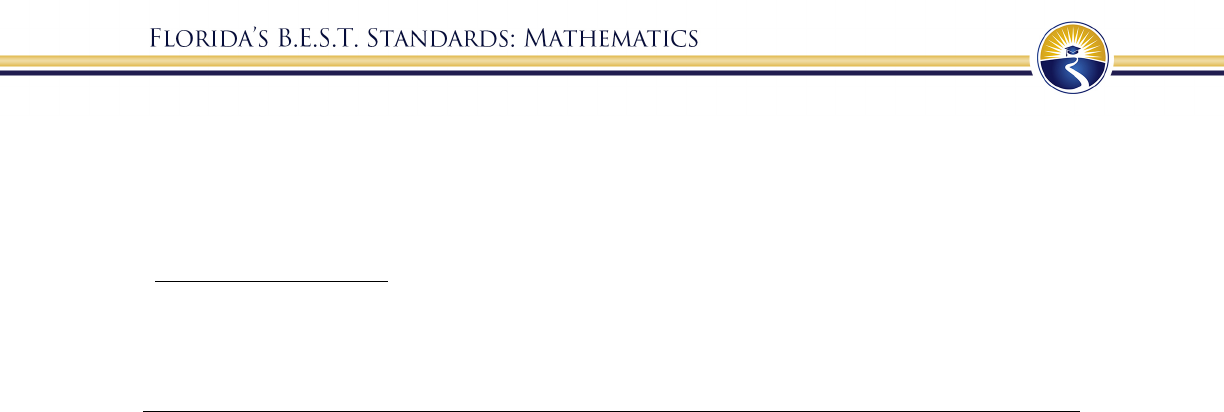
54
MA.4.DP.1.3 Solve real-world problems involving numerical data.
Example: Given the data of the softball team’s hat size represented on a line plot,
determine the fraction of the team that has a head size smaller than 20
inches.
Benchmark Clarifications:
Clarification 1: Instruction includes using any of the four operations to solve problems.
Clarification 2: Data involving fractions with like denominators are limited to 2, 3, 4, 5, 6, 8, 10, 12, 16
and 100. Fractions can be greater than one.
Clarification 3: Data involving decimals are limited to hundredths.
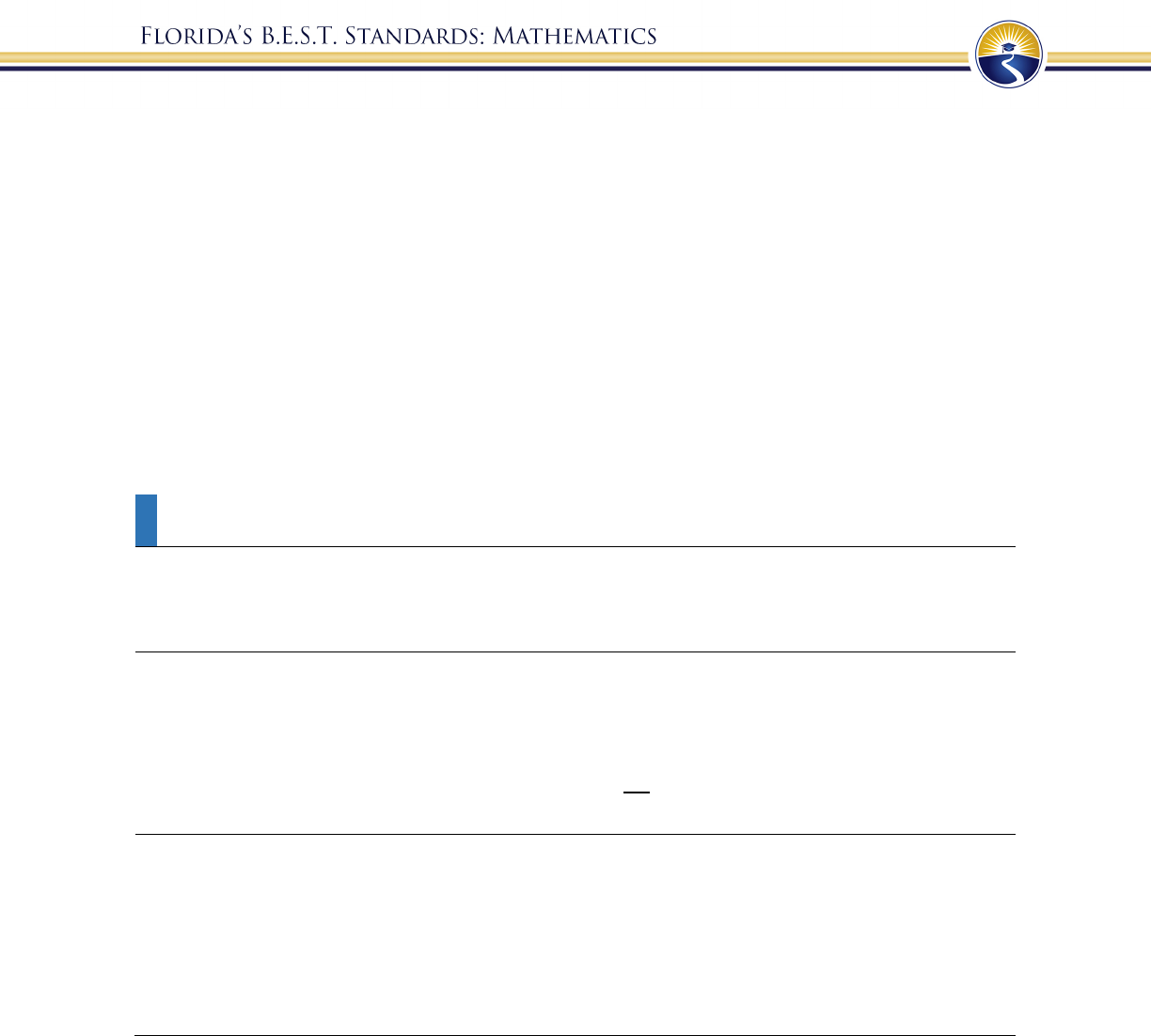
55
Grade 5
In grade 5, instructional time will emphasize five areas:
(1) multiplying and dividing multi-digit whole numbers, including using a standard
algorithm;
(2) adding and subtracting fractions and decimals with procedural fluency, developing an
understanding of multiplication and division of fractions and decimals;
(3) developing an understanding of the coordinate plane and plotting pairs of numbers in
the first quadrant;
(4) extending geometric reasoning to include volume and
(5) extending understanding of data to include the mean.
Number Sense and Operations
MA.5.NSO.1 Understand the place value of multi-digit numbers with decimals to the
thousandths place.
MA.5.NSO.1.1
Express how the value of a digit in a multi-digit number with decimals to the
thousandths changes if the digit moves one or more places to the left or right.
MA.5.NSO.1.2
Read and write multi-digit numbers with decimals to the thousandths using
standard form, word form and expanded form.
Example: The number sixty-seven and three hundredths written in standard form is
67.03 and in expanded form is 60 + 7 + 0.03 or
(6 × 10) + (7 × 1) + 3 ×
.
MA.5.NSO.1.3
Compose and decompose multi-digit numbers with decimals to the
thousandths in multiple ways using the values of the digits in each place.
Demonstrate the compositions or decompositions using objects, drawings
and expressions or equations.
Example: The number 20.107 can be expressed as 2 + 1 +
7 or as 20 + 107 .
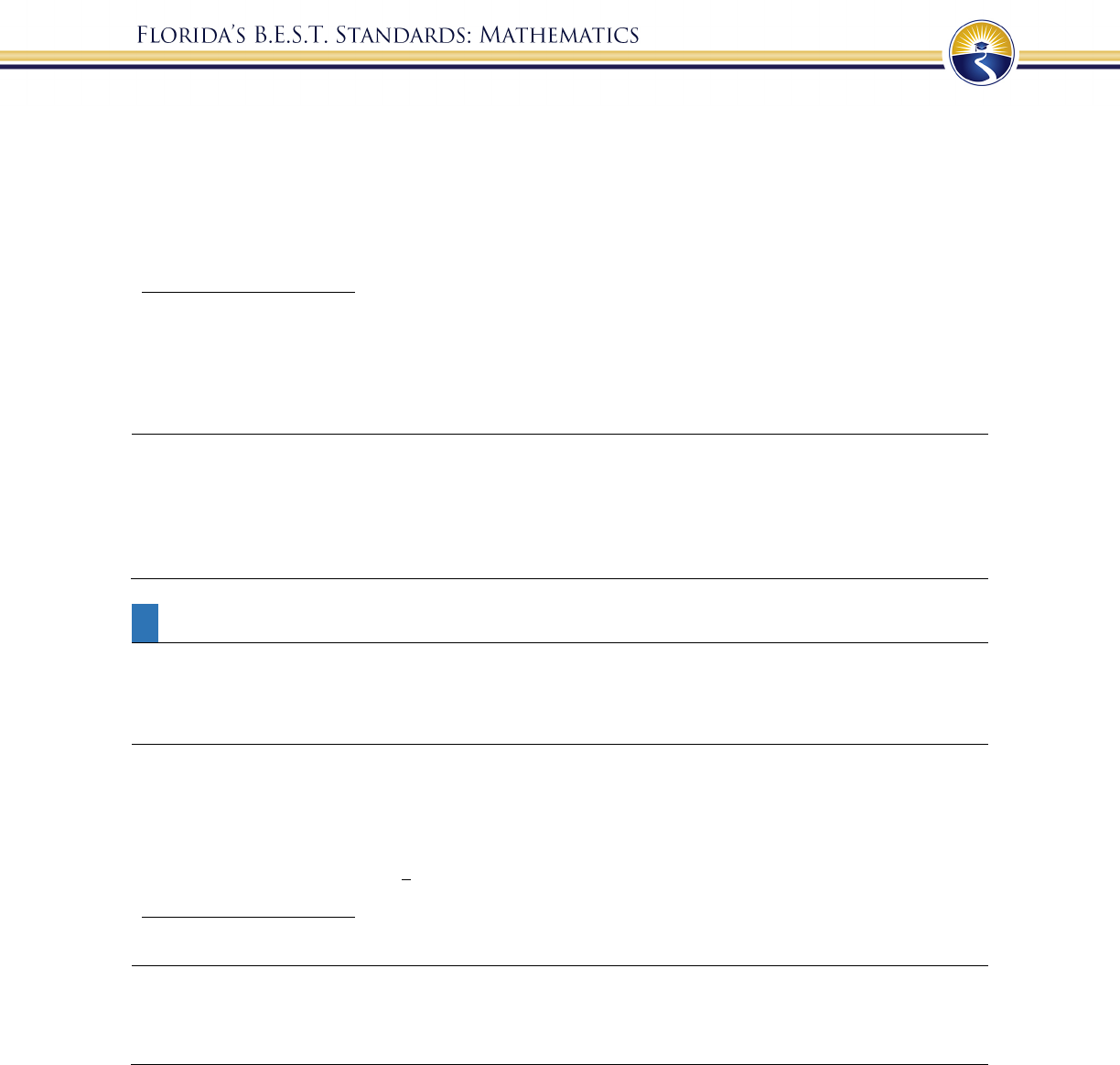
56
MA.5.NSO.1.4
Plot, order and compare multi-digit numbers with decimals up to the
thousandths.
Example: The numbers 4.891; 4.918 and 4.198 can be arranged in ascending order
as 4.198; 4.891 and 4.918.
Example: 0.15 < 0.2 because is less than
, which is the same as .
Benchmark Clarifications:
Clarification 1: When comparing numbers, instruction includes using an appropriately scaled number
line and using place values of digits.
Clarification 2: Scaled number lines must be provided and can be a representation of any range of
numbers.
Clarification 3: Within this benchmark, the expectation is to use symbols (<, > or =).
MA.5.NSO.1.5
Round multi-digit numbers with decimals to the thousandths to the nearest
hundredth, tenth or whole number.
Example: The number 18.507 rounded to the nearest tenth is 18.5 and to the nearest
hundredth is 18.51.
MA.5.NSO.2 Add, subtract, multiply and divide multi-digit numbers.
MA.5.NSO.2.1
Multiply multi-digit whole numbers including using a standard algorithm
with procedural fluency.
MA.5.NSO.2.2
Divide multi-digit whole numbers, up to five digits by two digits, including
using a standard algorithm with procedural fluency. Represent remainders as
fractions.
Example: The quotient 27 ÷ 7 gives 3 with remainder 6 which can be expressed as
3
.
Benchmark Clarifications:
Clarification 1: Within this benchmark, the expectation is not to use simplest form for fractions.
MA.5.NSO.2.3
Add and subtract multi-digit numbers with decimals to the thousandths,
including using a standard algorithm with procedural fluency.
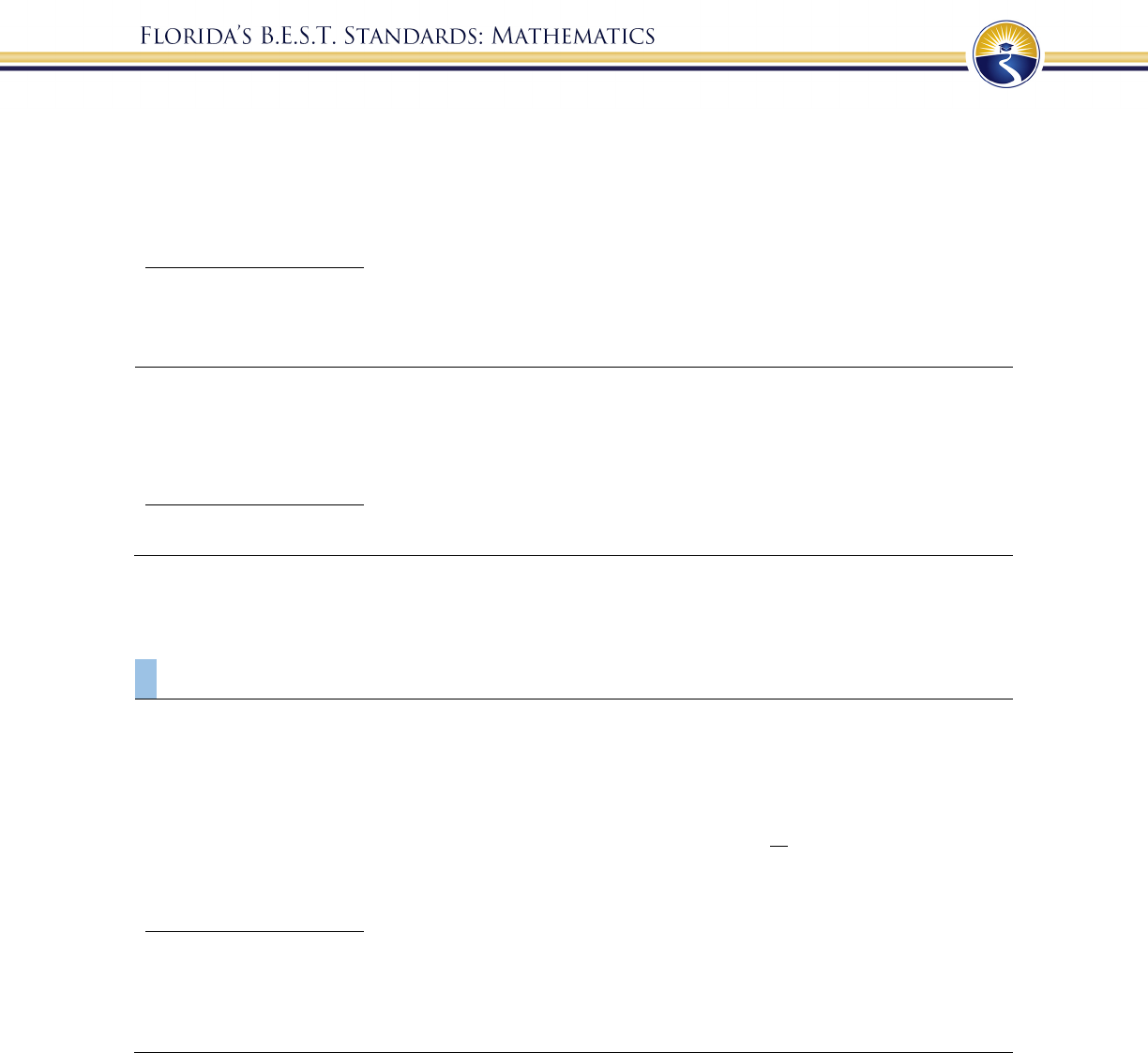
57
MA.5.NSO.2.4
Explore the multiplication and division of multi-digit numbers with decimals
to the hundredths using estimation, rounding and place value.
Example: The quotient of 23 and 0.42 can be estimated as a little bigger than 46
because 0.42 is less than one-half and 23 times 2 is 46.
Benchmark Clarifications:
Clarification 1: Estimating quotients builds the foundation for division using a standard algorithm.
Clarification 2: Instruction includes the use of models based on place value and the properties of
operations.
MA.5.NSO.2.5
Multiply and divide a multi-digit number with decimals to the tenths by one-
tenth and one-hundredth with procedural reliability.
Example: The number 12.3 divided by 0.01 can be thought of as ?× 0.01 = 12.3 to
determine the quotient is 1,230.
Benchmark Clarifications:
Clarification 1: Instruction focuses on the place value of the digit when multiplying or dividing.
Fractions
MA.5.FR.1 Interpret a fraction as an answer to a division problem.
MA.5.FR.1.1
Given a mathematical or real-world problem, represent the division of two
whole numbers as a fraction.
Example: At Shawn’s birthday party, a two-gallon container of lemonade is shared
equally among 20 friends. Each friend will have
of a gallon of lemonade
which is equivalent to one-tenth of a gallon which is a little more than 12
ounces.
Benchmark Clarifications:
Clarification 1: Instruction includes making a connection between fractions and division by
understanding that fractions can also represent division of a numerator by a denominator.
Clarification 2: Within this benchmark, the expectation is not to simplify or use lowest terms.
Clarification 3: Fractions can include fractions greater than one.
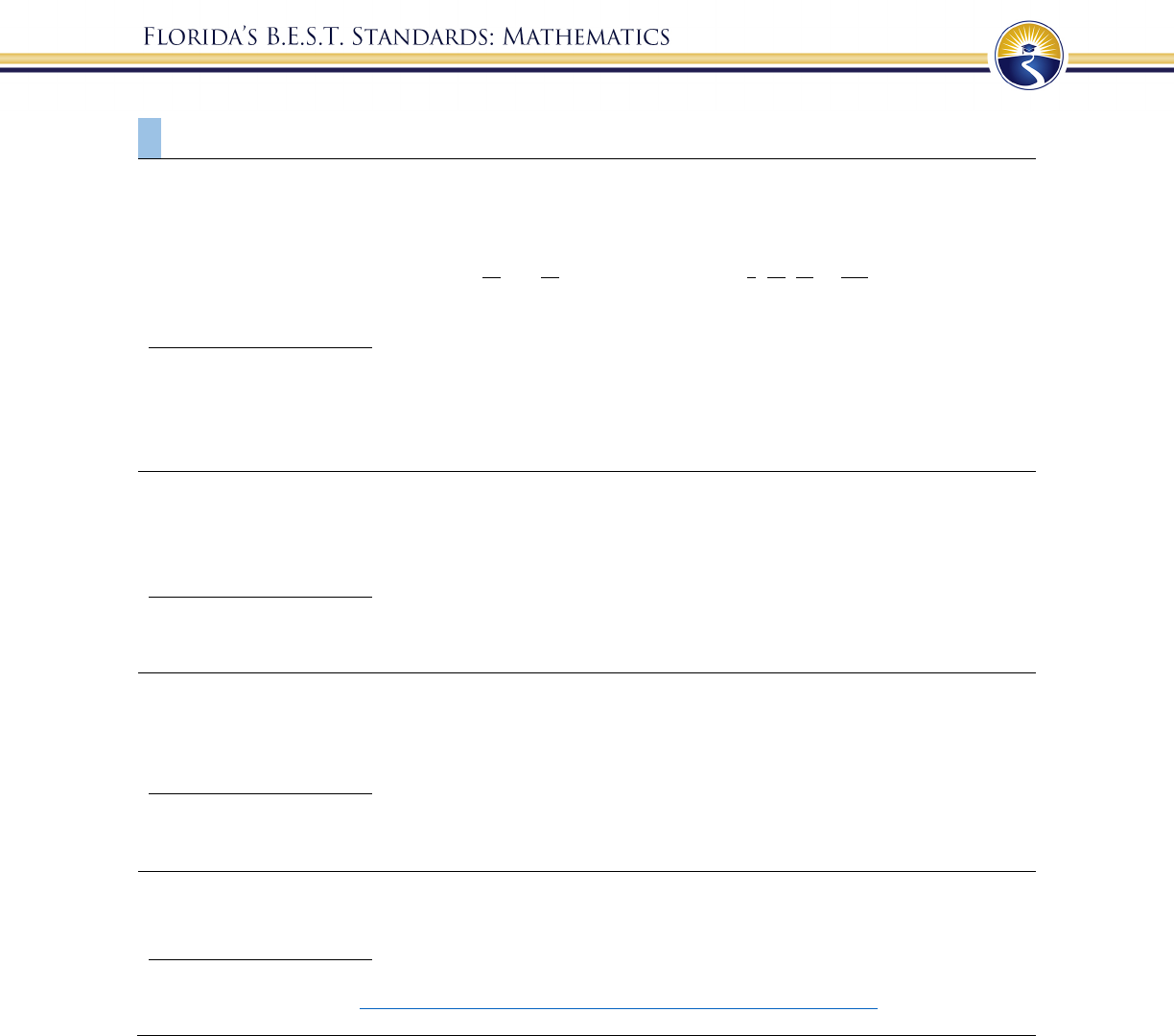
58
MA.5.FR.2 Perform operations with fractions.
MA.5.FR.2.1
Add and subtract fractions with unlike denominators, including mixed
numbers and fractions greater than 1, with procedural reliability.
Example: The sum of
and
can be determined as
,
,
or
by using different
common denominators or equivalent fractions.
Benchmark Clarifications:
Clarification 1: Instruction includes the use of estimation, manipulatives, drawings or the properties of
operations.
Clarification 2: Instruction builds on the understanding from previous grades of factors up to 12 and
their multiples.
MA.5.FR.2.2
Extend previous understanding of multiplication to multiply a fraction by a
fraction, including mixed numbers and fractions greater than 1, with
procedural reliability.
Benchmark Clarifications:
Clarification 1: Instruction includes the use of manipulatives, drawings or the properties of operations.
Clarification 2: Denominators limited to whole numbers up to 20.
MA.5.FR.2.3
When multiplying a given number by a fraction less than 1 or a fraction greater
than 1, predict and explain the relative size of the product to the given number
without calculating.
Benchmark Clarifications:
Clarification 1: Instruction focuses on the connection to decimals, estimation and assessing the
reasonableness of an answer.
MA.5.FR.2.4
Extend previous understanding of division to explore the division of a unit
fraction by a whole number and a whole number by a unit fraction.
Benchmark Clarifications:
Clarification 1: Instruction includes the use of manipulatives, drawings or the properties of operations.
Clarification 2: Refer to Situations Involving Operations with Numbers (Appendix A)
.
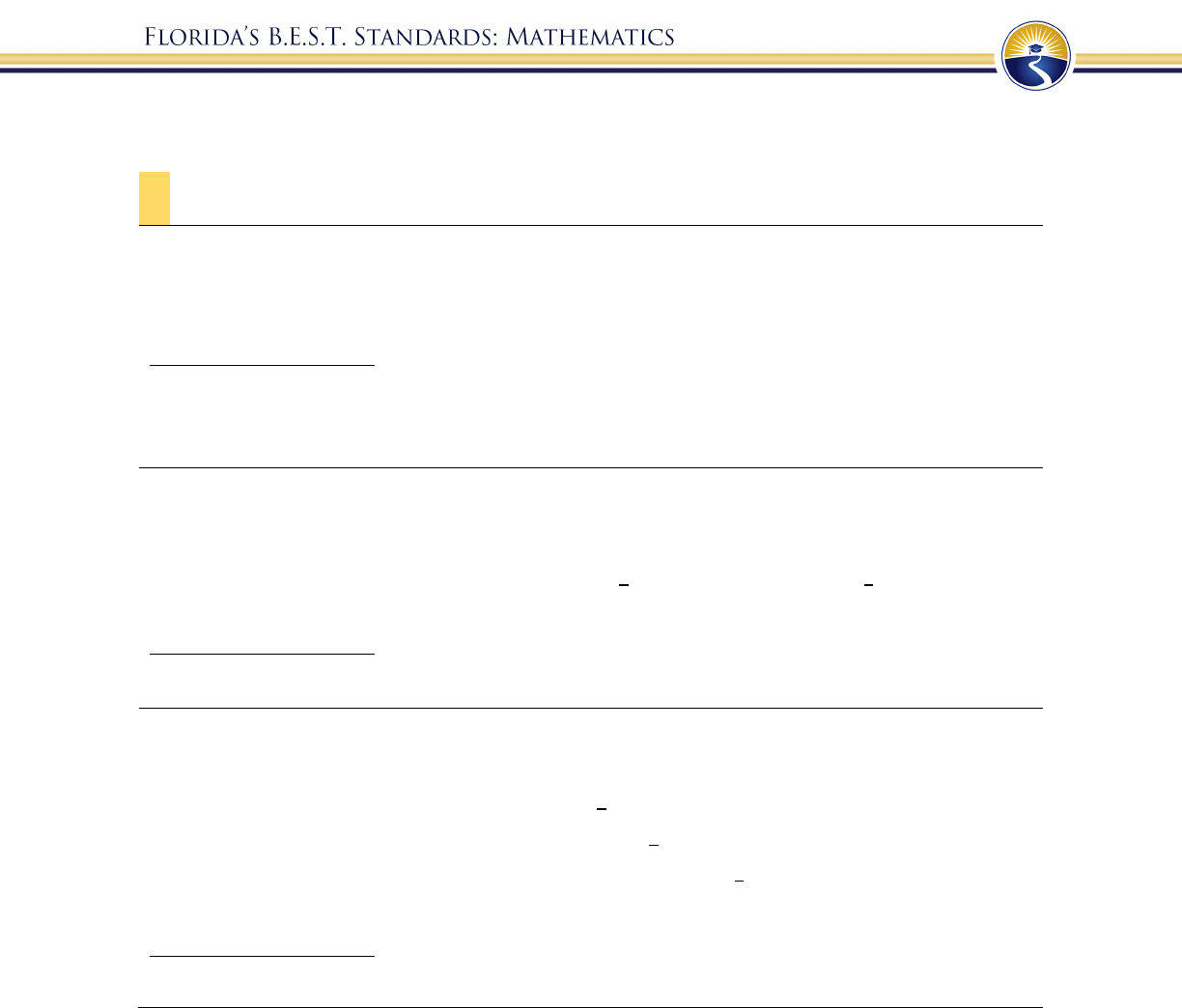
59
Algebraic Reasoning
MA.5.AR.1 Solve problems involving the four operations with whole numbers and
fractions.
MA.5.AR.1.1
Solve multi-step real-world problems involving any combination of the four
operations with whole numbers, including problems in which remainders must
be interpreted within the context.
Benchmark Clarifications:
Clarification 1: Depending on the context, the solution of a division problem with a remainder may be
the whole number part of the quotient, the whole number part of the quotient with the remainder, the
whole number part of the quotient plus 1, or the remainder.
MA.5.AR.1.2
Solve real-world problems involving the addition, subtraction or multiplication
of fractions, including mixed numbers and fractions greater than 1.
Example: Shanice had a sleepover and her mom is making French toast in the
morning. If her mom had 2
loaves of bread and used 1
loaves for the
French toast, how much bread does she have left?
Benchmark Clarifications:
Clarification 1: Instruction includes the use of visual models and equations to represent the problem.
MA.5.AR.1.3
Solve real-world problems involving division of a unit fraction by a whole
number and a whole number by a unit fraction.
Example: A property has a total of
acre and needs to be divided equally among 3
sisters. Each sister will receive
of an acre.
Example: Kiki has 10 candy bars and plans to give
of a candy bar to her classmates
at school. How many classmates will receive a piece of a candy bar?
Benchmark Clarifications:
Clarification 1: Instruction includes the use of visual models and equations to represent the problem.
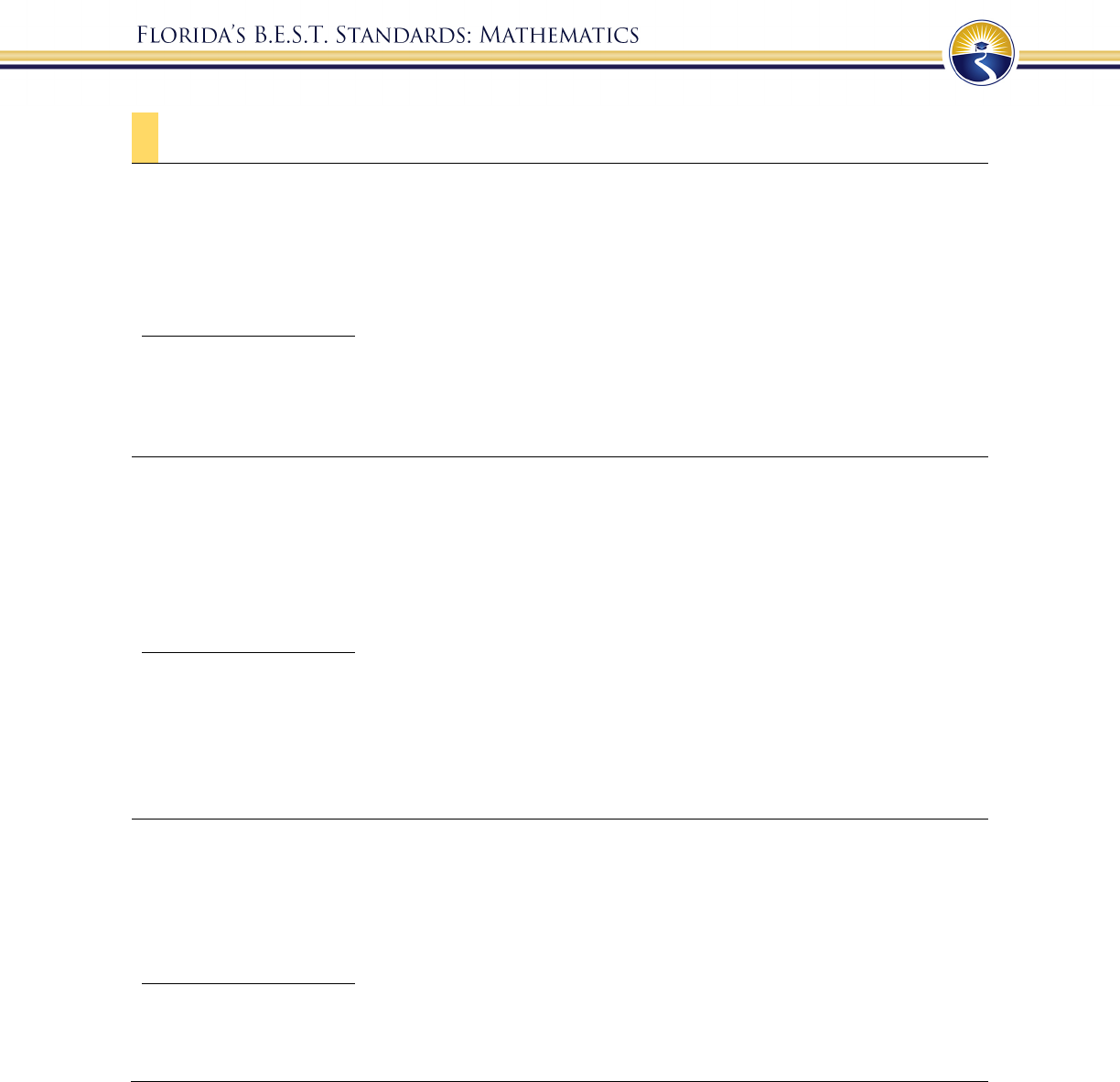
60
MA.5.AR.2 Demonstrate an understanding of equality, the order of operations and
equivalent numerical expressions.
MA.5.AR.2.1
Translate written real-world and mathematical descriptions into numerical
expressions and numerical expressions into written mathematical descriptions.
Example: The expression 4.5 + (3 × 2) in word form is plus
the quantity 3 times 2.
Benchmark Clarifications:
Clarification 1: Expressions are limited to any combination of the arithmetic operations, including
parentheses, with whole numbers, decimals and fractions.
Clarification 2: Within this benchmark, the expectation is not to include exponents or nested grouping
symbols.
MA.5.AR.2.2 Evaluate multi-step numerical expressions using order of operations.
Example: Patti says the expression 12 ÷ 2 × 3 is equivalent to 18 because she works
each operation from left to right. Gladys says the expression 12 ÷ 2 × 3 is
equivalent to 2 because first multiplies 2 × 3 then divides 6 into 12. David
says that Patti is correctly using order of operations and suggests that if
parentheses were added, it would give more clarity.
Benchmark Clarifications:
Clarification 1: Multi-step expressions are limited to any combination of arithmetic operations,
including parentheses, with whole numbers, decimals and fractions.
Clarification 2: Within this benchmark, the expectation is not to include exponents or nested grouping
symbols.
Clarification 3: Decimals are limited to hundredths. Expressions cannot include division of a fraction
by a fraction.
MA.5.AR.2.3
Determine and explain whether an equation involving any of the four
operations is true or false.
Example: The equation 2.5 +
(
6 × 2
)
= 16 1.5 can be determined to be true
because the expression on both sides of the equal sign are equivalent to
14.5.
Benchmark Clarifications:
Clarification 1: Problem types include equations that include parenthesis but not nested parentheses.
Clarification 2: Instruction focuses on the connection between properties of equality and order of
operations.
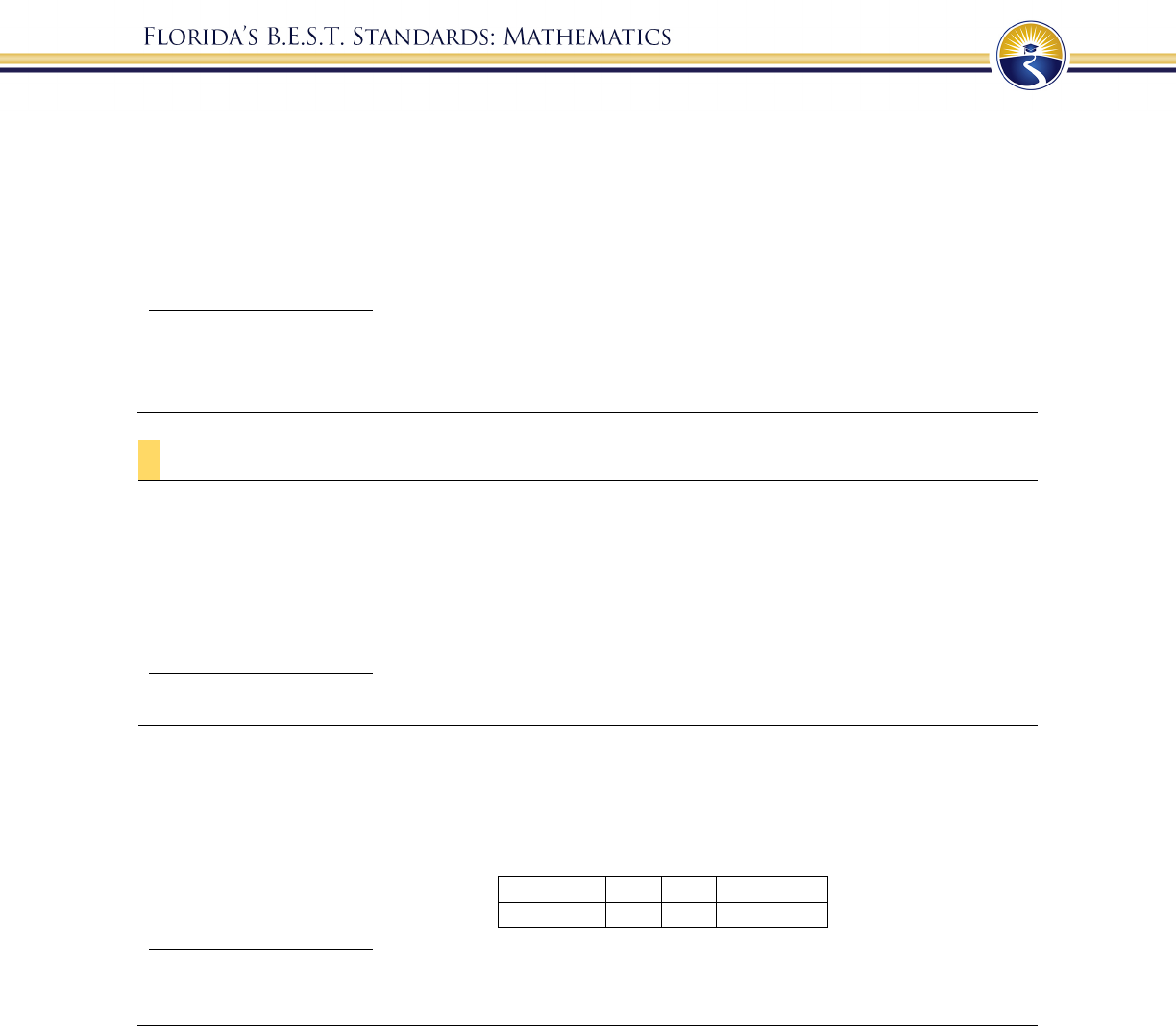
61
MA.5.AR.2.4
Given a mathematical or real-world context, write an equation involving any
of the four operations to determine the unknown whole number with the
unknown in any position.
Example: The equation 250
(
5 ×
)
= 15 can be used to represent that 5 sheets of
paper are given to students from a pack of paper containing 250 sheets
with 15 sheets left over.
Benchmark Clarifications:
Clarification 1: Instruction extends the development of algebraic thinking where the unknown letter is
recognized as a variable.
Clarification 2: Problems include the unknown and different operations on either side of the equal sign.
MA.5.AR.3 Analyze patterns and relationships between inputs and outputs.
MA.5.AR.3.1
Given a numerical pattern, identify and write a rule that can describe the
pattern as an expression.
Example: The given pattern 6, 8, 10, 12 … can be describe using the expression 4 +
2, where = 1, 2, 3, 4 … ; the expression 6 + 2, where = 0, 1, 2, 3 … or
the expression 2, where = 3, 4, 5, 6 ….
Benchmark Clarifications:
Clarification 1: Rules are limited to one or two operations using whole numbers.
MA.5.AR.3.2
Given a rule for a numerical pattern, use a two-column table to record the
inputs and outputs.
Example: The expression 6 + 2, where represents any whole number, can be
represented in a two-column table as shown below.
Input ()
0
1
2
3
Output
6
8
10
12
Benchmark Clarifications:
Clarification 1: Instruction builds a foundation for proportional and linear relationships in later grades.
Clarification 2: Rules are limited to one or two operations using whole numbers.
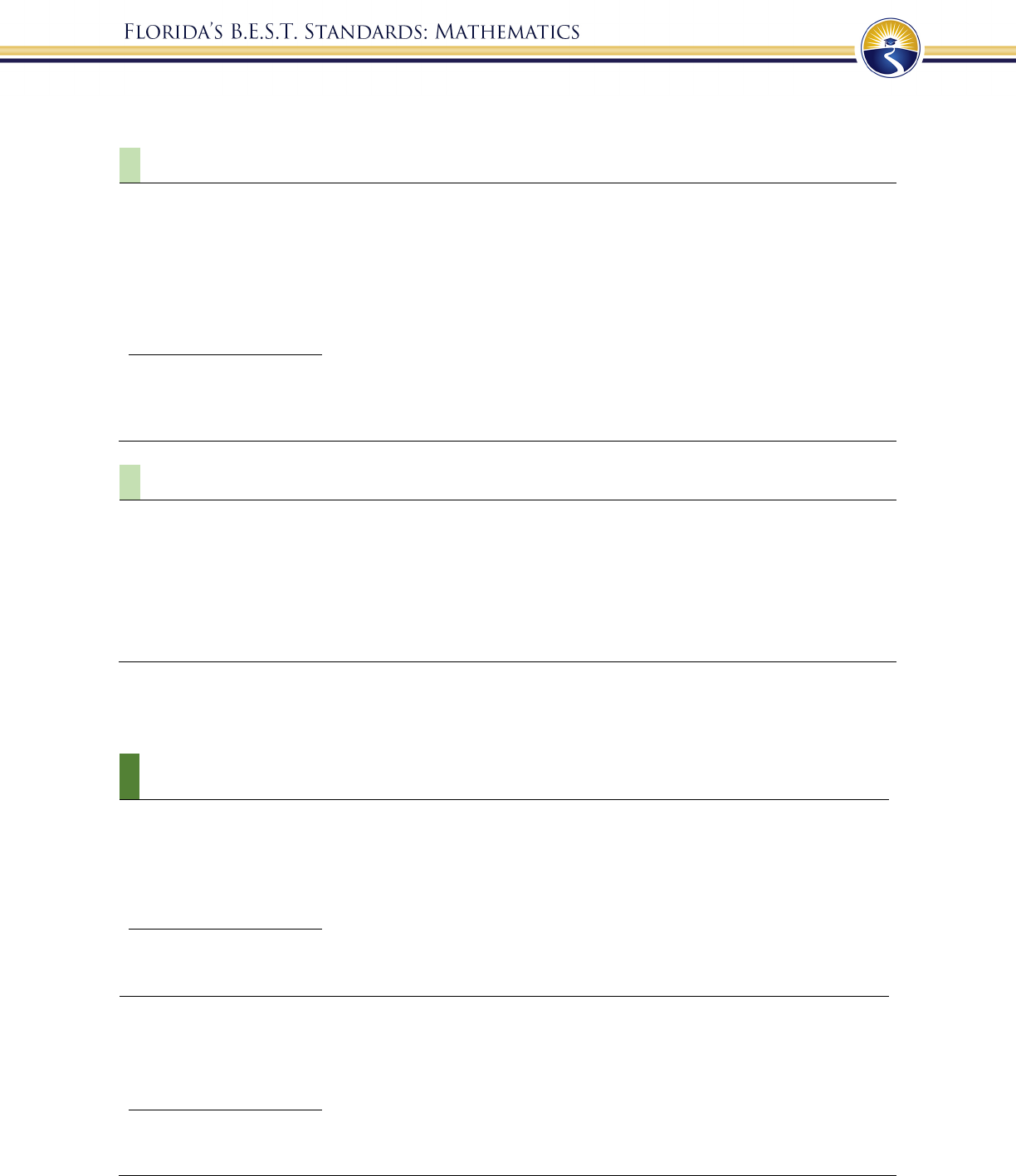
62
Measurement
MA.5.M.1 Convert measurement units to solve multi-step problems.
MA.5.M.1.1
Solve multi-step real-world problems that involve converting measurement
units to equivalent measurements within a single system of measurement.
Example: There are 60 minutes in 1 hour, 24 hours in 1 day and 7 days in 1 week. So,
there are 60 × 24 × 7 minutes in one week which is equivalent to 10,080
minutes.
Benchmark Clarifications:
Clarification 1: Within the benchmark, the expectation is not to memorize the conversions.
Clarification 2: Conversions include length, time, volume and capacity represented as whole numbers,
fractions and decimals.
MA.5.M.2 Solve problems involving money.
MA.5.M.2.1 Solve multi-step real-world problems involving money using decimal notation.
Example: Don is at the store and wants to buy soda. Which option would be cheaper:
buying one 24-ounce can of soda for $1.39 or buying two 12-ounce cans of
soda for 69¢ each?
Geometric Reasoning
MA.5.GR.1 Classify two-dimensional figures and three-dimensional figures based on
defining attributes.
MA.5.GR.1.1
Classify triangles or quadrilaterals into different categories based on shared
defining attributes. Explain why a triangle or quadrilateral would or would
not belong to a category.
Benchmark Clarifications:
Clarification 1: Triangles include scalene, isosceles, equilateral, acute, obtuse and right; quadrilaterals
include parallelograms, rhombi, rectangles, squares and trapezoids.
MA.5.GR.1.2
Identify and classify three-dimensional figures into categories based on their
defining attributes. Figures are limited to right pyramids, right prisms, right
circular cylinders, right circular cones and spheres.
Benchmark Clarifications:
Clarification 1: Defining attributes include the number and shape of faces, number and shape of bases,
whether or not there is an apex, curved or straight edges and curved or flat faces.

63
MA.5.GR.2 Find the perimeter and area of rectangles with fractional or decimal side
lengths.
MA.5.GR.2.1
Find the perimeter and area of a rectangle with fractional or decimal side
lengths using visual models and formulas.
Benchmark Clarifications:
Clarification 1: Instruction includes finding the area of a rectangle with fractional side lengths by tiling
it with squares having unit fraction side lengths and showing that the area is the same as would be
found by multiplying the side lengths.
Clarification 2: Responses include the appropriate units in word form.
MA.5.GR.3 Solve problems involving the volume of right rectangular prisms.
MA.5.GR.3.1
Explore volume as an attribute of three-dimensional figures by packing them
with unit cubes without gaps. Find the volume of a right rectangular prism
with whole-number side lengths by counting unit cubes.
Benchmark Clarifications:
Clarification 1: Instruction emphasizes the conceptual understanding that volume is an attribute that
can be measured for a three-dimensional figure. The measurement unit for volume is the volume of a
unit cube, which is a cube with edge length of 1 unit.
MA.5.GR.3.2
Find the volume of a right rectangular prism with whole-number side lengths
using a visual model and a formula.
Benchmark Clarifications:
Clarification 1: Instruction includes finding the volume of right rectangular prisms by packing the
figure with unit cubes, using a visual model or applying a multiplication formula.
Clarification 2: Right rectangular prisms cannot exceed two-digit edge lengths and responses include
the appropriate units in word form.
MA.5.GR.3.3
Solve real-world problems involving the volume of right rectangular prisms,
including problems with an unknown edge length, with whole-number edge
lengths using a visual model or a formula. Write an equation with a variable
for the unknown to represent the problem.
Example: A hydroponic box, which is a rectangular prism, is used to grow a garden in
wastewater rather than soil. It has a base of 2 feet by 3 feet. If the volume of
the box is 12 cubic feet, what would be the depth of the box?
Benchmark Clarifications:
Clarification 1: Instruction progresses from right rectangular prisms to composite figures composed of
right rectangular prisms.
Clarification 2: When finding the volume of composite figures composed of right rectangular prisms,
recognize volume as additive by adding the volume of non-overlapping parts.
Clarification 3: Responses include the appropriate units in word form.

64
MA.5.GR.4 Plot points and represent problems on the coordinate plane.
MA.5.GR.4.1
Identify the origin and axes in the coordinate system. Plot and label ordered
pairs in the first quadrant of the coordinate plane.
Benchmark Clarifications:
Clarification 1: Instruction includes the connection between two-column tables and coordinates on a
coordinate plane.
Clarification 2: Instruction focuses on the connection of the number line to the - and -axis.
Clarification 3: Coordinate planes include axes scaled by whole numbers. Ordered pairs contain only
whole numbers.
MA.5.GR.4.2
Represent mathematical and real-world problems by plotting points in the first
quadrant of the coordinate plane and interpret coordinate values of points in
the context of the situation.
Example: For Kevin’s science fair project, he is growing plants with different soils.
He plotted the point (5, 7) for one of his plants to indicate that the plant
grew 7 inches by the end of week 5.
Benchmark Clarifications:
Clarification 1: Coordinate planes include axes scaled by whole numbers. Ordered pairs contain only
whole numbers.
Data Analysis and Probability
MA.5.DP.1 Collect, represent and interpret data and find the mean, mode, median or
range of a data set.
MA.5.DP.1.1
Collect and represent numerical data, including fractional and decimal values,
using tables, line graphs or line plots.
Example: Gloria is keeping track of her money every week. She starts with $10.00,
after one week she has $7.50, after two weeks she has $12.00 and after
three weeks she has $6.25. Represent the amount of money she has using a
line graph.
Benchmark Clarifications:
Clarification 1: Within this benchmark, the expectation is for an estimation of fractional and decimal
heights on line graphs.
Clarification 2: Decimal values are limited to hundredths. Denominators are limited to 1, 2, 3 and 4.
Fractions can be greater than one.
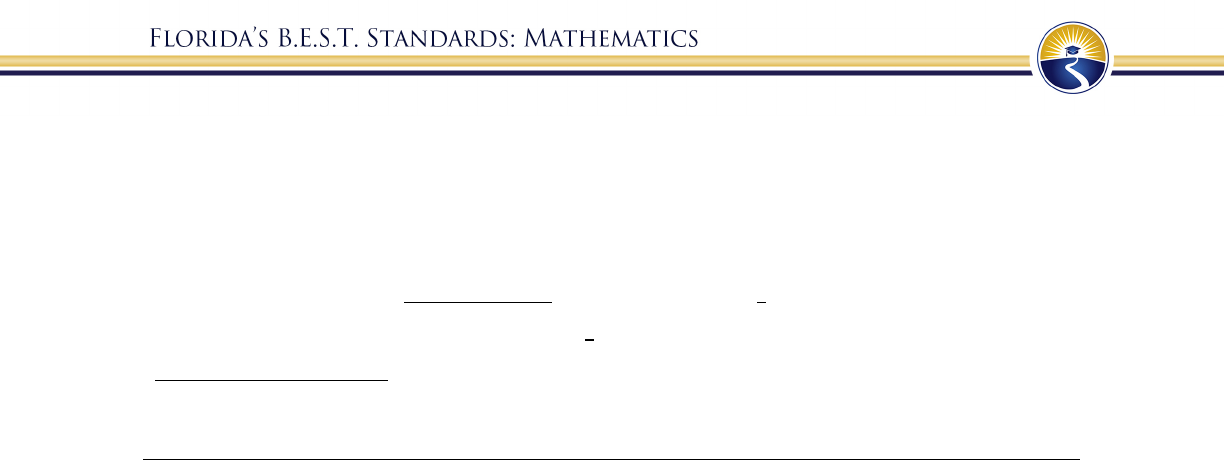
65
MA.5.DP.1.2
Interpret numerical data, with whole-number values, represented with tables or
line plots by determining the mean, mode, median or range.
Example: Rain was collected and measured daily to the nearest inch for the past week.
The recorded amounts are 1, 0, 3, 1, 0, 0 and 1. The range is 3 inches, the
modes are 0 and 1 inches and the mean value can be determined as
()
which is equivalent to
of an inch. This mean would be
the same if it rained
of an inch each day.
Benchmark Clarifications:
Clarification 1: Instruction includes interpreting the mean in real-world problems as a leveling out, a
balance point or an equal share.
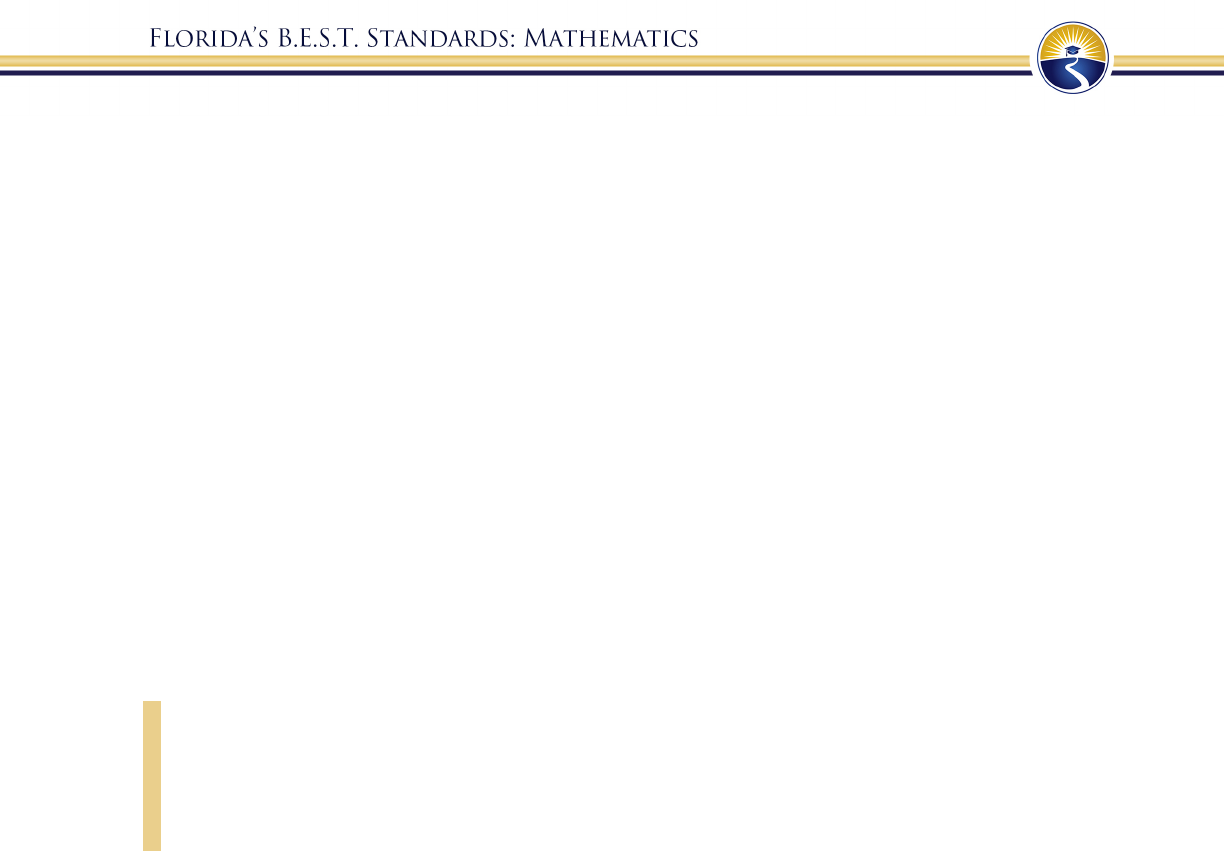
66
Mathematics 6-8
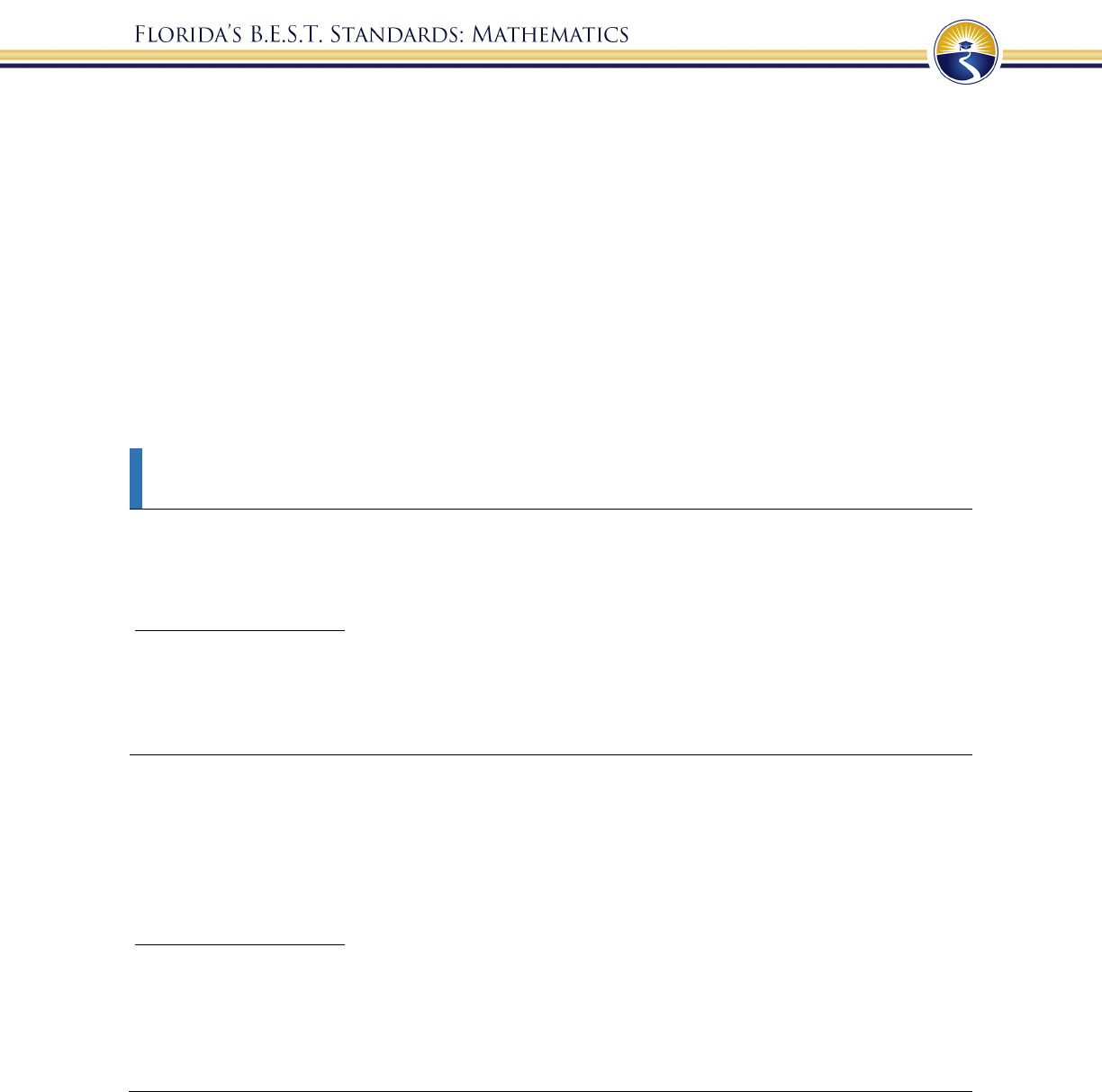
67
Grade 6
In grade 6, instructional time will emphasize five areas:
(1) performing all four operations with integers, positive decimals and positive fractions
with procedural fluency;
(2) exploring and applying concepts of ratios, rates and percent to solve problems;
(3) creating, interpreting and using expressions and equations;
(4) extending geometric reasoning to plotting points on the coordinate plane, area and
volume of geometric figures and
(5) extending understanding of statistical thinking.
Number Sense and Operations
MA.6.NSO.1 Extend knowledge of numbers to negative numbers and develop an
understanding of absolute value.
MA.6.NSO.1.1
Extend previous understanding of numbers to define rational numbers. Plot,
order and compare rational numbers.
Benchmark Clarifications:
Clarification 1: Within this benchmark, the expectation is to plot, order and compare positive and
negative rational numbers when given in the same form and to plot, order and compare positive rational
numbers when given in different forms (fraction, decimal, percentage).
Clarification 2: Within this benchmark, the expectation is to use symbols (<, > or =).
MA.6.NSO.1.2
Given a mathematical or real-world context, represent quantities that have
opposite direction using rational numbers. Compare them on a number line and
explain the meaning of zero within its context.
Example: Jasmine is on a cruise and is going on a scuba diving excursion. Her
elevations of 10 feet above sea level and 8 feet below sea level can be
compared on a number line, where 0 represents sea level.
Benchmark Clarifications:
Clarification 1: Instruction includes vertical and horizontal number lines, context referring to distances,
temperatures and finances and using informal verbal comparisons, such as, lower, warmer or more in
debt.
Clarification 2: Within this benchmark, the expectation is to compare positive and negative rational
numbers when given in the same form.
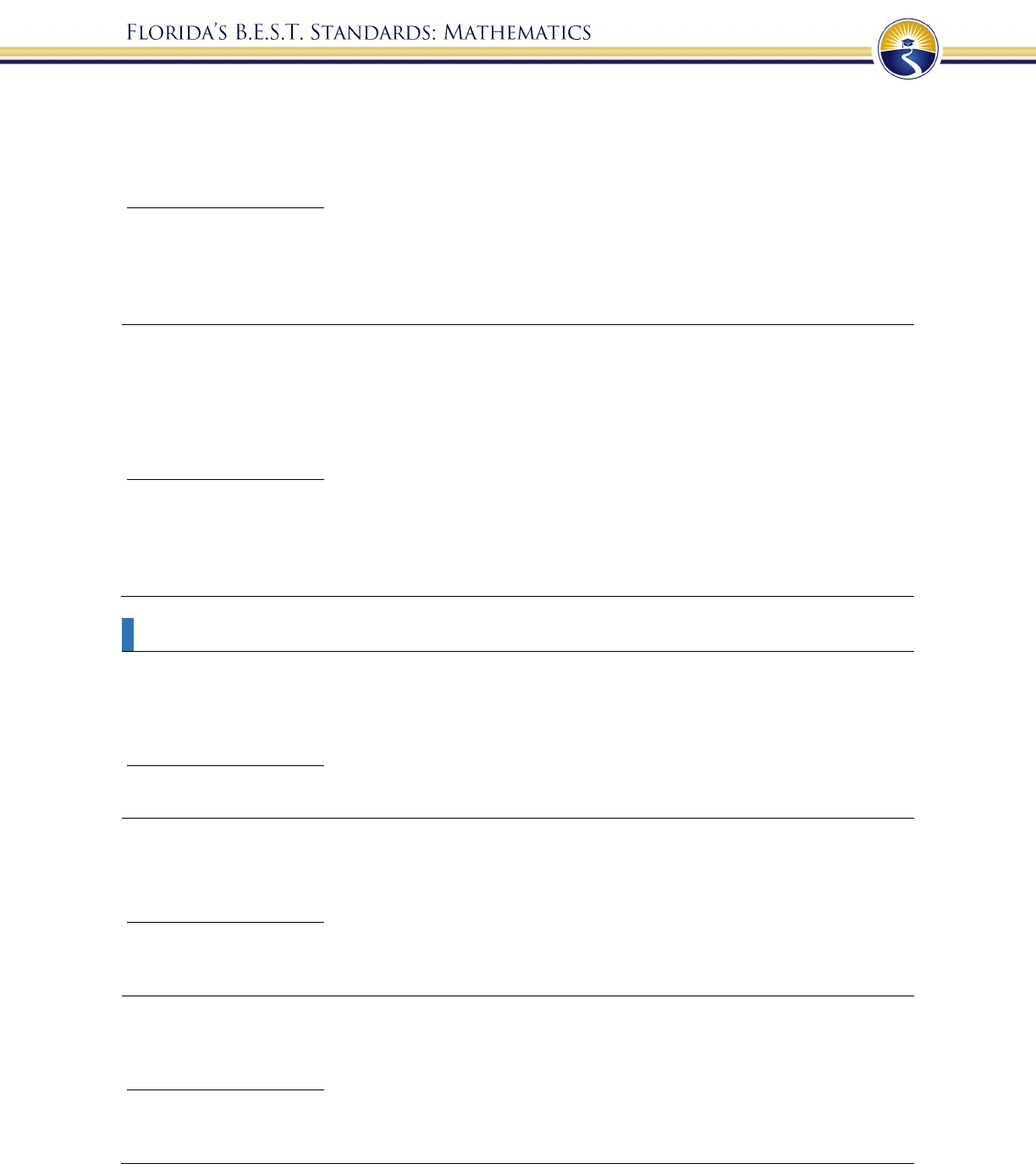
68
MA.6.NSO.1.3
Given a mathematical or real-world context, interpret the absolute value of a
number as the distance from zero on a number line. Find the absolute value of
rational numbers.
Benchmark Clarifications:
Clarification 1: Instruction includes the connection of absolute value to mirror images about zero and to
opposites.
Clarification 2: Instruction includes vertical and horizontal number lines and context referring to
distances, temperature and finances.
MA.6.NSO.1.4
Solve mathematical and real-world problems involving absolute value,
including the comparison of absolute value.
Example: Michael has a lemonade stand which costs $10 to start up. If he makes $5
the first day, he can determine whether he made a profit so far by
comparing
|
10
|
and
|
5
|
.
Benchmark Clarifications:
Clarification 1: Absolute value situations include distances, temperatures and finances.
Clarification 2: Problems involving calculations with absolute value are limited to two or fewer
operations.
Clarification 3: Within this benchmark, the expectation is to use integers only.
MA.6.NSO.2 Add, subtract, multiply and divide positive rational numbers.
MA.6.NSO.2.1
Multiply and divide positive multi-digit numbers with decimals to the
thousandths, including using a standard algorithm with procedural fluency.
Benchmark Clarifications:
Clarification 1: Multi-digit decimals are limited to no more than 5 total digits.
MA.6.NSO.2.2
Extend previous understanding of multiplication and division to compute
products and quotients of positive fractions by positive fractions, including
mixed numbers, with procedural fluency.
Benchmark Clarifications:
Clarification 1: Instruction focuses on making connections between visual models, the relationship
between multiplication and division, reciprocals and algorithms.
MA.6.NSO.2.3
Solve multi-step real-world problems involving any of the four operations with
positive multi-digit decimals or positive fractions, including mixed numbers.
Benchmark Clarifications:
Clarification 1: Within this benchmark, it is not the expectation to include both decimals and fractions
within a single problem.

69
MA.6.NSO.3 Apply properties of operations to rewrite numbers in equivalent forms.
MA.6.NSO.3.1
Given a mathematical or real-world context, find the greatest common factor
and least common multiple of two whole numbers.
Example: Middleton Middle School’s band has an upcoming winter concert which
will have several performances. The bandleader would like to divide the
students into concert groups with the same number of flute players, the
same number of clarinet players and the same number of violin players in
each group. There are a total of 15 students who play the flute, 27 students
who play the clarinet and 12 students who play the violin. How many
separate groups can be formed?
Example: Adam works out every 8 days and Susan works out every 12 days. If both
Adam and Susan work out today, how many days until they work out on
the same day again?
Benchmark Clarifications:
Clarification 1: Within this benchmark, expectations include finding greatest common factor within
1,000 and least common multiple with factors to 25.
Clarification 2: Instruction includes finding the greatest common factor of the numerator and
denominator of a fraction to simplify the fraction.
MA.6.NSO.3.2
Rewrite the sum of two composite whole numbers having a common factor, as
a common factor multiplied by the sum of two whole numbers.
Benchmark Clarifications:
Clarification 1: Instruction includes using the distributive property to generate equivalent expressions.
MA.6.NSO.3.3
Evaluate positive rational numbers and integers with natural number
exponents.
Benchmark Clarifications:
Clarification 1: Within this benchmark, expectations include using natural number exponents up to 5.
MA.6.NSO.3.4
Express composite whole numbers as a product of prime factors with natural
number exponents.
MA.6.NSO.3.5
Rewrite positive rational numbers in different but equivalent forms including
fractions, terminating decimals and percentages.
Example: The number 1
can be written equivalently as 1.625 or 162.5%
Benchmark Clarifications:
Clarification 1: Rational numbers include decimal equivalence up to the thousandths place.
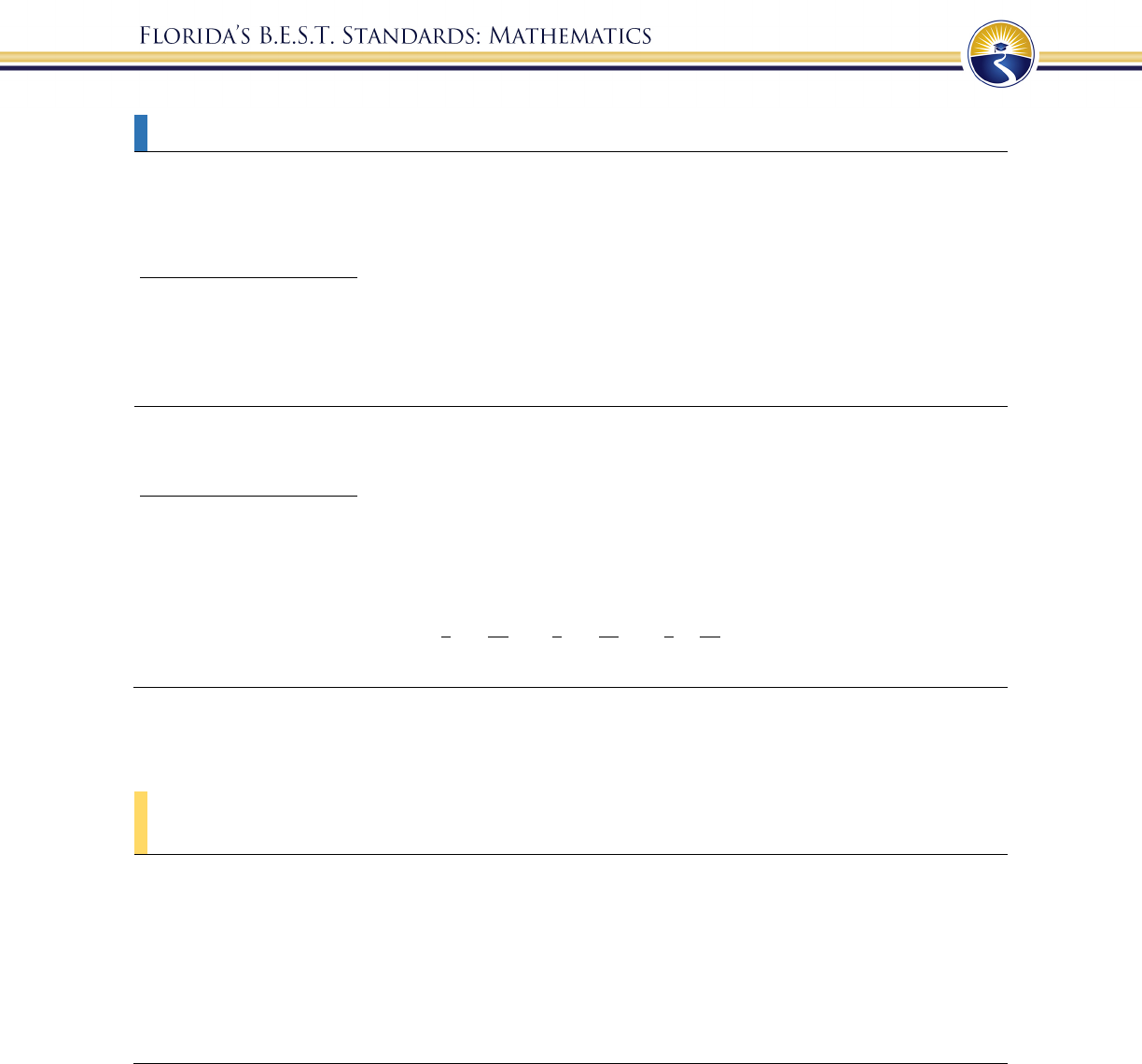
70
MA.6.NSO.4 Extend understanding of operations with integers.
MA.6.NSO.4.1
Apply and extend previous understandings of operations with whole numbers
to add and subtract integers with procedural fluency.
Benchmark Clarifications:
Clarification 1: Instruction begins with the use of manipulatives, models and number lines working
towards becoming procedurally fluent by the end of grade 6.
Clarification 2: Instruction focuses on the inverse relationship between the operations of addition and
subtraction. If and are integers, then = +
(
)
and + =
(
)
.
MA.6.NSO.4.2
Apply and extend previous understandings of operations with whole numbers
to multiply and divide integers with procedural fluency.
Benchmark Clarifications:
Clarification 1: Instruction includes the use of models and number lines and the inverse relationship
between multiplication and division, working towards becoming procedurally fluent by the end of grade
6.
Clarification 2: Instruction focuses on the understanding that integers can be divided, provided that the
divisor is not zero, and every quotient of integers (with non-zero divisor) is a rational number. If and
are integers where 0, then
=
,
=
and
=
.
Algebraic Reasoning
MA.6.AR.1 Apply previous understanding of arithmetic expressions to algebraic
expressions.
MA.6.AR.1.1
Given a mathematical or real-world context, translate written descriptions into
algebraic expressions and translate algebraic expressions into written
descriptions.
Example: The algebraic expression 7.220 can be used to describe the daily profit of
a company who makes $7.20 per product sold with daily expenses of $20.

71
MA.6.AR.1.2
Translate a real-world written description into an algebraic inequality in the form
of > , < , or . Represent the inequality on a number line.
Example: Mrs. Anna told her class that they will get a pizza if the class has an average
of at least 83 out of 100 correct questions on the semester exam. The
inequality 83 can be used to represent the situation where students
receive a pizza and the inequality < 83 can be used to represent the
situation where students do not receive a pizza.
Benchmark Clarifications:
Clarification 1: Variables may be on the left or right side of the inequality symbol.
MA.6.AR.1.3
Evaluate algebraic expressions using substitution and order of operations.
Example: Evaluate the expression 2
, where = 1 and = 15.
Benchmark Clarifications:
Clarification 1: Within this benchmark, the expectation is to perform all operations with integers.
Clarification 2: Refer to Properties of Operations, Equality and Inequality (Appendix D)
.
MA.6.AR.1.4
Apply the properties of operations to generate equivalent algebraic expressions
with integer coefficients.
Example: The expression 5(3+ 1) can be rewritten equivalently as 15+ 5.
Example: If the expression 2+ 3 represents the profit the cheerleading team can
make when selling the same number of cupcakes, sold for $2 each, and
brownies, sold for $3 each. The expression 5 can express the total profit.
Benchmark Clarifications:
Clarification 1: Properties include associative, commutative and distributive.
Clarification 2: Refer to Properties of Operations, Equality and Inequality (Appendix D).
MA.6.AR.2 Develop an understanding for solving equations and inequalities. Write and
solve one-step equations in one variable.
MA.6.AR.2.1
Given an equation or inequality and a specified set of integer values, determine
which values make the equation or inequality true or false.
Example: Determine which of the following values make the inequality + 1 < 2 true:
4, 2, 0, 1.
Benchmark Clarifications:
Clarification 1: Problems include the variable in multiple terms or on either side of the equal sign or
inequality symbol.
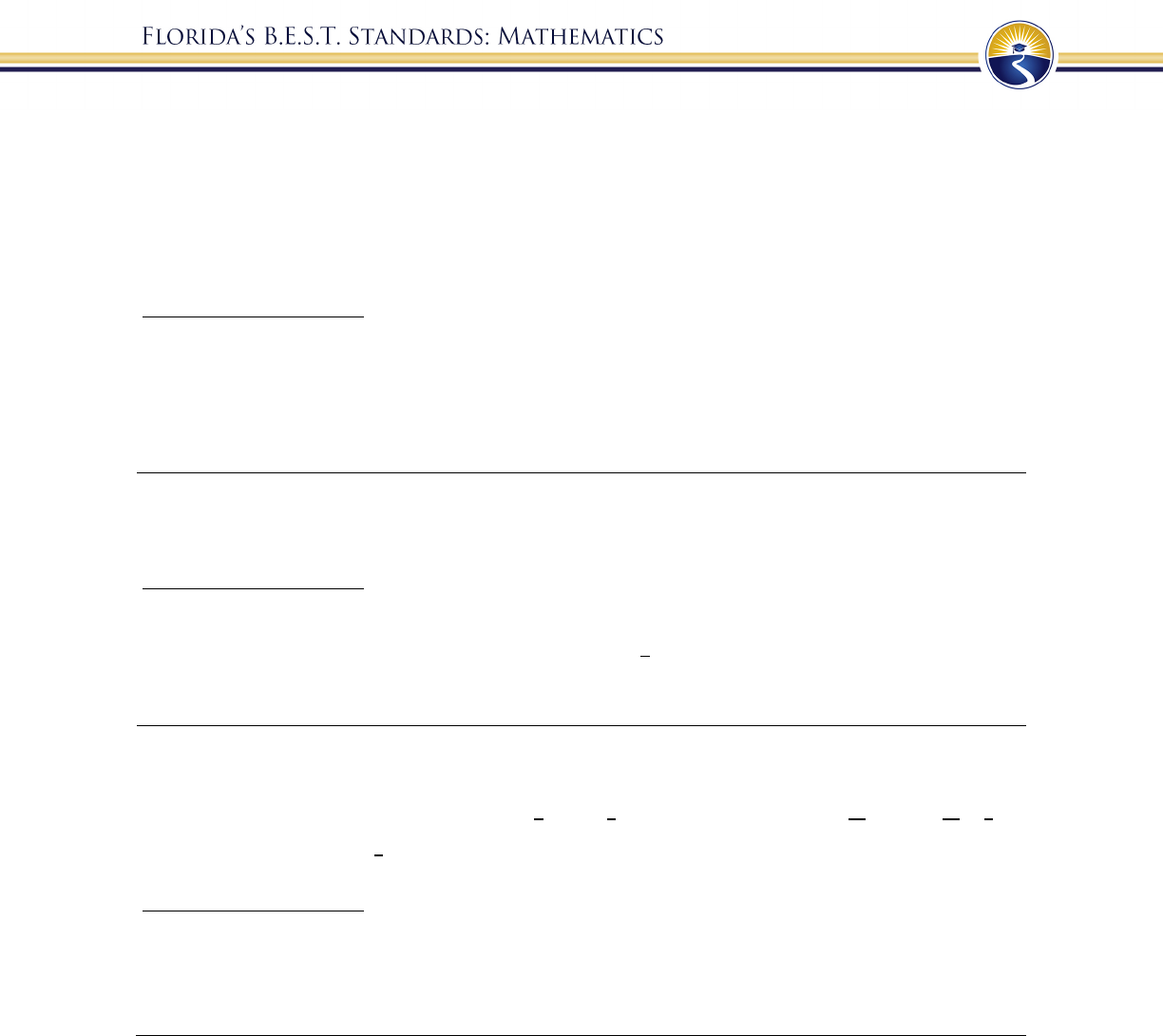
72
MA.6.AR.2.2
Write and solve one-step equations in one variable within a mathematical or
real-world context using addition and subtraction, where all terms and solutions
are integers.
Example: The equations 35 + = 17, 17 = 35 + and 17 = 35 can
represent the question “How many units to the right is 17 from -35 on the
number line?”
Benchmark Clarifications:
Clarification 1: Instruction includes using manipulatives, drawings, number lines and inverse
operations.
Clarification 2: Instruction includes equations in the forms + = and + = , where , and
are any integer.
Clarification 3: Problems include equations where the variable may be on either side of the equal sign.
MA.6.AR.2.3
Write and solve one-step equations in one variable within a mathematical or
real-world context using multiplication and division, where all terms and
solutions are integers.
Benchmark Clarifications:
Clarification 1: Instruction includes using manipulatives, drawings, number lines and inverse
operations.
Clarification 2: Instruction includes equations in the forms
= , where 0, and = .
Clarification 3: Problems include equations where the variable may be on either side of the equal sign.
MA.6.AR.2.4
Determine the unknown decimal or fraction in an equation involving any of the
four operations, relating three numbers, with the unknown in any position.
Example: Given the equation
=
, can be determined to be
because
is
more than
.
Benchmark Clarifications:
Clarification 1: Instruction focuses on using algebraic reasoning, drawings, and mental math to
determine unknowns.
Clarification 2: Problems include the unknown and different operations on either side of the equal sign.
All terms and solutions are limited to positive rational numbers.

73
MA.6.AR.3 Understand ratio and unit rate concepts and use them to solve problems.
MA.6.AR.3.1
Given a real-world context, write and interpret ratios to show the relative sizes of
two quantities using appropriate notation:
, to , or : where 0.
Benchmark Clarifications:
Clarification 1: Instruction
focuses on the understanding that a ratio can be described as a comparison of
two quantities in either the same or different units.
Clarification 2: Instruction includes using manipulatives, drawings, models and words to interpret part-
to-part ratios and part-to-whole ratios.
Clarification 3: The values of and are limited to whole numbers.
MA.6.AR.3.2
Given a real-world context, determine a rate for a ratio of quantities with
different units. Calculate and interpret the corresponding unit rate.
Example: Tamika can read 500 words in 3 minutes. Her reading rate can be described as
which is equivalent to the unit rate of 166
words per minute.
Benchmark Clarifications:
Clarification 1: Instruction includes using manipulatives, drawings, models and words and making
connections between ratios, rates and unit rates.
Clarification 2: Problems will not include conversions between customary and metric systems.
MA.6.AR.3.3
Extend previous understanding of fractions and numerical patterns to generate or
complete a two- or three-column table to display equivalent part-to-part ratios
and part-to-part-to-whole ratios.
Example: The table below expresses the relationship between the number of ounces of
yellow and blue paints used to create a new color. Determine the ratios and
complete the table.
Yellow (part)
1.5
3
9
Blue (part)
2
4
New color (whole)
12
21
Benchmark Clarifications:
Clarification 1: Instruction includes using two-
column tables (e.g., a relationship between two variables)
and three-column tables (e.g., part-to-part-to-whole relationship) to generate conversion charts and
mixture charts.
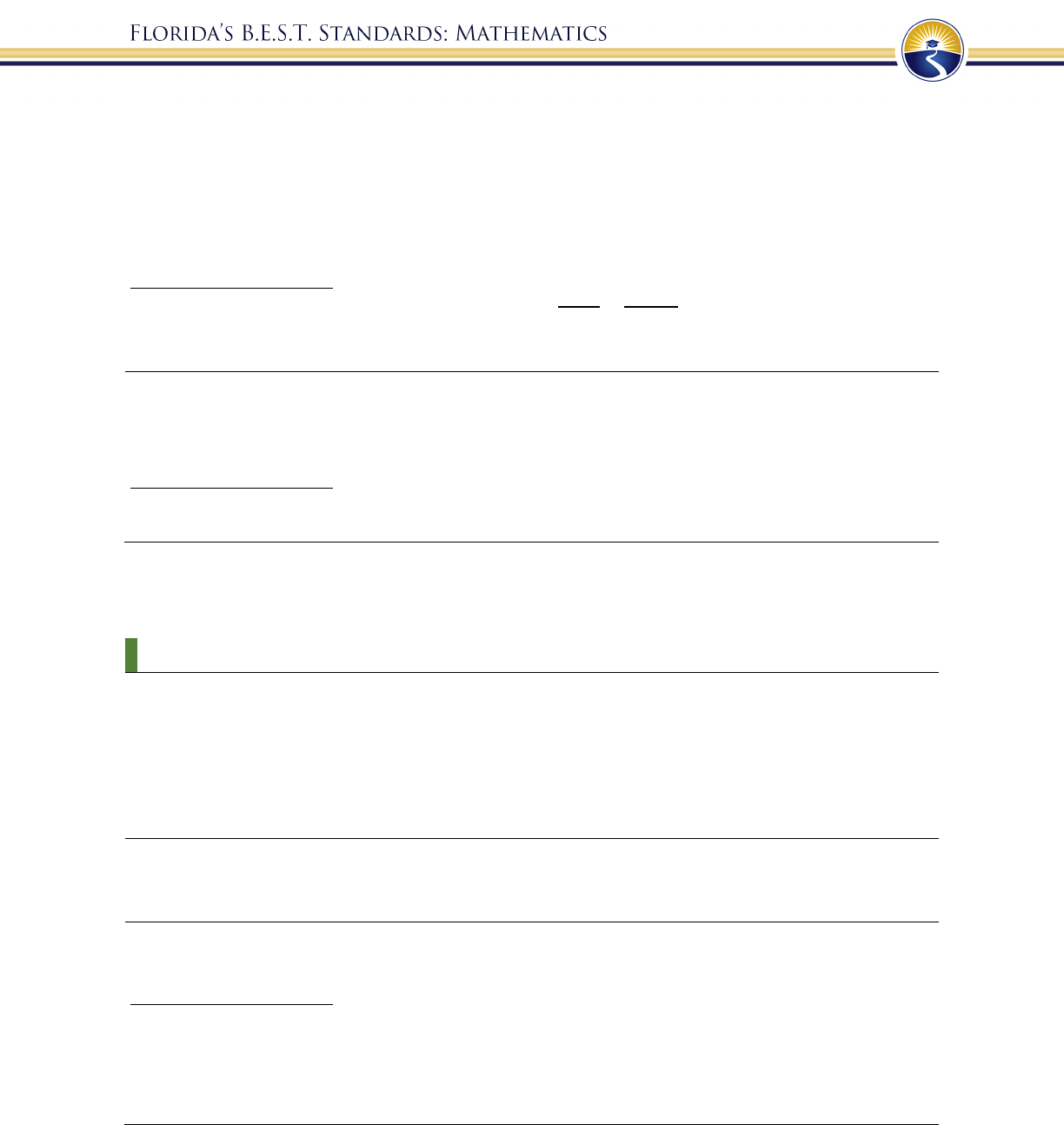
74
MA.6.AR.3.4
Apply ratio relationships to solve mathematical and real-world problems
involving percentages using the relationship between two quantities.
Example: Gerald is trying to gain muscle and needs to consume more protein every day.
If he has a protein shake that contain 32 grams and the entire shake is 340
grams, what percentage of the entire shake is protein? What is the ratio
between grams of protein and grams of non-protein?
Benchmark Clarifications:
Clarification 1: Instruction includes the comparison of
to
in order to determine the
percent, the part or the whole.
MA.6.AR.3.5
Solve mathematical and real-world problems involving ratios, rates and unit
rates, including comparisons, mixtures, ratios of lengths and conversions within
the same measurement system.
Benchmark Clarifications:
Clarification 1: Instruction includes the use of tables, tape diagrams and number lines.
Geometric Reasoning
MA.6.GR.1 Apply previous understanding of the coordinate plane to solve problems.
MA.6.GR.1.1
Extend previous understanding of the coordinate plane to plot rational number
ordered pairs in all four quadrants and on both axes. Identify the - or -axis as
the line of reflection when two ordered pairs have an opposite - or -
coordinate.
MA.6.GR.1.2
Find distances between ordered pairs, limited to the same -coordinate or the
same -coordinate, represented on the coordinate plane.
MA.6.GR.1.3
Solve mathematical and real-world problems by plotting points on a coordinate
plane, including finding the perimeter or area of a rectangle.
Benchmark Clarifications:
Clarification 1: Instruction includes finding distances between points, computing dimensions of a
rectangle or determining a fourth vertex of a rectangle.
Clarification 2: Problems involving rectangles are limited to cases where the sides are parallel to the
axes.
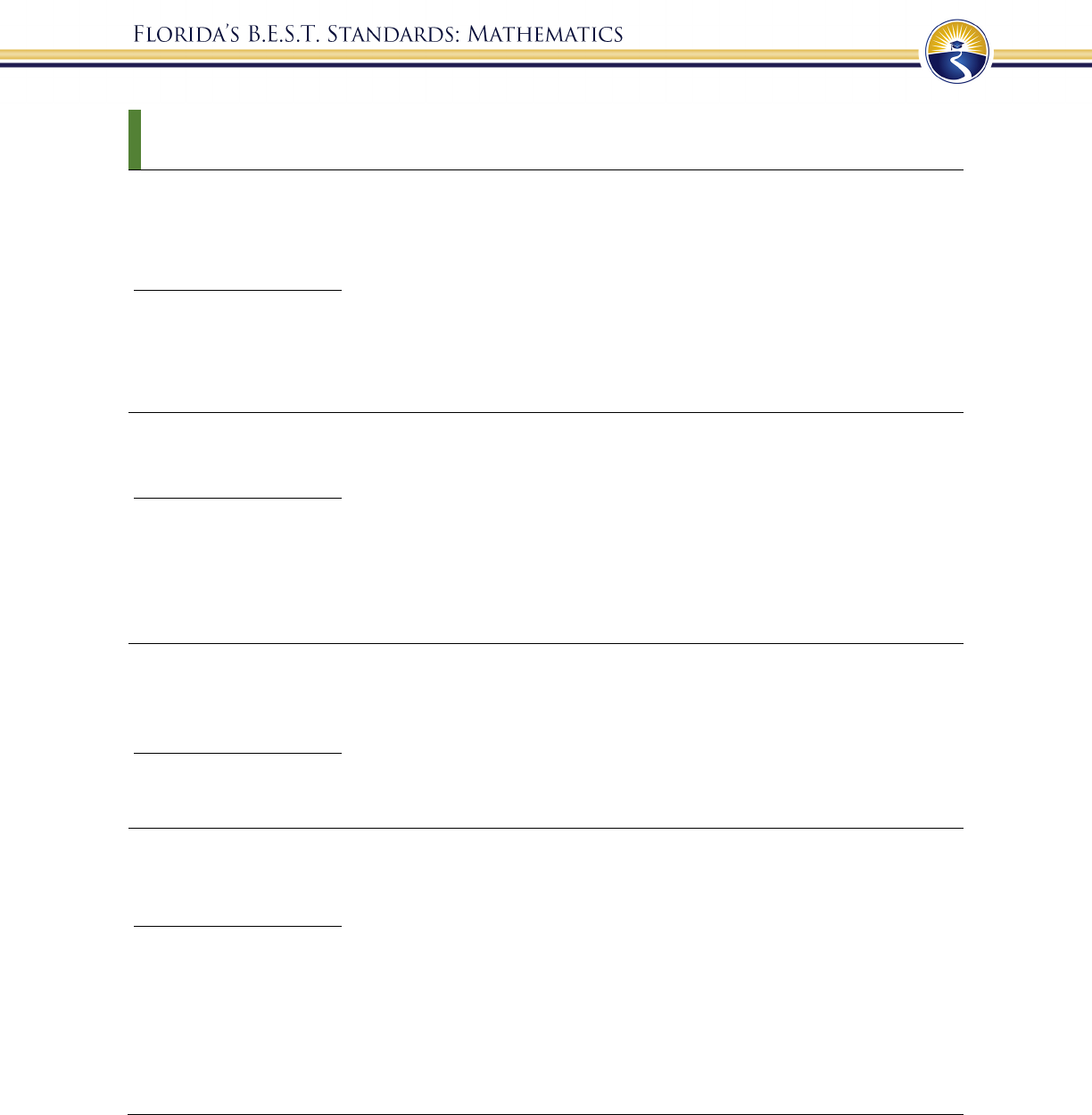
75
MA.6.GR.2 Model and solve problems involving two-dimensional figures and three-
dimensional figures.
MA.6.GR.2.1
Derive a formula for the area of a right triangle using a rectangle. Apply a
formula to find the area of a triangle.
Benchmark Clarifications:
Clarification 1: Instruction focuses on the relationship between the area of a rectangle and the area of a
right triangle.
Clarification 2: Within this benchmark, the expectation is to know from memory a formula for the area
of a triangle.
MA.6.GR.2.2
Solve mathematical and real-world problems involving the area of quadrilaterals
and composite figures by decomposing them into triangles or rectangles.
Benchmark Clarifications:
Clarification 1: Problem types include finding area of composite shapes and determining missing
dimensions.
Clarification 2: Within this benchmark, the expectation is to know from memory a formula for the area
of a rectangle and triangle.
Clarification 3: Dimensions are limited to positive rational numbers.
MA.6.GR.2.3
Solve mathematical and real-world problems involving the volume of right
rectangular prisms with positive rational number edge lengths using a visual
model and a formula.
Benchmark Clarifications:
Clarification 1: Problem types include finding the volume or a missing dimension of a rectangular
prism.
MA.6.GR.2.4
Given a mathematical or real-world context, find the surface area of right
rectangular prisms and right rectangular pyramids using the figure’s net.
Benchmark Clarifications:
Clarification 1: Instruction focuses on representing a right rectangular prism and right rectangular
pyramid with its net and on the connection between the surface area of a figure and its net.
Clarification 2: Within this benchmark, the expectation is to find the surface area when given a net or
when given a three-dimensional figure.
Clarification 3: Problems involving right rectangular pyramids are limited to cases where the heights of
triangles are given.
Clarification 4: Dimensions are limited to positive rational numbers.
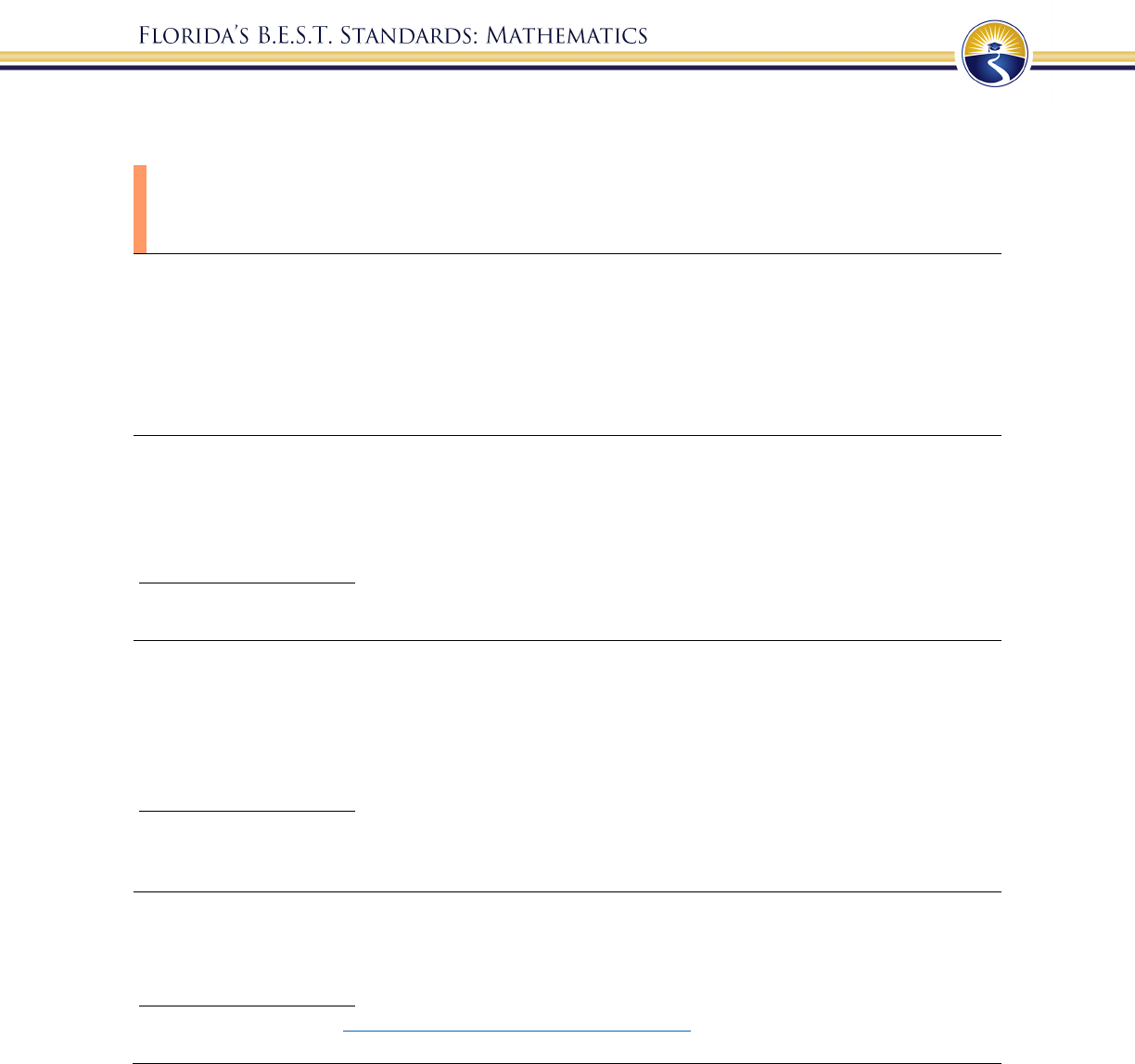
76
Data Analysis and Probability
MA.6.DP.1 Develop an understanding of statistics and determine measures of center and
measures of variability. Summarize statistical distributions graphically and
numerically.
MA.6.DP.1.1
Recognize and formulate a statistical question that would generate numerical
data.
Example: The question “How many minutes did you spend on mathematics homework
last night?” can be used to generate numerical data in one variable.
MA.6.DP.1.2
Given a numerical data set within a real-world context, find and interpret mean,
median, mode and range.
Example: The data set {15, 0, 32, 24, 0, 17, 42, 0, 29, 120, 0, 20}, collected based on
minutes spent on homework, has a mode of 0.
Benchmark Clarifications:
Clarification 1: Numerical data is limited to positive rational numbers.
MA.6.DP.1.3
Given a box plot within a real-world context, determine the minimum, the lower
quartile, the median, the upper quartile and the maximum. Use this summary of
the data to describe the spread and distribution of the data.
Example: The middle 50% of the population can be determined by finding the interval
between the upper quartile and the lower quartile.
Benchmark Clarifications:
Clarification 1: Instruction includes describing range, interquartile range, halves and quarters of the
data.
MA.6.DP.1.4
Given a histogram or line plot within a real-world context, qualitatively describe
and interpret the spread and distribution of the data, including any symmetry,
skewness, gaps, clusters, outliers and the range.
Benchmark Clarifications:
Clarification 1: Refer to K-12 Mathematics Glossary (Appendix C).
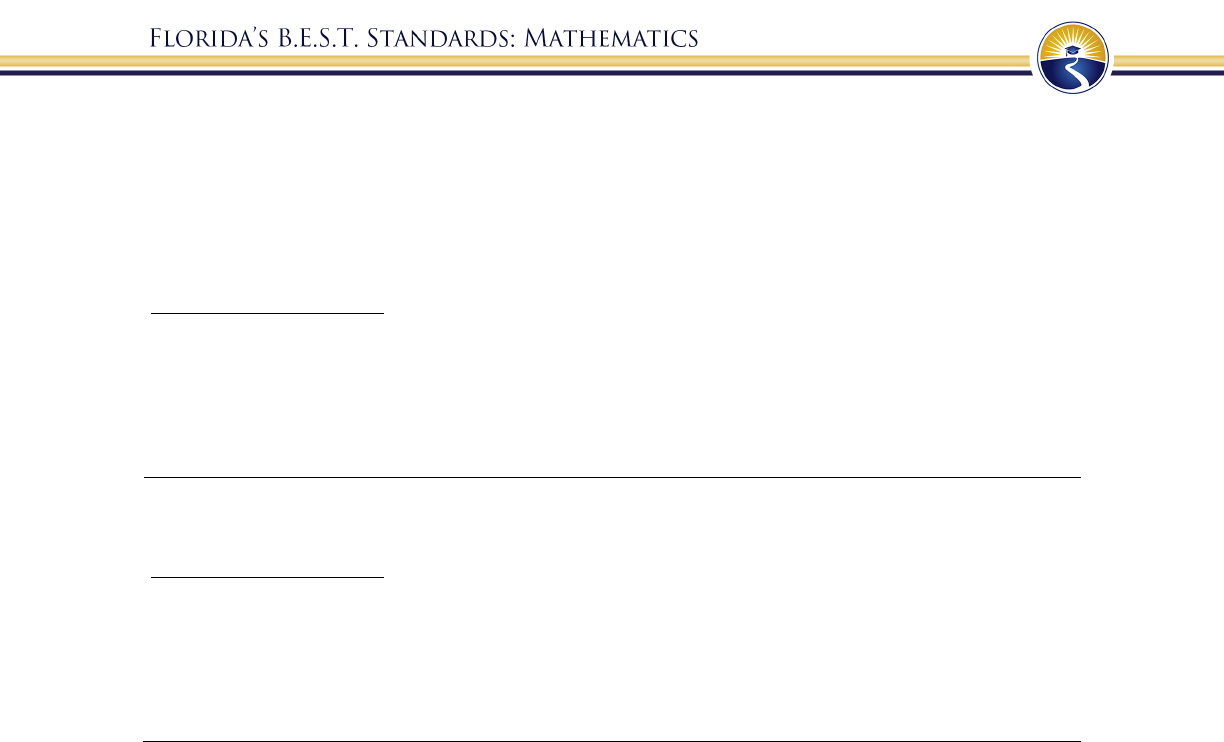
77
MA.6.DP.1.5
Create box plots and histograms to represent sets of numerical data within real-
world contexts.
Example: The numerical data set
{
15, 0, 32, 24, 0, 17, 42, 0, 29, 120, 0, 20
}
, collected
based on minutes spent on homework, can be represented graphically using
a box plot.
Benchmark Clarifications:
Clarification 1: Instruction includes collecting data and discussing ways to collect truthful data to
construct graphical representations.
Clarification 2: Within this benchmark, it is the expectation to use appropriate titles, labels, scales and
units when constructing graphical representations.
Clarification 3: Numerical data is limited to positive rational numbers.
MA.6.DP.1.6
Given a real-world scenario, determine and describe how changes in data values
impact measures of center and variation.
Benchmark Clarifications:
Clarification 1: Instruction includes choosing the measure of center or measure of variation depending
on the scenario.
Clarification 2: The measures of center are limited to mean and median. The measures of variation are
limited to range and interquartile range.
Clarification 3: Numerical data is limited to positive rational numbers.
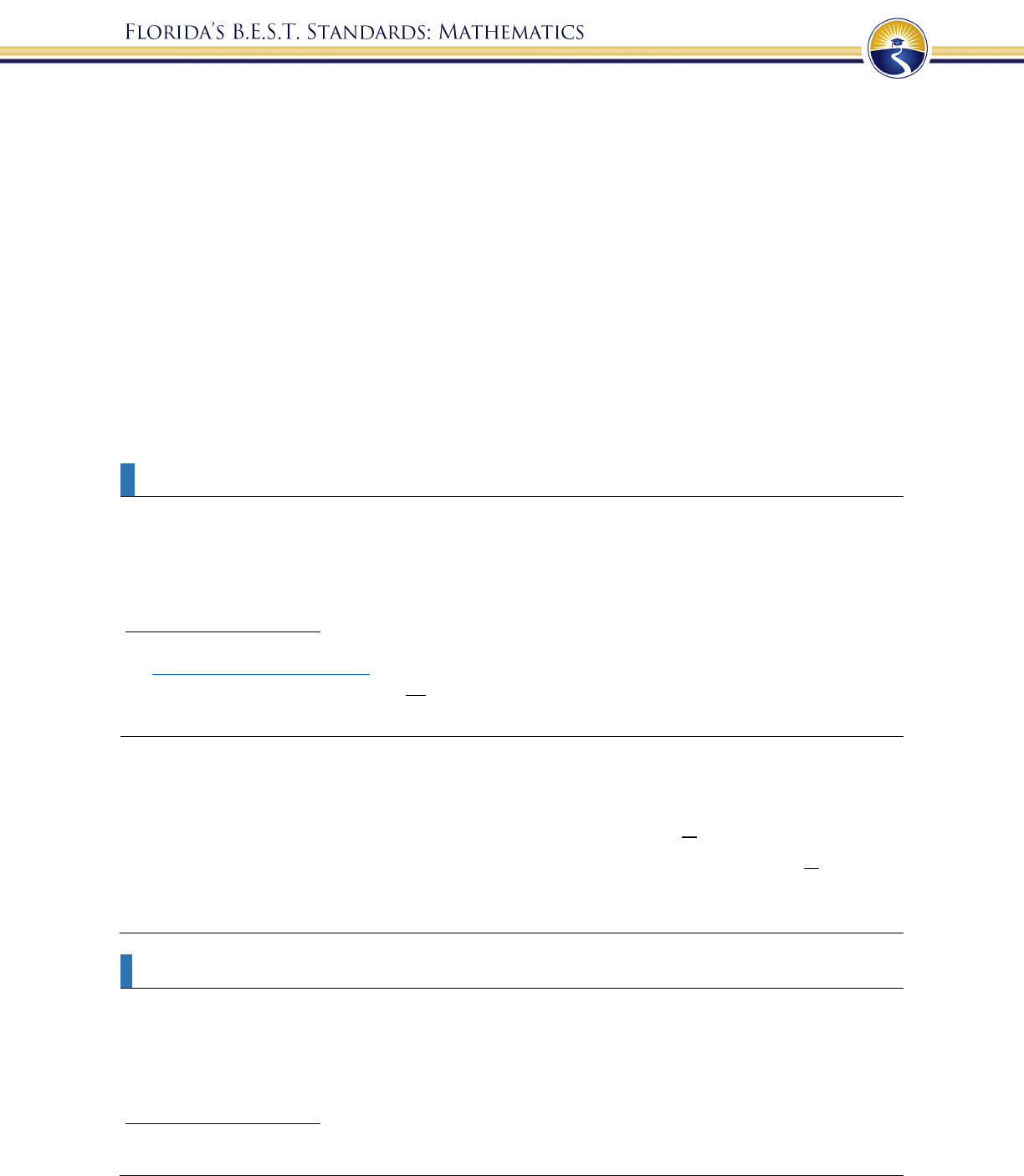
78
Grade 7
In grade 7, instructional time will emphasize five areas:
(1) recognizing that fractions, decimals and percentages are different representations of
rational numbers and performing all four operations with rational numbers with
procedural fluency;
(2) creating equivalent expressions and solving equations and inequalities;
(3) developing understanding of and applying proportional relationships in two variables;
(4) extending analysis of two- and three-dimensional figures to include circles and
cylinders and
(5) representing and comparing categorical and numerical data and developing
understanding of probability.
Number Sense and Operations
MA.7.NSO.1 Rewrite numbers in equivalent forms.
MA.7.NSO.1.1
Know and apply the Laws of Exponents to evaluate numerical expressions and
generate equivalent numerical expressions, limited to whole-number exponents
and rational number bases.
Benchmark Clarifications:
Clarification 1: Instruction focuses on building the Laws of Exponents from specific examples. Refer to
the K-12 Formulas (Appendix E)
for the Laws of Exponents.
Clarification 2: Problems in the form
=
must result in a whole-number value for .
MA.7.NSO.1.2
Rewrite rational numbers in different but equivalent forms including fractions,
mixed numbers, repeating decimals and percentages to solve mathematical and
real-world problems.
Example: Justin is solving a problem where he computes
and his calculator gives
him the answer 5.6666666667. Justin makes the statement that
=
5.6666666667; is he correct?
MA.7.NSO.2 Add, subtract, multiply and divide rational numbers.
MA.7.NSO.2.1
Solve mathematical problems using multi-step order of operations with rational
numbers including grouping symbols, whole-number exponents and absolute
value.
Benchmark Clarifications:
Clarification 1: Multi-step expressions are limited to 6 or fewer steps.

79
MA.7.NSO.2.2
Add, subtract, multiply and divide rational numbers with procedural fluency.
MA.7.NSO.2.3
Solve real-world problems involving any of the four operations with rational
numbers.
Benchmark Clarifications:
Clarification 1: Instruction includes using one or more operations to solve problems.
Algebraic Reasoning
MA.7.AR.1 Rewrite algebraic expressions in equivalent forms.
MA.7.AR.1.1
Apply properties of operations to add and subtract linear expressions with
rational coefficients.
Example:
(
74
)
2
is equivalent to
6.
Benchmark Clarifications:
Clarification 1: Instruction includes linear expressions in the form ± or ± , where and are
rational numbers.
Clarification 2: Refer to Properties of Operations, Equality and Inequality (Appendix D)
.
MA.7.AR.1.2
Determine whether two linear expressions are equivalent.
Example: Are the expressions
(6 ) 3 and 8
equivalent?
Benchmark Clarifications:
Clarification 1: Instruction includes using properties of operations accurately and efficiently.
Clarification 2: Instruction includes linear expressions in any form with rational coefficients.
Clarification 3: Refer to Properties of Operations, Equality and Inequality (Appendix D)
.
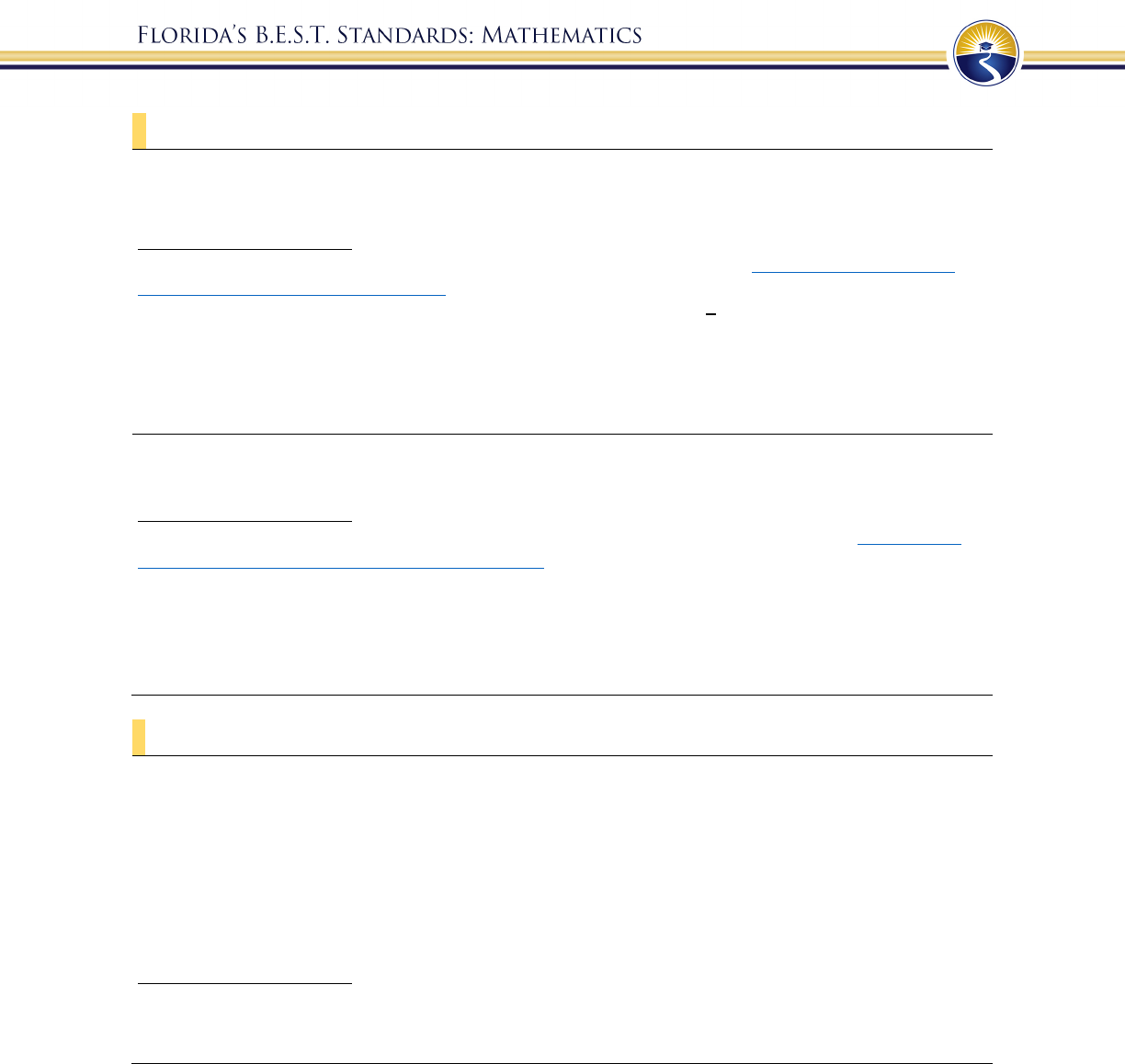
80
MA.7.AR.2 Write and solve equations and inequalities in one variable.
MA.7.AR.2.1
Write and solve one-step inequalities in one variable within a mathematical
context and represent solutions algebraically or graphically.
Benchmark Clarifications:
Clarification 1: Instruction focuses on the properties of inequality. Refer to Properties of Operations,
Equality and Inequality (Appendix D).
Clarification 2: Instruction includes inequalities in the forms > ;
> ; ± > and ± > ,
where and are specific rational numbers and any inequality symbol can be represented.
Clarification 3: Problems include inequalities where the variable may be on either side of the inequality
symbol.
MA.7.AR.2.2
Write and solve two-step equations in one variable within a mathematical or
real-world context, where all terms are rational numbers.
Benchmark Clarifications:
Clarification 1: Instruction focuses the application of the properties of equality. Refer to Properties of
Operations, Equality and Inequality (Appendix D).
Clarification 2: Instruction includes equations in the forms ± = and (± ) = , where ,
and are specific rational numbers.
Clarification 3: Problems include linear equations where the variable may be on either side of the equal
sign.
MA.7.AR.3 Use percentages and proportional reasoning to solve problems.
MA.7.AR.3.1
Apply previous understanding of percentages and ratios to solve multi-step real-
world percent problems.
Example: 23% of the junior population are taking an art class this year. What is the ratio
of juniors taking an art class to juniors not taking an art class?
Example: The ratio of boys to girls in a class is 3: 2
. What percentage of the students are
boys in the class?
Benchmark Clarifications:
Clarification 1: Instruction includes discounts, markups, simple interest, tax, tips, fees, percent increase,
percent decrease and percent error.

81
MA.7.AR.3.2
Apply previous understanding of ratios to solve real-world problems involving
proportions.
Example: Scott is mowing lawns to earn money to buy a new gaming system and knows
he needs to mow 35 lawns to earn enough money. If he can mow 4 lawns in 3
hours and 45 minutes, how long will it take him to mow 35 lawns? Assume
that he can mow each lawn in the same amount of time.
Example:
Ashley normally runs 10-kilometer races which is about 6.2 miles. She wants
to start training for a half-marathon which is 13.1 miles. How many
kilometers will she run in the half-marathon? How does that compare to her
normal 10K race distance?
MA.7.AR.3.3
Solve mathematical and real-world problems involving the conversion of units
across different measurement systems.
Benchmark Clarifications:
Clarification 1: Problem types are limited to length, area, weight, mass, volume and money.
MA.7.AR.4 Analyze and represent two-variable proportional relationships.
MA.7.AR.4.1
Determine whether two quantities have a proportional relationship by examining
a table, graph or written description.
Benchmark Clarifications:
Clarification 1: Instruction focuses on the connection to ratios and on the constant of proportionality,
which is the ratio between two quantities in a proportional relationship.
MA.7.AR.4.2
Determine the constant of proportionality within a mathematical or real-world
context given a table, graph or written description of a proportional relationship.
Example: A graph has a line that goes through the origin and the point (5, 2). This
represents a proportional relationship and the constant of proportionality is
.
Example: Gina works as a babysitter and earns $9 per hour. She can only work 6 hours
this week. Gina wants to know how much money she will make. Gina can use
the equation = , where is the amount of money earned,
is the number
of hours worked and 9 is the constant of proportionality.
MA.7.AR.4.3
Given a mathematical or real-world context, graph proportional relationships
from a table, equation or a written description.
Benchmark Clarifications:
Clarification 1: Instruction includes equations of proportional relationships in the form of = ,
where is the constant of proportionality.
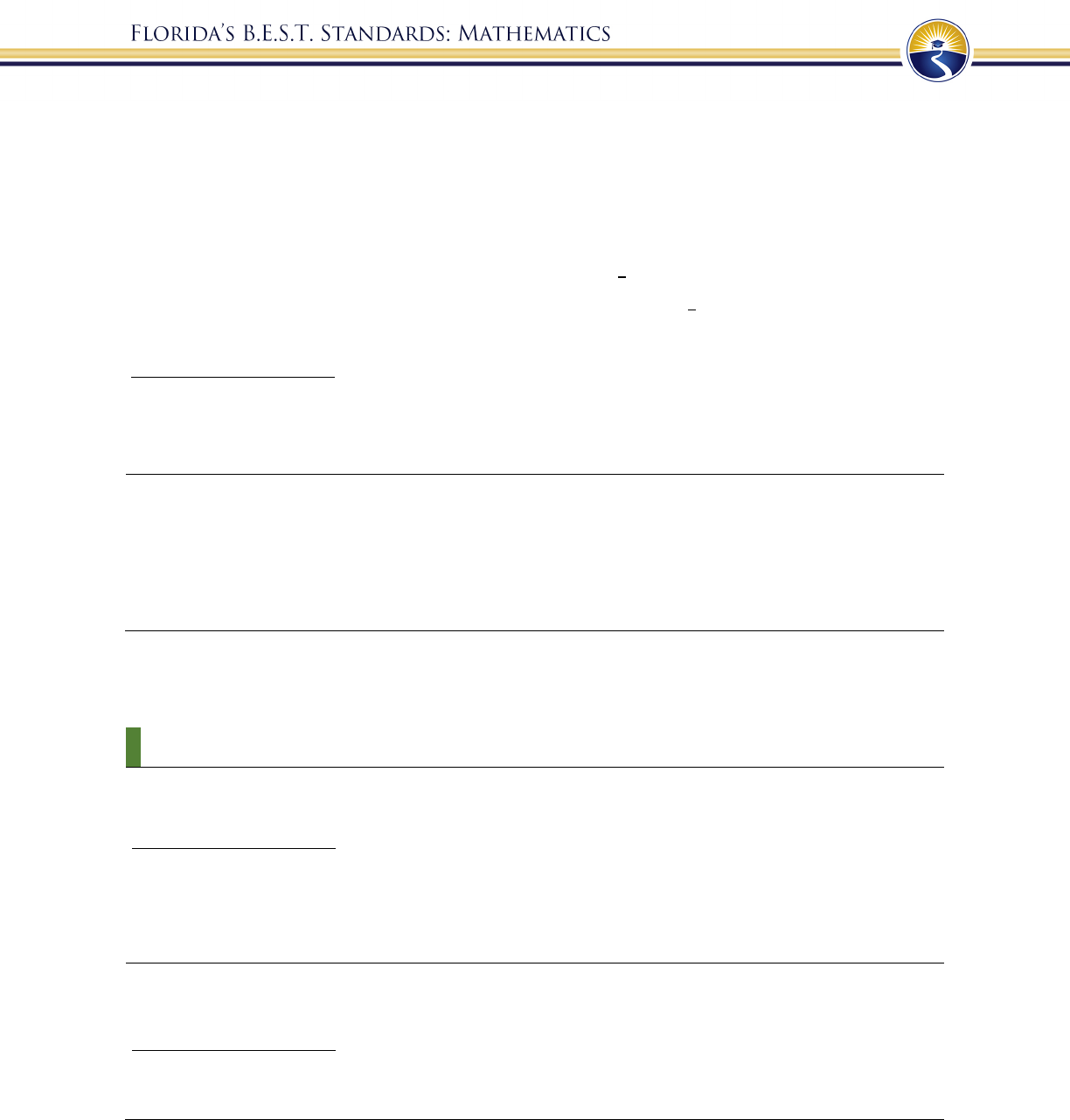
82
MA.7.AR.4.4
Given any representation of a proportional relationship, translate the
representation to a written description, table or equation.
Example: The written description, there are 60 minutes in 1 hour, can be represented as
the equation = .
Example:
Gina works as a babysitter and earns $9 per hour. She would like to earn $100
to buy a new tennis racket. Gina wants to know how many hours she needs to
work. She can use the equation =
, where is the amount of money
earned, is the number of hours worked and
is the constant of
proportionality.
Benchmark Clarifications:
Clarification 1: Given representations are limited to a written description, graph, table or equation.
Clarification 2: Instruction includes equations of proportional relationships in the form of = ,
where is the constant of proportionality.
MA.7.AR.4.5
Solve real-world problems involving proportional relationships.
Example: Gordy is taking a trip from Tallahassee, FL to Portland, Maine which is about
1,407 miles. On average his SUV gets 23.1 miles per gallon on the highway
and his gas tanks holds 17.5 gallons. If Gordy starts with a full tank of gas,
how many times will he be required to fill the gas tank?
Geometric Reasoning
MA.7.GR.1 Solve problems involving two-dimensional figures, including circles.
MA.7.GR.1.1 Apply formulas to find the areas of trapezoids, parallelograms and rhombi.
Benchmark Clarifications:
Clarification 1: Instruction focuses on the connection from the areas of trapezoids, parallelograms and
rhombi to the areas of rectangles or triangles.
Clarification 2: Within this benchmark, the expectation is not to memorize area formulas for trapezoids,
parallelograms and rhombi.
MA.7.GR.1.2
Solve mathematical or real-world problems involving the area of polygons or
composite figures by decomposing them into triangles or quadrilaterals.
Benchmark Clarifications:
Clarification 1: Within this benchmark, the expectation is not to find areas of figures on the coordinate
plane or to find missing dimensions.

83
MA.7.GR.1.3
Explore the proportional relationship between circumferences and diameters of
circles. Apply a formula for the circumference of a circle to solve mathematical
and real-world problems.
Benchmark Clarifications:
Clarification 1: Instruction includes the exploration and analysis of circular objects to examine the
proportional relationship between circumference and diameter and arrive at an approximation of pi ()
as the constant of proportionality.
Clarification 2: Solutions may be represented in terms of pi () or approximately.
MA.7.GR.1.4
Explore and apply a formula to find the area of a circle to solve mathematical
and real-world problems.
Example: If a 12-inch pizza is cut into 6 equal slices and Mikel ate 2 slices, how many
square inches of pizza did he eat?
Benchmark Clarifications:
Clarification 1: Instruction focuses on the connection between formulas for the area of a rectangle and
the area of a circle.
Clarification 2: Problem types include finding areas of fractional parts of a circle.
Clarification 3: Solutions may be represented in terms of pi () or approximately.
MA.7.GR.1.5
Solve mathematical and real-world problems involving dimensions and areas of
geometric figures, including scale drawings and scale factors.
Benchmark Clarifications:
Clarification 1: Instruction focuses on seeing the scale factor as a constant of proportionality between
corresponding lengths in the scale drawing and the original object.
Clarification 2: Instruction includes the understanding that if the scaling factor is , then the constant of
proportionality between corresponding areas is
.
Clarification 3: Problem types include finding the scale factor given a set of dimensions as well as
finding dimensions when given a scale factor.
MA.7.GR.2 Solve problems involving three-dimensional figures, including right circular
cylinders.
MA.7.GR.2.1
Given a mathematical or real-world context, find the surface area of a right
circular cylinder using the figure’s net.
Benchmark Clarifications:
Clarification 1: Instruction focuses on representing a right circular cylinder with its net and on the
connection between surface area of a figure and its net.
Clarification 2: Within this benchmark, the expectation is to find the surface area when given a net or
when given a three-dimensional figure.
Clarification 3:
Within this benchmark, the expectation is not to memorize the surface area formula for a
right circular cylinder.
Clarification 4: Solutions may be represented in terms of pi () or approximately.

84
MA.7.GR.2.2
Solve real-world problems involving surface area of right circular cylinders.
Benchmark Clarifications:
Clarification 1:
Within this benchmark, the expectation is not to memorize the surface area formula for a
right circular cylinder or to find radius as a missing dimension.
Clarification 2: Solutions may be represented in terms of pi () or approximately.
MA.7.GR.2.3
Solve mathematical and real-world problems involving volume of right circular
cylinders.
Benchmark Clarifications:
Clarification 1: Within this benchmark, the expectation is not to memorize the volume formula for a
right circular cylinder or to find radius as a missing dimension.
Clarification 2: Solutions may be represented in terms of pi () or approximately.
Data Analysis and Probability
MA.7.DP.1 Represent and interpret numerical and categorical data.
MA.7.DP.1.1
Determine an appropriate measure of center or measure of variation to
summarize numerical data, represented numerically or graphically, taking into
consideration the context and any outliers.
Benchmark Clarifications:
Clarification 1: Instruction includes recognizing whether a measure of center or measure of variation is
appropriate and can be justified based on the given context or the statistical purpose.
Clarification 2: Graphical representations are limited to histograms, line plots, box plots and stem-and-
leaf plots.
Clarification 3: The measure of center is limited to mean and median. The measure of variation is
limited to range and interquartile range.
MA.7.DP.1.2
Given two numerical or graphical representations of data, use the measure(s) of
center and measure(s) of variability to make comparisons, interpret results and
draw conclusions about the two populations.
Benchmark Clarifications:
Clarification 1: Graphical representations are limited to histograms, line plots, box plots and stem-and-
leaf plots.
Clarification 2: The measure of center is limited to mean and median. The measure of variation is
limited to range and interquartile range.

85
MA.7.DP.1.3
Given categorical data from a random sample, use proportional relationships to
make predictions about a population.
Example: O’Neill’s Pillow Store made 600 pillows yesterday and found that 6 were
defective. If they plan to make 4,300 pillows this week, predict
approximately how many pillows will be defective.
Example: A school district polled 400 people to determine if it was a good idea to not
have school on Friday. 30% of people responded that it was not a good idea
to have school on Friday. Predict the approximate percentage of people who
think it would be a good idea to have school on Friday from a population of
6,228 people.
MA.7.DP.1.4
Use proportional reasoning to construct, display and interpret data in circle
graphs.
Benchmark Clarifications:
Clarification 1: Data is limited to no more than 6 categories.
MA.7.DP.1.5
Given a real-world numerical or categorical data set, choose and create an
appropriate graphical representation.
Benchmark Clarifications:
Clarification 1: Graphical representations are limited to histograms, bar charts, circle graphs, line plots,
box plots and stem-and-leaf plots.
MA.7.DP.2 Develop an understanding of probability. Find and compare experimental and
theoretical probabilities.
MA.7.DP.2.1
Determine the sample space for a simple experiment.
Benchmark Clarifications:
Clarification 1: Simple experiments include tossing a fair coin, rolling a fair die, picking a card
randomly from a deck, picking marbles randomly from a bag and spinning a fair spinner.
MA.7.DP.2.2
Given the probability of a chance event, interpret the likelihood of it occurring.
Compare the probabilities of chance events.
Benchmark Clarifications:
Clarification 1: Instruction includes representing probability as a fraction, percentage or decimal
between 0 and 1 with probabilities close to 1 corresponding to highly likely events and probabilities
close to 0 corresponding to highly unlikely events.
Clarification 2: Instruction includes () notation.
Clarification 3: Instruction includes representing probability as a fraction, percentage or decimal.

86
MA.7.DP.2.3
Find the theoretical probability of an event related to a simple experiment.
Benchmark Clarifications:
Clarification 1: Instruction includes representing probability as a fraction, percentage or decimal.
Clarification 2: Simple experiments include tossing a fair coin, rolling a fair die, picking a card
randomly from a deck, picking marbles randomly from a bag and spinning a fair spinner.
MA.7.DP.2.4
Use a simulation of a simple experiment to find experimental probabilities and
compare them to theoretical probabilities.
Example: Investigate whether a coin is fair by tossing it 1,000 times and comparing the
percentage of heads to the theoretical probability 0.5.
Benchmark Clarifications:
Clarification 1: Instruction includes representing probability as a fraction, percentage or decimal.
Clarification 2: Instruction includes recognizing that experimental probabilities may differ from
theoretical probabilities due to random variation. As the number of repetitions increases experimental
probabilities will typically better approximate the theoretical probabilities.
Clarification 3: Experiments include tossing a fair coin, rolling a fair die, picking a card randomly from
a deck, picking marbles randomly from a bag and spinning a fair spinner.

87
Grade 8
In grade 8, instructional time will emphasize six areas:
(1) representing numbers in scientific notation and extending the set of numbers to the
system of real numbers, which includes irrational numbers;
(2) generate equivalent numeric and algebraic expressions including using the Laws of
Exponents;
(3) creating and reasoning about linear relationships including modeling an association in
bivariate data with a linear equation;
(4) solving linear equations, inequalities and systems of linear equations;
(5) developing an understanding of the concept of a function and
(6) analyzing two-dimensional figures, particularly triangles, using distance, angle and
applying the Pythagorean Theorem.
Number Sense and Operations
MA.8.NSO.1 Solve problems involving rational numbers, including numbers in scientific
notation, and extend the understanding of rational numbers to irrational
numbers.
MA.8.NSO.1.1
Extend previous understanding of rational numbers to define irrational numbers
within the real number system. Locate an approximate value of a numerical
expression involving irrational numbers on a number line.
Example: Within the expression 1 +
30, the irrational number
30 can be estimated
to be between 5 and 6 because 30 is between 25 and 36. By considering
(
5.4
)
and (5.5)
, a closer approximation for
30 is 5.5. So, the
expression 1 +
30 is equivalent to about 6.5.
Benchmark Clarifications:
Clarification 1: Instruction includes the use of number line and rational number approximations, and
recognizing pi () as an irrational number.
Clarification 2: Within this benchmark, the expectation is to approximate numerical expressions
involving one arithmetic operation and estimating square roots or pi ().
MA.8.NSO.1.2
Plot, order and compare rational and irrational numbers, represented in various
forms.
Benchmark Clarifications:
Clarification 1: Within this benchmark, it is not the expectation to work with the number .
Clarification 2: Within this benchmark, the expectation is to plot, order and compare square roots and
cube roots.
Clarification 3: Within this benchmark, the expectation is to use symbols (<, > or =).
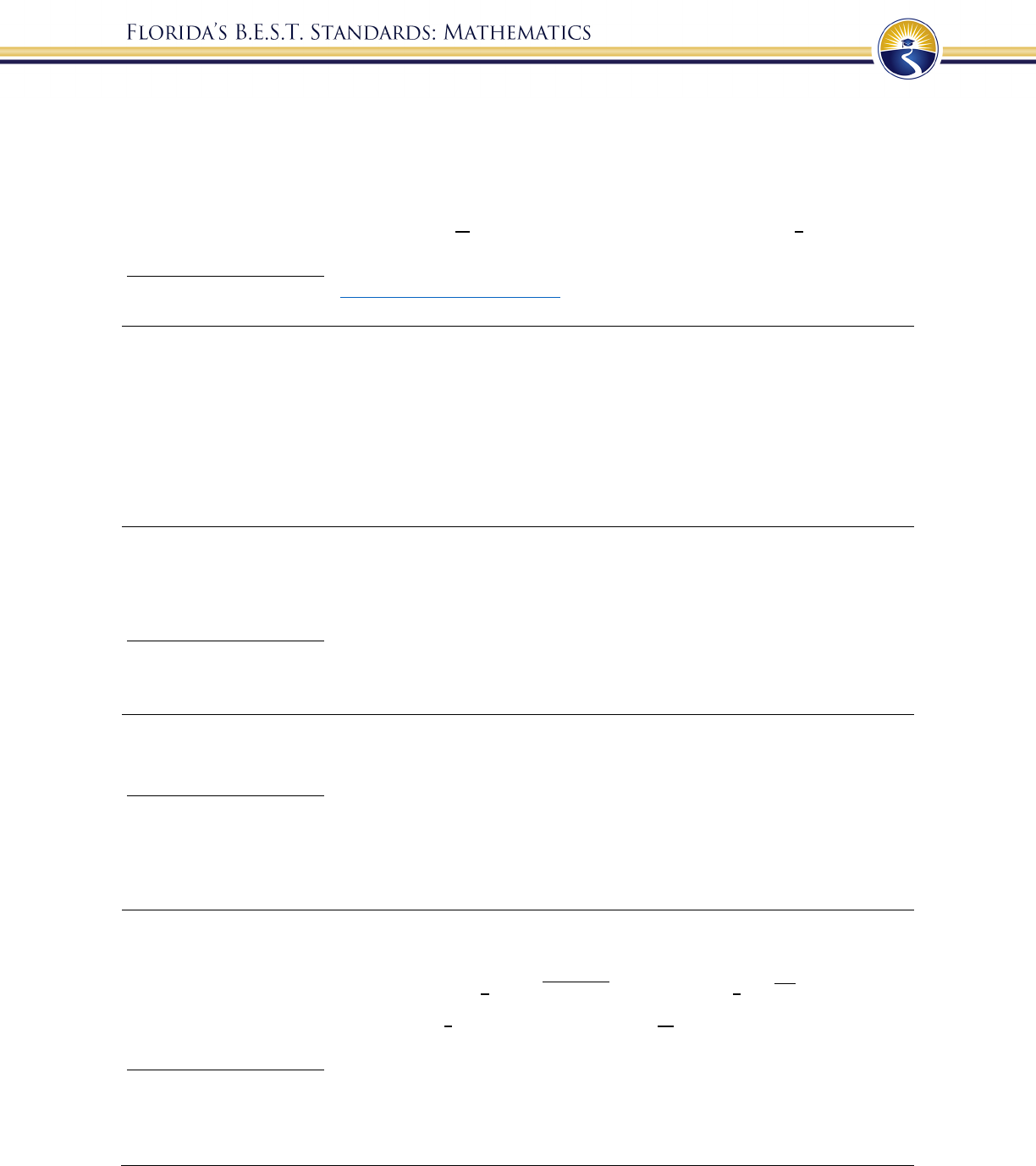
88
MA.8.NSO.1.3
Extend previous understanding of the Laws of Exponents to include integer
exponents. Apply the Laws of Exponents to evaluate numerical expressions
and generate equivalent numerical expressions, limited to integer exponents
and rational number bases, with procedural fluency.
Example: The expression
is equivalent to 2
which is equivalent to
.
Benchmark Clarifications:
Clarification 1: Refer to the K-12 Formulas (Appendix E) for the Laws of Exponents.
MA.8.NSO.1.4
Express numbers in scientific notation to represent and approximate very large
or very small quantities. Determine how many times larger or smaller one
number is compared to a second number.
Example: Roderick is comparing two numbers shown in scientific notation on his
calculator. The first number was displayed as 2.3147E27 and the second
number was displayed as 3.5982E 5. Roderick determines that the first
number is about 10
times bigger than the second number.
MA.8.NSO.1.5
Add, subtract, multiply and divide numbers expressed in scientific notation
with procedural fluency.
Example: The sum of 2.31 × 10
and 9.1 × 10
is 2.401 × 10
.
Benchmark Clarifications:
Clarification 1: Within this benchmark, for addition and subtraction with numbers expressed in
scientific notation, exponents are limited to within 2 of each other.
MA.8.NSO.1.6
Solve real-world problems involving operations with numbers expressed in
scientific notation.
Benchmark Clarifications:
Clarification 1: Instruction includes recognizing the importance of significant digits when physical
measurements are involved.
Clarification 2: Within this benchmark, for addition and subtraction with numbers expressed in
scientific notation, exponents are limited to within 2 of each other.
MA.8.NSO.1.7
Solve multi-step mathematical and real-world problems involving the order of
operations with rational numbers including exponents and radicals.
Example: The expression
+
(
2
+ 8
)
is equivalent to
+
16 which is
equivalent to
+ 4 which is equivalent to
.
Benchmark Clarifications:
Clarification 1: Multi-step expressions are limited to 6 or fewer steps.
Clarification 2: Within this benchmark, the expectation is to simplify radicals by factoring square roots
of perfect squares up to 225 and cube roots of perfect cubes from -125 to 125.
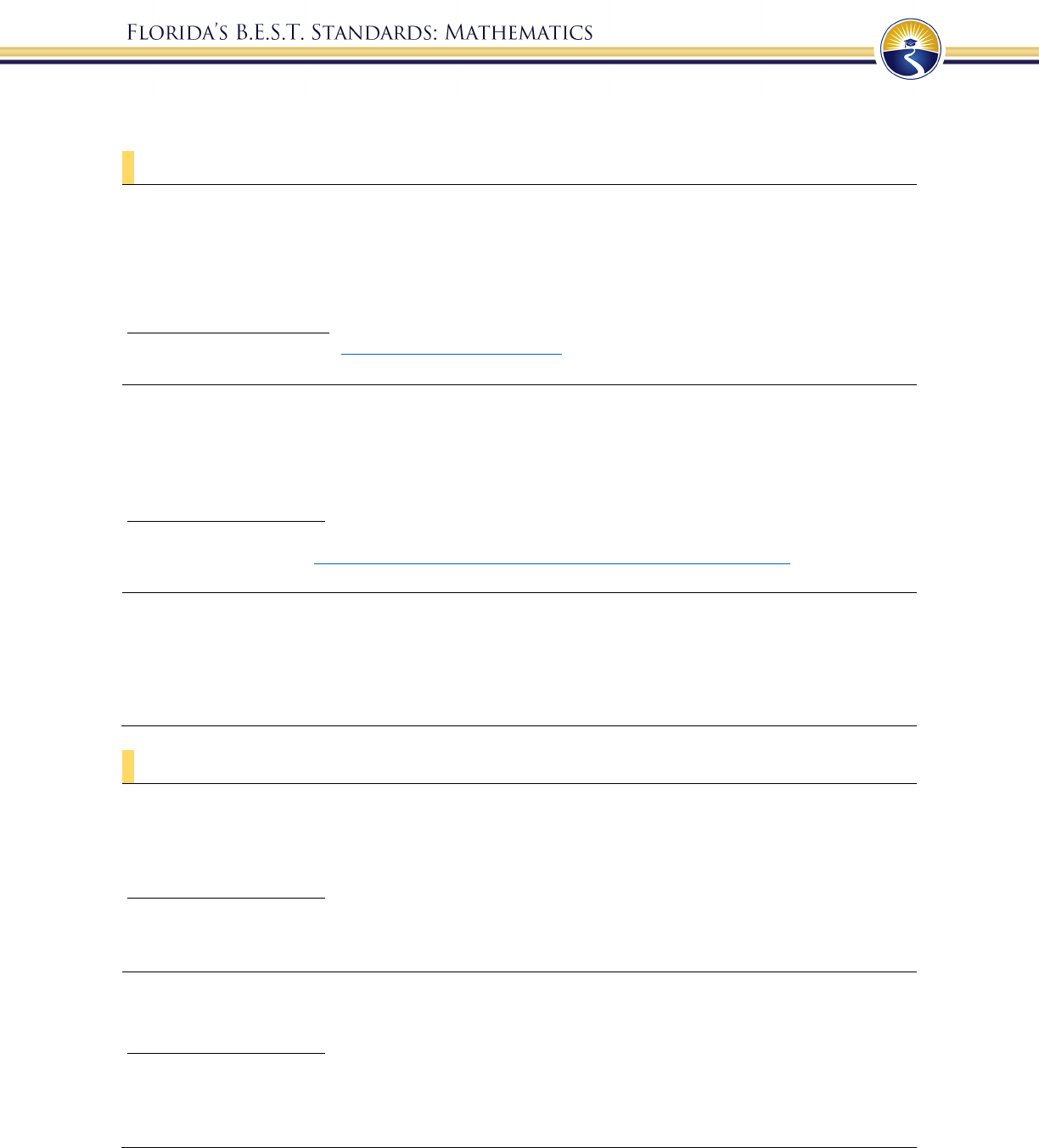
89
Algebraic Reasoning
MA.8.AR.1 Generate equivalent algebraic expressions.
MA.8.AR.1.1
Apply the Laws of Exponents to generate equivalent algebraic expressions,
limited to integer exponents and monomial bases.
Example: The expression
(
3
)
is equivalent to 27
.
Benchmark Clarifications:
Clarification 1: Refer to the K-12 Formulas (Appendix E) for the Laws of Exponents.
MA.8.AR.1.2
Apply properties of operations to multiply two linear expressions with rational
coefficients.
Example: The product of (1.1 + ) and (2.3) can be expressed as 2.532.3
or 2.3
2.53.
Benchmark Clarifications:
Clarification 1: Problems are limited to products where at least one of the factors is a monomial.
Clarification 2: Refer to Properties of Operations, Equality and Inequality (Appendix D)
.
MA.8.AR.1.3
Rewrite the sum of two algebraic expressions having a common monomial factor
as a common factor multiplied by the sum of two algebraic expressions.
Example: The expression 9911
can be rewritten as 11(9
) or as
11
(
9 +
)
.
MA.8.AR.2 Solve multi-step one-variable equations and inequalities.
MA.8.AR.2.1
Solve multi-step linear equations in one variable, with rational number
coefficients. Include equations with variables on both sides.
Benchmark Clarifications:
Clarification 1: Problem types include examples of one-variable linear equations that generate one
solution, infinitely many solutions or no solution.
MA.8.AR.2.2
Solve two-step linear inequalities in one variable and represent solutions
algebraically and graphically.
Benchmark Clarifications:
Clarification 1: Instruction includes inequalities in the forms ± > and
(
±
)
> , where ,
and are specific rational numbers and where any inequality symbol can be represented.
Clarification 2: Problems include inequalities where the variable may be on either side of the inequality.

90
MA.8.AR.2.3
Given an equation in the form of
= and
= , where is a whole
number and is an integer, determine the real solutions.
Benchmark Clarifications:
Clarification 1: Instruction focuses on understanding that when solving
= , there is both a positive
and negative solution.
Clarification 2: Within this benchmark, the expectation is to calculate square roots of perfect squares up
to 225 and cube roots of perfect cubes from -125 to 125.
MA.8.AR.3 Extend understanding of proportional relationships to two-variable linear
equations.
MA.8.AR.3.1
Determine if a linear relationship is also a proportional relationship.
Benchmark Clarifications:
Clarification 1: Instruction focuses on the understanding that proportional relationships are linear
relationships whose graph passes through the origin.
Clarification 2: Instruction includes the representation of relationships using tables, graphs, equations
and written descriptions.
MA.8.AR.3.2
Given a table, graph or written description of a linear relationship, determine the
slope.
Benchmark Clarifications:
Clarification 1: Problem types include cases where two points are given to determine the slope.
Clarification 2: Instruction includes making connections of slope to the constant of proportionality and
to similar triangles represented on the coordinate plane.
MA.8.AR.3.3
Given a table, graph or written description of a linear relationship, write an
equation in slope-intercept form.
MA.8.AR.3.4
Given a mathematical or real-world context, graph a two-variable linear equation
from a written description, a table or an equation in slope-intercept form.
MA.8.AR.3.5
Given a real-world context, determine and interpret the slope and -intercept of
a two-variable linear equation from a written description, a table, a graph or an
equation in slope-intercept form.
Example: Raul bought a palm tree to plant at his house. He records the growth over
many months and creates the equation = 0.21+ 4.9, where is the
height of the palm tree in feet and is the number of months. Interpret the
slope and y-intercept from his equation.
Benchmark Clarifications:
Clarification 1: Problems include conversions with temperature and equations of lines of fit in scatter
plots.
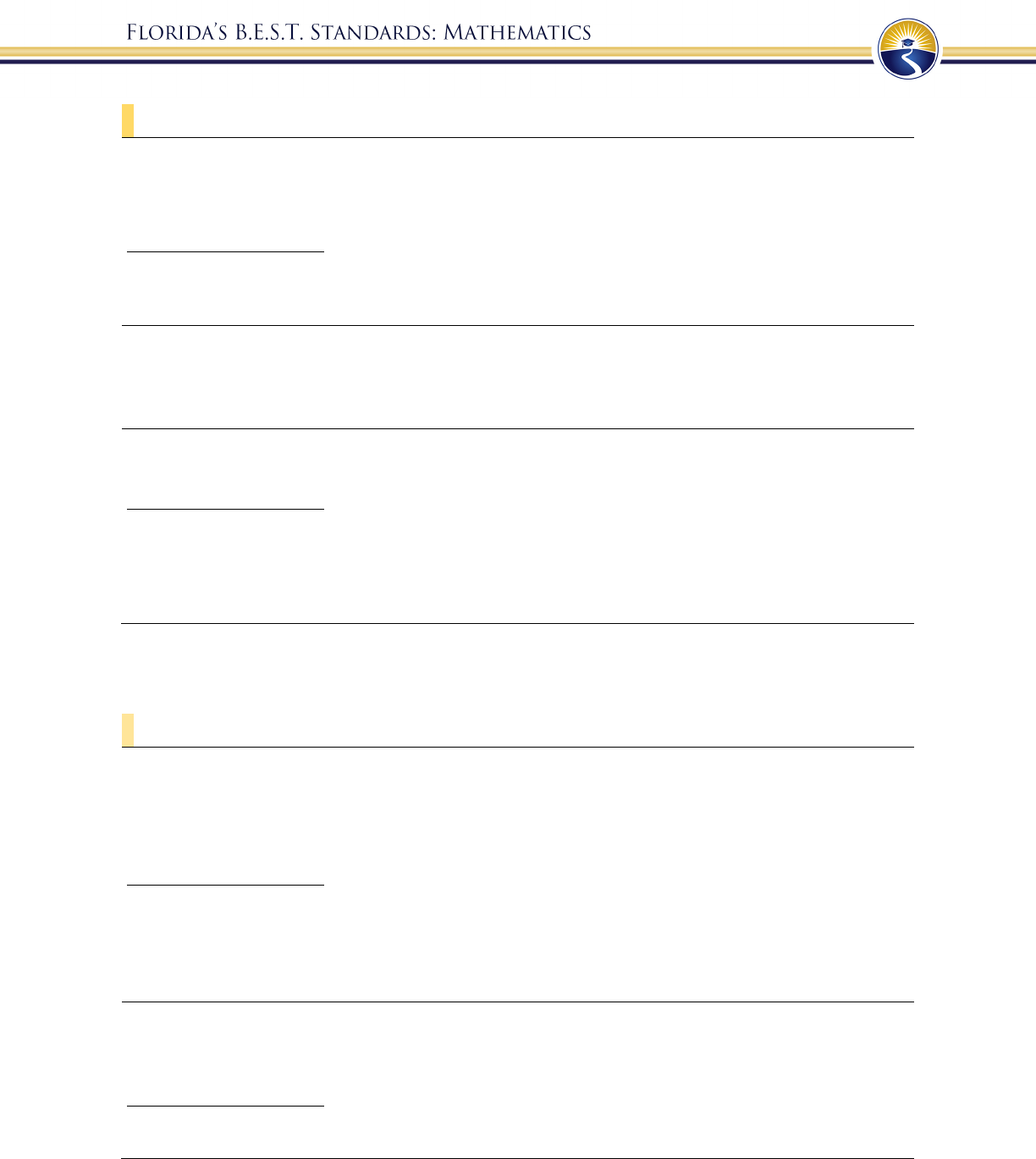
91
MA.8.AR.4 Develop an understanding of two-variable systems of equations.
MA.8.AR.4.1
Given a system of two linear equations and a specified set of possible solutions,
determine which ordered pairs satisfy the system of linear equations.
Benchmark Clarifications:
Clarification 1: Instruction focuses on the understanding that a solution to a system of equations
satisfies both linear equations simultaneously.
MA.8.AR.4.2
Given a system of two linear equations represented graphically on the same
coordinate plane, determine whether there is one solution, no solution or
infinitely many solutions.
MA.8.AR.4.3
Given a mathematical or real-world context, solve systems of two linear
equations by graphing.
Benchmark Clarifications:
Clarification 1: Instruction includes approximating non-integer solutions.
Clarification 2: Within this benchmark, it is the expectation to represent systems of linear equations in
slope-intercept form only.
Clarification 3: Instruction includes recognizing that parallel lines have the same slope.
Functions
MA.8.F.1 Define, evaluate and compare functions.
MA.8.F.1.1
Given a set of ordered pairs, a table, a graph or mapping diagram, determine
whether the relationship is a function. Identify the domain and range of the
relation.
Benchmark Clarifications:
Clarification 1: Instruction includes referring to the input as the independent variable and the output as
the dependent variable.
Clarification 2: Within this benchmark, it is the expectation to represent domain and range as a list of
numbers or as an inequality.
MA.8.F.1.2
Given a function defined by a graph or an equation, determine whether the
function is a linear function. Given an input-output table, determine whether it
could represent a linear function.
Benchmark Clarifications:
Clarification 1: Instruction includes recognizing that a table may not determine a function.

92
MA.8.F.1.3
Analyze a real-world written description or graphical representation of a
functional relationship between two quantities and identify where the function is
increasing, decreasing or constant.
Benchmark Clarifications:
Clarification 1: Problem types are limited to continuous functions.
Clarification 2: Analysis includes writing a description of a graphical representation or sketching a
graph from a written description.
Geometric Reasoning
MA.8.GR.1 Develop an understanding of the Pythagorean Theorem and angle relationships
involving triangles.
MA.8.GR.1.1
Apply the Pythagorean Theorem to solve mathematical and real-world problems
involving unknown side lengths in right triangles.
Benchmark Clarifications:
Clarification 1: Instruction includes exploring right triangles with natural-number side lengths to
illustrate the Pythagorean Theorem.
Clarification 2: Within this benchmark, the expectation is to memorize the Pythagorean Theorem.
Clarification 3: Radicands are limited to whole numbers up to 225.
MA.8.GR.1.2
Apply the Pythagorean Theorem to solve mathematical and real-world problems
involving the distance between two points in a coordinate plane.
Example: The distance between (2, 7) and (0, 6) can be found by creating a right
triangle with the vertex of the right angle at the point (2, 6). This gives a
height of the right triangle as 1 unit and a base of 2 units. Then using the
Pythagorean Theorem the distance can be determined from the equation 1
+
2
=
, which is equivalent to 5 =
. So, the distance is
5 units.
Benchmark Clarifications:
Clarification 1: Instruction includes making connections between distance on the coordinate plane and
right triangles.
Clarification 2: Within this benchmark, the expectation is to memorize the Pythagorean Theorem. It is
not the expectation to use the distance formula.
Clarification 3: Radicands are limited to whole numbers up to 225.
MA.8.GR.1.3
Use the Triangle Inequality Theorem to determine if a triangle can be formed
from a given set of sides. Use the converse of the Pythagorean Theorem to
determine if a right triangle can be formed from a given set of sides.
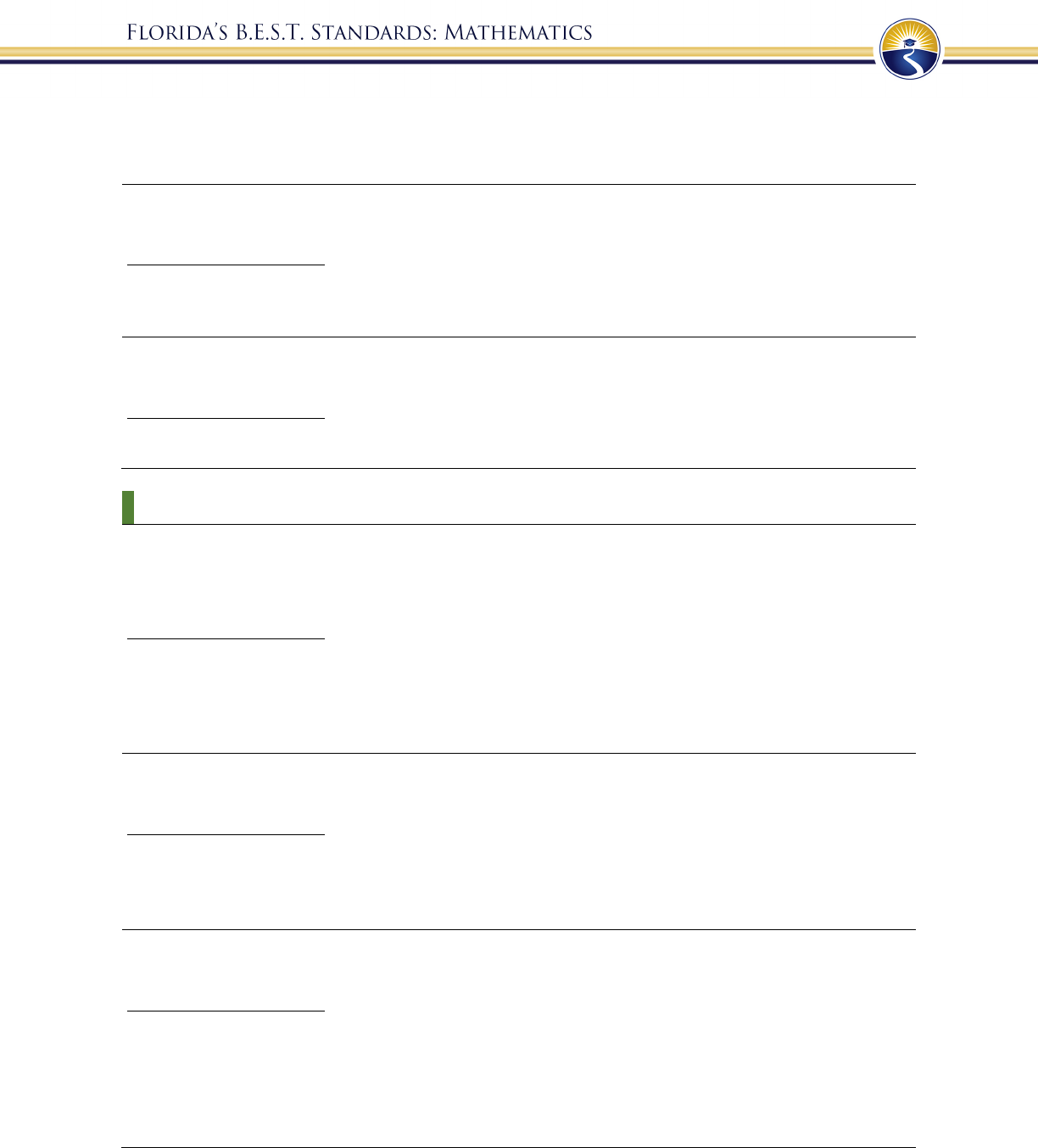
93
MA.8.GR.1.4
Solve mathematical problems involving the relationships between
supplementary, complementary, vertical or adjacent angles.
MA.8.GR.1.5
Solve problems involving the relationships of interior and exterior angles of a
triangle.
Benchmark Clarifications:
Clarification 1: Problems include using the Triangle Sum Theorem and representing angle measures as
algebraic expressions.
MA.8.GR.1.6
Develop and use formulas for the sums of the interior angles of regular polygons
by decomposing them into triangles.
Benchmark Clarifications:
Clarification 1: Problems include representing angle measures as algebraic expressions.
MA.8.GR.2 Understand similarity and congruence using models and transformations.
MA.8.GR.2.1
Given a preimage and image generated by a single transformation, identify the
transformation that describes the relationship.
Benchmark Clarifications:
Clarification 1: Within this benchmark, transformations are limited to reflections, translations or
rotations of images.
Clarification 2: Instruction focuses on the preservation of congruence so that a figure maps onto a copy
of itself.
MA.8.GR.2.2
Given a preimage and image generated by a single dilation, identify the scale
factor that describes the relationship.
Benchmark Clarifications:
Clarification 1: Instruction includes the connection to scale drawings and proportions.
Clarification 2: Instruction focuses on the preservation of similarity and the lack of preservation of
congruence when a figure maps onto a scaled copy of itself, unless the scaling factor is 1.
MA.8.GR.2.3
Describe and apply the effect of a single transformation on two-dimensional
figures using coordinates and the coordinate plane.
Benchmark Clarifications:
Clarification 1: Within this benchmark, transformations are limited to reflections, translations, rotations
or dilations of images.
Clarification 2: Lines of reflection are limited to the -axis, -axis or lines parallel to the axes.
Clarification 3: Rotations must be about the origin and are limited to 90°, 180°, 270° or 360°.
Clarification 4: Dilations must be centered at the origin.

94
MA.8.GR.2.4
Solve mathematical and real-world problems involving proportional relationships
between similar triangles.
Example: During a Tampa Bay Lightning game one player, Johnson, passes the puck to
his teammate, Stamkos, by bouncing the puck off the wall of the rink. The path
of the puck creates two line segments that form hypotenuses for each of two
similar right triangles, wi
th the height of each triangle the distance from one of
the players to the wall of the rink. If Johnson is 12 feet from the wall and
Stamkos is 3 feet from the wall. How far did the puck travel from the wall of
the rink to Stamkos if the distance traveled from Johnson to the wall was 16
feet?
Data Analysis and Probability
MA.8.DP.1 Represent and investigate numerical bivariate data.
MA.8.DP.1.1
Given a set of real-world bivariate numerical data, construct a scatter plot or a
line graph as appropriate for the context.
Example: Jaylyn is collecting data about the relationship between grades in English and
grades in mathematics. He represents the data using a scatter plot because he is
interested if there is an association between the two variables without thinking
of either one as an independent or dependent variable.
Example: Samantha is collecting data on her weekly quiz grade in her social studies
class. She represents the data using a line graph with time as the independent
variable.
Benchmark Clarifications:
Clarification 1: Instruction includes recognizing similarities and differences between scatter plots and
line graphs, and on determining which is more appropriate as a representation of the data based on the
context.
Clarification 2: Sets of data are limited to 20 points.
MA.8.DP.1.2
Given a scatter plot within a real-world context, describe patterns of association.
Benchmark Clarifications:
Clarification 1: Descriptions include outliers; positive or negative association; linear or nonlinear
association; strong or weak association.
MA.8.DP.1.3
Given a scatter plot with a linear association, informally fit a straight line.
Benchmark Clarifications:
Clarification 1: Instruction focuses on the connection to linear functions.
Clarification 2: Instruction includes using a variety of tools, including a ruler, to draw a line with
approximately the same number of points above and below the line.
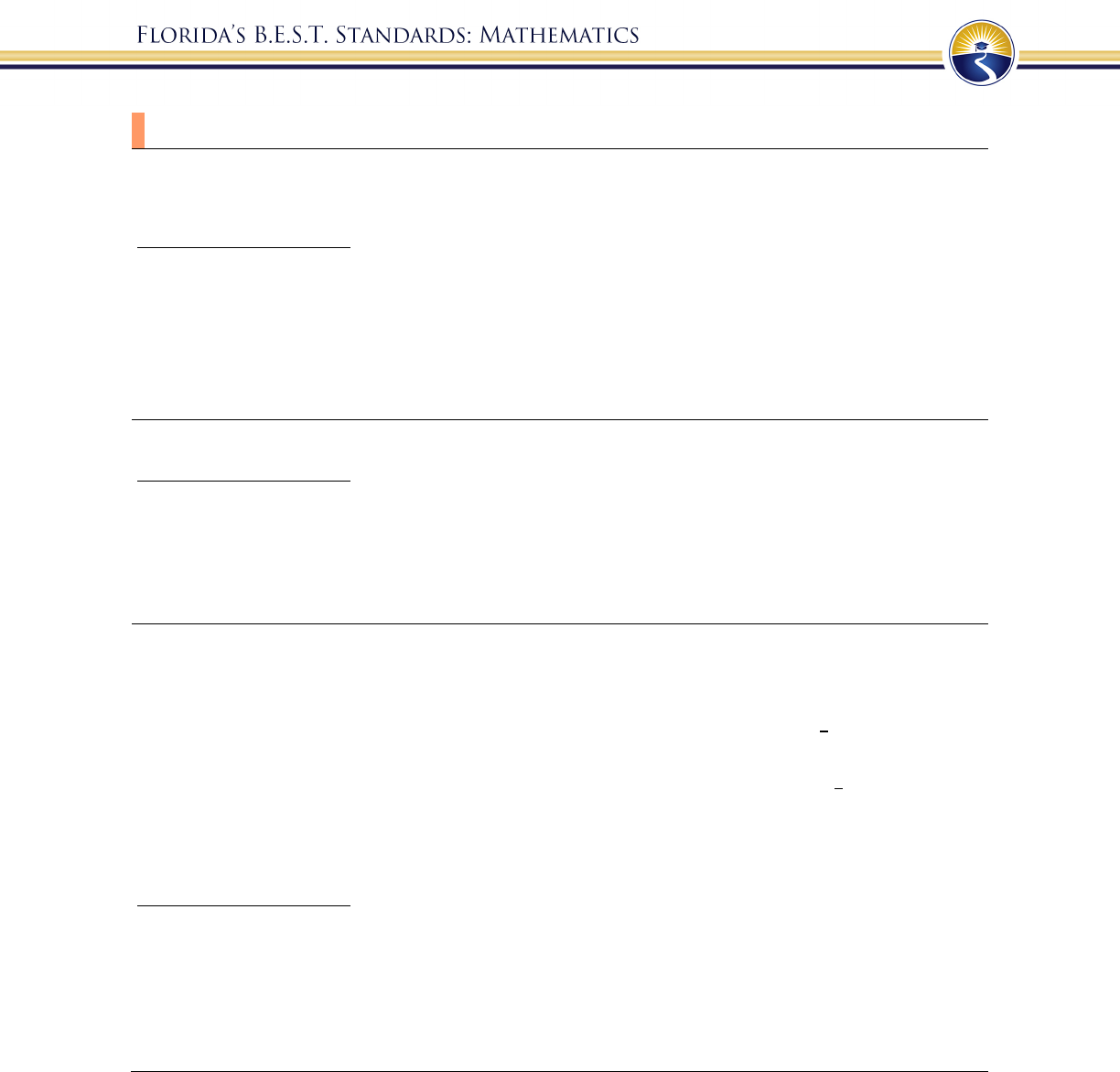
95
MA.8.DP.2 Represent and find probabilities of repeated experiments.
MA.8.DP.2.1
Determine the sample space for a repeated experiment.
Benchmark Clarifications:
Clarification 1: Instruction includes recording sample spaces for repeated experiments using organized
lists, tables or tree diagrams.
Clarification 2: Experiments to be repeated are limited to tossing a fair coin, rolling a fair die, picking a
card randomly from a deck with replacement, picking marbles randomly from a bag with replacement
and spinning a fair spinner.
Clarification 3: Repetition of experiments is limited to two times except for tossing a coin.
MA.8.DP.2.2
Find the theoretical probability of an event related to a repeated experiment.
Benchmark Clarifications:
Clarification 1: Instruction includes representing probability as a fraction, percentage or decimal.
Clarification 2: Experiments to be repeated are limited to tossing a fair coin, rolling a fair die, picking a
card randomly from a deck with replacement, picking marbles randomly from a bag with replacement
and spinning a fair spinner.
Clarification 3: Repetition of experiments is limited to two times except for tossing a coin.
MA.8.DP.2.3
Solve real-world problems involving probabilities related to single or repeated
experiments, including making predictions based on theoretical probability.
Example: If Gabriella rolls a fair die 300 times, she can predict that she will roll a 3
approximately 50 times since the theoretical probability is
.
Example: Sandra performs an experiment where she flips a coin three times. She finds
the theoretical probability of landing on exactly one head as
. If she performs
this experiment 50 times (for a total of 150 flips), predict the number of
repetitions of the experiment that will result in exactly one of the three flips
landing on heads.
Benchmark Clarifications:
Clarification 1: Instruction includes making connections to proportional relationships and representing
probability as a fraction, percentage or decimal.
Clarification 2: Experiments to be repeated are limited to tossing a fair coin, rolling a fair die, picking a
card randomly from a deck with replacement, picking marbles randomly from a bag with replacement
and spinning a fair spinner.
Clarification 3: Repetition of experiments is limited to two times except for tossing a coin.

96
Mathematics 9-12 Courses:
Algebra 1 and Geometry

97
9-12 Course Overview
This section consists of courses developed from Florida’s B.E.S.T. Standards for
Mathematics 9-12. In the state of Florida, high school students are expected to earn credits in
Algebra 1, Geometry and two additional mathematics courses for a high school diploma per
Section 1003.4282, Florida Statutes (F.S.). With the development of Florida’s B.E.S.T.
Standards for Mathematics 9-12, the courses Algebra 1 and Geometry were developed based on
the importance of high school graduation requirements. Since these courses were developed from
a greater set of 9-12 standards and benchmarks, benchmark numbering in these courses may not
be consistent or in numerical order as is the case in Kindergarten to grade eight.
Algebra I
In Algebra 1, instructional time will emphasize five areas:
(1) performing operations with polynomials and radicals, and extending the Laws of
Exponents to include rational exponents;
(2) extending understanding of functions to linear, quadratic and exponential functions
and using them to model and analyze real-world relationships;
(3) solving quadratic equations in one variable and systems of linear equations and
inequalities in two variables;
(4) building functions, identifying their key features and representing them in various
ways and
(5) representing and interpreting categorical and numerical data with one and two
variables.
All clarifications stated, whether general or specific to Algebra I, are expectations for
instruction of that benchmark.
Number Sense and Operations
MA.912.NSO.1.1
Extend previous understanding of the Laws of Exponents to include rational
exponents. Apply the Laws of Exponents to evaluate numerical expressions
and generate equivalent numerical expressions involving rational exponents.
Benchmark Clarifications:
Clarification 1: Instruction includes the use of technology when appropriate.
Clarification 2: Refer to the K-12 Formulas (Appendix E)
for the Laws of Exponents.
MA.912.NSO.1.2
Generate equivalent monomial algebraic expressions using the properties of
exponents.

98
MA.912.NSO.1.4
Apply previous understanding of operations with rational numbers to add,
subtract, multiply and divide numerical radicals.
Algebra 1 Example: The expression
is equivalent to
which is equivalent
to
68 which is equivalent to 2
17.
Benchmark Clarifications:
Clarification 1: Within the Algebra 1 course, expressions are limited to a single arithmetic operation
involving two square roots or two cube roots.
Algebraic Reasoning
MA.912.AR.1.1
Identify and interpret parts of an expression that represent a quantity in terms
of a mathematical or real-world context, including viewing one or more of its
parts as a single entity.
Algebra 1 Example: Derrick is using the formula = 1000
(
1 + .1
)
to make a
prediction about the
camel population in Australia. He identifies
the growth factor as
(
1 + .1
)
, or 1.1, and states that the camel
population will grow at an annual rate of 10% per year.
Benchmark Clarifications:
Clarification 1: Parts of an expression include factors, terms, constants, coefficients and variables.
MA.912.AR.1.2
Rearrange equations or formulas to isolate a quantity of interest.
Algebra 1 Example: The Ideal Gas Law = can be rearranged as =
to
isolate temperature as the quantity of interest.
Benchmark Clarifications:
Clarification 1: Instruction includes using formulas for temperature, perimeter, area and volume; using
equations for linear (standard, slope-intercept and point-slope forms) and quadratic (standard, factored
and vertex forms) functions.
MA.912.AR.1.3
Add, subtract and multiply polynomial expressions with rational number
coefficients.
Benchmark Clarifications:
Clarification 1: Instruction includes an understanding that when any of these operations are performed
with polynomials the result is also a polynomial.
Clarification 2: Within the Algebra 1 course, polynomial expressions are limited to 3 or fewer terms
with integer coefficients.

99
MA.912.AR.1.4
Divide a polynomial expression by a monomial expression with rational
number coefficients.
Benchmark Clarifications:
Clarification 1: Within the Algebra 1 course, polynomial expressions are limited to 3 or fewer terms
with integer coefficients.
MA.912.AR.1.7
Rewrite a polynomial expression as a product of polynomials.
Example: The expression 4
3
is equivalent to the factored form
(
43
)
.
Example: The expression 16
9
is equivalent to the factored form
(43)(4+ 3).
Benchmark Clarifications:
Clarification 1: Within the Algebra 1 course, polynomial expressions are limited to 4 or fewer terms
with integer coefficients.
MA.912.AR.2.1
Given a real-world context, write and solve one-variable multi-step linear
equations.
MA.912.AR.2.2
Write a linear two-variable equation to represent relationships between
quantities from a graph, a written description or a table of values within a
mathematical or real-world context.
Benchmark Clarifications:
Clarification 1: Instruction includes the use of standard form, slope-intercept form and point-slope form,
and the conversion between these forms.
MA.912.AR.2.3
Write a linear two-variable equation for a line that is parallel or perpendicular
to a given line and goes through a given point.
Benchmark Clarifications:
Clarification 1: Instruction focuses on recognizing that perpendicular lines have slopes that when
multiplied result in 1 and that parallel lines have slopes that are the same.
Clarification 2: Instruction includes representing a line with a pair of points on the coordinate plane or
with an equation.
Clarification 3: Problems include cases where one variable has a coefficient of zero.
MA.912.AR.2.4
Given a table, equation or written description of a linear function, graph that
function, and determine and interpret its key features.
Benchmark Clarifications:
Clarification 1: Key features are limited to domain, range, intercepts and rate of change.
Clarification 2: Instruction includes the use of standard form, slope-intercept form and point-slope form.
Clarification 3: Instruction includes cases where one variable has a coefficient of zero.

100
MA.912.AR.2.5
Solve and graph mathematical and real-world problems that are modeled with
linear functions. Interpret key features and determine domain constraints in
terms of the context.
Algebra 1 Example: Lizzy’s mother uses the function () = 450 + 7.75, where
() represents the total cost of a rental space and is the
number of people attending, to help budget Lizzy’s 16
th
birthday
party. Lizzy’s mom wants to spend no more than $850 for the
party. Graph the function in terms of the context.
Benchmark Clarifications:
Clarification 1: Key features are limited to domain, range, intercepts and rate of change.
Clarification 2: Instruction includes the use of standard form, slope-intercept form and point-slope form.
Clarification 3: Instruction includes representing constraints with inequalities or set-builder notation.
MA.912.AR.2.6
Given a mathematical or real-world context, write and solve one-variable
linear inequalities, including compound inequalities. Represent solutions
algebraically or graphically.
Algebra 1 Example: The compound inequality 2 5 + 1 < 4 is equivalent
to 1 3 and 5 < 3, which is equivalent to
<
. The solution set is [
,
).
MA.912.AR.2.7
Write two-variable linear inequalities to represent relationships between
quantities from a graph or a written description within a mathematical or real-
world context.
Benchmark Clarifications:
Clarification 1: Instruction includes the use of standard form, slope-intercept form and point-slope form
and any inequality symbol can be represented.
Clarification 2: Instruction includes cases where one variable has a coefficient of zero.
MA.912.AR.2.8
Given a mathematical or real-world context, graph the solution set to a two-
variable linear inequality.
Benchmark Clarifications:
Clarification 1: Instruction includes the use of standard form, slope-intercept form and point-slope form
and any inequality symbol can be represented.
Clarification 2: Instruction includes cases where one variable has a coefficient of zero.
MA.912.AR.3.1
Given a mathematical or real-world context, write and solve one-variable
quadratic equations over the real number system.
Benchmark Clarifications:
Clarification 1: Within the Algebra 1 course, instruction includes the concept of non-real answers,
without determining non-real solutions.
Clarification 2: Within this benchmark, the expectation is to solve by factoring techniques, taking
square roots, the quadratic formula and completing the square.

101
MA.912.AR.3.4
Write a quadratic function to represent the relationship between two quantities
from a graph, a written description or a table of values within a mathematical
or real-world context.
Algebra I Example: Given the table of values below from a quadratic function, write
an equation of that function.
-2
-1
0
1
2
()
2
-1
-2
-1
2
Benchmark Clarifications:
Clarification 1: Within the Algebra 1 course, a graph, written description or table of values must include
the vertex and two points that are equidistant from the vertex.
Clarification 2: Instruction includes the use of standard form and vertex form.
MA.912.AR.3.5
Given the -intercepts and another point on the graph of a quadratic function,
write the equation for the function.
MA.912.AR.3.6
Given an expression or equation representing a quadratic function, determine
the vertex and zeros and interpret them in terms of a real-world context.
MA.912.AR.3.7
Given a table, equation or written description of a quadratic function, graph
that function, and determine and interpret its key features.
Benchmark Clarifications:
Clarification 1: Key features are limited to domain; range; intercepts; intervals where the function is
increasing, decreasing, positive or negative; end behavior; vertex; and symmetry.
Clarification 2: Instruction includes the use of standard form and vertex form, and sketching a graph
using the zeros and vertex.
Clarification 3: Instruction includes representing the domain and range with inequality notation, interval
notation or set-builder notation.
Clarification 4: Within the Algebra 1 course, notations for domain and range are limited to inequality
and set-builder.

102
MA.912.AR.3.8
Solve and graph mathematical and real-world problems that are modeled with
quadratic functions. Interpret key features
and determine domain constraints in
terms of the context.
Algebra 1 Example: The value of a classic car produced in 1972 can be modeled by
the function
(
)
= 19.25
440+ 3500, where is the
number of years since 1972. In what year does the car’s value
start to increase?
Benchmark Clarifications:
Clarification 1: Key features are limited to domain; range; intercepts; intervals where the function is
increasing, decreasing, positive or negative; end behavior; vertex; and symmetry.
Clarification 2: Instruction includes the use of standard form and vertex form.
Clarification 3: Instruction includes representing constraints with inequalities or set-builder notation.
Clarification 4: Within the Algebra 1 course, notations for domain and range are limited to inequality
and set-builder.
MA.912.AR.5.3
Given a mathematical or real-world context, classify an exponential function as
representing growth or decay.
Benchmark Clarifications:
Clarification 1: Within the Algebra 1 course, exponential functions are limited to the forms
(
)
=
, where is a whole number greater than 1 or a unit fraction, or
(
)
= (1 ± )
, where
0 < < 1.
MA.912.AR.5.4
Write an exponential function to represent a relationship between two
quantities from a graph, a written description or a table of values within a
mathematical or real-world context.
Benchmark Clarifications:
Clarification 1: Within the Algebra 1 course, exponential functions are limited to the forms
(
)
=
, where is a whole number greater than 1 or a unit fraction, or
(
)
= (1 ± )
, where
0 < < 1.
Clarification 2: Within the Algebra 1 course, tables are limited to having successive nonnegative integer
inputs so that the function may be determined by finding ratios between successive outputs.
MA.912.AR.5.6
Given a table, equation or written description of an exponential function, graph
that function and determine its key features.
Benchmark Clarifications:
Clarification 1: Key features are limited to domain; range; intercepts; intervals where the function is
increasing, decreasing, positive or negative; constant percent rate of change; end behavior and
asymptotes.
Clarification 2: Instruction includes representing the domain and range with inequality notation, interval
notation or set-builder notation.
Clarification 3: Within the Algebra 1 course, notations for domain and range are limited to inequality
and set-builder.
Clarification 4: Within the Algebra 1 course, exponential functions are limited to the forms
(
)
=
, where is a whole number greater than 1 or a unit fraction or
(
)
= (1 ± )
, where
0 < < 1.

103
MA.912.AR.9.1
Given a mathematical or real-world context, write and solve a system of two-
variable linear equations algebraically or graphically.
Benchmark Clarifications:
Clarification 1: Within this benchmark, the expectation is to solve systems using elimination,
substitution and graphing.
Clarification 2: Within the Algebra 1 course, the system is limited to two equations.
MA.912.AR.9.4
Graph the solution set of a system of two-variable linear inequalities.
Benchmark Clarifications:
Clarification 1: Instruction includes cases where one variable has a coefficient of zero.
Clarification 2: Within the Algebra 1 course, the system is limited to two inequalities.
MA.912.AR.9.5
Given a real-world context, represent constraints as systems of linear equations
or inequalities. Interpret solutions to problems as viable or non-viable options.
Benchmark Clarifications:
Clarification 1: Instruction focuses on analyzing a given function that models a real-world situation and
writing constraints that are represented as linear equations or linear inequalities.
Functions
MA.912.F.1.1
Given an equation or graph that defines a function, classify the function type.
Given an input-output table, determine a function type that could represent it.
Benchmark Clarifications:
Clarification 1: Within the Algebra 1 course, functions represented as tables are limited to linear,
quadratic and exponential.
Clarification 2: Within the Algebra 1 course, functions represented as equations or graphs are limited to
vertical or horizontal translations or reflections over the -axis of the following parent functions:
(
)
= ,
(
)
=
,
(
)
=
,
(
)
=
,
(
)
=
3
,
(
)
=
|
|
,
(
)
= 2
and
(
)
=
.
MA.912.F.1.2
Given a function represented in function notation, evaluate the function for an
input in its domain. For a real-world context, interpret the output.
Algebra 1 Example:
The function
(
)
=
8 models Alicia’s position in miles
relative to a water stand minutes into a marathon. Evaluate
and interpret for a quarter of an hour into the race.
MA.912.F.1.3
Calculate and interpret the average rate of change of a real-world situation
represented graphically, algebraically or in a table over a specified interval.
Benchmark Clarifications:
Clarification 1: Instruction includes making the connection to the slope of a linear function.
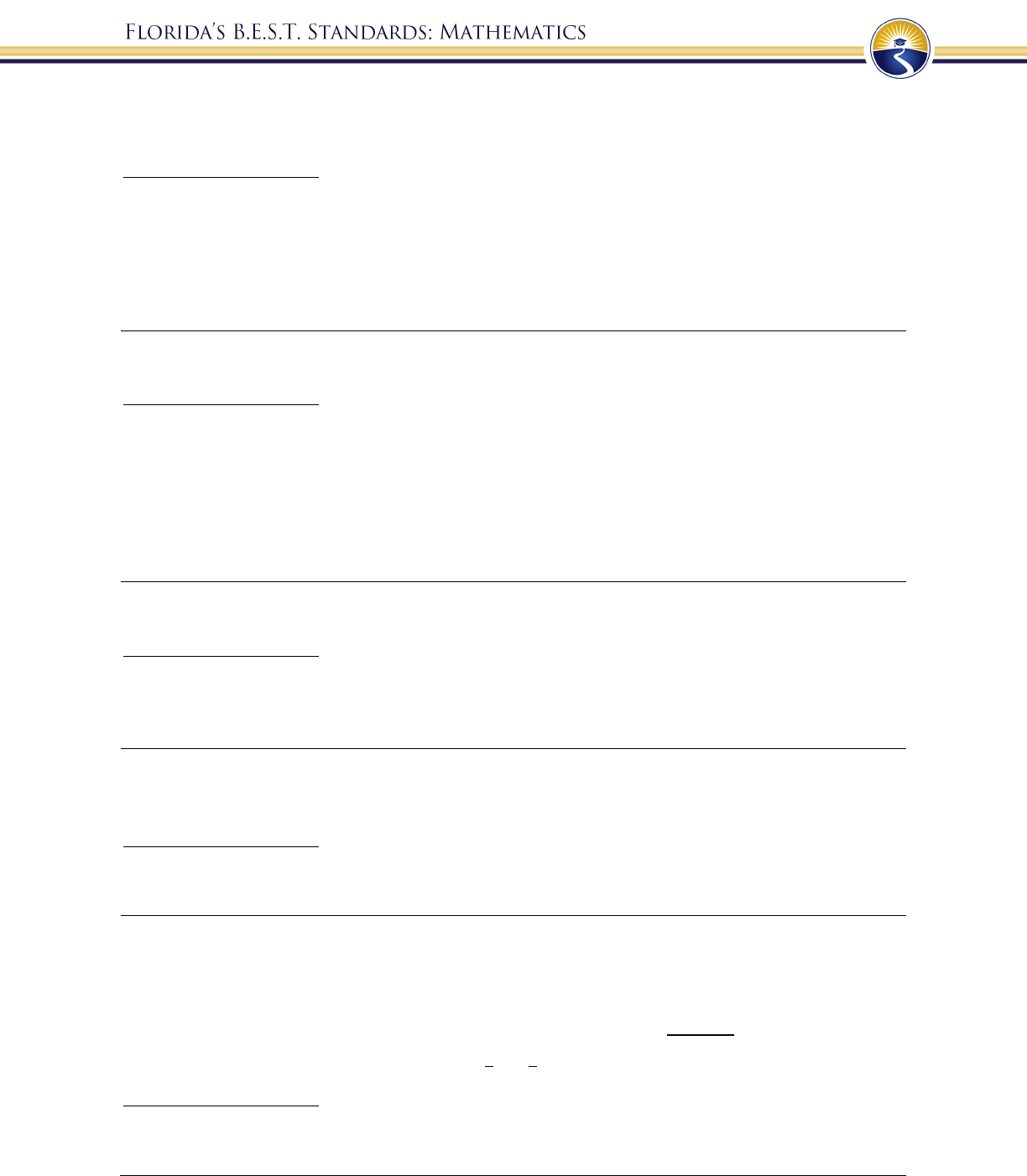
104
MA.912.F.1.5
Compare key features of linear and nonlinear functions each represented in the
same way, such as algebraically, graphically, in tables or written descriptions.
Benchmark Clarifications:
Clarification 1: Key features are limited to domain; range; intercepts; intervals where the function is
increasing, decreasing, positive or negative; end behavior and asymptotes.
Clarification 2: Within the Algebra 1 course, functions other than linear, quadratic or exponential must
be represented graphically.
Clarification 3: Within the Algebra 1 course, instruction includes verifying that a quantity increasing
exponentially eventually exceeds a quantity increasing linearly or quadratically.
MA.912.F.1.7
Determine whether a linear, quadratic or exponential function best models a
given real-world situation.
Benchmark Clarifications:
Clarification 1: Instruction includes recognizing that linear functions model situations in which a
quantity changes by a constant amount per unit interval; that quadratic functions model situations in
which a quantity increases to a maximum, then begins to decrease or a quantity decreases to a minimum,
then begins to increase; and that exponential functions model situations in which a quantity grows or
decays by a constant percent per unit interval.
Clarification 2: Within this benchmark, the expectation is to identify the type of function from a written
description or table.
MA.912.F.2.1
Identify the effect on the graph or table of a given function after replacing ()
by
(
)
+ , (), () and (+ ) for specific values of .
Benchmark Clarifications:
Clarification 1: Within the Algebra 1 course, functions are limited to linear, quadratic and absolute
value.
Clarification 2: Instruction focuses on including positive and negative values for .
MA.912.F.2.3
Given the graph or table of () and the graph or table of
(
)
+ , (),
() and (+ ), state the type of transformation and find the value of the
real number .
Benchmark Clarifications:
Clarification 1: Within the Algebra 1 course, functions are limited to linear, quadratic and absolute
value.
MA.912.F.3.1
Given a mathematical or real-world context, combine two functions, limited to
linear and quadratic, using arithmetic operations. When appropriate, include
domain restrictions for the new function.
Example: The quotient of the functions
(
)
= 3
7+ 3 and
(
)
= 61 can be expressed as
(
)
=
, where the domain of
(
)
is <
and
< .
Benchmark Clarifications:
Clarification 1: Instruction includes representing domain restrictions with inequality notation, interval
notation or set-builder notation.
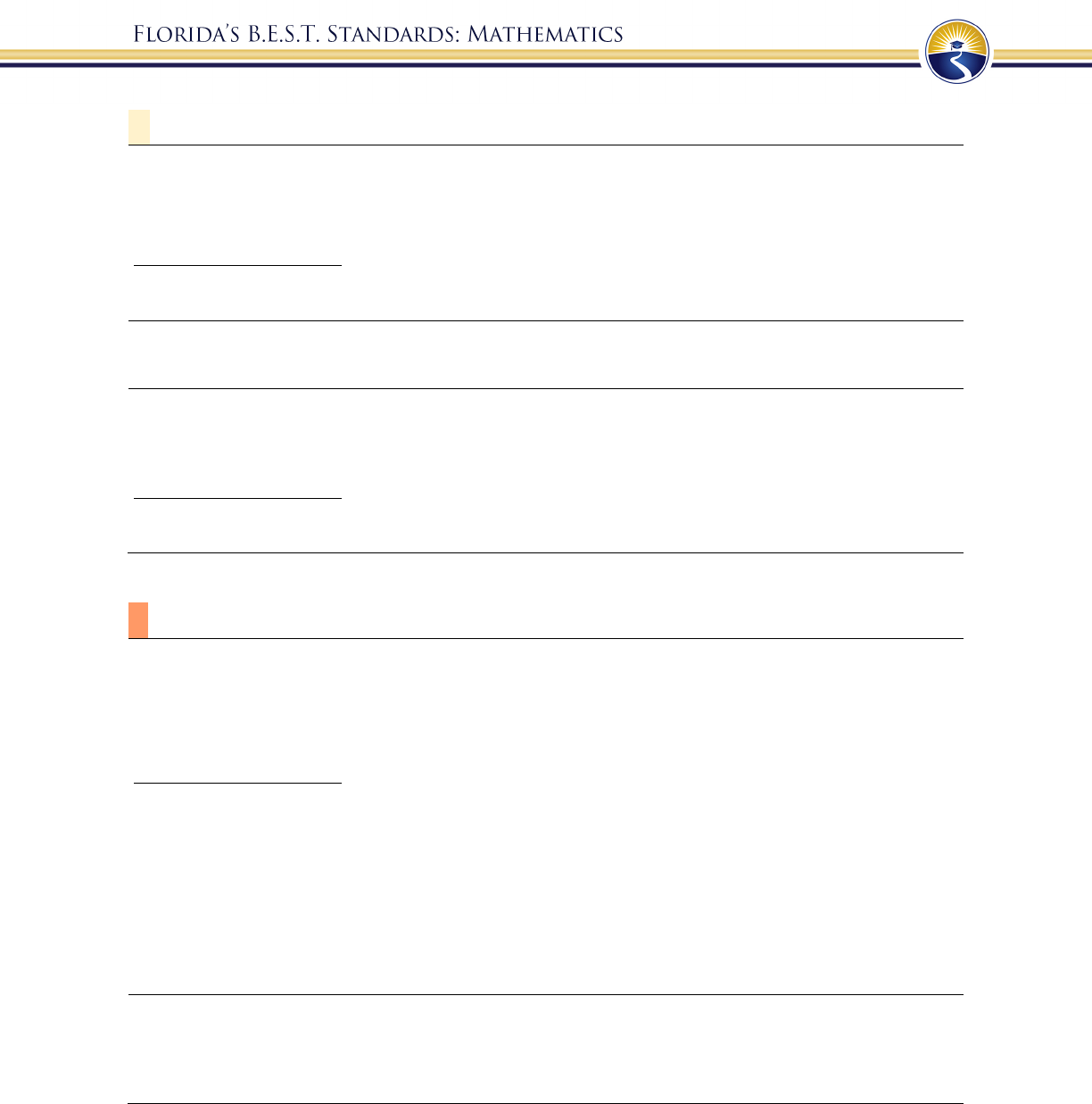
105
Financial Literacy
MA.912.FL.1.2
Solve problems involving simple, compound and continuously compounded
interest, including determining the present value and future value of money.
Benchmark Clarifications:
Clarification 1: Within the Algebra 1 course, interest is limited to simple and compound.
MA.912.FL.1.3
Explain the relationship between simple interest and linear growth.
MA.912.FL.1.4
Explain the relationship between compound interest and exponential growth
and the relationship between continuously compounded interest and
exponential growth.
Benchmark Clarifications:
Clarification 1: Within the Algebra 1 course, exponential growth is limited to compound interest.
Data Analysis and Probability
MA.912.DP.1.1
Given a set of data, select an appropriate method to represent the data,
depending on whether it is numerical or categorical data and on whether it is
univariate or bivariate.
Benchmark Clarifications:
Clarification 1: Instruction includes discussions regarding the strengths and weaknesses of each data
display.
Clarification 2: Numerical univariate includes histograms, stem-and-leaf plots, box plots and line plots;
numerical bivariate includes scatter plots and line graphs; categorical univariate includes bar charts,
circle graphs, line plots, frequency tables and relative frequency tables; and categorical bivariate
includes segmented bar charts, joint frequency tables and joint relative frequency tables.
Clarification 3: Instruction includes the use of appropriate units and labels and,
where appropriate, using
technology to create data displays.
MA.912.DP.1.2
Interpret data distributions represented in various ways. State whether the data
is numerical or categorical, whether it is univariate or bivariate and interpret
the different components and quantities in the display.

106
MA.912.DP.1.3
Explain the difference between correlation and causation in the contexts of
both numerical and categorical data.
Algebra 1 Example: There is a strong positive correlation between the number of
Nobel prizes won by country and the per capita chocolate
consumption by country. Does this mean that increased
chocolate consumption in America will increase the United
States of America’s chances of a Nobel prize winner?
MA.912.DP.1.4
Estimate a population total, mean or percentage using data from a sample
survey; develop a margin of error through the use of simulation.
Algebra 1 Example: Based on a survey of 100 households in Twin Lakes, the
newspaper reports that the average number of televisions per
household is 3.5 with a margin of error of ±0.6. The actual
population mean can be estimated to be between 2.9 and 4.1
television per household. Since there are 5,500 households in
Twin Lakes the estimated number of televisions is between
15,950 and 22,550.
Benchmark Clarifications:
Clarification 1: Within the Algebra 1 course, the margin of error will be given.
MA.912.DP.2.3
Fit a linear function to bivariate numerical data that suggests a linear
association and interpret the slope and -
intercept of the model. Use the model
to solve real-world problems in terms of the context of the data.
Benchmark Clarifications:
Clarification 1:
Instruction includes fitting a linear function both informally and formally with the use of
technology.
MA.912.DP.2.4
Given a scatter plot that represents bivariate numerical data, assess the fit of a
given linear function by plotting and analyzing residuals.
Benchmark Clarifications:
Clarification 1: Within the Algebra 1 course, instruction includes determining the number of positive
and negative residuals; the largest and smallest residuals; and the connection between outliers in the data
set and the corresponding residuals.
MA.912.DP.2.5
Given a scatter plot with a line of fit and residuals, determine the strength and
direction of the correlation. Interpret strength and direction within a real-world
context.
Benchmark Clarifications:
Clarification 1: Instruction focuses on determining the direction by analyzing the slope and informally
determining the strength by analyzing the residuals.
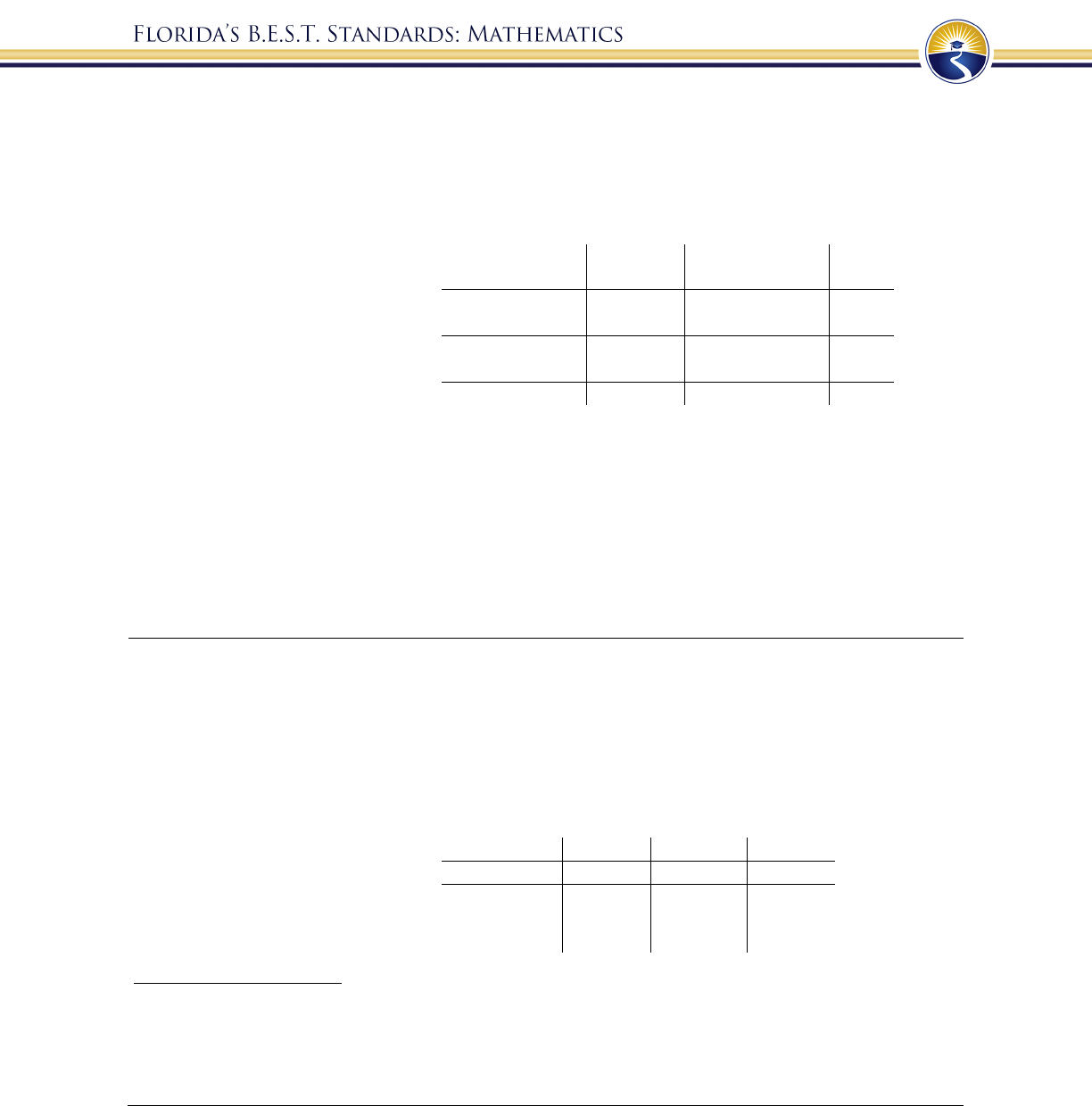
107
MA.912.DP.3.1
Construct a two-way frequency table summarizing bivariate categorical data.
Interpret joint and marginal frequencies and determine possible associations in
terms of a real-world context.
Algebra 1 Example: Complete the frequency table below.
Has an A
in math
Doesn’t have
an A in math
Total
Plays an
instrument
20 90
Doesn’t play an
instrument
20
Total
350
Using the information in the table, it is possible to determine that
the second column contains the numbers 70 and 240. This means
that there are 70 students who play an instrument but do not have
an A in math and the total number of students who play an
instrument is 90. The ratio of the joint frequencies in the first
column is 1 to 1 and the ratio in the second column is 7 to 24,
indicating a strong positive association between playing an
instrument and getting an A in math.
MA.912.DP.3.2
Given marginal and conditional relative frequencies, construct a two-way
relative frequency table summarizing categorical bivariate data.
Algebra 1 Example: A study shows that 9% of the population have diabetes and 91%
do not. The study also shows that 95% of the people who do not
have diabetes, test negative on a diabetes test while 80% who do
have diabetes, test positive. Based on the given information, the
following relative frequency table can be constructed.
Positive
Negative
Total
Has diabetes
7.2%
1.8%
9%
Doesn’t
have
diabetes
4.55% 86.45% 91%
Benchmark Clarifications:
Clarification 1:
Construction includes cases where not all frequencies are given but enough are provided
to be able to construct a two-way relative frequency table.
Clarification 2: Instruction includes the use of a tree diagram when calculating relative frequencies to
construct tables.

108
MA.912.DP.3.3
Given a two-way relative frequency table or segmented bar graph
summarizing categorical bivariate data, interpret joint, marginal and
conditional relative frequencies in terms of a real-world context.
Algebra 1 Example: Given the relative frequency table below, the ratio of true
positives to false positives can be determined as 7.2 to 4.55,
which is about 3 to 2, meaning that a randomly selected person
who tests positive for diabetes is about 50% more likely to have
diabetes than not have it.
Positive
Negative
Total
Has diabetes
7.2%
1.8%
9%
Doesn’t
have
diabetes
4.55% 86.45% 91%
Benchmark Clarifications:
Clarification 1: Instruction includes problems involving false positive and false negatives.
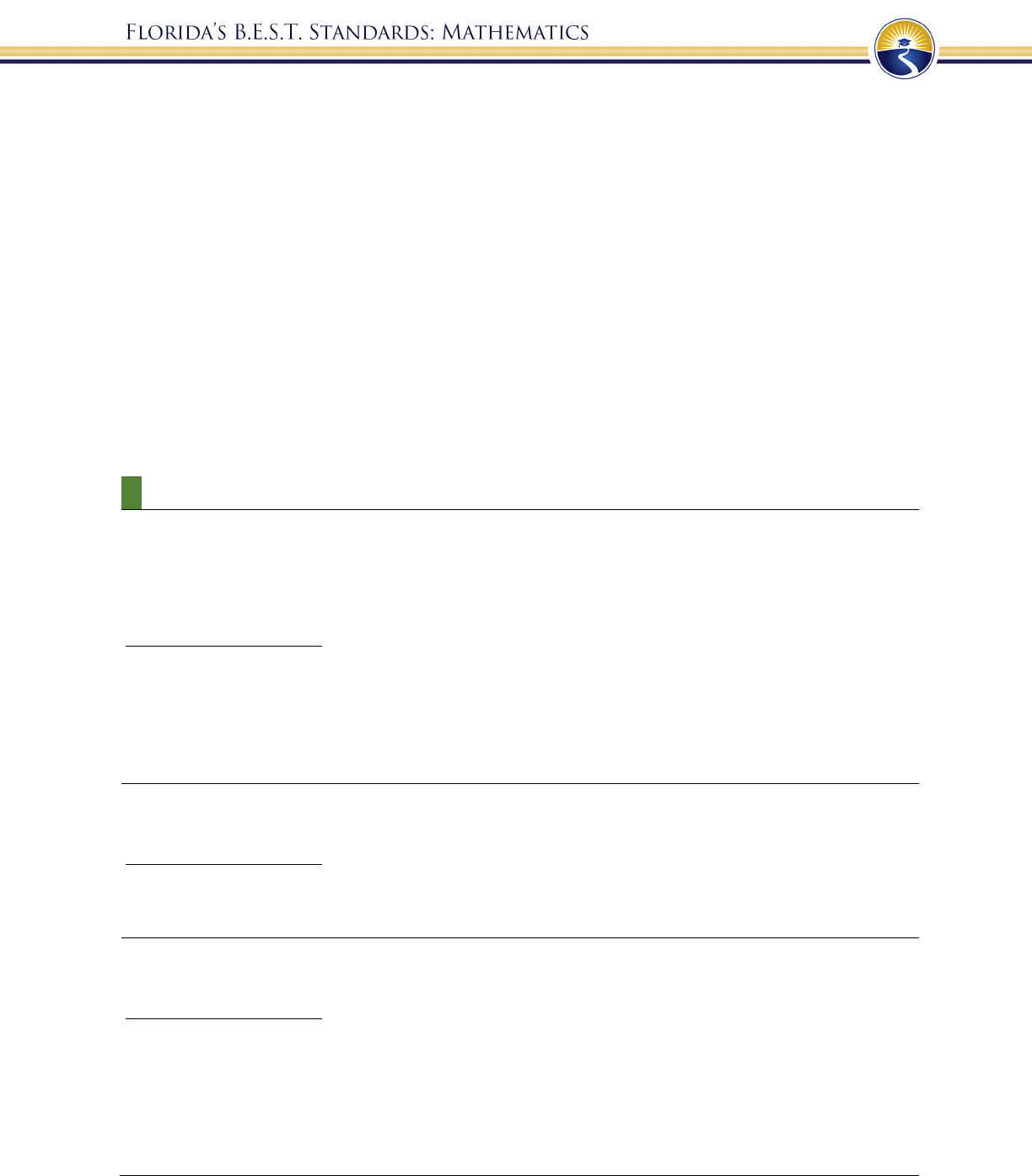
109
Geometry
In Geometry, instructional time will emphasize five areas:
(1) proving and applying relationships and theorems involving two-dimensional figures
using Euclidean geometry and coordinate geometry;
(2) establishing congruence and similarity using criteria from Euclidean geometry and
using rigid transformations;
(3) extending knowledge of geometric measurement to two-dimensional figures and
three-dimensional figures;
(4) creating and applying equations of circles in the coordinate plane and
(5) developing an understanding of right triangle trigonometry.
All clarifications stated, whether general or specific to Geometry, are expectations for
instruction of that benchmark.
Geometric Reasoning
MA.912.GR.1.1
Prove relationships and theorems about lines and angles. Solve mathematical
and real-world problems involving postulates, relationships and theorems of
lines and angles.
Benchmark Clarifications:
Clarification 1: Theorems include vertical angles are congruent; when a transversal crosses parallel lines,
alternate interior angles are congruent and corresponding angles are congruent; points on a perpendicular
bisector of a line segment are exactly those equidistant from the segment’s endpoints.
Clarification 2: Instruction includes constructing two-column proofs, pictorial proofs, paragraph and
narrative proofs, flow chart proofs and informal proofs.
MA.912.GR.1.2
Prove triangle congruence or similarity using Side-Side-Side, Side-Angle-Side,
Angle-Side-Angle, Angle-Angle-Side, Angle-Angle and Hypotenuse-Leg.
Benchmark Clarifications:
Clarification 1: Instruction includes constructing two-column proofs, pictorial proofs, paragraph and
narrative proofs, flow chart proofs and informal proofs.
MA.912.GR.1.3
Prove relationships and theorems about triangles. Solve mathematical and real-
world problems involving postulates, relationships and theorems of triangles.
Benchmark Clarifications:
Clarification 1: Theorems include measures of interior angles of a triangle sum to 180°; measures of a set
of angles of a triangle sum to 360°; triangle inequality theorem; base angles of isosceles triangles are
congruent; the segment joining midpoints of two sides of a t
riangle is parallel to the third side and half the
length; the medians of a triangle meet at a point.
Clarification 2: Instruction includes constructing two-column proofs, pictorial proofs, paragraph and
narrative proofs, flow chart proofs and informal proofs.
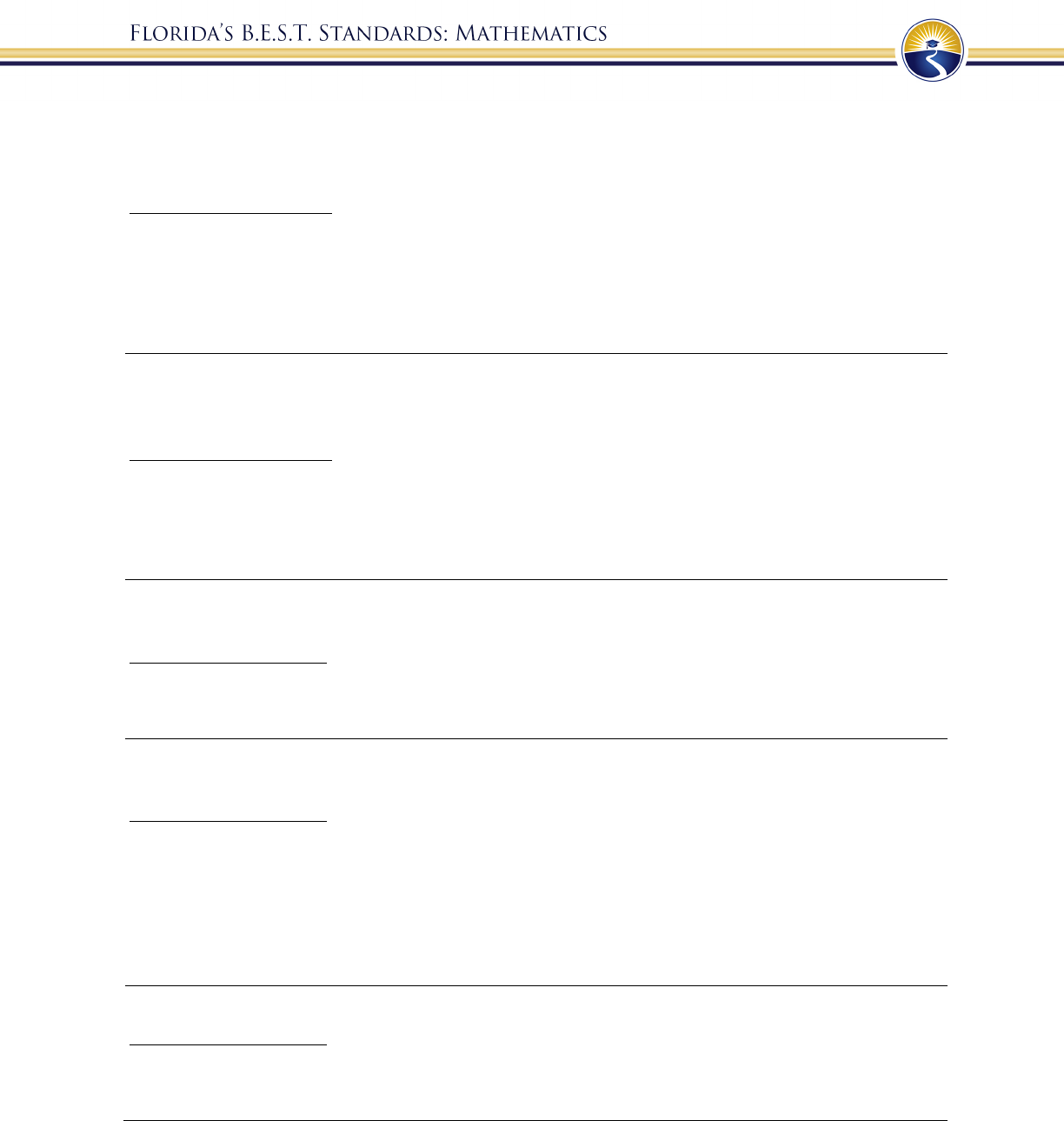
110
MA.912.GR.1.4
Prove relationships and theorems about parallelograms. Solve mathematical
and real-world problems involving postulates, relationships and theorems of
parallelograms.
Benchmark Clarifications:
Clarification 1: Theorems include opposite sides are congruent, consecutive angles are supplementary,
opposite angles are congruent, the diagonals of a parallelogram bisect each other, and rectangles are
parallelograms with congruent diagonals.
Clarification 2: Instruction includes constructing two-column proofs, pictorial proofs, paragraph and
narrative proofs, flow chart proofs and informal proofs.
MA.912.GR.1.5
Prove relationships and theorems about trapezoids. Solve mathematical and
real-world problems involving postulates, relationships and theorems of
trapezoids.
Benchmark Clarifications:
Clarification 1: Theorems include the Trapezoid Midsegment Theorem and for isosceles trapezoids: base
angles are congruent, opposite angles are supplementary and diagonals are congruent.
Clarification 2: Instruction includes constructing two-column proofs, pictorial proofs, paragraph and
narrative proofs, flow chart proofs and informal proofs.
MA.912.GR.1.6
Solve mathematical and real-world problems involving congruence or
similarity in two-dimensional figures.
Benchmark Clarifications:
Clarification 1: Instruction includes demonstrating that two-dimensional figures are congruent or similar
based on given information.
MA.912.GR.2.1
Given a preimage and image, describe the transformation and represent the
transformation algebraically using coordinates.
Benchmark Clarifications:
Clarification 1: Instruction includes the connection of transformations to functions that take points in the
plane as inputs and give other points in the plane as outputs.
Clarification 2: Transformations include translations, dilations, rotations and reflections.
Clarification 3: Within the Geometry course, rotations are limited to 90°, 180° and 270°
counterclockwise about the center of rotation, and the centers of rotations and dilations are limited to the
origin or a point on the figure.
MA.912.GR.2.2
Identify transformations that do or do not preserve distance.
Benchmark Clarifications:
Clarification 1: Transformations include translations, dilations, rotations and reflections.
Clarification 2: Instruction includes recognizing that these transformations preserve angle measure.
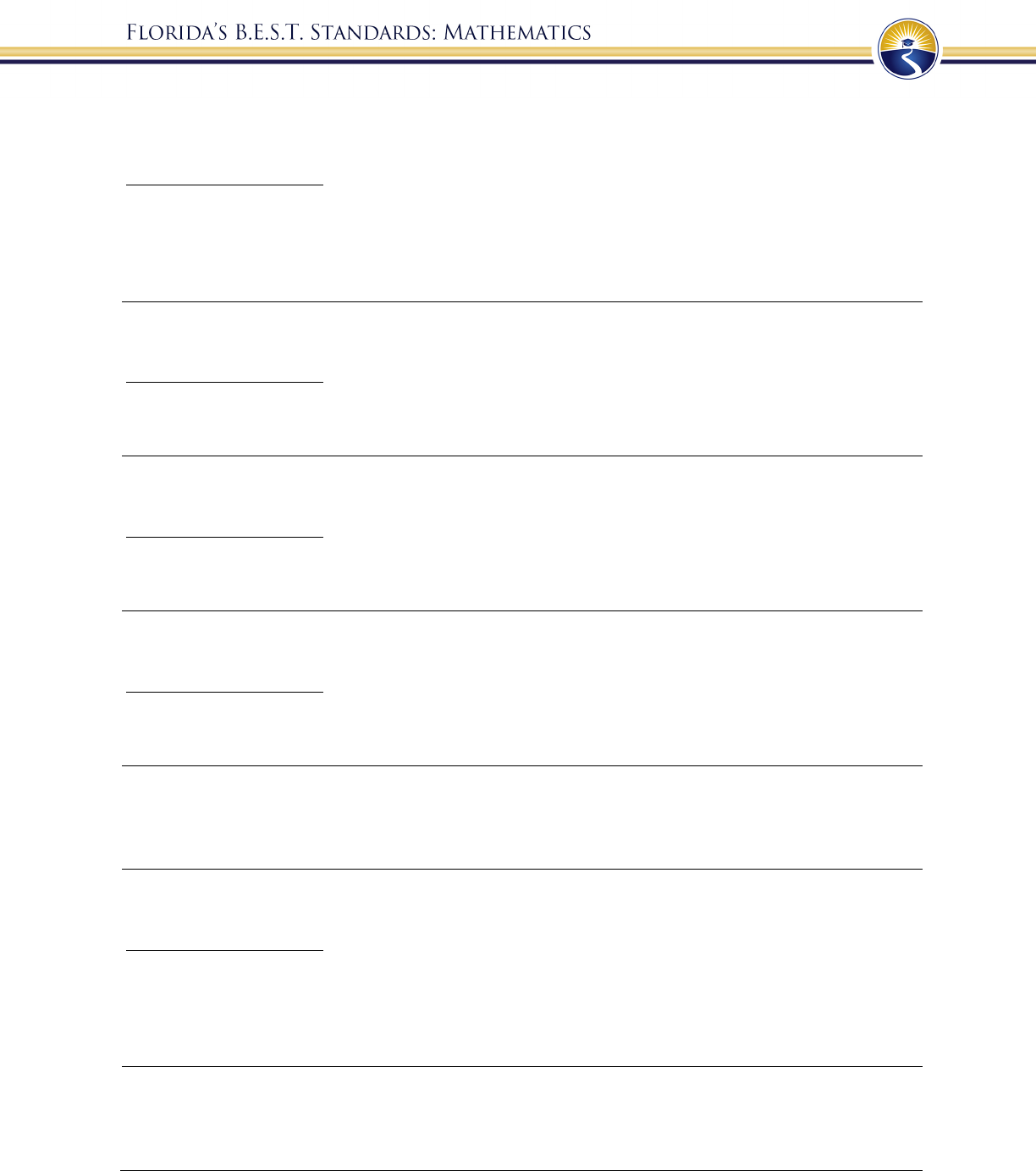
111
MA.912.GR.2.3
Specify a sequence of transformations that will map a given figure onto itself
or onto another congruent or similar figure.
Benchmark Clarifications:
Clarification 1: Transformations include translations, dilations, rotations and reflections.
Clarification 2: Given figures and transformed figures must be the same type of two-dimensional figure.
Clarification 3: Within the Geometry course, figures are limited to triangles and quadrilaterals and
rotations are limited to 90°, 180° and 270° counterclockwise about the center of rotation.
MA.912.GR.2.4
Given a geometric figure and a sequence of transformations, draw the
transformed figure on a coordinate plane.
Benchmark Clarifications:
Clarification 1: Transformations include translations, dilations, rotations and reflections.
Clarification 2: Instruction includes two or more transformations.
MA.912.GR.2.5
Apply rigid transformations to map one figure onto another to justify that the
two figures are congruent.
Benchmark Clarifications:
Clarification 1: Instruction includes showing that the corresponding sides and the corresponding angles
are congruent.
MA.912.GR.2.7
Apply an appropriate transformation to map one figure onto another to justify
that the two figures are similar.
Benchmark Clarifications:
Clarification 1: Instruction includes showing that the corresponding sides are proportional, and the
corresponding angles are congruent.
MA.912.GR.3.1
Given a mathematical or real-world context, use coordinate geometry to
classify or justify definitions, properties and theorems involving circles,
triangles or quadrilaterals.
MA.912.GR.3.2
Solve geometric problems involving circles, triangles and quadrilaterals on the
coordinate plane.
Benchmark Clarifications:
Clarification 1: Problems involving quadrilaterals include using parallel and perpendicular slope criteria.
Clarification 2: Problems involving triangles include median and centroid.
Clarification 3: Problems involving circles include determining points on a given circle and finding
tangent lines.
MA.912.GR.3.3
Solve mathematical and real-world problems on the coordinate plane that
involve finding the coordinates of a point on a line segment including the
midpoint.
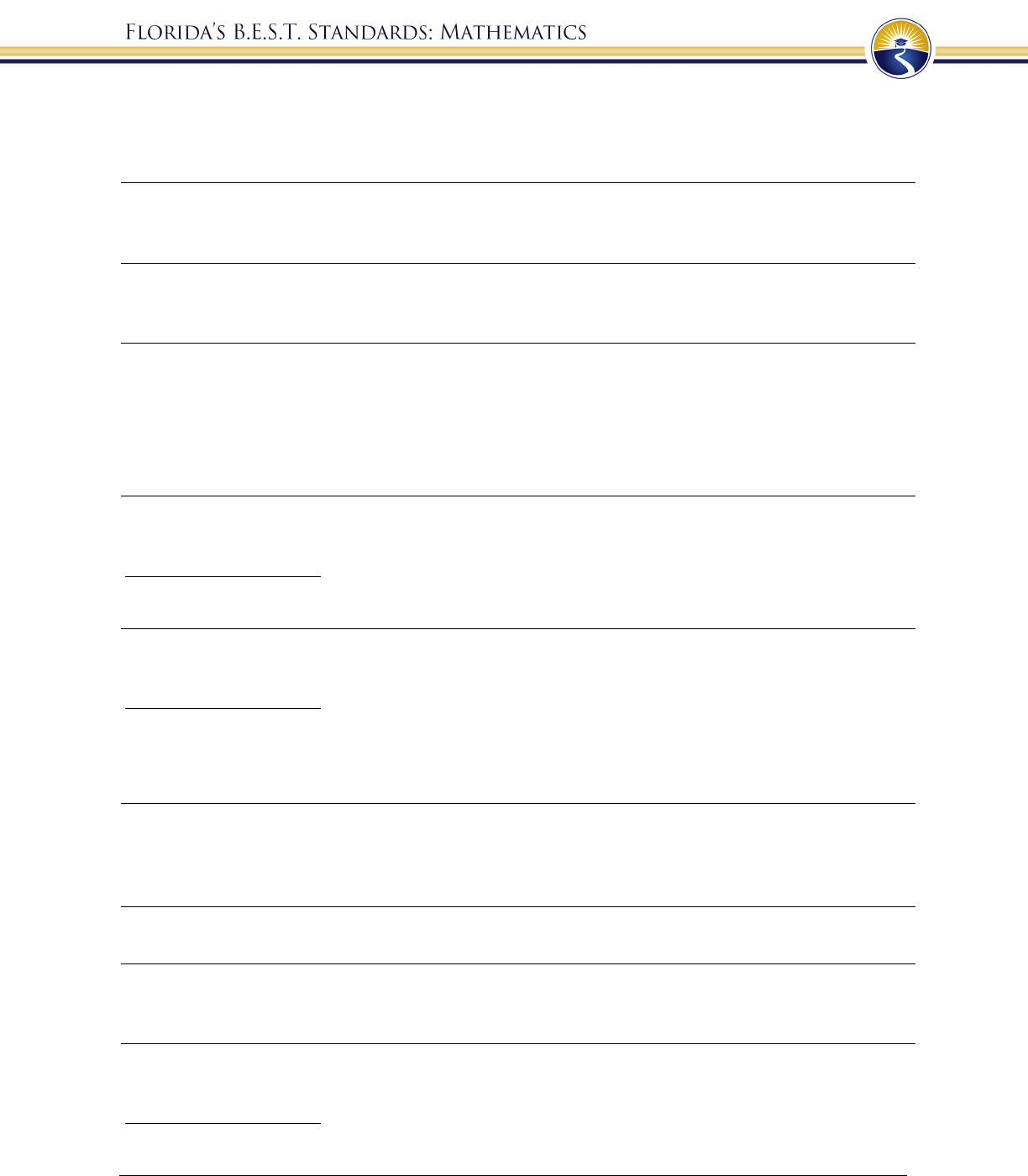
112
MA.912.GR.3.4
Solve mathematical and real-world problems on the coordinate plane involving
perimeter or area of polygons.
MA.912.GR.4.1
Identify the shapes of two-dimensional cross-sections of three-dimensional
figures.
MA.912.GR.4.2
Identify three-dimensional objects generated by rotations of two-dimensional
figures.
MA.912.GR.4.3
Determine how changes in dimensions affect the area of two-dimensional
figures and the surface area or volume of three-dimensional figures.
Geometry Example: Mike is having a graduation party and wants to make sure he has
enough pizza. Should he order one 12-inch pizza or three 6-inch
pizzas?
MA.912.GR.4.4
Solve mathematical and real-world problems involving the area of two-
dimensional figures.
Benchmark Clarifications:
Clarification 1: Instruction includes concepts of population density based on area.
MA.912.GR.4.5
Solve mathematical and real-world problems involving the volume of three-
dimensional figures limited to cylinders, pyramids, prisms, cones and spheres.
Benchmark Clarifications:
Clarification 1: Instruction includes concepts of density based on volume.
Clarification 2: Instruction includes using Cavalieri’s Principle to give informal arguments about the
formulas for the volumes of right and non-right cylinders, pyramids, prisms and cones.
MA.912.GR.4.6
Solve mathematical and real-world problems involving the surface area of
three-dimensional figures limited to cylinders, pyramids, prisms, cones and
spheres.
MA.912.GR.5.1
Construct a copy of a segment or an angle.
MA.912.GR.5.2
Construct the bisector of a segment or an angle, including the perpendicular
bisector of a line segment.
MA.912.GR.5.5
Given a point outside a circle, construct a line tangent to the circle that passes
through the given point.
Benchmark Clarifications:
Clarification 1: When given a circle, the center must be provided.
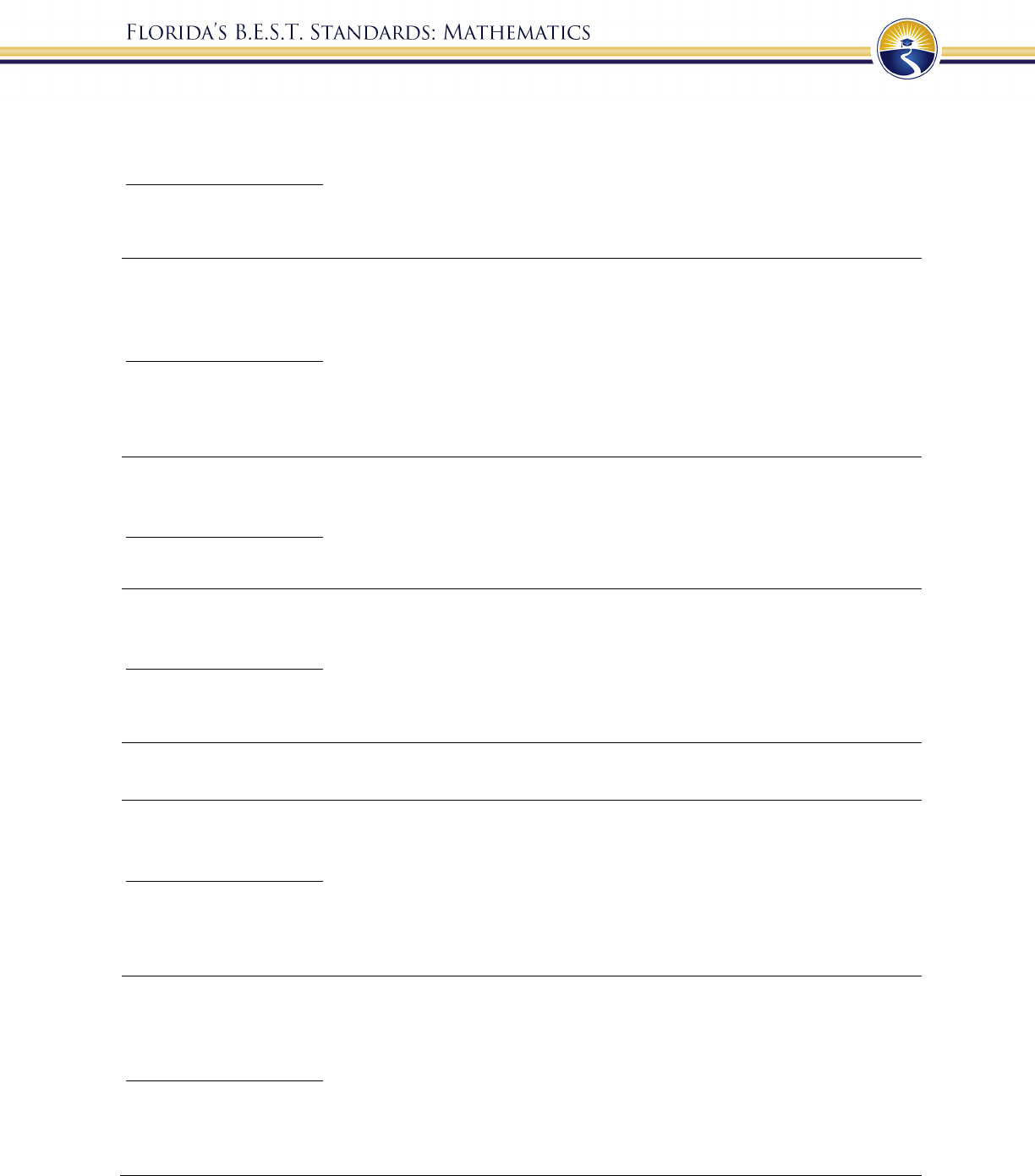
113
MA.912.GR.6.1
Solve mathematical and real-world problems involving the length of a secant,
tangent, segment or chord in a given circle.
Benchmark Clarifications:
Clarification 1: Problems include relationships between two chords; two secants; a secant and a tangent;
and the length of the tangent from a point to a circle.
MA.912.GR.6.2
Solve mathematical and real-world problems involving the measures of arcs
and related angles, limited to central, inscribed and intersections of a chord,
secants or tangents.
Benchmark Clarifications:
Clarification 1: Problems include relationships between inscribed angles; central angles; and angles
formed by the following intersections: two secants, a tangent and a secant, two tangents, two chords, and
a perpendicular bisector and a chord.
MA.912.GR.6.3
Solve mathematical problems involving triangles and quadrilaterals inscribed
in a circle.
Benchmark Clarifications:
Clarification 1: Instruction includes triangles in a circle and semicircle.
MA.912.GR.6.4
Solve mathematical and real-world problems involving the arc length and area
of a sector in a given circle.
Benchmark Clarifications:
Clarification 1: Instruction focuses on the conceptual understanding that the length of the arc intercepted
by an angle is proportional to the radius.
MA.912.GR.6.5
Apply transformations to prove that all circles are similar.
MA.912.GR.7.2
Given a mathematical or real-world context, derive and create the equation of a
circle using key features.
Benchmark Clarifications:
Clarification 1: Instruction includes using the Pythagorean Theorem and completing the square.
Clarification 2: Within the Geometry course, key features are limited to the radius, diameter and the
center.
MA.912.GR.7.3
Graph and solve mathematical and real-world problems that are modeled with
an equation of a circle. Determine and interpret key features in terms of the
context.
Benchmark Clarifications:
Clarification 1: Key features are limited to domain, range, center and radius.
Clarification 2: Instruction includes representing the domain and range with inequality notation, interval
notation or set-builder notation.
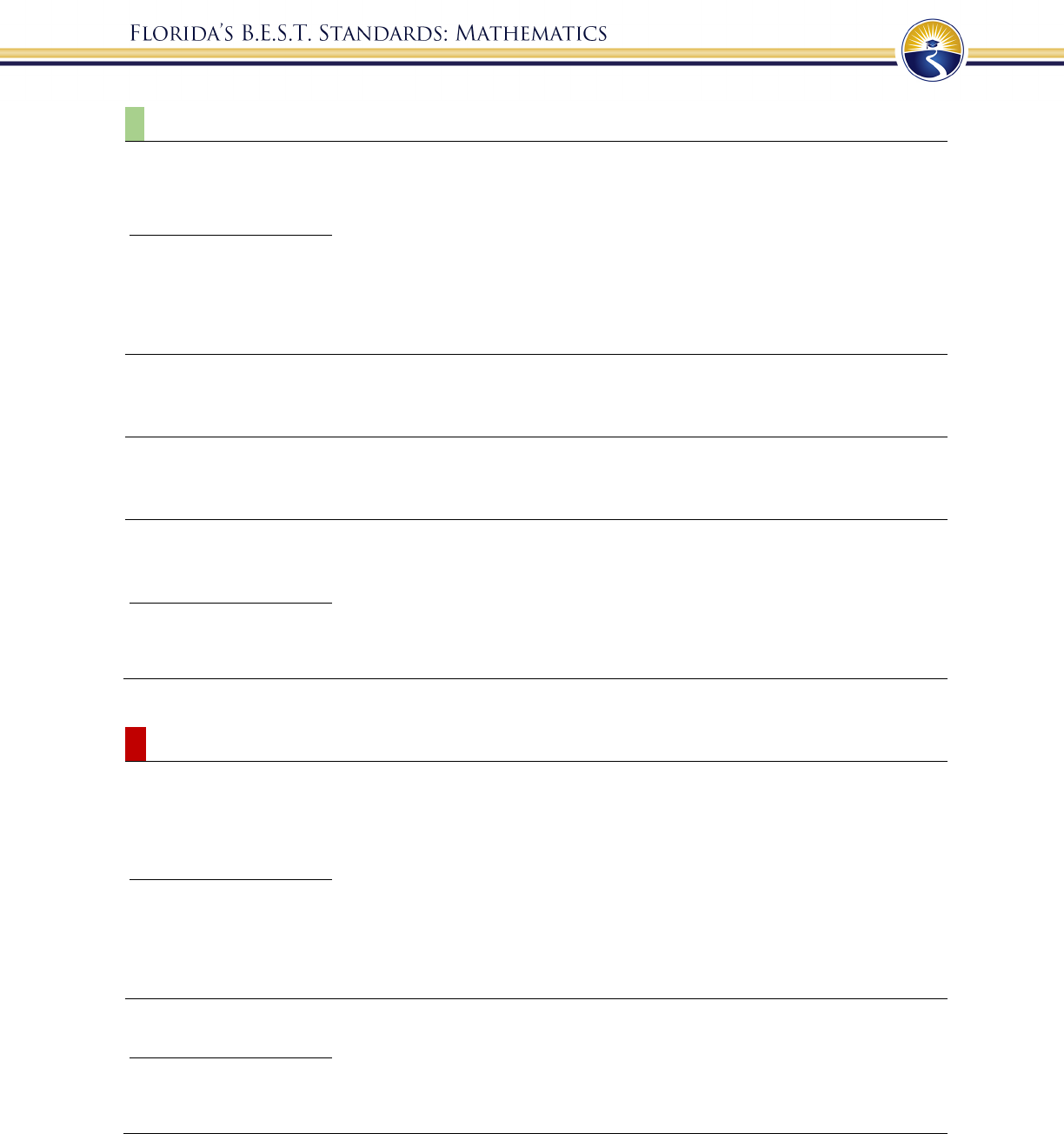
114
Trigonometry
MA.912.T.1.1
Define trigonometric ratios for acute angles in right triangles.
Benchmark Clarifications:
Clarification 1: Instruction includes using the Pythagorean Theorem and using similar triangles to
demonstrate that trigonometric ratios stay the same for similar right triangles.
Clarification 2: Within the Geometry course, instruction includes using the coordinate plane to make
connections to the unit circle.
MA.912.T.1.2
Solve mathematical and real-world problems involving right triangles using
trigonometric ratios and the Pythagorean Theorem.
MA.912.T.1.3
Apply the Law of Sines and the Law of Cosines to solve mathematical and real-
world problems involving triangles.
MA.912.T.1.4
Solve mathematical problems involving finding the area of a triangle given two
sides and the included angle.
Benchmark Clarifications:
Clarification 1: Problems include right triangles, heights inside of a triangle and heights outside of a
triangle.
Logic and Theory
MA.912.LT.4.3
Identify and accurately interpret “if…then,” “if and only if,” “all” and “not”
statements. Find the converse, inverse and contrapositive of a statement.
Benchmark Clarifications:
Clarification 1: Instruction focuses on recognizing the relationships between an “if…then” statement and
the converse, inverse and contrapositive of that statement.
Clarification 2: Within the Geometry course, instruction focuses on the connection to proofs within the
course.
MA.912.LT.4.8
Construct proofs, including proofs by contradiction.
Benchmark Clarifications:
Clarification 1: Within the Geometry course, proofs are limited to geometric statements within the
course.

115
MA.912.LT.4.10
Judge the validity of arguments and give counterexamples to disprove
statements.
Benchmark Clarifications:
Clarification 1: Within the Geometry course, instruction focuses on the connection to proofs within the
course.
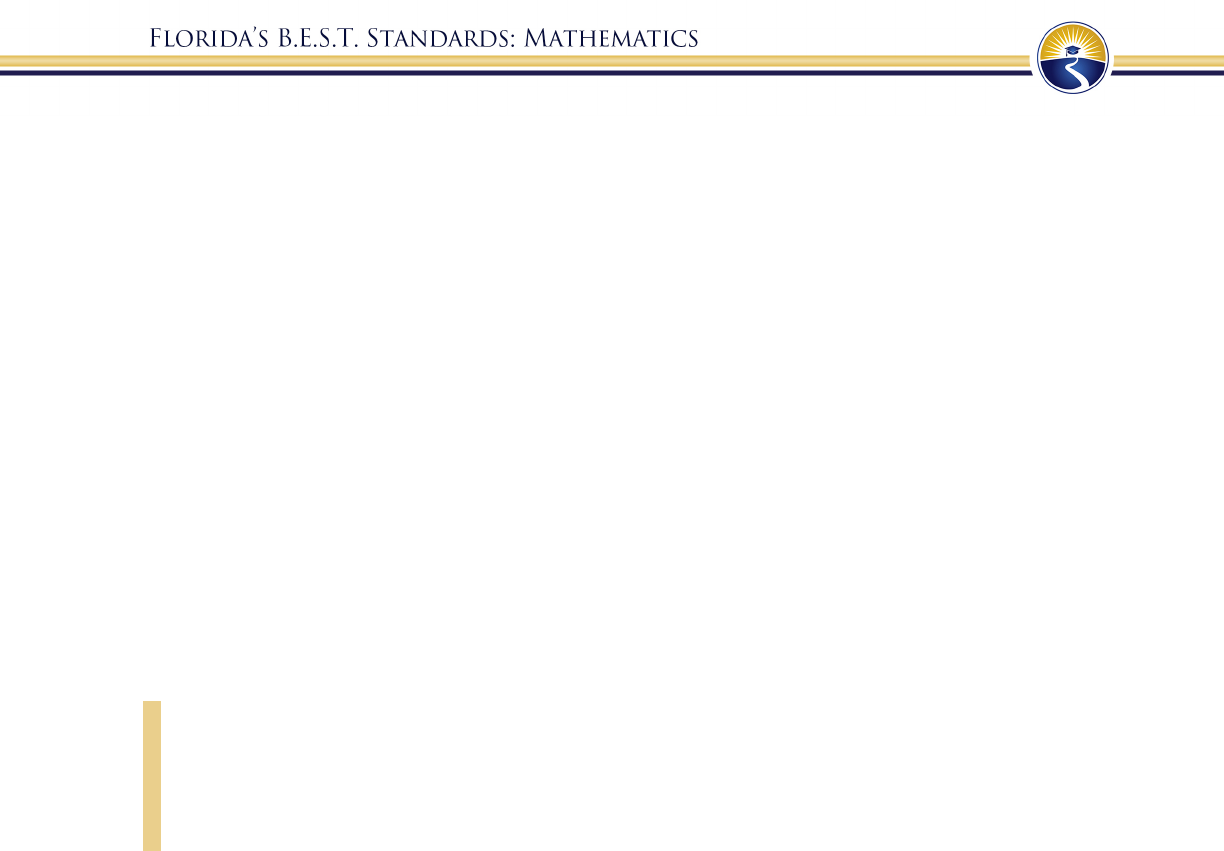
116
Mathematics 9-12
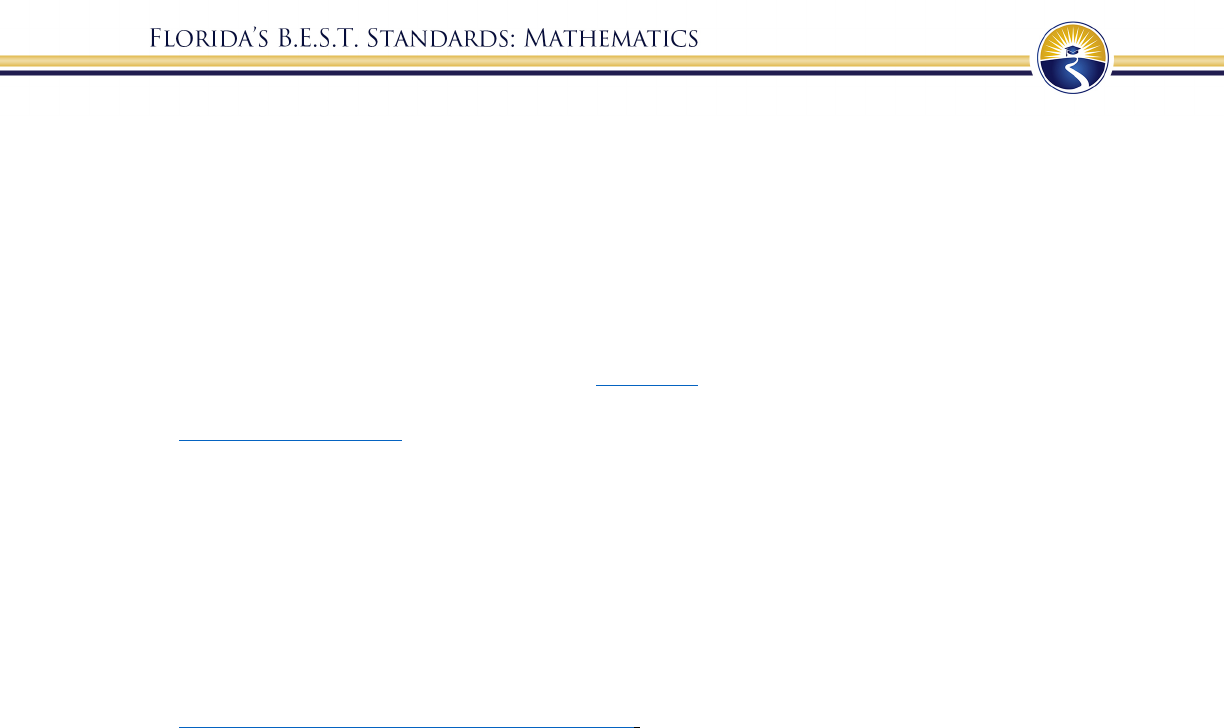
117
9-12 Overview
Florida’s vision for high school mathematics is for all students to receive a mathematical
education that allows them to progress through post-secondary education. This foundation,
coupled with various pathways, supports student success in the workforce and prepares them for
the high-demand jobs of tomorrow. Florida’s B.E.S.T. Standards for Mathematics 9-12 are
organized in a way that allows for multiple pathways for the students of Florida.
Students are expected to master the benchmarks within the Algebra 1 and Geometry
courses. These two courses, as shown in the previous section, are two of the four required
courses for high school graduation per Section 1003.4282, Florida Statutes (F.S.). Additional
mathematics credits may be earned through any high school mathematics course offered within
the Course Code Directory. Students should consider their college or career path when deciding
which two additional mathematics courses they earn for high school graduation.
Identified Courses
As outlined in this document, Algebra 1 and Geometry do not fully encompass all
possible high school mathematics pathways. Through collaboration with stakeholders in K-12
and higher education, additional high school mathematics courses will be developed upon the
adoption of the Florida’s B.E.S.T. Standards for Mathematics 9-12. Further, districts will be able
to submit other courses from the set of Florida’s B.E.S.T. Standards for Mathematics 9-12 via
the Office of Articulation’s Course Code Directory.
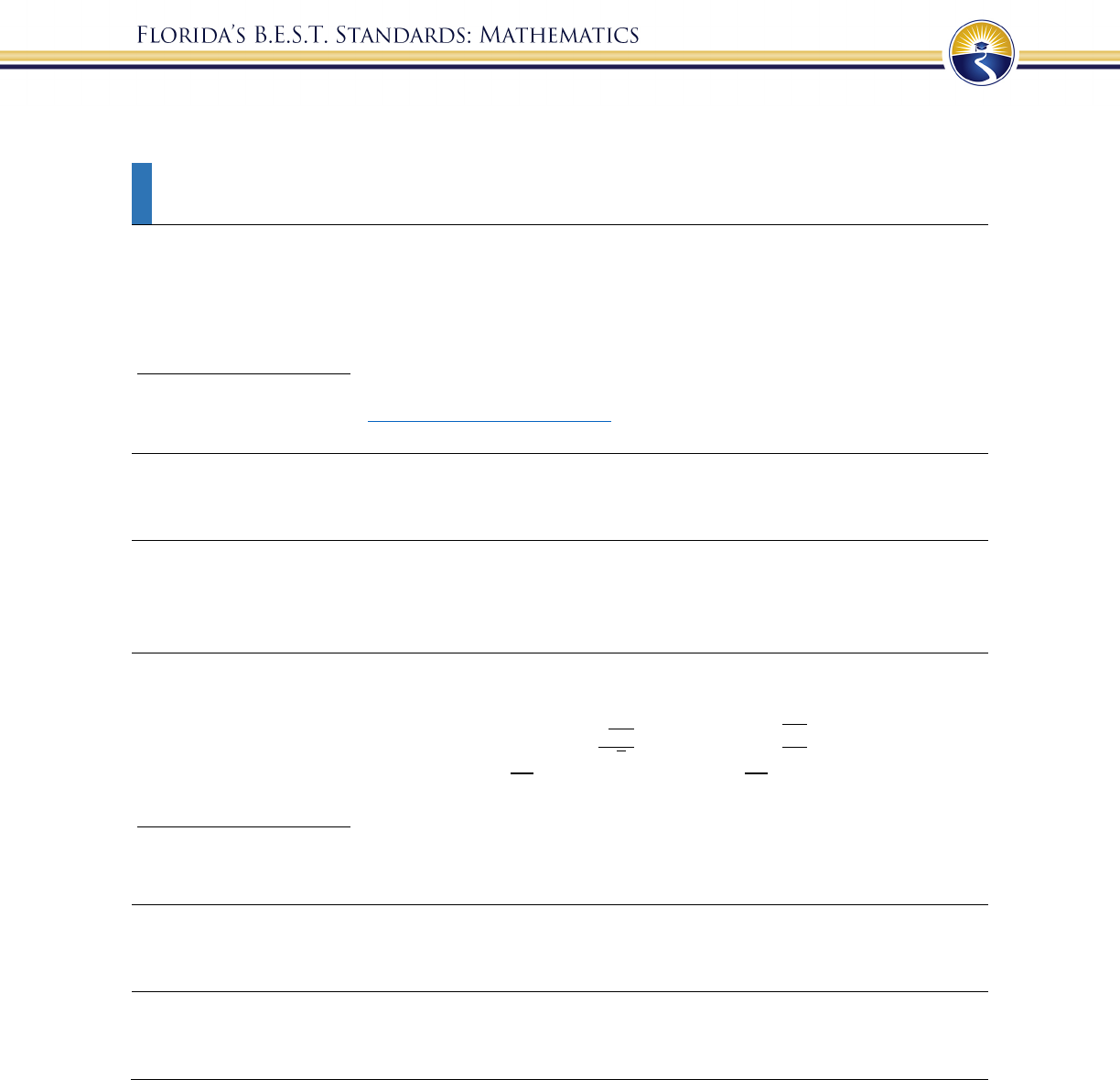
118
9-12 Number Sense and Operations Strand
MA.912.NSO.1 Generate equivalent expressions and perform operations with expressions
involving exponents, radicals or logarithms.
MA.912.NSO.1.1
Extend previous understanding of the Laws of Exponents to include rational
exponents. Apply the Laws of Exponents to evaluate numerical expressions
and generate equivalent numerical expressions involving rational exponents.
Benchmark Clarifications:
Clarification 1: Instruction includes the use of technology when appropriate.
Clarification 2: Refer to the K-12 F
ormulas (Appendix E) for the Laws of Exponents.
MA.912.NSO.1.2
Generate equivalent monomial algebraic expressions using the properties of
exponents.
MA.912.NSO.1.3
Generate equivalent algebraic expressions involving radicals or rational
exponents using the properties of exponents. Radicands are limited to
monomial algebraic expressions.
MA.912.NSO.1.4
Apply previous understanding of operations with rational numbers to add,
subtract, multiply and divide numerical radicals.
Algebra 1 Example: The expression
is equivalent to
which is equivalent
to
68 which is equivalent to 2
17.
Benchmark Clarifications:
Clarification 1: Within the Algebra 1 course, expressions are limited to a single arithmetic operation
involving two square roots or two cube roots.
MA.912.NSO.1.5
Add, subtract, multiply and divide algebraic expressions involving radicals.
Radicands are limited to monomial algebraic expressions.
MA.912.NSO.1.6
Given an algebraic logarithmic expression, generate an equivalent algebraic
expression using the properties of logarithms or exponents.
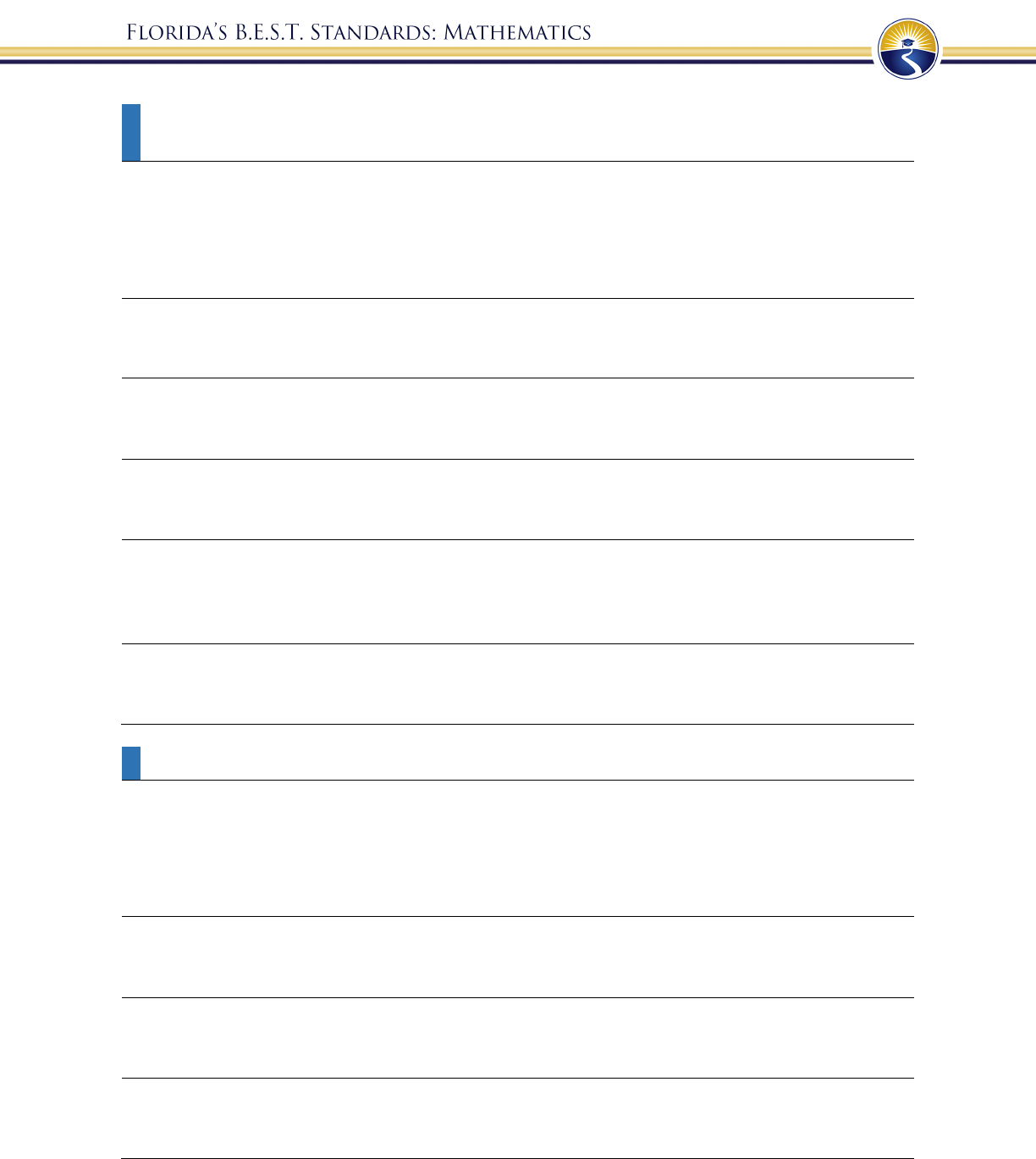
119
MA.912.NSO.2 Represent and perform operations with expressions within the complex
number system.
MA.912.NSO.2.1
Extend previous understanding of the real number system to include the
complex number system. Add, subtract, multiply and divide complex
numbers.
MA.912.NSO.2.2
Represent addition, subtraction, multiplication and conjugation of complex
numbers geometrically on the complex plane.
MA.912.NSO.2.3
Calculate the distance and midpoint between two numbers on the complex
coordinate plane.
MA.912.NSO.2.4
Solve mathematical and real-world problems involving complex numbers
represented algebraically or on the coordinate plane.
MA.912.NSO.2.5
Represent complex numbers on the complex plane in rectangular and polar
forms. Explain why the rectangular and polar forms of a given complex
number represent the same number.
MA.912.NSO.2.6
Rewrite complex numbers to trigonometric form. Multiply complex numbers
in trigonometric form.
MA.912.NSO.3 Represent and perform operations with vectors.
MA.912.NSO.3.1
Apply appropriate notation and symbols to represent vectors in the plane as
directed line segments. Determine the magnitude and direction of a vector in
component form.
MA.912.NSO.3.2
Represent vectors in component form, linear form or trigonometric form.
Rewrite vectors from one form to another.
MA.912.NSO.3.3
Solve mathematical and real-world problems involving velocity and other
quantities that can be represented by vectors.
MA.912.NSO.3.4
Solve mathematical and real-world problems involving vectors in two
dimensions using the dot product and vector projections.
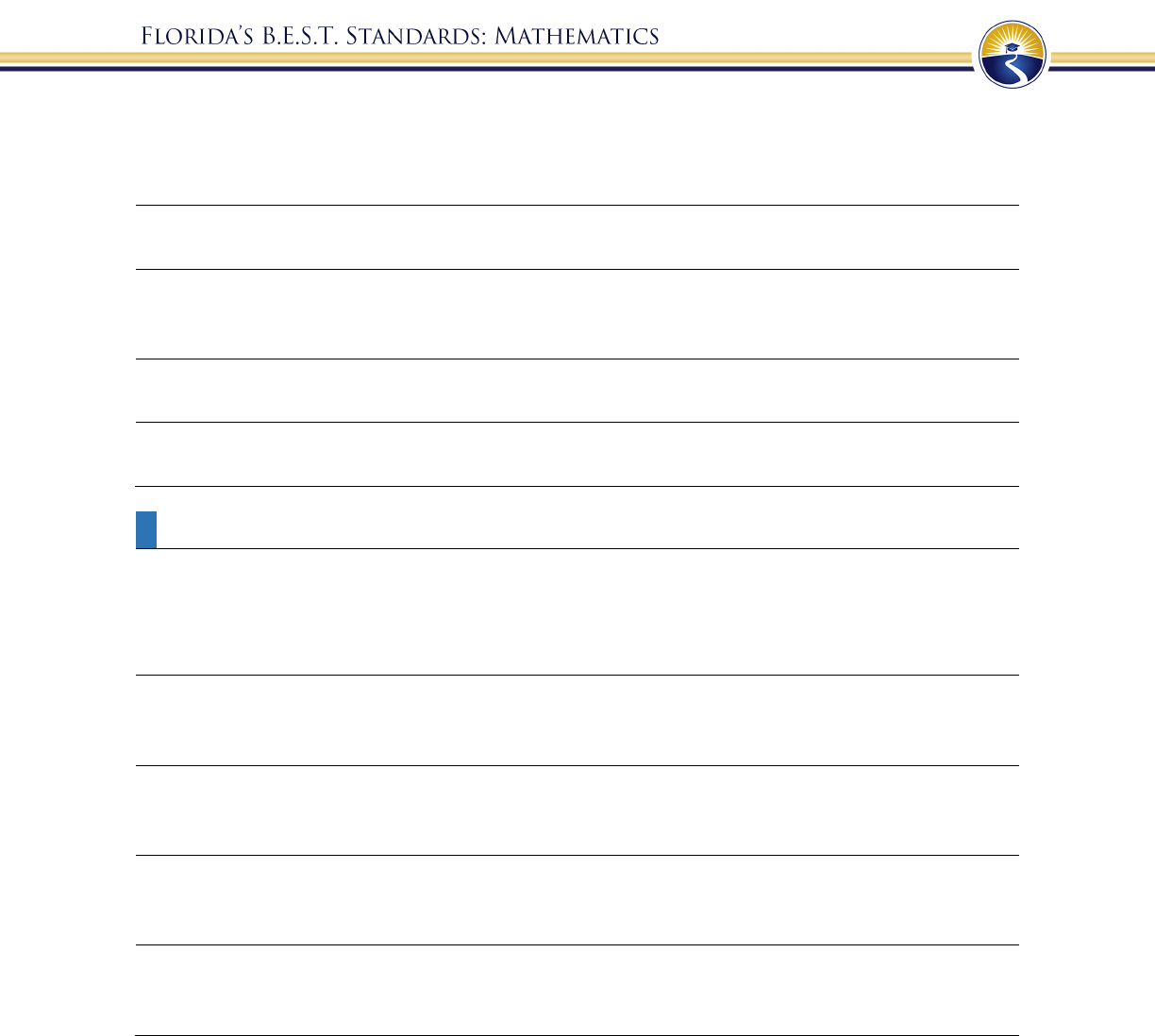
120
MA.912.NSO.3.5
Solve mathematical and real-world problems involving vectors in three
dimensions using the dot product and cross product.
MA.912.NSO.3.6
Add and subtract vectors algebraically or graphically.
MA.912.NSO.3.7
Given the magnitude and direction of two or more vectors, determine the
magnitude and direction of their sum.
MA.912.NSO.3.8
Multiply a vector by a scalar algebraically or graphically.
MA.912.NSO.3.9
Compute the magnitude and direction of a vector scalar multiple.
MA.912.NSO.4 Represent and perform operations with matrices.
MA.912.NSO.4.1
Given a mathematical or real-world context, represent and manipulate data
using matrices.
MA.912.NSO.4.2
Given a mathematical or real-world context, represent and solve a system of
two- or three-variable linear equations using matrices.
MA.912.NSO.4.3
Solve mathematical and real-world problems involving addition, subtraction
and multiplication of matrices.
MA.912.NSO.4.4
Solve mathematical and real-world problems using the inverse and
determinant of matrices.
MA.912.NSO.4.5
Identify and use the additive and multiplicative identities for matrices to
solve mathematical and real-world problems.

121
9-12 Algebraic Reasoning Strand
MA.912.AR.1 Interpret and rewrite algebraic expressions and equations in equivalent
forms.
MA.912.AR.1.1
Identify and interpret parts of an expression that represent a quantity in terms
of a mathematical or real-world context, including viewing one or more of its
parts as a single entity.
Algebra 1 Example: Derrick is using the formula = 1000
(
1 + .1
)
to make a
prediction about the
camel population in Australia. He identifies
the growth factor as
(
1 + .1
)
, or 1.1, and states that the camel
population will grow at an annual rate of 10% per year.
Benchmark Clarifications:
Clarification 1: Parts of an expression include factors, terms, constants, coefficients and variables.
MA.912.AR.1.2
Rearrange equations or formulas to isolate a quantity of interest.
Algebra 1 Example: The Ideal Gas Law = can be rearranged as =
to
isolate temperature as the quantity of interest.
Benchmark Clarifications:
Clarification 1: Instruction includes using formulas for temperature, perimeter, area and volume; using
equations for linear (standard, slope-intercept and point-slope forms) and quadratic (standard, factored
and vertex forms) functions.
MA.912.AR.1.3
Add, subtract and multiply polynomial expressions with rational number
coefficients.
Benchmark Clarifications:
Clarification 1: Instruction includes an understanding that when any of these operations are performed
with polynomials the result is also a polynomial
Clarification 2: Within the Algebra 1 course, polynomial expressions are limited to 3 or fewer terms
with integer coefficients.
MA.912.AR.1.4
Divide a polynomial expression by a monomial expression with rational
number coefficients.
Benchmark Clarifications:
Clarification 1: Within the Algebra 1 course, polynomial expressions are limited to 3 or fewer terms
with integer coefficients.
MA.912.AR.1.5
Divide polynomial expressions using long division, synthetic division and
algebraic manipulation.
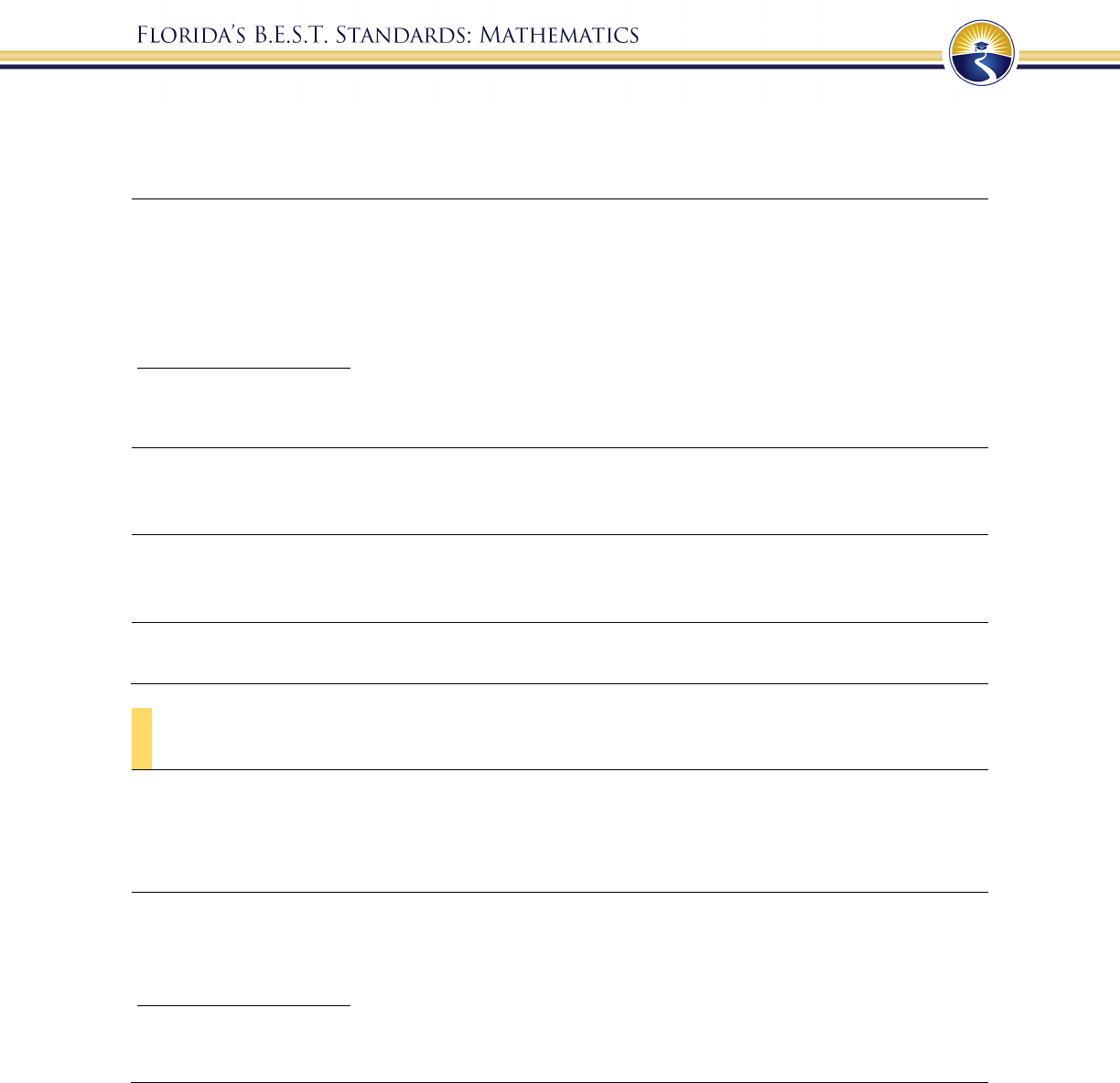
122
MA.912.AR.1.6
Solve mathematical and real-world problems involving addition, subtraction,
multiplication or division of polynomials.
MA.912.AR.1.7
Rewrite a polynomial expression as a product of polynomials.
Example: The expression 4
3
is equivalent to the factored form
(
43
)
.
Example: The expression 16
9
is equivalent to the factored form
(43)(4+ 3).
Benchmark Clarifications:
Clarification 1: Within the Algebra 1 course, polynomial expressions are limited to 4 or fewer terms
with integer coefficients.
MA.912.AR.1.8
Apply previous understanding of rational number operations to add, subtract,
multiply and divide rational expressions.
MA.912.AR.1.9
Solve mathematical and real-world problems involving addition, subtraction,
multiplication or division of rational algebraic expressions.
MA.912.AR.1.10
Apply the Binomial Theorem to create equivalent polynomial expressions.
MA.912.AR.2 Write, solve and graph linear equations, functions and inequalities in one
and two variables.
MA.912.AR.2.1
Given a real-world context, write and solve one-variable multi-step linear
equations.
MA.912.AR.2.2
Write a linear two-variable equation to represent relationships between
quantities from a graph, a written description or a table of values within a
mathematical or real-world context.
Benchmark Clarifications:
Clarification 1: Instruction includes the use of standard form, slope-intercept form and point-slope form,
and the conversion between these forms.
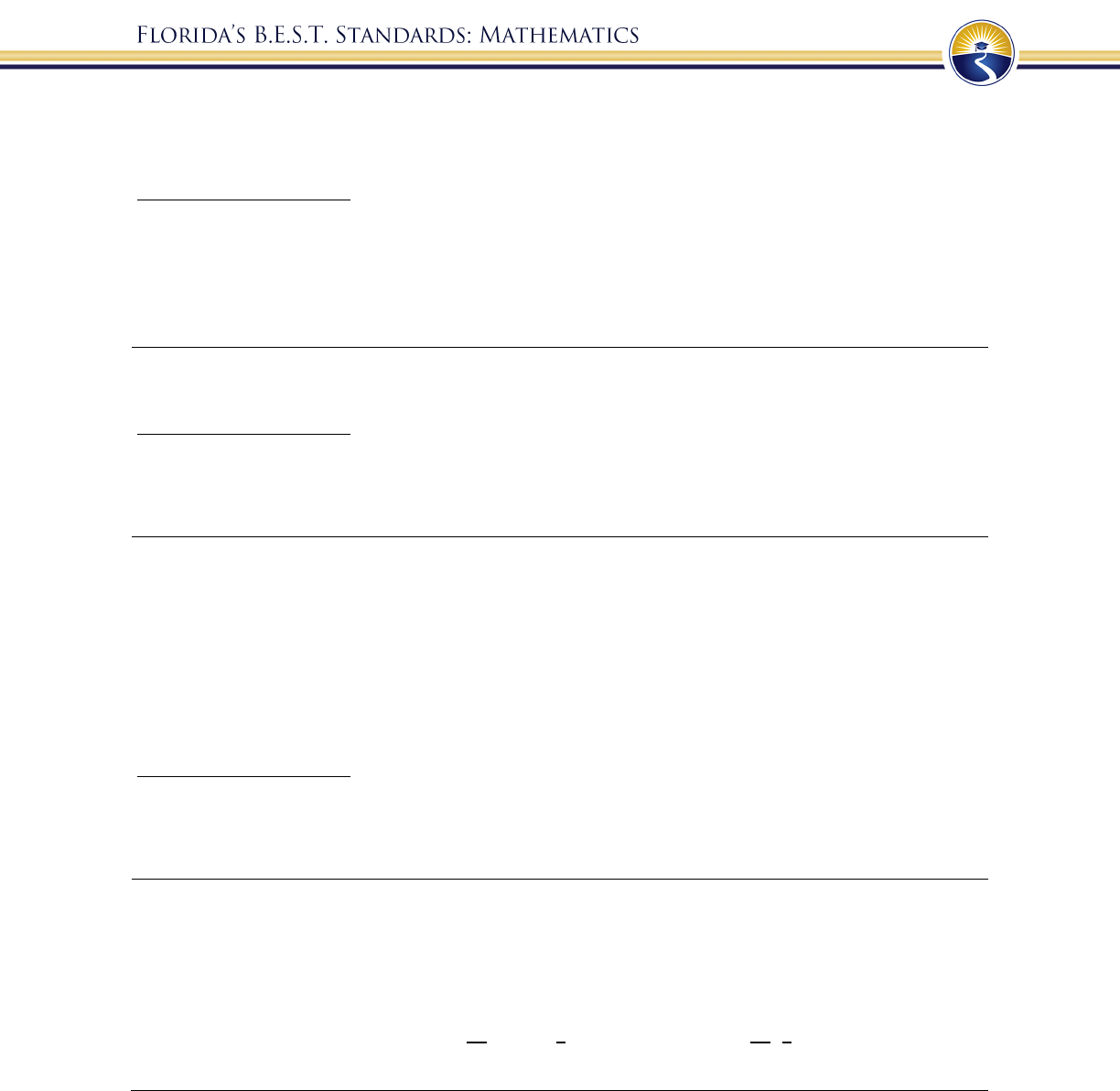
123
MA.912.AR.2.3
Write a linear two-variable equation for a line that is parallel or perpendicular
to a given line and goes through a given point.
Benchmark Clarifications:
Clarification 1: Instruction focuses on recognizing that perpendicular lines have slopes that when
multiplied result in 1 and that parallel lines have slopes that are the same.
Clarification 2: Instruction includes representing a line with a pair of points on the coordinate plane or
with an equation.
Clarification 3: Problems include cases where one variable has a coefficient of zero.
MA.912.AR.2.4
Given a table, equation or written description of a linear function, graph that
function, and determine and interpret its key features.
Benchmark Clarifications:
Clarification 1: Key features are limited to domain, range, intercepts and rate of change.
Clarification 2: Instruction includes the use of standard form, slope-intercept form and point-slope form.
Clarification 3: Instruction includes cases where one variable has a coefficient of zero.
MA.912.AR.2.5
Solve and graph mathematical and real-world problems that are modeled with
linear functions. Interpret key features and determine domain constraints in
terms of the context.
Algebra 1 Example: Lizzy’s mother uses the function () = 450 + 7.75, where
() represents the total cost of a rental space and is the
number of people attending, to help budget Lizzy’s 16
th
birthday
party. Lizzy’s mom wants to spend no more than $850 for the
party. Graph the function in terms of the context.
Benchmark Clarifications:
Clarification 1: Key features are limited to domain, range, intercepts and rate of change.
Clarification 2: Instruction includes the use of standard form, slope-intercept form and point-slope form.
Clarification 3: Instruction includes representing constraints with inequalities or set-builder notation.
MA.912.AR.2.6
Given a mathematical or real-world context, write and solve one-variable
linear inequalities, including compound inequalities. Represent solutions
algebraically or graphically.
Algebra 1 Example: The compound inequality 2 5 + 1 < 4 is equivalent
to 1 3 and 5 < 3, which is equivalent to
<
. The solution set is [
,
).
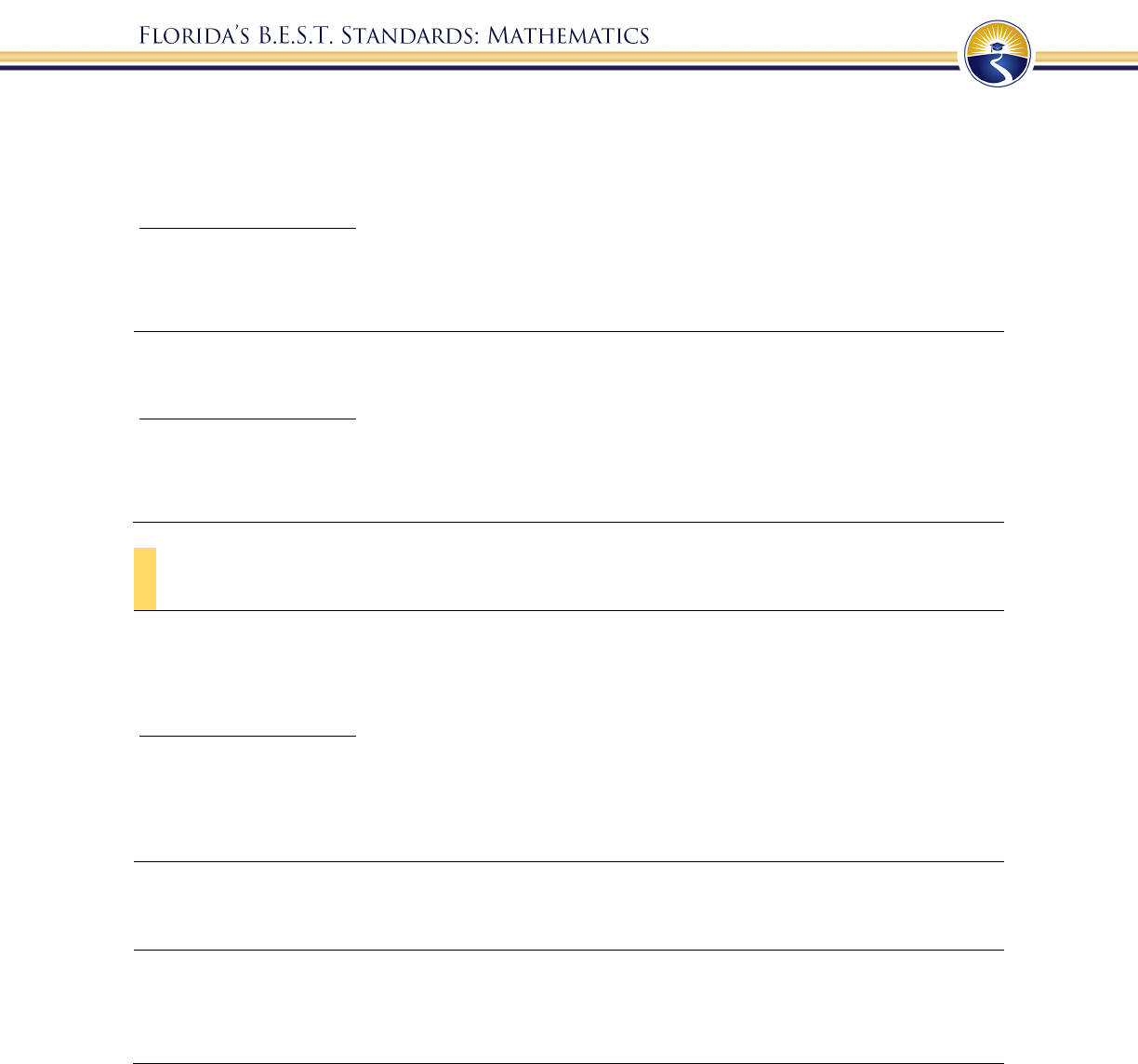
124
MA.912.AR.2.7
Write two-variable linear inequalities to represent relationships between
quantities from a graph or a written description within a mathematical or real-
world context.
Benchmark Clarifications:
Clarification 1: Instruction includes the use of standard form, slope-intercept form and point-slope form
and any inequality symbol can be represented.
Clarification 2: Instruction includes cases where one variable has a coefficient of zero.
MA.912.AR.2.8
Given a mathematical or real-world context, graph the solution set to a two-
variable linear inequality.
Benchmark Clarifications:
Clarification 1: Instruction includes the use of standard form, slope-intercept form and point-slope form
and any inequality symbol can be represented.
Clarification 2: Instruction includes cases where one variable has a coefficient of zero.
MA.912.AR.3 Write, solve and graph quadratic equations, functions and inequalities in
one and two variables.
MA.912.AR.3.1
Given a mathematical or real-world context, write and solve one-variable
quadratic equations over the real number system.
Benchmark Clarifications:
Clarification 1: Within the Algebra 1 course, instruction includes the concept of non-real answers,
without determining non-real solutions.
Clarification 2: Within this benchmark, the expectation is to solve by factoring techniques, taking
square roots, the quadratic formula and completing the square.
MA.912.AR.3.2
Given a mathematical or real-world context, write and solve one-variable
quadratic equations over the real and complex number systems.
MA.912.AR.3.3
Given a mathematical or real-world context, write and solve one-variable
quadratic inequalities over the real number system. Represent solutions
algebraically or graphically.
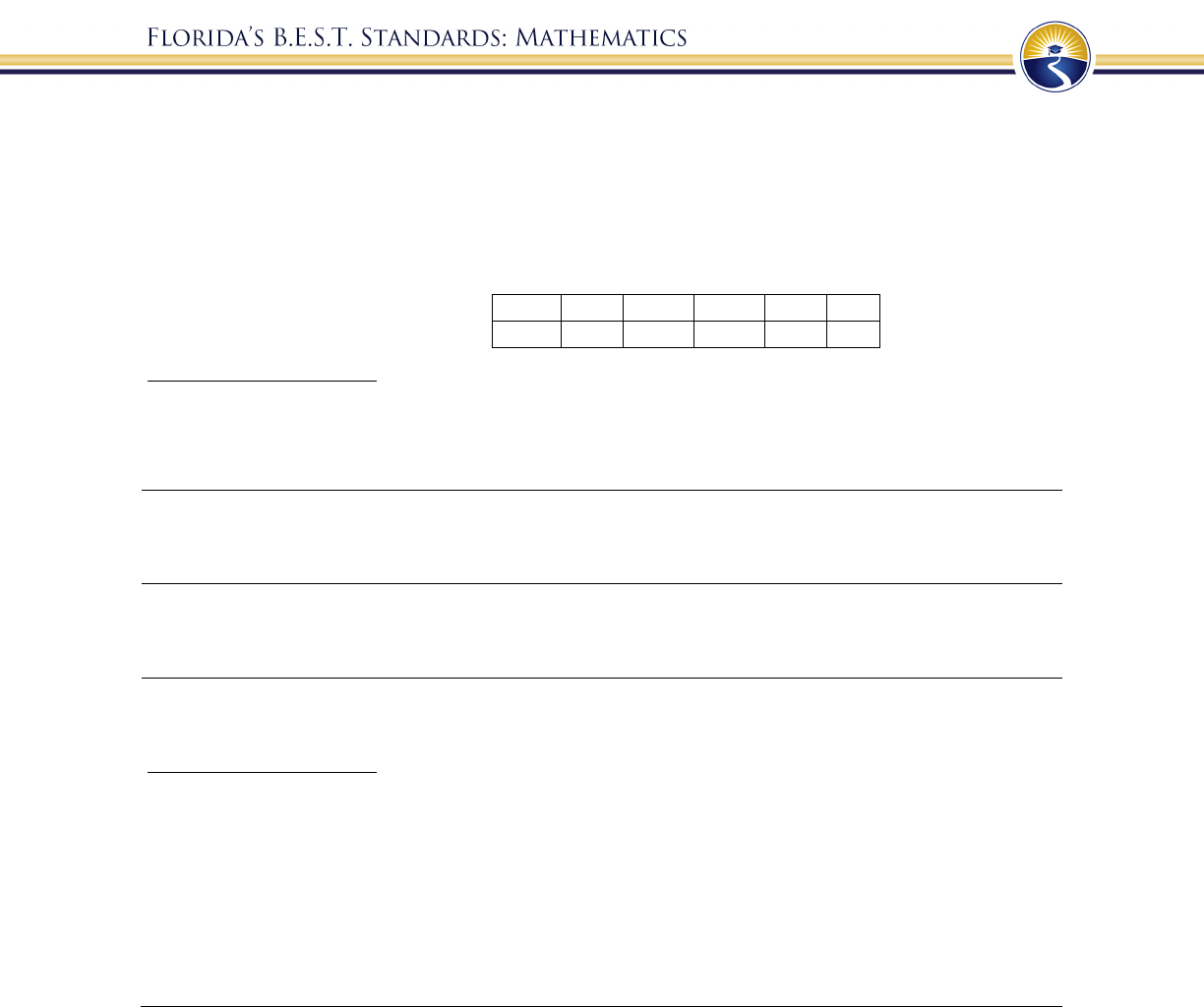
125
MA.912.AR.3.4
Write a quadratic function to represent the relationship between two quantities
from a graph, a written description or a table of values within a mathematical
or real-world context.
Algebra I Example: Given the table of values below from a quadratic function, write
an equation of that function.
-2
-1
0
1
2
()
2
-1
-2
-1
2
Benchmark Clarifications:
Clarification 1: Within the Algebra 1 course, a graph, written description or table of values must include
the vertex and two points that are equidistant from the vertex.
Clarification 2: Instruction includes the use of standard form and vertex form.
MA.912.AR.3.5
Given the -intercepts and another point on the graph of a quadratic function,
write the equation for the function.
MA.912.AR.3.6
Given an expression or equation representing a quadratic function, determine
the vertex and zeros and interpret them in terms of a real-world context.
MA.912.AR.3.7
Given a table, equation or written description of a quadratic function, graph
that function, and determine and interpret its key features.
Benchmark Clarifications:
Clarification 1: Key features are limited to domain; range; intercepts; intervals where the function is
increasing, decreasing, positive or negative; end behavior; vertex; and symmetry.
Clarification 2: Instruction includes the use of standard form and vertex form, and sketching a graph
using the zeros and vertex.
Clarification 3:
Instruction includes representing the domain and range with inequality notation, interval
notation or set-builder notation.
Clarification 4: Within the Algebra 1 course, notations for domain and range are limited to inequality
and set-builder.
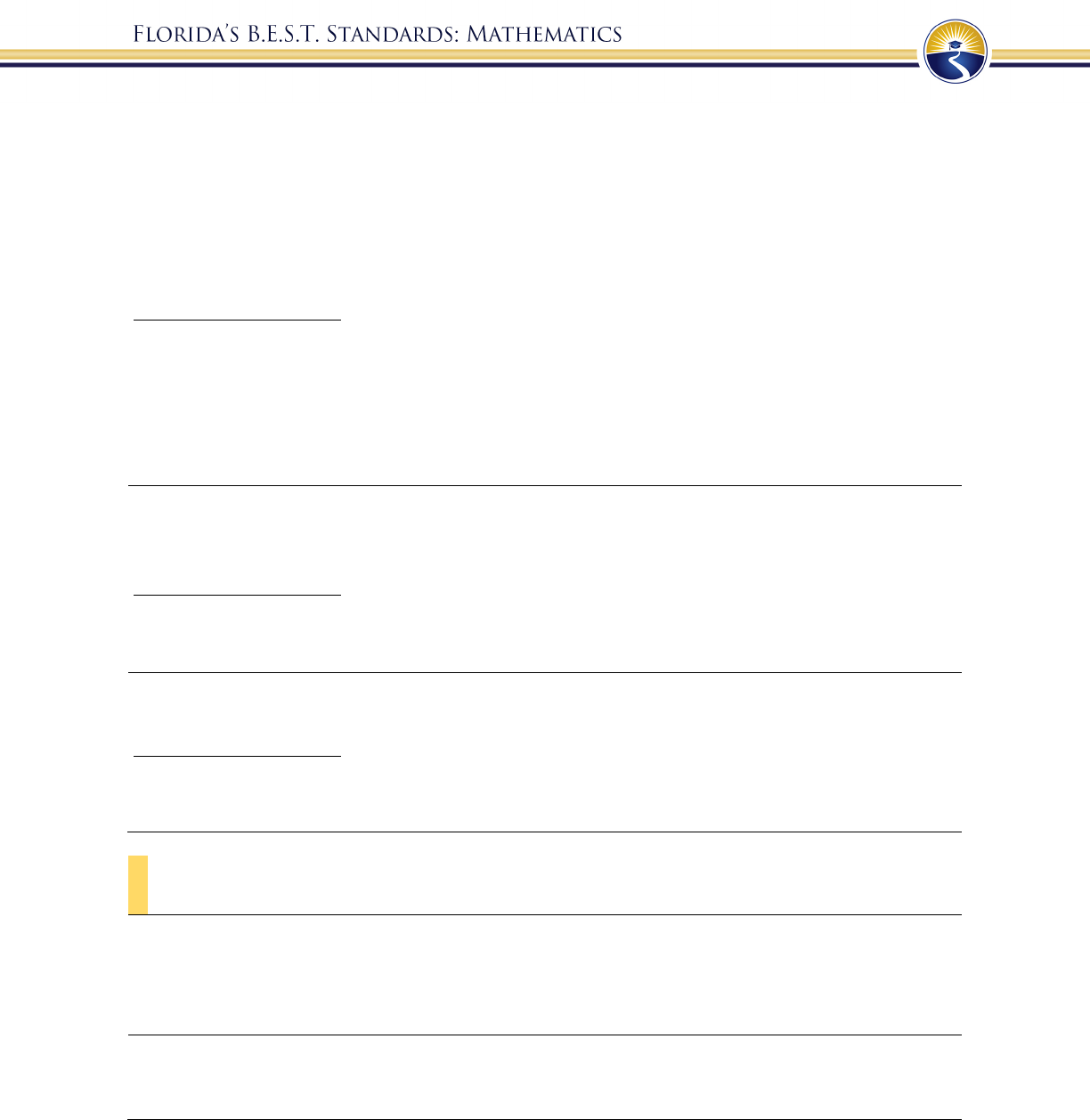
126
MA.912.AR.3.8
Solve and graph mathematical and real-world problems that are modeled
with quadratic functions. Interpret key features and determine constraints in
terms of the context.
Algebra 1 Example: The value of a classic car produced in 1972 can be modeled by
the function
(
)
= 19.25
440+ 3500, where is the
number of years since 1972. In what year does the car’s value
start to increase?
Benchmark Clarifications:
Clarification 1: Key features are limited to domain; range; intercepts; intervals where the function is
increasing, decreasing, positive or negative; end behavior; vertex; and symmetry.
Clarification 2: Instruction includes the use of standard form and vertex form.
Clarification 3: Instruction includes representing constraints with inequalities or set-builder notation.
Clarification 4: Within the Algebra 1 course, notations for domain and range are limited to inequality
and set-builder.
MA.912.AR.3.9
Given a mathematical or real-world context, write two-variable quadratic
inequalities to represent relationships between quantities from a graph or a
written description.
Benchmark Clarifications:
Clarification 1: Instruction includes the use of standard form and vertex form where any inequality
symbol can be represented.
MA.912.AR.3.10
Given a mathematical or real-world context, graph the solution set to a two-
variable quadratic inequality.
Benchmark Clarifications:
Clarification 1: Instruction includes the use of standard form and vertex form where any inequality
symbol can be represented.
MA.912.AR.4 Write, solve and graph absolute value equations, functions and inequalities
in one and two variables.
MA.912.AR.4.1
Given a mathematical or real-world context, write and solve one-variable
absolute value equations.
MA.912.AR.4.2
Given a mathematical or real-world context, write and solve one-variable
absolute value inequalities. Represent solutions algebraically or graphically.
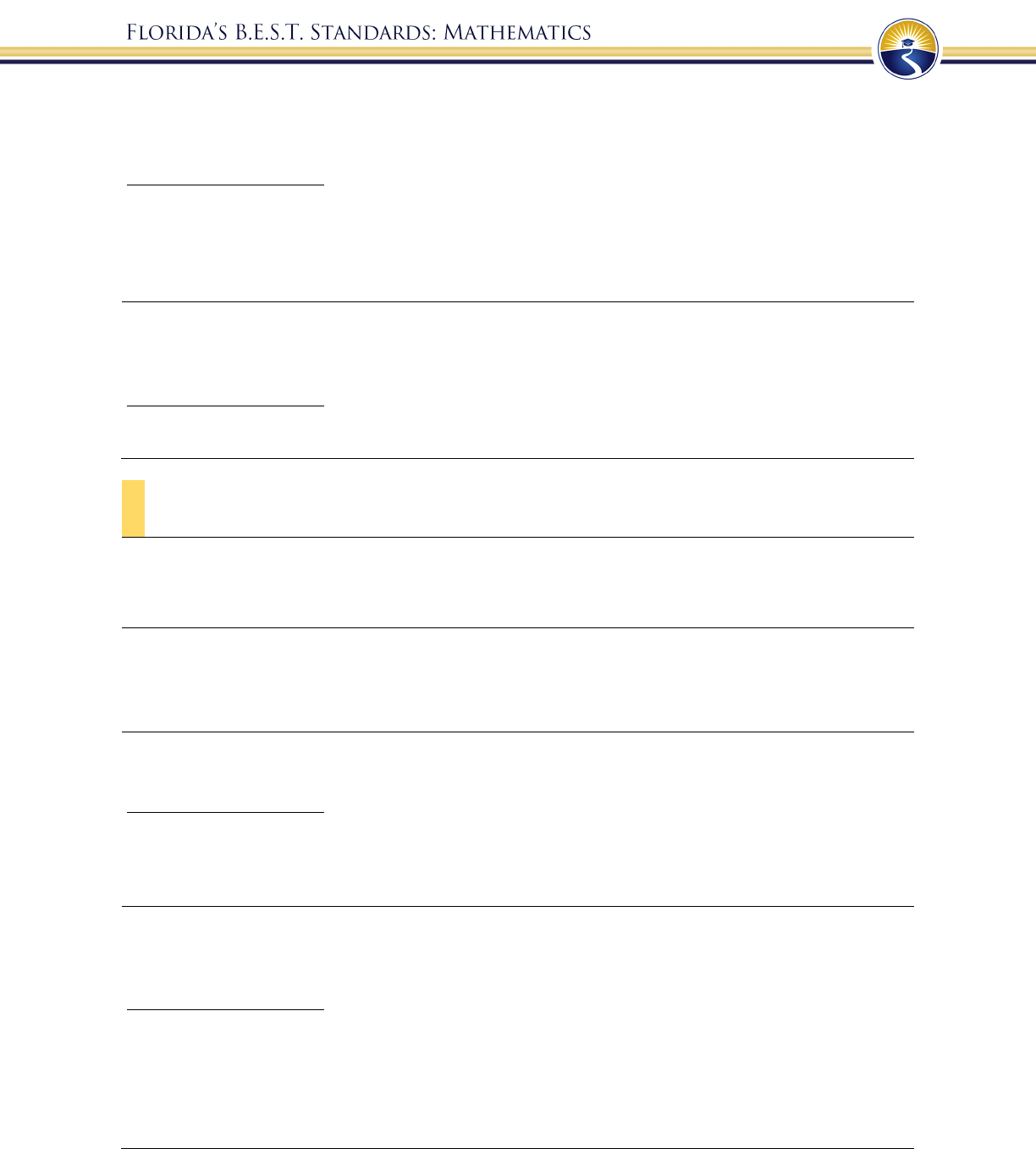
127
MA.912.AR.4.3
Given a table, equation or written description of an absolute value function,
graph that function and determine its key features.
Benchmark Clarifications:
Clarification 1: Key features are limited to domain; range; intercepts; intervals where the function is
increasing, decreasing, positive or negative; vertex; end behavior and symmetry.
Clarification 2: Instruction includes representing the domain and range with inequality notation, interval
notation or set-builder notation.
MA.912.AR.4.4
Solve and graph mathematical and real-world problems that are modeled with
absolute value functions. Interpret key features and determine domain
constraints in terms of the context.
Benchmark Clarifications:
Clarification 1: Instruction includes representing constraints with inequalities or set-builder notation.
MA.912.AR.5 Write, solve and graph exponential and logarithmic equations and
functions in one and two variables.
MA.912.AR.5.1
Solve one-variable exponential equations using the properties of exponents.
MA.912.AR.5.2
Solve equations involving one-variable logarithms or exponents. Interpret
solutions as viable in terms of the context and identify any extraneous
solutions.
MA.912.AR.5.3
Given a mathematical or real-world context, classify an exponential function
as representing growth or decay.
Benchmark Clarifications:
Clarification 1: Within the Algebra 1 course, exponential functions are limited to the forms
(
)
=
, where is a whole number greater than 1 or a unit fraction, or
(
)
= (1 ± )
, where
0 < < 1.
MA.912.AR.5.4
Write an exponential function to represent a relationship between two
quantities from a graph, a written description or a table of values within a
mathematical or real-world context.
Benchmark Clarifications:
Clarification 1: Within the Algebra 1 course, exponential functions are limited to the forms
(
)
=
, where is a whole number greater than 1 or a unit fraction, or
(
)
= (1 ± )
, where
0 < < 1.
Clarification 2: Within the Algebra 1 course, tables are limited to having successive nonnegative integer
inputs so that the function may be determined by finding ratios between successive outputs.
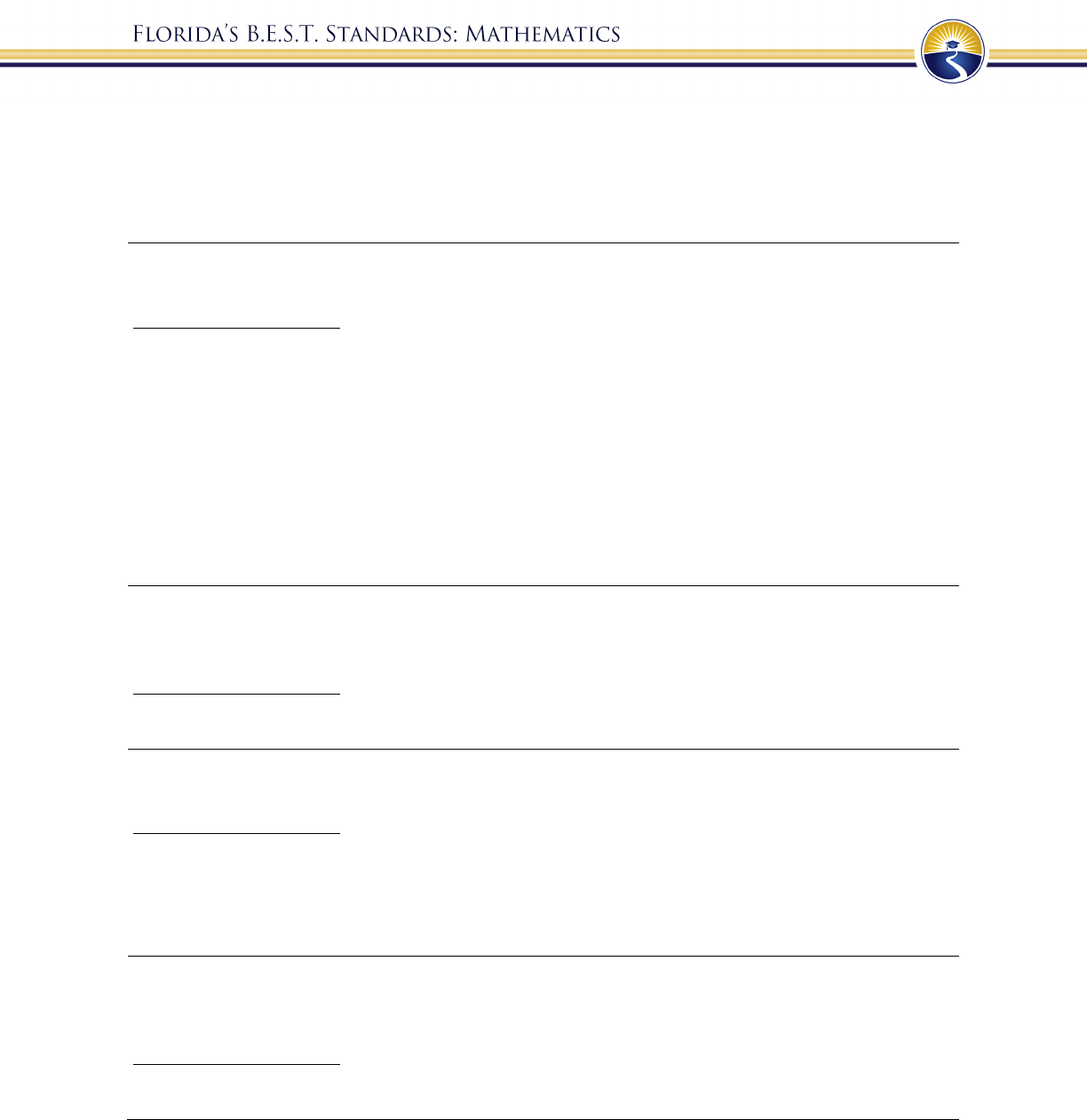
128
MA.912.AR.5.5
Given an expression or equation representing an exponential function, reveal
the constant percent rate of change per unit interval using the properties of
exponents. Interpret the constant percent rate of change in terms of a real-
world context.
MA.912.AR.5.6
Given a table, equation or written description of an exponential function,
graph that function and determine its key features.
Benchmark Clarifications:
Clarification 1: Key features are limited to domain; range; intercepts; intervals where the function is
increasing, decreasing, positive or negative; constant percent rate of change; end behavior and
asymptotes.
Clarification 2:
Instruction includes representing the domain and range with inequality notation, interval
notation or set-builder notation.
Clarification 3: Within the Algebra 1 course, notations for domain and range are limited to inequality
and set-builder.
Clarification 4: Within the Algebra 1 course, exponential functions are limited to the forms
(
)
=
, where is a whole number greater than 1 or a unit fraction or
(
)
= (1 ± )
, where
0 < < 1.
MA.912.AR.5.7
Solve and graph mathematical and real-world problems that are modeled with
exponential functions. Interpret key features and determine domain
constraints in terms of the context.
Benchmark Clarifications:
Clarification 1: Instruction includes representing constraints with inequalities or set-builder notation.
MA.912.AR.5.8
Given a table, equation or written description of a logarithmic function, graph
that function and determine its key features.
Benchmark Clarifications:
Clarification 1: Key features are limited to domain; range; intercepts; intervals where the function is
increasing, decreasing, positive or negative; end behavior; and asymptotes.
Clarification 2: Instruction includes representing the domain and range inequality notation, interval
notation or set-builder notation.
MA.912.AR.5.9
Solve and graph mathematical and real-world problems that are modeled with
logarithmic functions. Interpret key features and determine constraints in
terms of the context.
Benchmark Clarifications:
Clarification 1: Instruction includes representing constraints with inequalities or set-builder notation.
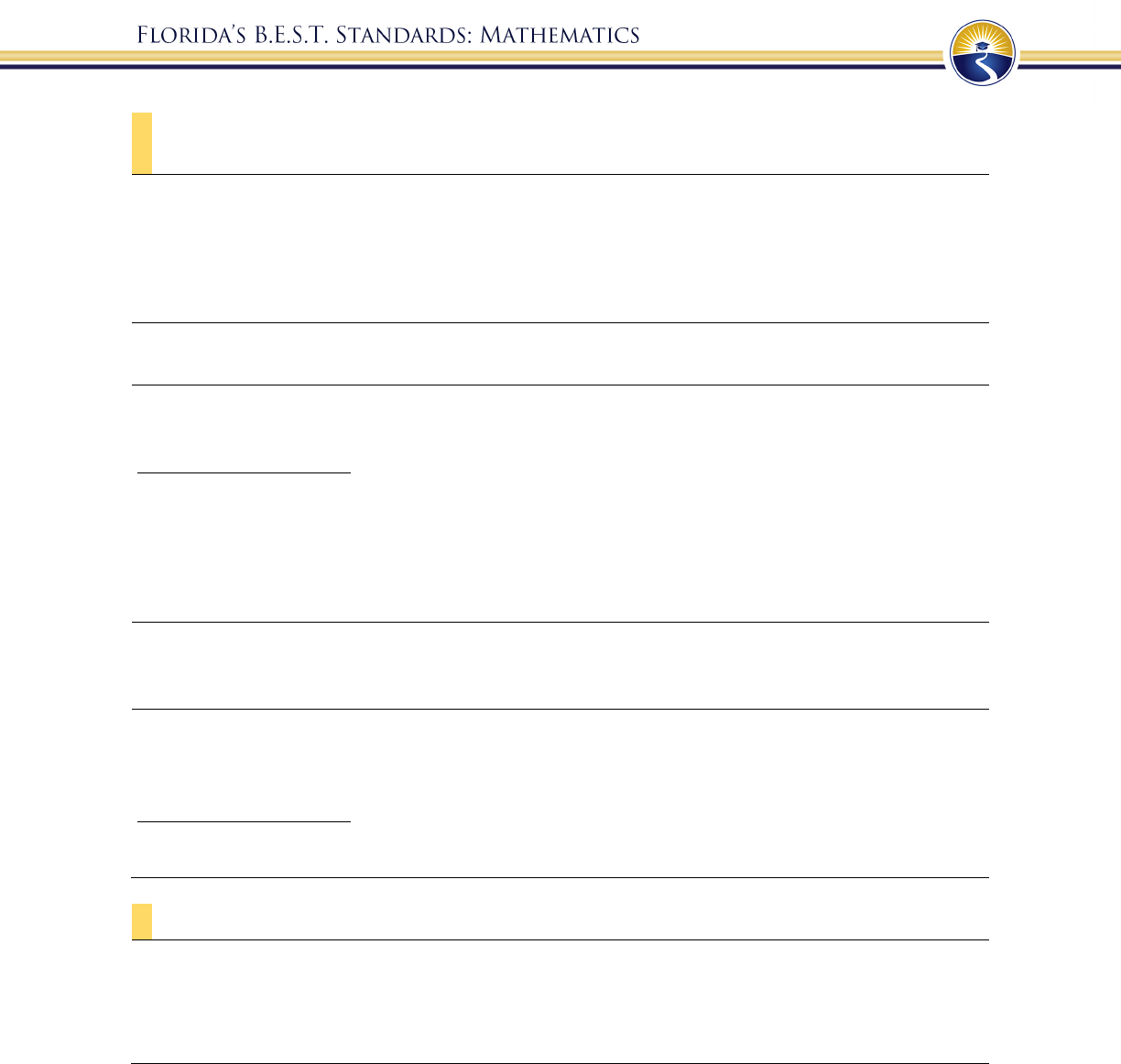
129
MA.912.AR.6 Solve and graph polynomial equations and functions in one and two
variables.
MA.912.AR.6.1
Given a mathematical or real-world context, when suitable factorization is
possible, solve one-variable polynomial equations of degree 3 or higher over
the real and complex number systems.
MA.912.AR.6.2
Explain and apply the Remainder Theorem.
MA.912.AR.6.3
Given a table, equation or written description of a polynomial function of
degree 3 or higher, graph that function and determine its key features.
Benchmark Clarifications:
Clarification 1: Key features are limited to domain; range; intercepts; intervals where the function is
increasing, decreasing, positive or negative; relative maximums and minimums; symmetry; and end
behavior.
Clarification 2: Instruction includes representing the domain and range inequality notation, interval
notation or set-builder notation.
MA.912.AR.6.4
Sketch a rough graph of a polynomial function of degree 3 or higher using
zeros, multiplicity and knowledge of end behavior.
MA.912.AR.6.5
Solve and graph mathematical and real-world problems that are modeled with
polynomial functions of degree 3 or higher. Interpret key features in terms of
the context.
Benchmark Clarifications:
Clarification 1: Instruction includes representing constraints with inequalities or set-builder notation.
MA.912.AR.7 Solve and graph radical equations and functions in one and two variables.
MA.912.AR.7.1
Solve one-variable radical equations. Interpret solutions as viable in terms of
context and identify any extraneous solutions.
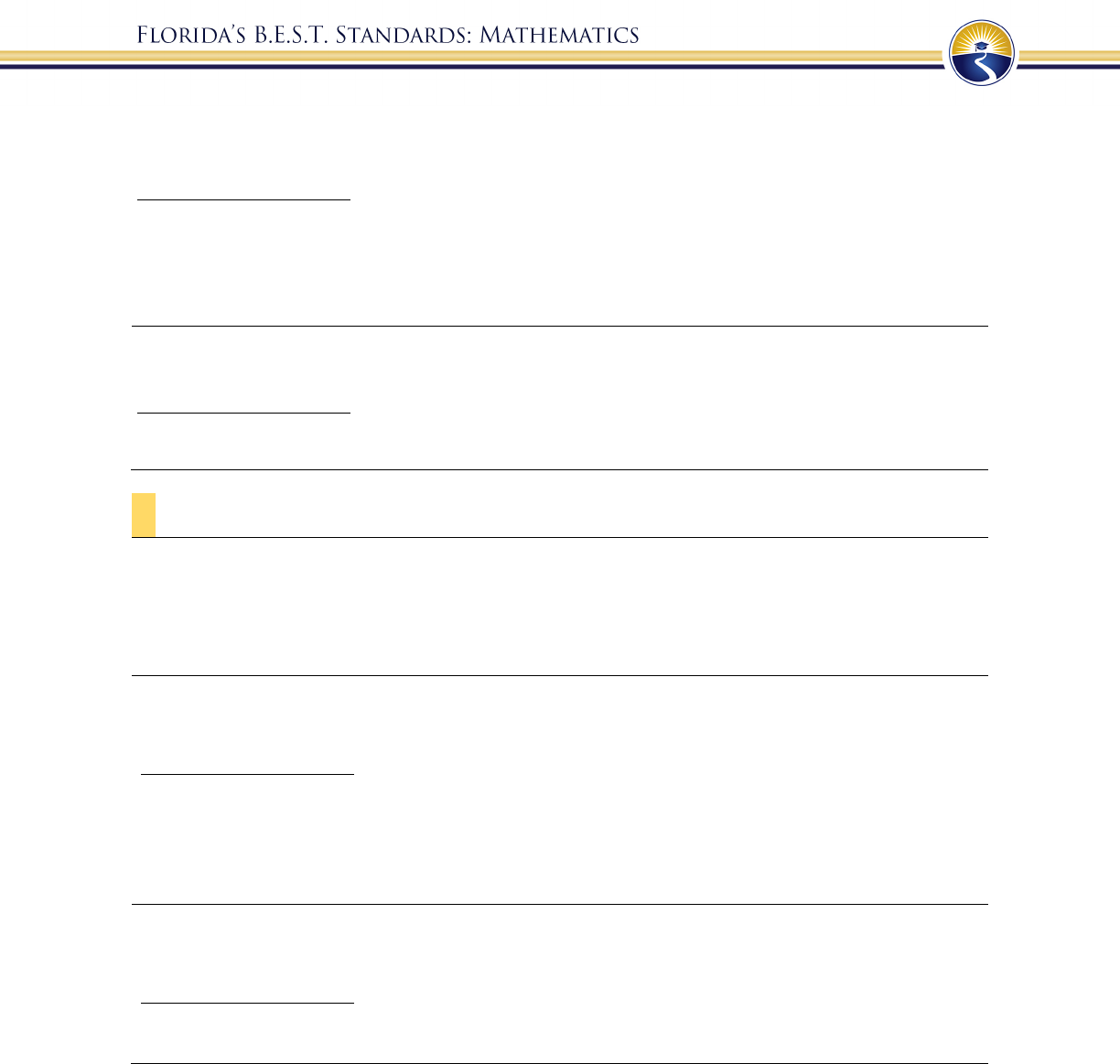
130
MA.912.AR.7.2
Given a table, equation or written description of a square root or cube root
function, graph that function and determine its key features.
Benchmark Clarifications:
Clarification 1: Key features are limited to domain; range; intercepts; intervals where the function is
increasing, decreasing, positive or negative; end behavior; and relative maximums and minimums.
Clarification 2: Instruction includes representing the domain and range inequality notation, interval
notation or set-builder notation.
MA.912.AR.7.3
Solve and graph mathematical and real-world problems that are modeled with
square root or cube root functions. Interpret key features in context.
Benchmark Clarifications:
Clarification 1: Instruction includes representing constraints with inequalities or set-builder notation.
MA.912.AR.8 Solve and graph rational equations and functions in one and two variables.
MA.912.AR.8.1
Write and solve one-variable rational equations. Interpret solutions as viable
in terms of the context and identify any extraneous solutions.
MA.912.AR.8.2
Given a table, equation or written description of a rational function, graph
that function and determine its key features.
Benchmark Clarifications:
Clarification 1: Key features are limited to domain; range; intercepts; intervals where the function is
increasing, decreasing, positive or negative; end behavior; and asymptotes.
Clarification 2: Instruction includes representing the domain and range inequality notation, interval
notation or set-builder notation.
MA.912.AR.8.3
Solve and graph mathematical and real-world problems that are modeled
with rational functions. Interpret key features in terms of the context.
Benchmark Clarifications:
Clarification 1: Instruction includes representing constraints with inequalities or set-builder notation.
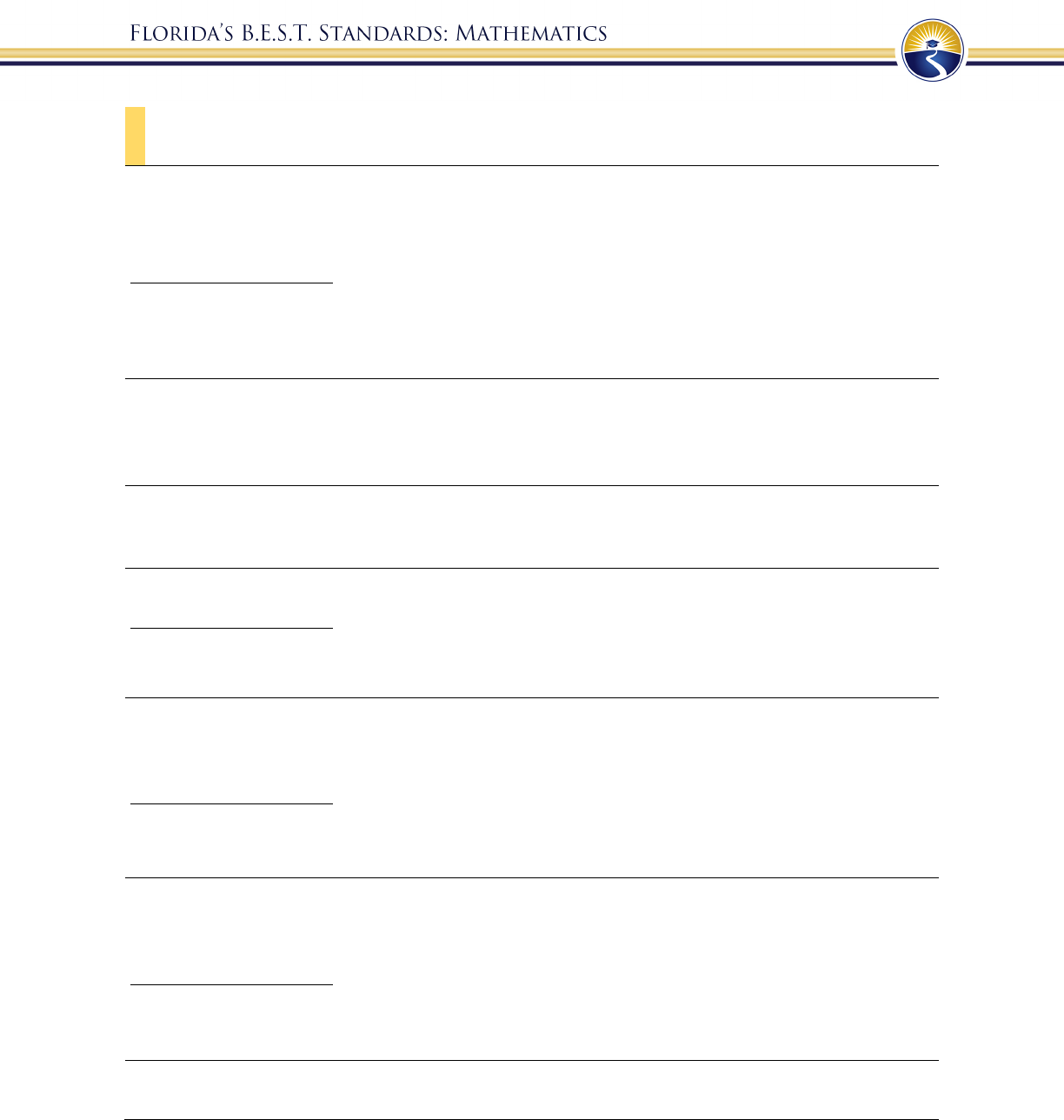
131
MA.912.AR.9 Write and solve a system of two- and three-variable equations and
inequalities that describe quantities or relationships.
MA.912.AR.9.1
Given a mathematical or real-world context, write and solve a system of two-
variable linear equations algebraically or graphically.
Benchmark Clarifications:
Clarification 1: Within this benchmark, the expectation is to solve systems using elimination,
substitution and graphing.
Clarification 2: Within the Algebra 1 course, the system is limited to two equations.
MA.912.AR.9.2
Given a mathematical or real-world context, solve a system consisting of a
two-variable linear equation and a non-linear equation algebraically or
graphically.
MA.912.AR.9.3
Given a mathematical or real-world context, solve a system consisting of two-
variable non-linear equations algebraically or graphically.
MA.912.AR.9.4
Graph the solution set of a system of two-variable linear inequalities.
Benchmark Clarifications:
Clarification 1: Instruction includes cases where one variable has a coefficient of zero.
Clarification 2: Within the Algebra 1 course, the system is limited to two inequalities.
MA.912.AR.9.5
Given a real-world context, represent constraints as systems of linear
equations or inequalities. Interpret solutions to problems as viable or non-
viable options.
Benchmark Clarifications:
Clarification 1: Instruction focuses on analyzing a given function that models a real-world situation and
writing constraints that are represented as linear equations or linear inequalities.
MA.912.AR.9.6
Given a real-world context, represent constraints as systems of non-linear
equations or inequalities. Interpret solutions to problems as viable or non-
viable options.
Benchmark Clarifications:
Clarification 1: Instruction focuses on analyzing a given function that models a real-world situation and
writing constraints that are represented as non-linear equations or non-linear inequalities.
MA.912.AR.9.7
Solve real-world problems involving linear programming.
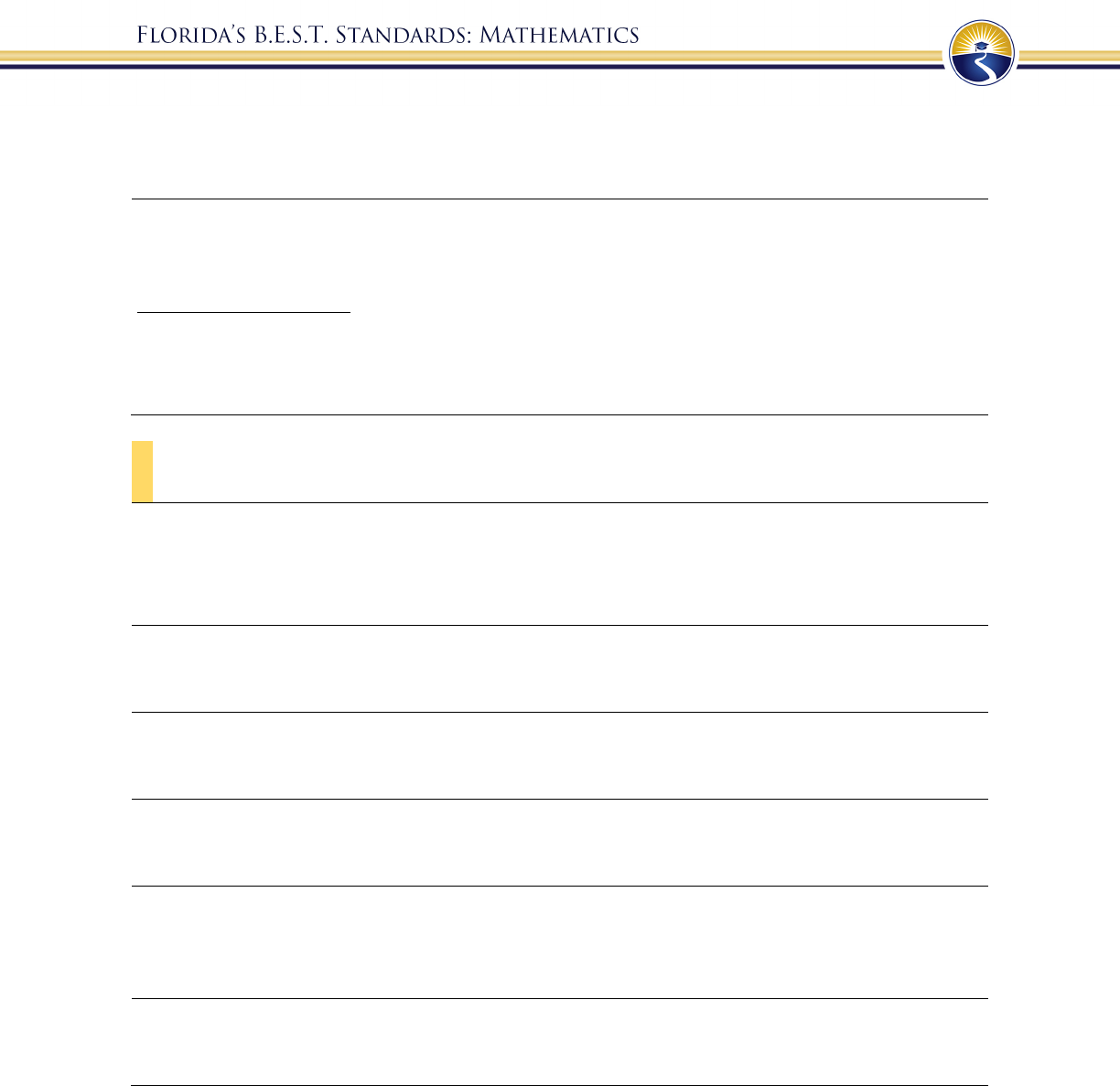
132
MA.912.AR.9.8
Given a mathematical or real-world context, solve a system of three-variable
linear equations algebraically.
MA.912.AR.9.9
Graph and solve mathematical and real-world problems that are modeled with
piecewise functions. Interpret key features and determine constraints in terms
of the context.
Benchmark Clarifications:
Clarification 1: Key features are limited to domain, range, intercepts, asymptotes and end behavior.
Clarification 2: Instruction includes representing the domain and range and constraints using inequality
notation, interval notation or set-builder notation.
MA.912.AR.10 Write and solve sequence and series equations, functions and inequalities
in one and two variables.
MA.912.AR.10.1
Given a mathematical or real-world context, write and solve problems
involving arithmetic sequences.
MA.912.AR.10.2
Given a mathematical or real-world context, write and solve problems
involving geometric sequences.
MA.912.AR.10.3
Recognize and apply the formula for the sum of a finite arithmetic series to
solve mathematical and real-world problems.
MA.912.AR.10.4
Recognize and apply the formula for the sum of a finite or an infinite
geometric series to solve mathematical and real-world problems.
MA.912.AR.10.5
Given a mathematical or real-world context, write a sequence using function
notation, defined explicitly or recursively, to represent relationships between
quantities from a written description.
MA.912.AR.10.6
Given a mathematical or real-world context, find the domain of a given
sequence defined recursively or explicitly.

133
9-12 Functions Strand
MA.912.F.1 Understand, compare and analyze properties of functions.
MA.912.F.1.1
Given an equation or graph that defines a function, determine the function type.
Given an input-output table, determine a function type that could represent it.
Benchmark Clarifications:
Clarification 1: Within the Algebra 1 course, functions represented as tables are limited to linear,
quadratic and exponential.
Clarification 2: Within the Algebra 1 course, functions represented as equations or graphs are limited to
vertical or horizontal translations or reflections over the -axis of the following parent functions:
(
)
= ,
(
)
=
,
(
)
=
,
(
)
=
,
(
)
=
3
,
(
)
=
|
|
,
(
)
= 2
and
(
)
=
.
MA.912.F.1.2
Given a function represented in function notation, evaluate the function for an
input in its domain. For a real-world context, interpret the output.
Algebra 1 Example: The function
(
)
=
8 models Alicia’s position in miles
relative to a water stand minutes into a marathon. Evaluate and
interpret for a quarter of an hour into the race.
MA.912.F.1.3
Calculate and interpret the average rate of change of a real-world situation
represented graphically, algebraically or in a table over a specified interval.
Benchmark Clarifications:
Clarification 1: Instruction includes making the connection to the slope of a linear function.
MA.912.F.1.4
Demonstrate understanding of the concept of limit and estimate limits from
graphs and tables of values, as related to the concept of the derivative of a
function.
MA.912.F.1.5
Compare key features of linear and nonlinear functions each represented in the
same way, such as algebraically, graphically, in tables or written descriptions.
Benchmark Clarifications:
Clarification 1: Key features are limited to domain; range; intercepts; intervals where the function is
increasing, decreasing, positive or negative; end behavior and asymptotes.
Clarification 2: Within the Algebra 1 course, functions other than linear, quadratic or exponential must
be represented graphically.
Clarification 3: Within the Algebra 1 course, instruction includes verifying that a quantity increasing
exponentially eventually exceeds a quantity increasing linearly or quadratically.
MA.912.F.1.6
Compare key features of two functions each represented in a different way such
as algebraically, graphically, in tables or written descriptions.

134
MA.912.F.1.7
Determine whether a linear, quadratic or exponential function best models a
given real-world situation.
Benchmark Clarifications:
Clarification 1: Instruction includes recognizing that linear functions model situations in which a
quantity changes by a constant amount per unit interval; that quadratic functions model situations in
which a quantity increases to a maximum, then begins to decrease or a quantity decreases to a minimum,
then begins to increase; and that exponential functions model situations in which a quantity grows or
decays by a constant percent per unit interval.
Clarification 2: Within this benchmark, the expectation is to identify the type of function from a written
description or table.
MA.912.F.1.8
Determine whether a function is even, odd or neither when represented
algebraically, graphically or in a table.
MA.912.F.2 Identify and describe the effects of transformations on functions. Create new
functions given transformations.
MA.912.F.2.1
Identify the effect on the graph or table of a given function after replacing ()
by
(
)
+ , () and (+ ) for specific values of .
Benchmark Clarifications:
Clarification 1: Within the Algebra 1 course, functions are limited to linear, quadratic and absolute
value.
Clarification 2: Instruction focuses on including positive and negative values for .
MA.912.F.2.2
Identify the effect on the graph of a given function of two or more
transformations defined by adding a real number to the - or - values or
multiplying the - or - values by a real number.
MA.912.F.2.3
Given the graph or table of () and the graph or table of
(
)
+ , (),
() and (+ ), state the type of transformation and find the value of the
real number .
Benchmark Clarifications:
Clarification 1: Within the Algebra 1 course, functions are limited to linear, quadratic and absolute
value.
MA.912.F.2.4
Given the graph or table of values of two or more transformations of a function,
state the type of transformation and find the values of the real number that
defines the transformation.

135
MA.912.F.2.5
Given two or more transformations and a function, create the table or graph of
the transformed function.
MA.912.F.2.6
Given a graph or table of values of two or more transformations of a function,
write the equation of the transformed function.
MA.912.F.3 Create new functions from existing functions.
MA.912.F.3.1
Given a mathematical or real-world context, combine two functions, limited to
linear and quadratic, using arithmetic operations. When appropriate, include
domain restrictions for the new function.
Example: The quotient of the functions
(
)
= 3
7+ 3 and
(
)
= 61 can
be expressed as
(
)
=
, where the domain of
(
)
is <
and
< .
Benchmark Clarifications:
Clarification 1: Instruction includes representing domain restrictions with inequality notation, interval
notation or set-builder notation.
MA.912.F.3.2
Given a mathematical or real-world context, combine two or more functions,
limited to linear, quadratic, exponential and polynomial, using arithmetic
operations. When appropriate, include domain restrictions for the new function.
Benchmark Clarifications:
Clarification 1: Instruction includes representing domain restrictions with inequality notation, interval
notation or set-builder notation.
MA.912.F.3.3
Solve mathematical and real-world problems involving functions that have been
combined using arithmetic operations.
MA.912.F.3.4
Compose functions within a mathematical or real-world context. Determine the
domain and range of the composite function.
MA.912.F.3.5
Solve mathematical and real-world problems involving composite functions.
MA.912.F.3.6
Determine whether an inverse function exists by analyzing tables, graphs and
equations.

136
MA.912.F.3.7
Represent the inverse of a function algebraically, graphically or in a table. Use
composition of functions to verify that one function is the inverse of the other.
MA.912.F.3.8
Produce an invertible function from a non-invertible function by restricting the
domain.
MA.912.F.3.9
Solve mathematical and real-world problems involving inverse functions.

137
9-12 Financial Literacy Strand
MA.912.FL.1 Determine simple and compound interest and demonstrate its relationship
to functions. Calculate and use net present and net future values.
MA.912.FL.1.1
Compare simple, compound and continuously compounded interest over time.
MA.912.FL.1.2
Solve problems involving simple, compound and continuously compounded
interest, including determining the present value and future value of money.
Benchmark Clarifications:
Clarification 1: Within the Algebra 1 course, interest is limited to simple and compound.
MA.912.FL.1.3
Explain the relationship between simple interest and linear growth.
MA.912.FL.1.4
Explain the relationship between compound interest and exponential growth
and the relationship between continuously compounded interest and
exponential growth.
Benchmark Clarifications:
Clarification 1: Within the Algebra 1 course, exponential growth is limited to compound interest.
MA.912.FL.1.5
Determine the consumer price index (CPI) for goods. Interpret its value in
terms of the context.
MA.912.FL.1.6
Solve problems involving potential profit and actual cost.
MA.912.FL.2 Describe the advantages and disadvantages of short-term and long-term
purchases.
MA.912.FL.2.1
Compare the advantages and disadvantages of using cash versus personal
financing options or other forms of electronic payment.
MA.912.FL.2.2
Calculate the finance charges and total amount due on a bill using various
forms of credit.
MA.912.FL.2.3
Manipulate a variety of variables to compare the advantages and
disadvantages of deferred payments.

138
MA.912.FL.2.4
Calculate the total cost of purchasing consumer durables over time given
different monthly payments, down payments, financing options and fees.
MA.912.FL.2.5
Calculate the fees associated with a mortgage.
Benchmark Clarifications:
Clarification 1: Fees include discount prices, origination fee, maximum brokerage fee on a net or
gross loan, documentary stamps and prorated expenses.
MA.912.FL.2.6
Substitute values to evaluate a variety of mortgage formulas.
Benchmark Clarifications:
Clarification 1: Formulas include front-end ratio, total debt-to-income ratio, loan-to-value ratio
(LTV), combined loan-to-value ratio (CLTV) and amount of interest paid over the life of a loan.
MA.912.FL.2.7
Solve problems involving student, personal and car loans, including finding
the total amount to be paid, adjustable rates and refinancing options.
MA.912.FL.2.8
Calculate the final payout amount for a balloon mortgage.
MA.912.FL.2.9
Compare the cost of paying a higher interest rate and fewer mortgage points
versus a lower interest rate and more mortgage points.
MA.912.FL.2.10
Calculate the total amount paid for the life of a loan including the down
payment, fees and interest.
MA.912.FL.2.11
Calculate and compare, in terms of functions, the total cost for a set purchase
price using a fixed rate, adjustable rate and a balloon mortgage.
MA.912.FL.2.12
Compare interest rate calculations and annual percentage rate calculations,
and distinguish between the two rates.
MA.912.FL.3 Develop personal financial skills and describe the advantages and
disadvantages of financial and investment plans.
MA.912.FL.3.1
Develop personal budgets that fit within various income brackets.
MA.912.FL.3.2
Calculate the break-even point to determine the viability of purchasing
options for housing, car and other durable goods.

139
MA.912.FL.3.3
Explain cash management strategies including checking and savings
accounts.
MA.912.FL.3.4
Given assets and liabilities, calculate net worth.
MA.912.FL.3.5
Given a scenario, establish a plan to pay off debt.
MA.912.FL.3.6
Given a scenario, complete and calculate federal income tax, analyzing
different options such as standard deductions versus itemized deductions and
taxes owed based on income brackets from the tax table.
MA.912.FL.3.7
Calculate and compare various options and fees for medical, car,
homeowners and life insurance.
MA.912.FL.3.8
Collect, organize and interpret data to determine an effective retirement
savings plan to meet personal financial goals.
MA.912.FL.3.9
Solve problems involving different types of retirement plans, including
traditional IRA, Roth, IRA, 401K, 403B and annuities.
MA.912.FL.3.10
Compare different ways that portfolios can be diversified in both investments
and investment vehicles.
MA.912.FL.3.11
Purchase stock with a set amount of money, and evaluate its worth over time
considering gains, losses and selling, taking into account any associated fees.
MA.912.FL.3.12
Compare income from purchase of common stock, preferred stock and bonds.
MA.912.FL.3.13
Given current exchange rates, convert between currencies.
MA.912.FL.3.14
Apply data to compare historical rates of return on investments with
investment claims to make informed decisions and identify potential fraud.

140
9-12 Geometric Reasoning Strand
MA.912.GR.1 Prove and apply geometric theorems to solve problems.
MA.912.GR.1.1
Prove relationships and theorems about lines and angles. Solve mathematical
and real-world problems involving postulates, relationships and theorems of
lines and angles.
Benchmark Clarifications:
Clarification 1: Theorems include vertical angles are congruent; when a transversal crosses parallel
lines, alternate interior angles are congruent and corresponding angles are congruent; points on a
perpendicular bisector of a line segment are exactly those equidistant from the segment’s endpoints.
Clarification 2: Instruction includes constructing two-column proofs, pictorial proofs, paragraph and
narrative proofs, flow chart proofs and informal proofs.
MA.912.GR.1.2
Prove triangle congruence or similarity using Side-Side-Side, Side-Angle-
Side, Angle-Side-Angle, Angle-Angle-Side, Angle-Angle and Hypotenuse-
Leg.
Benchmark Clarifications:
Clarification 1: Instruction includes constructing two-column proofs, pictorial proofs, paragraph and
narrative proofs, flow chart proofs and informal proofs.
MA.912.GR.1.3
Prove relationships and theorems about triangles. Solve mathematical and
real-world problems involving postulates, relationships and theorems of
triangles.
Benchmark Clarifications:
Clarification 1: Theorems include measures of interior angles of a triangle sum to 180°; measures of a
set of angles of a triangle sum to 360°; triangle inequality theorem; base angles of isosceles triangles are
congruent; the segment joining midpoints of two sides of a triangle is parallel to the third side and half
the length; the medians of a triangle meet at a point.
Clarification 2: Instruction includes constructing two-column proofs, pictorial proofs, paragraph and
narrative proofs, flow chart proofs and informal proofs.
MA.912.GR.1.4
Prove relationships and theorems about parallelograms. Solve mathematical
and real-world problems involving postulates, relationships and theorems of
parallelograms.
Benchmark Clarifications:
Clarification 1: Theorems include opposite sides are congruent, consecutive angles are supplementary,
opposite angles are congruent, the diagonals of a parallelogram bisect each other, and rectangles are
parallelograms with congruent diagonals.
Clarification 2: Instruction includes constructing two-column proofs, pictorial proofs, paragraph and
narrative proofs, flow chart proofs and informal proofs.

141
MA.912.GR.1.5
Prove relationships and theorems about trapezoids. Solve mathematical and
real-world problems involving postulates, relationships and theorems of
trapezoids.
Benchmark Clarifications:
Clarification 1: Theorems include the Trapezoid Midsegment Theorem and for isosceles trapezoids:
base angles are congruent, opposite angles are supplementary and diagonals are congruent.
Clarification 2: Instruction includes constructing two-column proofs, pictorial proofs, paragraph and
narrative proofs, flow chart proofs and informal proofs.
MA.912.GR.1.6
Solve mathematical and real-world problems involving congruence or
similarity in two-dimensional figures.
Benchmark Clarifications:
Clarification 1: Instruction includes demonstrating that two-
dimensional figures are congruent or similar
based on given information.
MA.912.GR.2 Apply properties of transformations to describe congruence or similarity.
MA.912.GR.2.1
Given a preimage and image, describe the transformation and represent the
transformation algebraically using coordinates.
Benchmark Clarifications:
Clarification 1:
Instruction includes the connection of transformations to functions that take points in the
plane as inputs and give other points in the plane as outputs.
Clarification 2: Transformations include translations, dilations, rotations and reflections.
Clarification 3: Within the Geometry course, rotations are limited to 90°, 180° and 270°
counterclockwise about the center of rotation, and the centers of rotations and dilations are limited to the
origin or a point on the figure.
MA.912.GR.2.2
Identify transformations that do or do not preserve distance.
Benchmark Clarifications:
Clarification 1: Transformations include translations, dilations, rotations and reflections.
Clarification 2: Instruction includes recognizing that these transformations preserve angle measure.
MA.912.GR.2.3
Specify a sequence of transformations that will map a given figure onto itself
or onto another congruent or similar figure.
Benchmark Clarifications:
Clarification 1: Transformations include translations, dilations, rotations and reflections.
Clarification 2: Given figures and transformed figures must be the same type of two-dimensional figure.
Clarification 3: Within the Geometry course, figures are limited to triangles and quadrilaterals and
rotations are limited to 90°, 180° and 270° counterclockwise about the center of rotation.
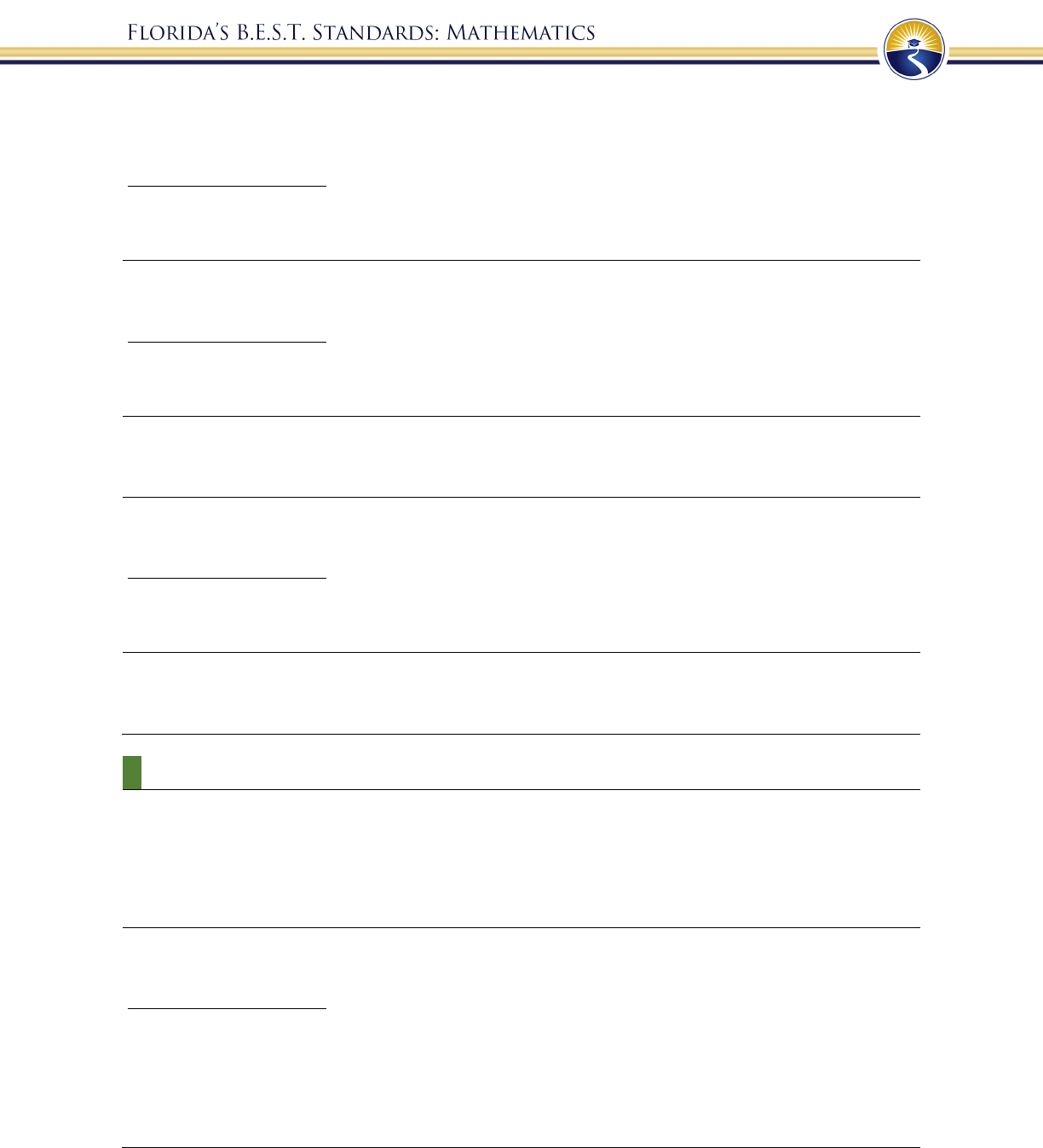
142
MA.912.GR.2.4
Given a geometric figure and a sequence of transformations, draw the
transformed figure on a coordinate plane.
Benchmark Clarifications:
Clarification 1: Transformations include translations, dilations, rotations and reflections.
Clarification 2: Instruction includes two or more transformations.
MA.912.GR.2.5
Apply rigid transformations to map one figure onto another to justify that the
two figures are congruent.
Benchmark Clarifications:
Clarification 1: Instruction includes showing that the corresponding sides and the corresponding angles
are congruent.
MA.912.GR.2.6
Justify the criteria for triangle congruence using the definition of congruence
in terms of rigid transformations.
MA.912.GR.2.7
Apply an appropriate transformation to map one figure onto another to justify
that the two figures are similar.
Benchmark Clarifications:
Clarification 1: Instruction includes showing that the corresponding sides are proportional, and the
corresponding angles are congruent.
MA.912.GR.2.8
Justify the criteria for triangle similarity using the definition of similarity in
terms of non-rigid transformations.
MA.912.GR.3 Use coordinate geometry to solve problems or prove relationships.
MA.912.GR.3.1
Given a mathematical or real-world context, use coordinate geometry to
classify or justify definitions, properties and theorems involving circles,
triangles or quadrilaterals.
MA.912.GR.3.2
Solve geometric problems involving circles, triangles and quadrilaterals on the
coordinate plane.
Benchmark Clarifications:
Clarification 1: Problems involving quadrilaterals include using parallel and perpendicular slope
criteria.
Clarification 2: Problems involving triangles include median and centroid.
Clarification 3: Problems involving circles include determining points on a given circle and finding
tangent lines.

143
MA.912.GR.3.3
Solve mathematical and real-world problems on the coordinate plane that
involve finding the coordinates of a point on a line segment including the
midpoint.
MA.912.GR.3.4
Solve mathematical and real-world problems on the coordinate plane
involving perimeter or area of polygons.
MA.912.GR.4 Use geometric measurement and dimensions to solve problems.
MA.912.GR.4.1
Identify the shapes of two-dimensional cross-sections of three-dimensional
figures.
MA.912.GR.4.2
Identify three-dimensional objects generated by rotations of two-dimensional
figures.
MA.912.GR.4.3
Determine how changes in dimensions affect the area of two-dimensional
figures and the surface area or volume of three-dimensional figures.
Geometry Example: Mike is having a graduation party and wants to make sure he has
enough pizza. Should he order one 12-inch pizza or three 6-inch
pizzas?
MA.912.GR.4.4
Solve mathematical and real-world problems involving the area of two-
dimensional figures.
Benchmark Clarifications:
Clarification 1: Instruction includes concepts of population density based on area.
MA.912.GR.4.5
Solve mathematical and real-world problems involving the volume of three-
dimensional figures limited to cylinders, pyramids, prisms, cones and spheres.
Benchmark Clarifications:
Clarification 1: Instruction includes concepts of density based on volume.
Clarification 2: Instruction includes using Cavalieri’s Principle to give informal arguments about the
formulas for the volumes of right and non-right cylinders, pyramids, prisms and cones.
MA.912.GR.4.6
Solve mathematical and real-world problems involving the surface area of
three-dimensional figures limited to cylinders, pyramids, prisms, cones and
spheres.
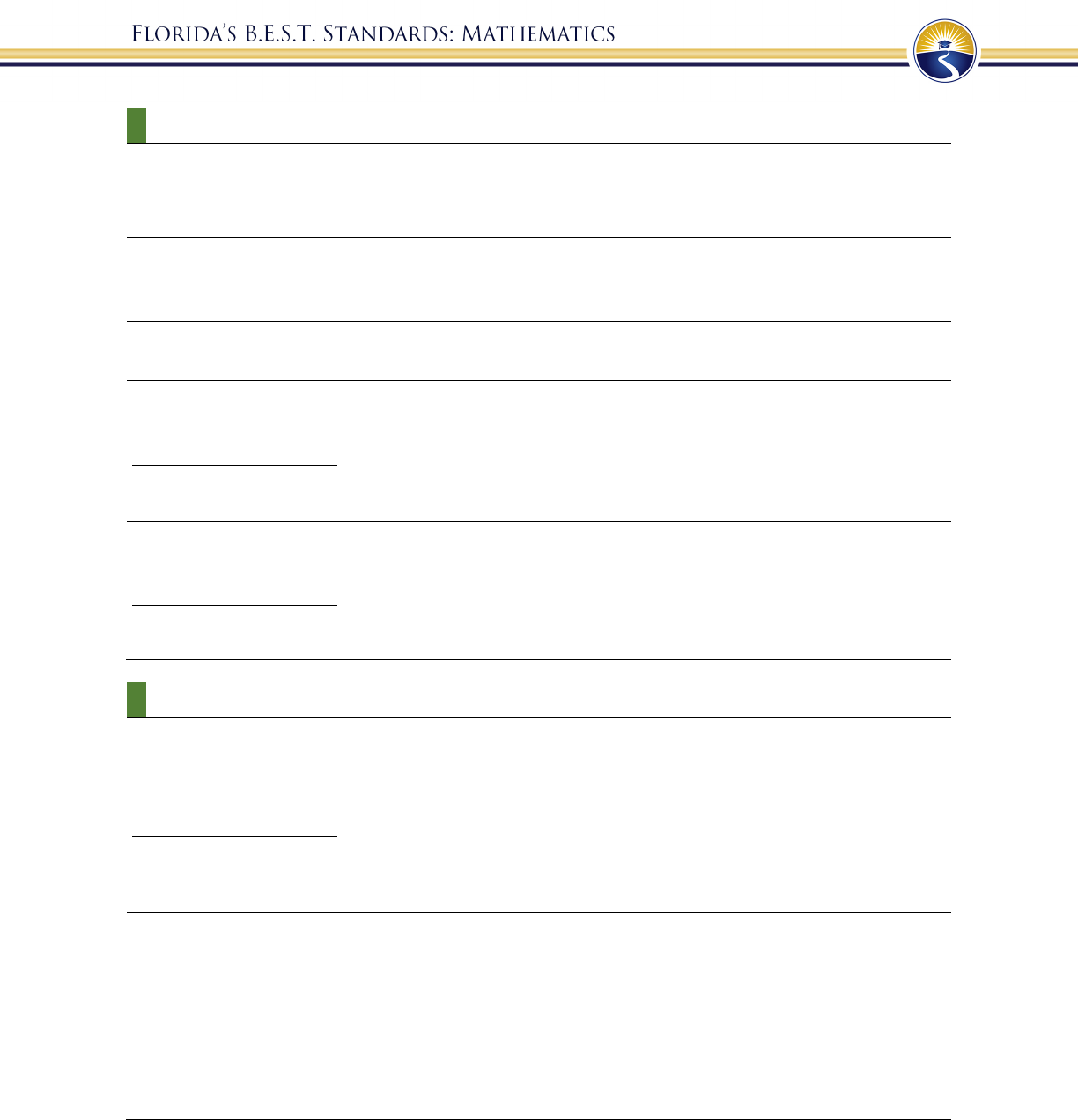
144
MA.912.GR.5 Make formal geometric constructions with a variety of tools and methods.
MA.912.GR.5.1
Construct a copy of a segment or an angle.
MA.912.GR.5.2
Construct the bisector of a segment or an angle, including the perpendicular
bisector of a line segment.
MA.912.GR.5.3
Construct the inscribed and circumscribed circles of a triangle.
MA.912.GR.5.4
Construct a regular polygon inscribed in a circle. Regular polygons are limited
to triangles, quadrilaterals and hexagons.
Benchmark Clarifications:
Clarification 1: When given a circle, the center must be provided.
MA.912.GR.5.5
Given a point outside a circle, construct a line tangent to the circle that passes
through the given point.
Benchmark Clarifications:
Clarification 1: When given a circle, the center must be provided.
MA.912.GR.6 Use properties and theorems related to circles.
MA.912.GR.6.1
Solve mathematical and real-world problems involving the length of a secant,
tangent, segment or chord in a given circle.
Benchmark Clarifications:
Clarification 1: Problems include relationships between two chords; two secants; a secant and a tangent;
and the length of the tangent from a point to a circle.
MA.912.GR.6.2
Solve mathematical and real-world problems involving the measures of arcs
and related angles, limited to central, inscribed and intersections of a chord,
secants or tangents.
Benchmark Clarifications:
Clarification 1: Problems include relationships between inscribed angles; central angles; and angles
formed by the following intersections: two
secants, a tangent and a secant, two tangents, two chords, and
a perpendicular bisector and a chord.

145
MA.912.GR.6.3
Solve mathematical problems involving triangles and quadrilaterals inscribed
in a circle.
Benchmark Clarifications:
Clarification 1: Instruction includes triangles in a circle and semicircle.
MA.912.GR.6.4
Solve mathematical and real-world problems involving the arc length and area
of a sector in a given circle.
Benchmark Clarifications:
Clarification 1:
Instruction focuses on the conceptual understanding that the length of the arc intercepted
by an angle is proportional to the radius.
MA.912.GR.6.5
Apply transformations to prove that all circles are similar.
MA.912.GR.7 Apply geometric and algebraic representations of conic sections.
MA.912.GR.7.1
Identify the conic resulting from the cross-section of cones.
MA.912.GR.7.2
Given a mathematical or real-world context, derive and create the equation of
a circle using key features.
Benchmark Clarifications:
Clarification 1: Instruction includes using the Pythagorean Theorem and completing the square.
Clarification 2: Within the Geometry course, key features are limited to the radius, diameter and the
center.
MA.912.GR.7.3
Graph and solve mathematical and real-world problems that are modeled with
an equation of a circle. Determine and interpret key features in terms of the
context.
Benchmark Clarifications:
Clarification 1: Key features are limited to domain, range, center and radius.
Clarification 2: Instruction includes representing the domain and range with inequality notation, interval
notation or set-builder notation.
MA.912.GR.7.4
Given a mathematical or real-world context, derive and create the equation of
a parabola using key features.
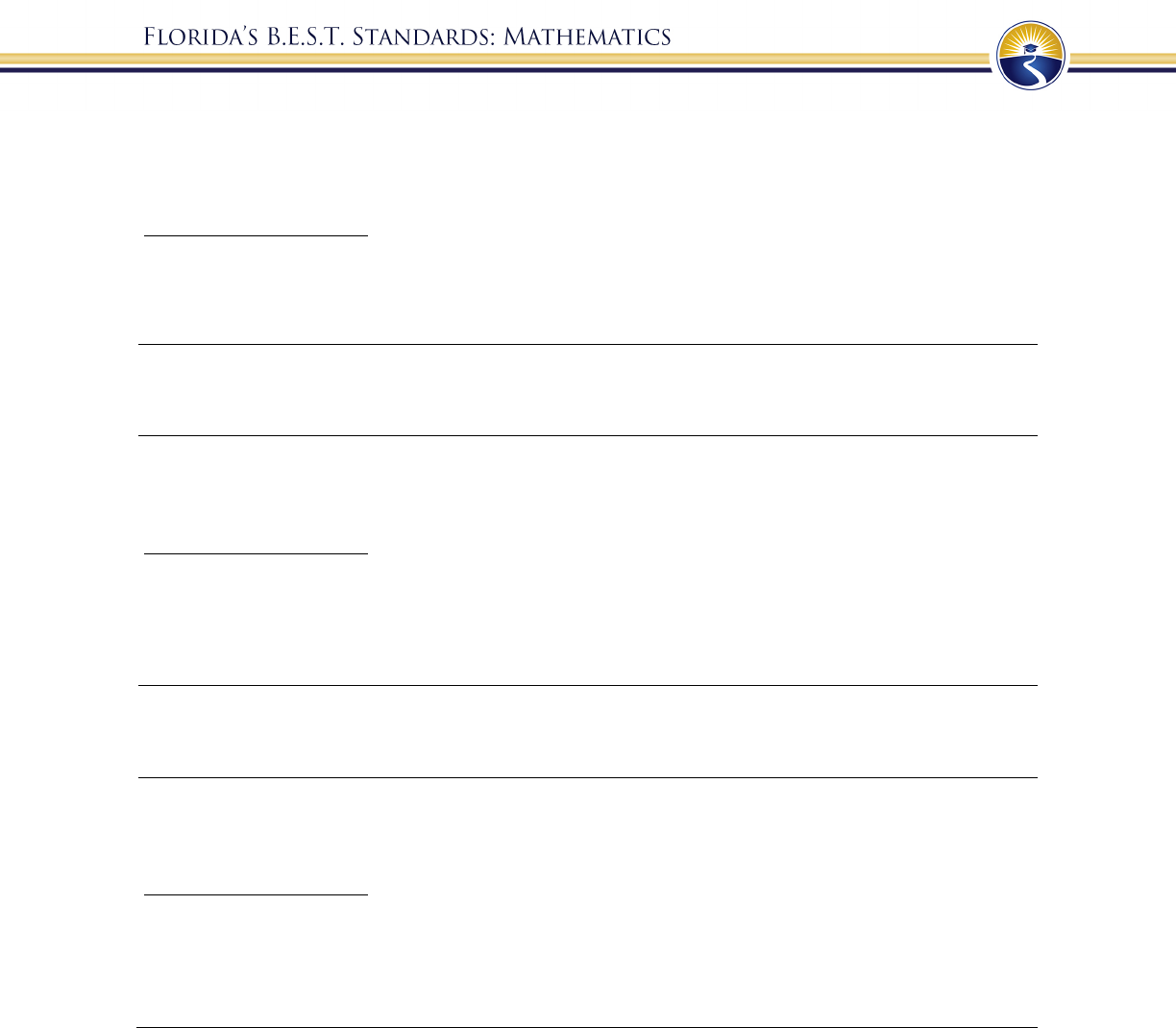
146
MA.912.GR.7.5
Graph and solve mathematical and real-world problems that are modeled with
an equation of a parabola. Determine and interpret key features in terms of the
context.
Benchmark Clarifications:
Clarification 1: Key features are limited to domain, range, intercepts, focus, vertex and directrix.
Clarification 2: Instruction includes representing the domain and range with inequality notation, interval
notation or set-builder notation.
MA.912.GR.7.6
Given a mathematical or real-world context, derive and create the equation of
an ellipse using key features.
MA.912.GR.7.7
Graph and solve mathematical and real-world problems that are modeled with
an equation of an ellipse. Determine and interpret key features in terms of the
context.
Benchmark Clarifications:
Clarification 1: Key features are limited to domain, range, center, foci, major axis, minor axis and
vertices.
Clarification 2: Instruction includes representing the domain and range with inequality notation, interval
notation or set-builder notation.
MA.912.GR.7.8
Given a mathematical or real-world context, derive and create the equation of
a hyperbola using key features.
MA.912.GR.7.9
Graph and solve mathematical and real-world problems that are modeled with
an equation of a hyperbola. Determine and interpret key features in terms of
the context.
Benchmark Clarifications:
Clarification 1: Key features are limited to domain, range, center, vertices, foci, major axis, minor axis,
asymptotes and directrices.
Clarification 2: Instruction includes representing the domain and range with inequality notation, interval
notation or set-builder notation.
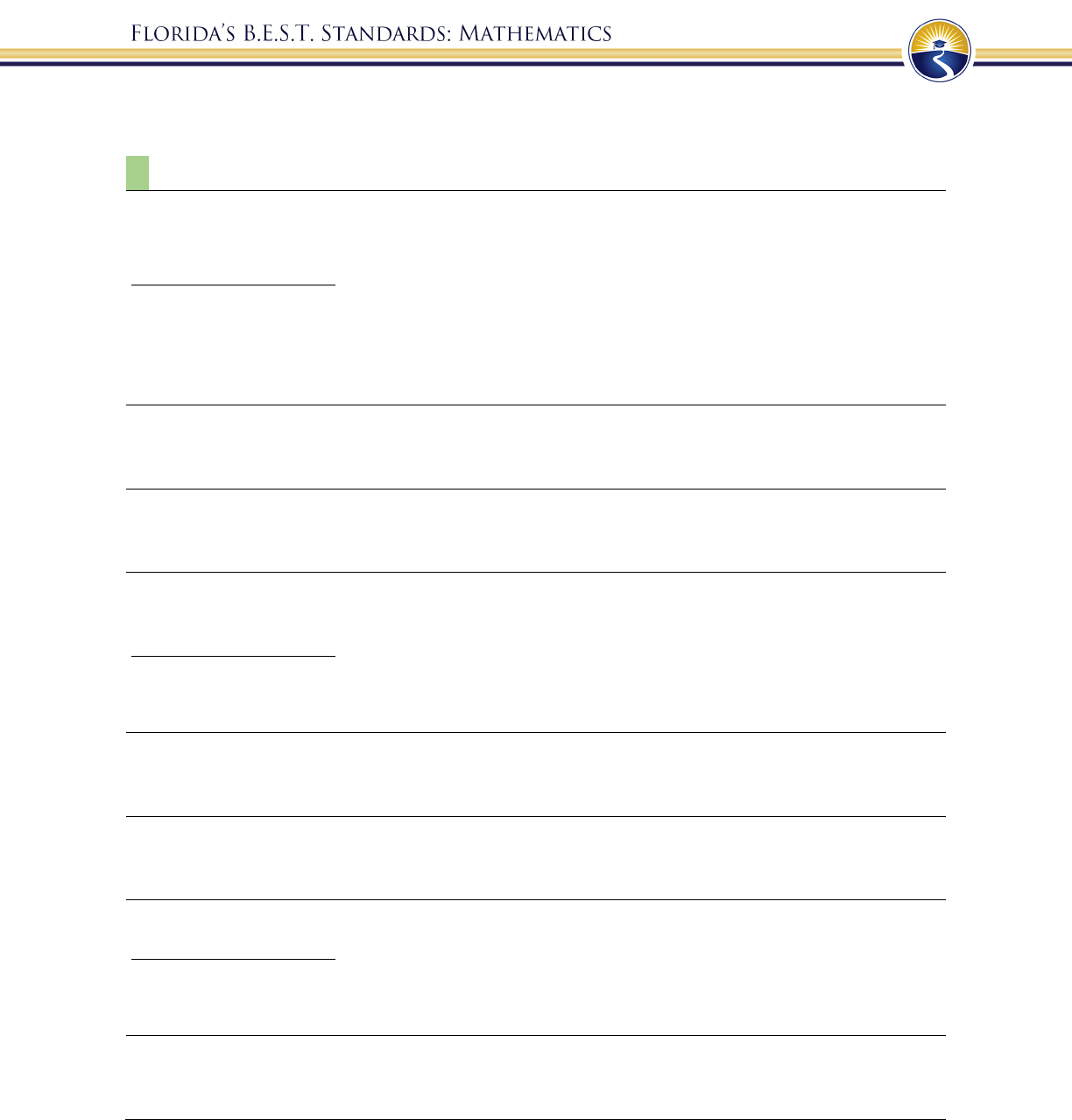
147
9-12 Trigonometry Strand
MA.912.T.1 Define and use trigonometric ratios, identities or functions to solve problems.
MA.912.T.1.1
Define trigonometric ratios for acute angles in right triangles.
Benchmark Clarifications:
Clarification 1: Instruction includes using the Pythagorean Theorem and using similar triangles to
demonstrate that trigonometric ratios stay the same for similar right triangles.
Clarification 2: Within the Geometry course, instruction includes using the coordinate plane to make
connections to the unit circle.
MA.912.T.1.2
Solve mathematical and real-world problems involving right triangles using
trigonometric ratios and the Pythagorean Theorem.
MA.912.T.1.3
Apply the Law of Sines and the Law of Cosines to solve mathematical and real-
world problems involving triangles.
MA.912.T.1.4
Solve mathematical problems involving finding the area of a triangle given two
sides and the included angle.
Benchmark Clarifications:
Clarification 1: Problems include right triangles, heights inside of a triangle and heights outside of a
triangle.
MA.912.T.1.5
Prove Pythagorean Identities. Apply Pythagorean Identities to calculate
trigonometric ratios and to solve problems.
MA.912.T.1.6
Prove the Double-Angle, Half-Angle, Angle Sum and Difference formulas for
sine, cosine, and tangent. Apply these formulas to solve problems.
MA.912.T.1.7
Simplify expressions using trigonometric identities.
Benchmark Clarifications:
Clarification 1: Identities are limited to Double-Angle, Half-Angle, Angle Sum and Difference,
Pythagorean Identities, Sum Identities and Product Identities.
MA.912.T.1.8
Solve trigonometric equations within a mathematical or real-world context,
applying inverse functions and using technology when appropriate.

148
MA.912.T.2 Extend trigonometric functions to the unit circle.
MA.912.T.2.1
Define the trigonometric functions for any angle using right triangles drawn in
the unit circle. Determine the values of sine, cosine and tangent of
,
and
and their multiples using special triangles.
MA.912.T.2.2
Define and determine the sine, cosine, tangent, cosecant, secant and cotangent
of angles using the unit circle.
MA.912.T.2.3
Given angles measured in radians or degrees, calculate the values of the six
trigonometric functions.
MA.912.T.3 Graph and apply trigonometric relations and functions.
MA.912.T.3.1
Describe and demonstrate the connections between right triangle ratios and
trigonometric functions.
MA.912.T.3.2
On the coordinate plane, express the values of sine, cosine and tangent for
– , + and 2 – in terms of their values for , where is any real
number.
MA.912.T.3.3
Given a mathematical or real-world context, choose sine, cosine or tangent
trigonometric functions to model periodic phenomena with specified amplitude,
frequency, horizontal shift and midline.
MA.912.T.3.4
Given a table, equation or written description of a trigonometric function, graph
that function and determine key features.
Benchmark Clarifications:
Clarification 1: Key features are limited to domain; range; intercepts; intervals where the function is
increasing, decreasing, positive or negative; relative maximums and minimums; symmetry; end
behavior; periodicity; midline; amplitude; shift(s) and asymptotes.
Clarification 2: Instruction includes representing t
he domain and range with inequality notation, interval
notation or set-builder notation.
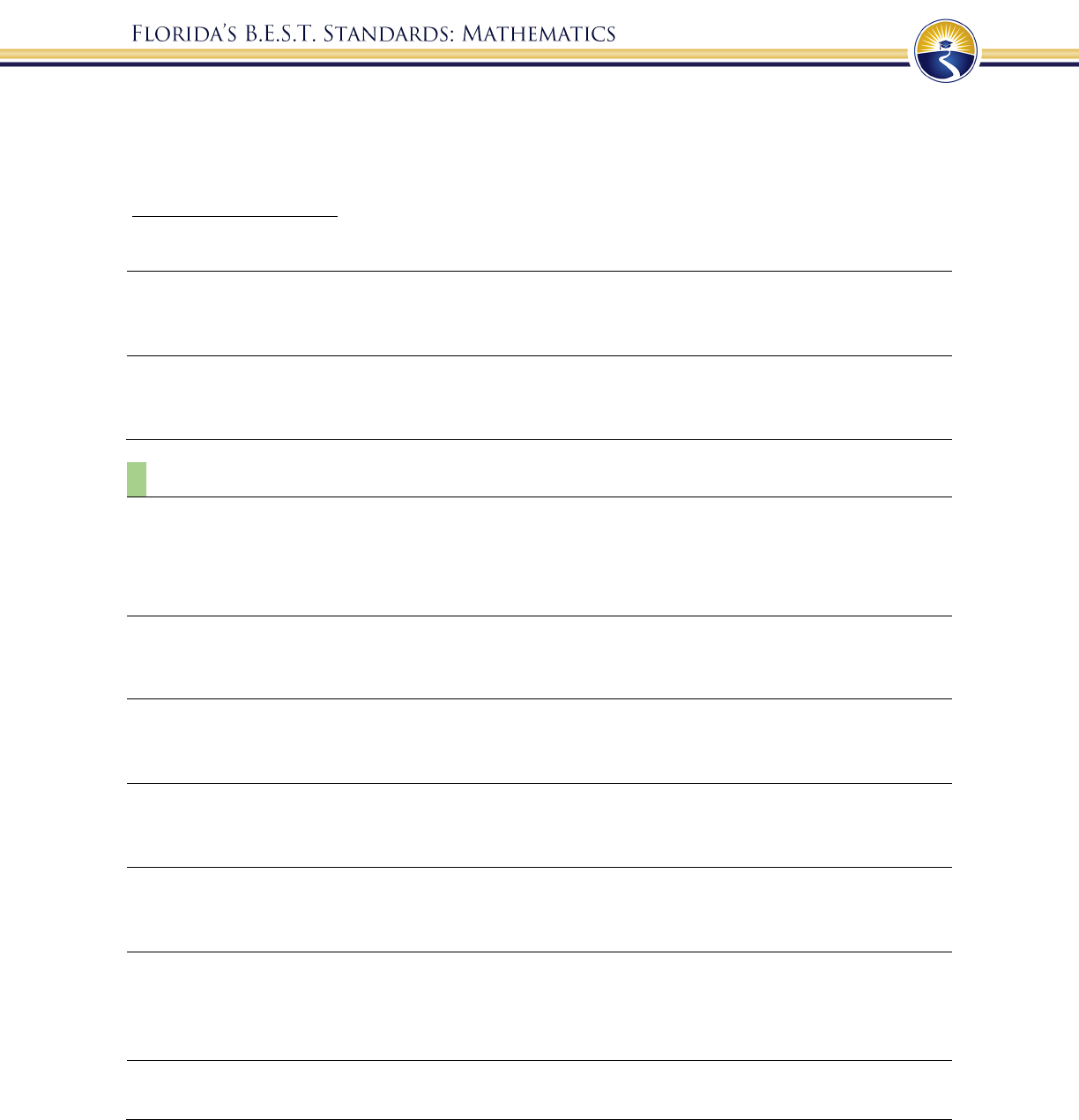
149
MA.912.T.3.5
Graph and solve mathematical and real-world problems that are modeled with
trigonometric functions. Interpret key features and determine domain
constraints
in terms of the context.
Benchmark Clarifications:
Clarification 1: Instruction includes representing constraints with inequalities or set-builder notation.
MA.912.T.3.6
Verify that restricting a trigonometric function to a domain on which it is always
increasing or always decreasing allows its inverse to be constructed.
MA.912.T.3.7
Solve mathematical and real-world problems involving applications of
trigonometric functions using graphing technology when appropriate.
MA.912.T.4 Extend rectangular coordinates and equations to polar and parametric forms.
MA.912.T.4.1
Define polar coordinates and relate polar coordinates to Cartesian coordinates
with and without the use of technology.
MA.912.T.4.2
Represent equations given in rectangular coordinates in terms of polar
coordinates.
MA.912.T.4.3
Graph equations in the polar coordinate plane with and without the use of
graphing technology.
MA.912.T.4.4
Identify and graph special polar equations, including circles, cardioids,
limacons, rose curves and lemniscates.
MA.912.T.4.5
Sketch the graph of a curve in the plane represented parametrically, indicating
the direction of motion.
MA.912.T.4.6
Convert from a parametric representation of a plane curve to a rectangular
equation, and convert from a rectangular equation to a parametric representation
of a plane curve.
MA.912.T.4.7
Apply parametric equations to model applications involving motion in the plane.
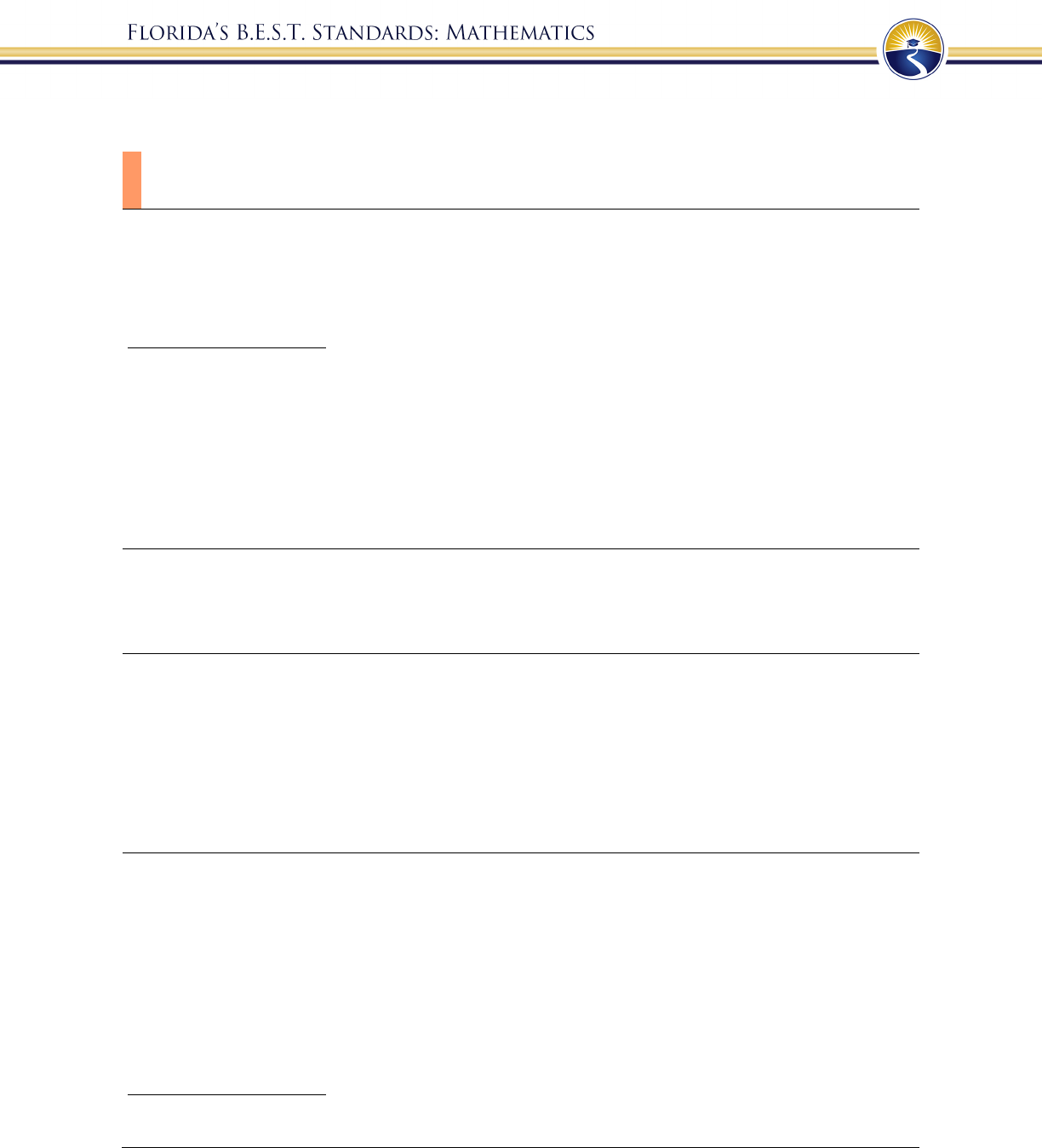
150
9-12 Data Analysis and Probability Strand
MA.912.DP.1 Summarize, represent and interpret categorical and numerical data with
one and two variables.
MA.912.DP.1.1
Given a set of data, select an appropriate method to represent the data,
depending on whether it is numerical or categorical data and on whether it is
univariate or bivariate.
Benchmark Clarifications:
Clarification 1: Instruction includes discussions regarding the strengths and weaknesses of each data
display.
Clarification 2: Numerical univariate includes histograms, stem-and-leaf plots, box plots and line plots;
numerical bivariate includes scatter plots and line graphs; categorical univariate includes bar charts,
circle graphs, line plots, frequency tables and relative frequency tables; and categorical bivariate
includes segmented bar charts, joint frequency tables and joint relative frequency tables.
Clarification 3: Instruction includes the use of appropriate units and labels and,
where appropriate, using
technology to create data displays.
MA.912.DP.1.2
Interpret data distributions represented in various ways. State whether the data
is numerical or categorical, whether it is univariate or bivariate and interpret
the different components and quantities in the display.
MA.912.DP.1.3
Explain the difference between correlation and causation in the contexts of
both numerical and categorical data.
Algebra 1 Example: There is a strong positive correlation between the number of
Nobel prizes won by country and the per capita chocolate
consumption by country. Does this mean that increased
chocolate consumption in America will increase the United
States of America’s chances of a Nobel prize winner?
MA.912.DP.1.4
Estimate a population total, mean or percentage using data from a sample
survey; develop a margin of error through the use of simulation.
Algebra 1 Example: Based on a survey of 100 households in Twin Lakes, the
newspaper reports that the average number of televisions per
household is 3.5 with a margin of error of ±0.6. The actual
population mean can be estimated to be between 2.9 and 4.1
television per household. Since there are 5,500 households in
Twin Lakes the estimated number of televisions is between
15,950 and 22,550.
Benchmark Clarifications:
Clarification 1: Within the Algebra 1 course, the margin of error will be given.
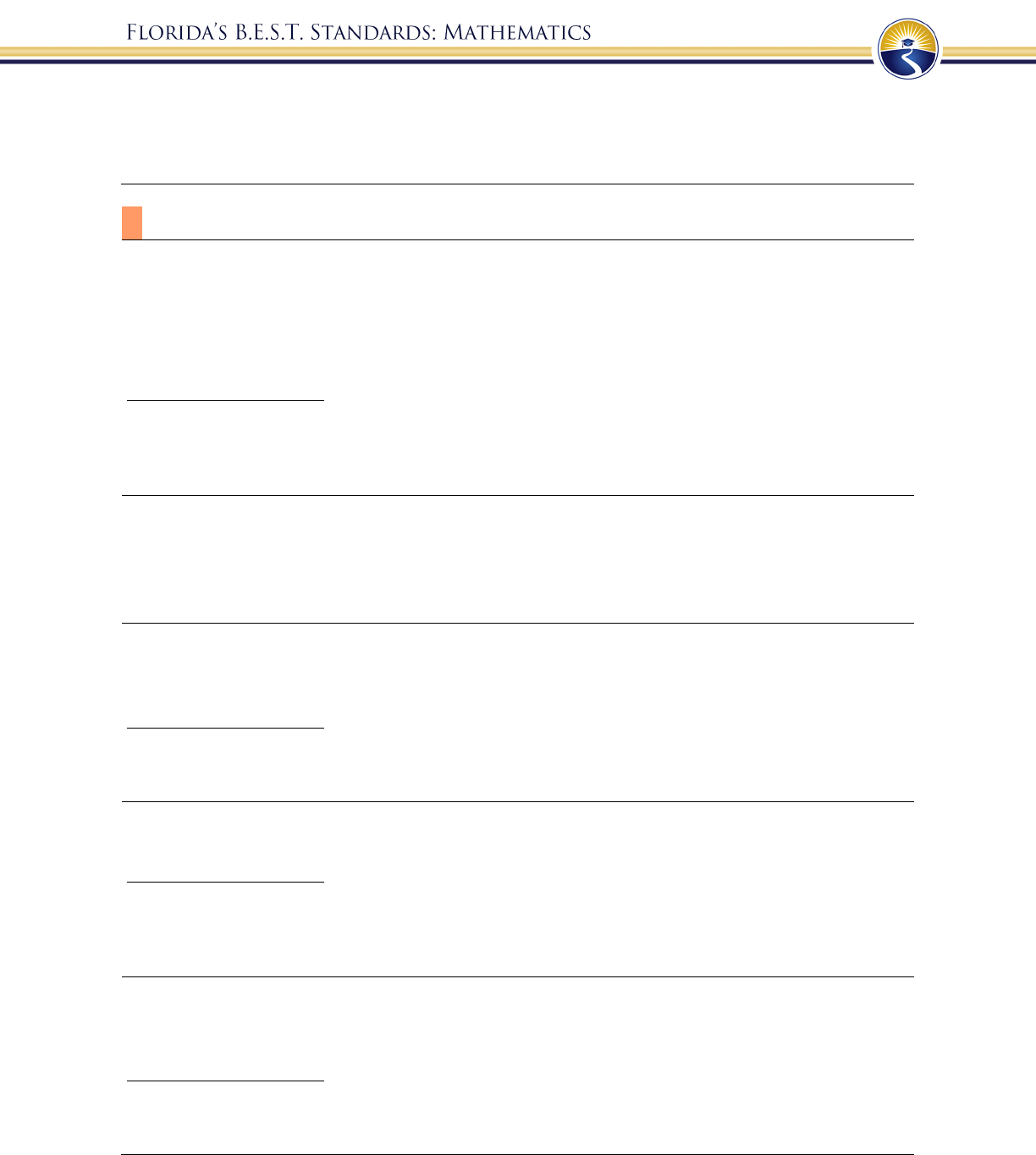
151
MA.912.DP.1.5
Interpret the margin of error of a mean or percentage from a data set. Interpret
the confidence level corresponding to the margin of error.
MA.912.DP.2 Solve problems involving univariate and bivariate numerical data.
MA.912.DP.2.1
For two or more sets of numerical univariate data, calculate and compare the
appropriate measures of center and measures of variability, accounting for
possible effects of outliers. Interpret any notable features of the shape of the
data distribution.
Benchmark Clarifications:
Clarification 1: The measure of center is limited to mean and median. The measure of variation is
limited to range, interquartile range, and standard deviation.
Clarification 2: Shape features include symmetry or skewness and clustering.
MA.912.DP.2.2
Use the mean and standard deviation of a data set to fit it to a normal
distribution and to estimate population percentages. Recognize that there are
data sets for which such a procedure is not appropriate. Use technology,
empirical rules or tables to estimate areas under the normal curve.
MA.912.DP.2.3
Fit a linear function to bivariate numerical data that suggests a linear
association and interpret the slope and intercept of the model. Use the
model to solve real-world problems in terms of the context of the data.
Benchmark Clarifications:
Clarification 1:
Instruction includes fitting a linear function both informally and formally with the use of
technology.
MA.912.DP.2.4
Given a scatter plot that represents bivariate numerical data, assess the fit of a
given linear function by plotting and analyzing residuals.
Benchmark Clarifications:
Clarification 1: Within the Algebra 1 course, instruction includes determining the number of positive
and negative residuals; the largest and smallest residuals; and the connection between outliers in the data
set and the corresponding residuals.
MA.912.DP.2.5
Given a scatter plot with a line of fit and residuals, determine the strength and
direction of the correlation. Interpret strength and direction within a real-world
context.
Benchmark Clarifications:
Clarification 1: Instruction focuses on determining the direction by analyzing the slope and informally
determining the strength by analyzing the residuals.
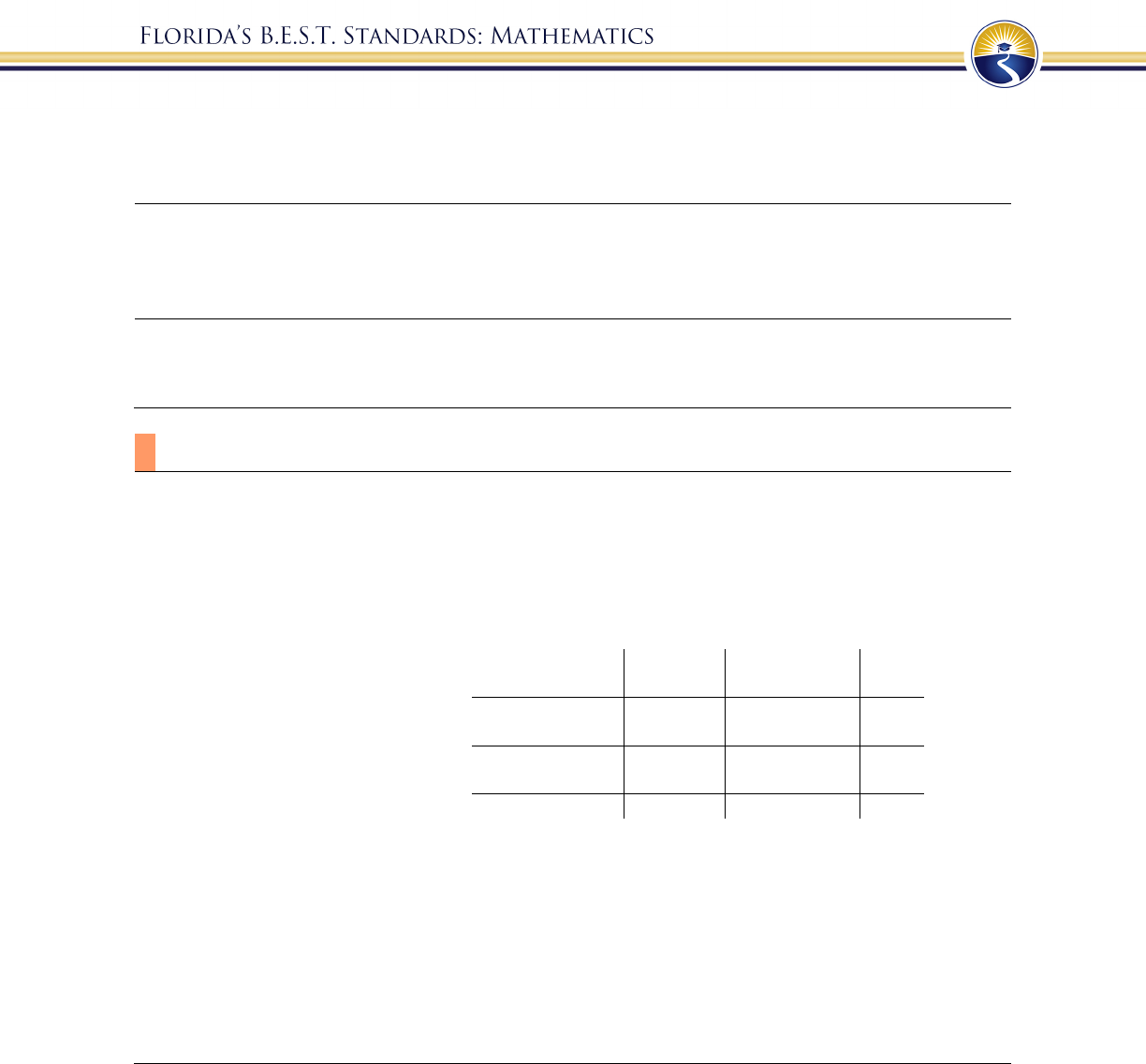
152
MA.912.DP.2.6
Compute the correlation coefficient of a linear model using technology.
Interpret the strength and direction of the correlation coefficient.
MA.912.DP.2.7
Fit a quadratic function to data that suggests a quadratic association and
interpret any intercepts or the vertex of the model. Use the model to solve real-
world problems in terms of the context of the data.
MA.912.DP.2.8
Fit an exponential function to data that suggests an exponential association.
Use the model to solve real-world problems in terms of the context of the data.
MA.912.DP.3 Solve problems involving categorical data.
MA.912.DP.3.1
Construct a two-way frequency table summarizing bivariate categorical data.
Interpret joint and marginal frequencies and determine possible associations
in terms of a real-world context.
Algebra 1 Example: Complete the frequency table below.
Has an A
in math
Doesn’t have
an A in math
Total
Plays an
instrument
20 90
Doesn’t play an
instrument
20
Total
350
Using the information in the table, it is possible to determine
that the second column contains the numbers 70 and 240. This
means that there are 70 students who play an instrument but do
not have an A in math and the total number of students who play
an instrument is 90. The ratio of the joint frequencies in the first
column is 1 to 1 and the ratio in the second column is 7 to 24,
indicating a strong positive association between playing an
instrument and getting an A in math.
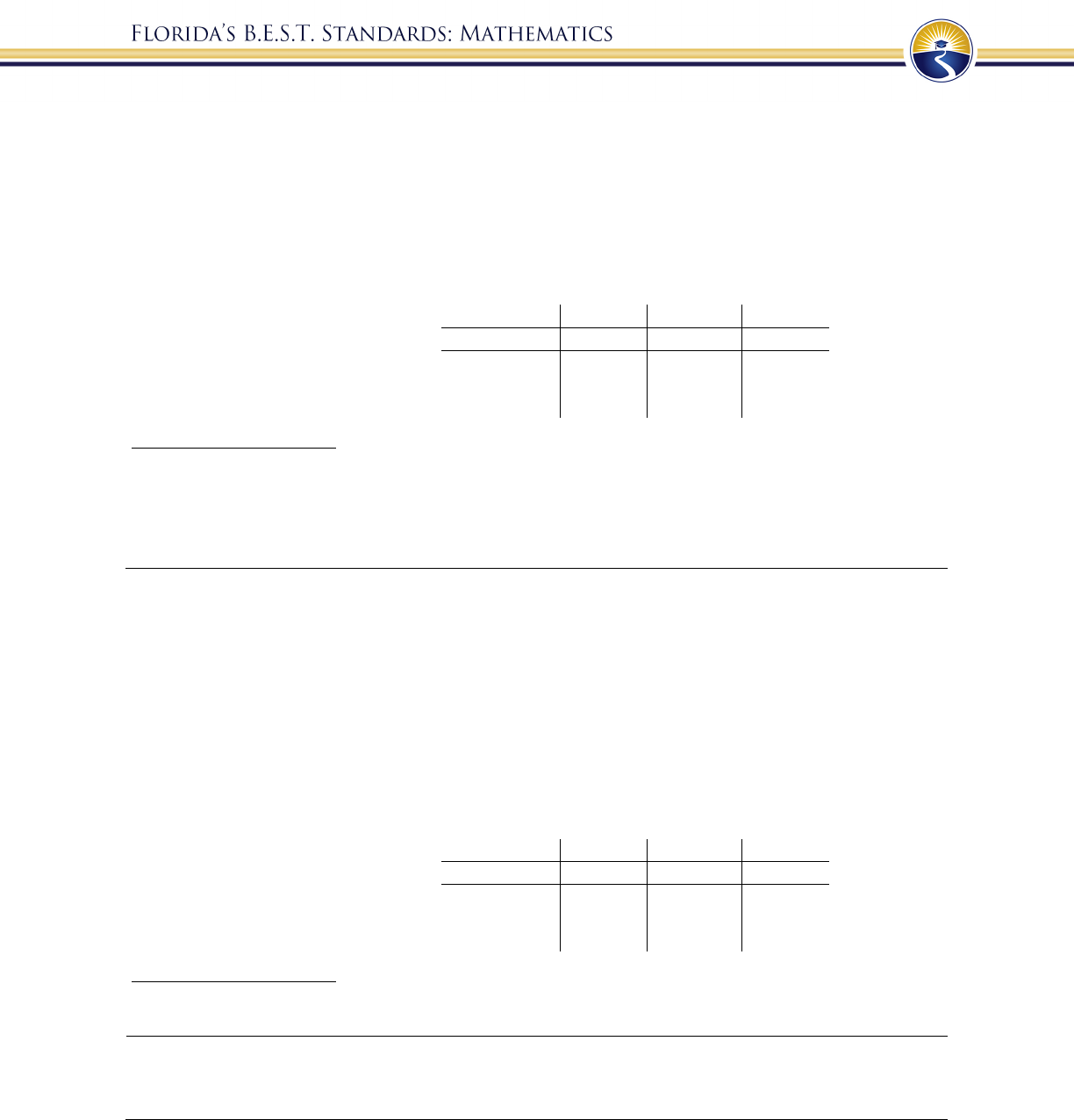
153
MA.912.DP.3.2
Given marginal and conditional relative frequencies, construct a two-way
relative frequency table summarizing categorical bivariate data.
Algebra 1 Example: A study shows that 9% of the population have diabetes and 91%
do not. The study also shows that 95% of the people who do not
have diabetes, test negative on a diabetes test while 80% who do
have diabetes, test positive. Based on the given information, the
following relative frequency table can be constructed.
Positive
Negative
Total
Has diabetes
7.2%
1.8%
9%
Doesn’t
have
diabetes
4.55% 86.45% 91%
Benchmark Clarifications:
Clarification 1: Construction includes cases where not all frequencies are given but enough are provided
to be able to construct a two-way relative frequency table.
Clarification 2: Instruction includes the use of a tree diagram when calculating relative frequencies to
construct tables.
MA.912.DP.3.3
Given a two-way relative frequency table or segmented bar graph
summarizing categorical bivariate data, interpret joint, marginal and
conditional relative frequencies in terms of a real-world context.
Algebra 1 Example: Given the relative frequency table below, the ratio of true
positives to false positives can be determined as 7.2 to 4.55,
which is about 3 to 2, meaning that a randomly selected person
who tests positive for diabetes is about 50% more likely to have
diabetes than not have it.
Positive
Negative
Total
Has diabetes
7.2%
1.8%
9%
Doesn’t
have
diabetes
4.55% 86.45% 91%
Benchmark Clarifications:
Clarification 1: Instruction includes problems involving false positive and false negatives.
MA.912.DP.3.4
Given a relative frequency table, construct and interpret a segmented bar
graph.

154
MA.912.DP.3.5
Solve real-world problems involving univariate and bivariate categorical data.
Benchmark Clarifications:
Clarification 1: Instruction focuses on the connection to probability.
Clarification 2: Instruction includes calculating joint relative frequencies or conditional relative
frequencies using tree diagrams.
Clarification 3: Graphical representations include frequency tables, relative frequency tables, circle
graphs and segmented bar graphs.
MA.912.DP.4 Use and interpret independence and probability.
MA.912.DP.4.1
Describe events as subsets of a sample space using characteristics, or
categories, of the outcomes, or as unions, intersections or complements of
other events.
MA.912.DP.4.2
Determine if events A and B are independent by calculating the product of
their probabilities.
MA.912.DP.4.3
Calculate the conditional probability of two events and interpret the result in
terms of its context.
MA.912.DP.4.4
Interpret the independence of two events using conditional probability.
MA.912.DP.4.5
Approximate conditional probabilities using two-way tables as a sample
space and determine if events in the sample space are approximately
independent.
MA.912.DP.4.6
Recognize and explain the concepts of conditional probability and
independence in everyday language and everyday situations.
MA.912.DP.4.7
Apply the addition rule for probability, taking into consideration whether the
events are mutually exclusive, and interpret the result in terms of the model
and its context.
MA.912.DP.4.8
Apply the general multiplication rule for probability, taking into
consideration whether the events are independent, and interpret the result in
terms of the context.

155
MA.912.DP.4.9
Given a mathematical or real-world situation, calculate the appropriate
permutation or combination.
MA.912.DP.4.10
Compute probabilities of compound events. Solve mathematical and real-
world problems using permutations and combinations.
MA.912.DP.5 Determine methods of data collection and make inferences from collected
data.
MA.912.DP.5.1
Distinguish between a population parameter and a sample statistic.
MA.912.DP.5.2
Explain how random sampling produces data that is representative of a
population.
MA.912.DP.5.3
Compare and contrast sampling methods.
MA.912.DP.5.4
Generate multiple samples or simulated samples of the same size to measure
the variation in estimates or predictions.
MA.912.DP.5.5
Determine if a specific model is consistent within a given process by
analyzing the data distribution from a data-generating process.
MA.912.DP.5.6
Determine the appropriate design, survey, experiment or observational study,
based on the purpose. Articulate the types of questions appropriate for each
type of design.
MA.912.DP.5.7
Compare and contrast surveys, experiments and observational studies.
MA.912.DP.5.8
Explain how randomization relates to sample surveys, experiments and
observational studies.
MA.912.DP.5.9
Draw inferences about two populations using data and statistical analysis
from two random samples.
MA.912.DP.5.10
Compare two treatments from an experiment using data from a randomized
experiment.
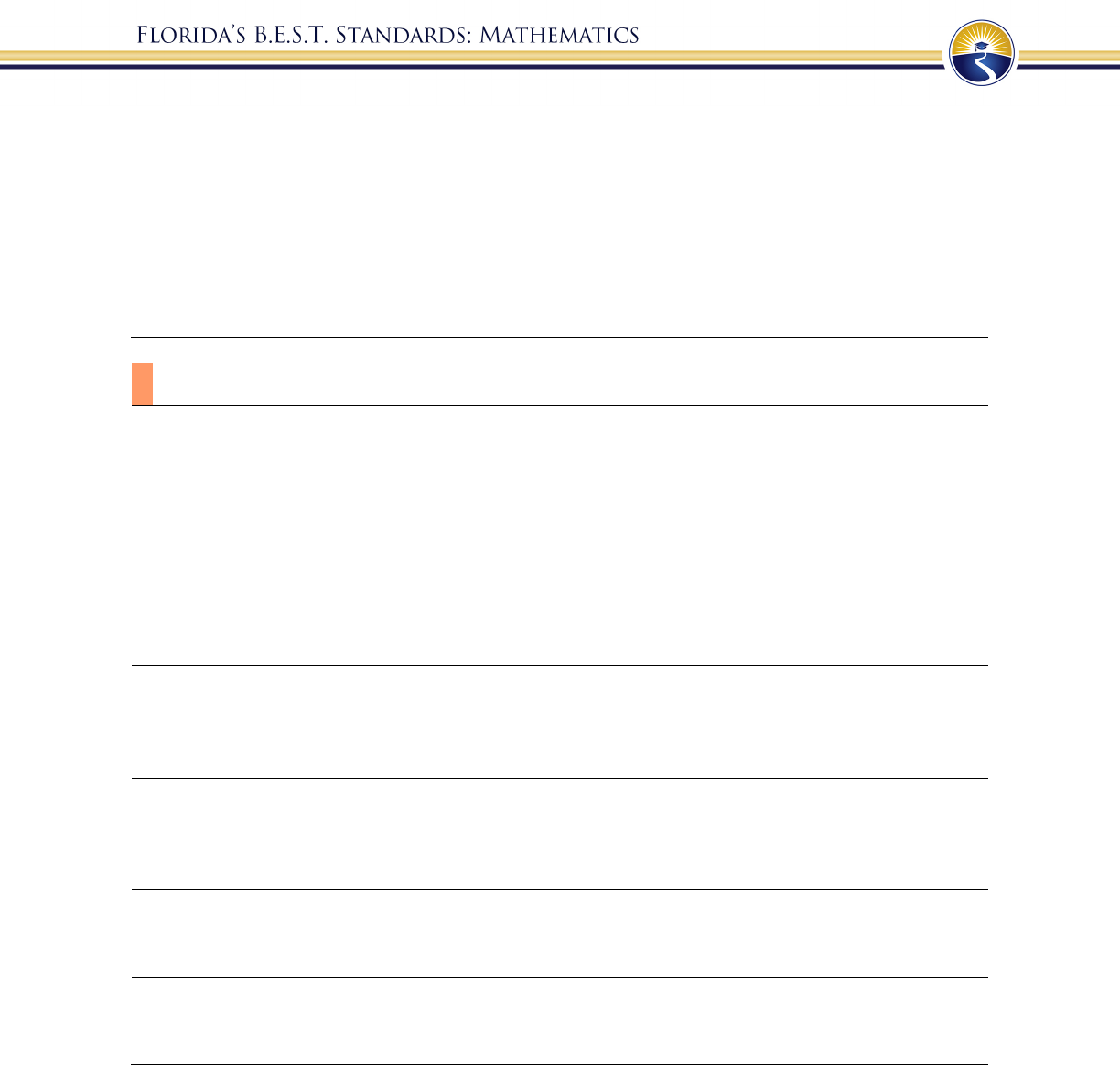
156
MA.912.DP.5.11
Determine whether differences between parameters are significant using
simulations.
MA.912.DP.5.12
Evaluate reports based on data from diverse media, print and digital
resources by interpreting graphs and tables; evaluating data-
based arguments;
determining whether a valid sampling method was used; or interpreting
provided statistics.
MA.912.DP.6 Use probability distributions to solve problems.
MA.912.DP.6.1
Define a random variable for a quantity of interest by assigning a numerical
value to each event in a sample space; graph the corresponding probability
distribution using the same graphical displays as for data distributions.
MA.912.DP.6.2
Develop a probability distribution for a discrete random variable using
theoretical probabilities. Find the expected value and interpret it as the mean
of the discrete distribution.
MA.912.DP.6.3
Develop a probability distribution for a discrete random variable using
empirically assigned probabilities. Find the expected value and interpret it as
the mean of the discrete distribution.
MA.912.DP.6.4
Weigh the possible outcomes of a decision by assigning probabilities to payoff
values and finding expected values. Evaluate and compare strategies on the
basis of the calculated expected values.
MA.912.DP.6.5
Apply probabilities to make decisions which are equally likely, such as
drawing from lots or using a random number generator.
MA.912.DP.6.6
Analyze decisions that were made and solve problems using probability
concepts and strategies.
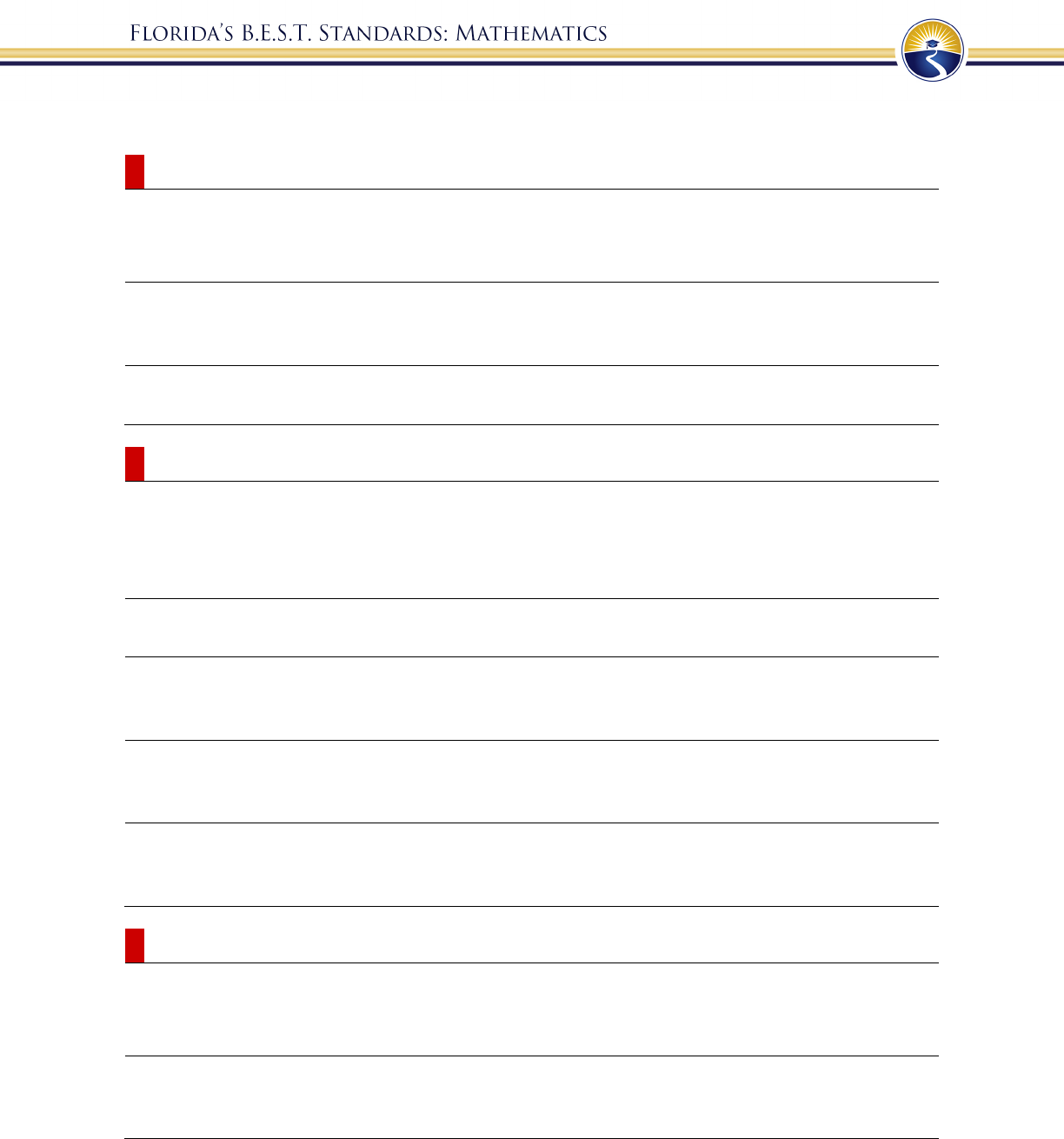
157
9-12 Logic and Theory Strand
MA.912.LT.1 Apply recursive methods to solve problems.
MA.912.LT.1.1
Apply recursive and iterative thinking to solve problems.
MA.912.LT.1.2
Solve problems and find explicit formulas for recurrence relations using finite
differences.
MA.912.LT.1.3
Apply mathematical induction in a variety of applications.
MA.912.LT.2 Apply techniques from Graph Theory to solve problems.
MA.912.LT.2.1
Solve scheduling problems using critical path analysis and Gantt charts. Create
a schedule using critical path analysis.
MA.912.LT.2.2
Apply graph coloring techniques to solve problems.
MA.912.LT.2.3
Apply spanning trees, rooted trees, binary trees and decision trees to solve
problems.
MA.912.LT.2.4
Create problems that can be solved using spanning trees, rooted trees, binary
trees, and decision trees.
MA.912.LT.2.5
Solve problems concerning optimizing resource usage using bin-packing
techniques.
MA.912.LT.3 Apply techniques from Election Theory to solve problems.
MA.912.LT.3.1
Analyze election data using election theory techniques.
MA.912.LT.3.2
Decide voting power within a group using weighted voting techniques.
Provide real-world examples of weighted voting and its pros and cons.

158
MA.912.LT.3.3
Solve problems using fair division techniques.
MA.912.LT.3.4
Solve strictly determined and non-strictly determined games by using game
theory.
MA.912.LT.4 Develop an understanding of the fundamentals of propositional logic,
arguments and methods of proof.
MA.912.LT.4.1
Translate propositional statements into logical arguments using propositional
variables and logical connectives.
MA.912.LT.4.2
Determine truth values of simple and compound statements using truth tables.
MA.912.LT.4.3
Identify and accurately interpret “if…then,” “if and only if,” “all” and “not”
statements. Find the converse, inverse and contrapositive of a statement.
Benchmark Clarifications:
Clarification 1: Instruction focuses on recognizing the relationships between an “if…then” statement
and the converse, inverse and contrapositive of that statement.
Clarification 2: Within the Geometry course, instruction focuses on the connection to proofs within the
course.
MA.912.LT.4.4
Represent logic operations, such as AND, OR, NOT, NOR, and XOR, using
logical symbolism to solve problems.
MA.912.LT.4.5
Determine whether two propositions are logically equivalent.
MA.912.LT.4.6
Apply methods of direct and indirect proof and determine whether a logical
argument is valid.
MA.912.LT.4.7
Identify and give examples of undefined terms; axioms; theorems; proofs,
including proofs using mathematical induction; and inductive and deductive
reasoning.
MA.912.LT.4.8
Construct proofs, including proofs by contradiction.
Benchmark Clarifications:
Clarification 1: Within the Geometry course, proofs are limited to geometric statements within the
course.
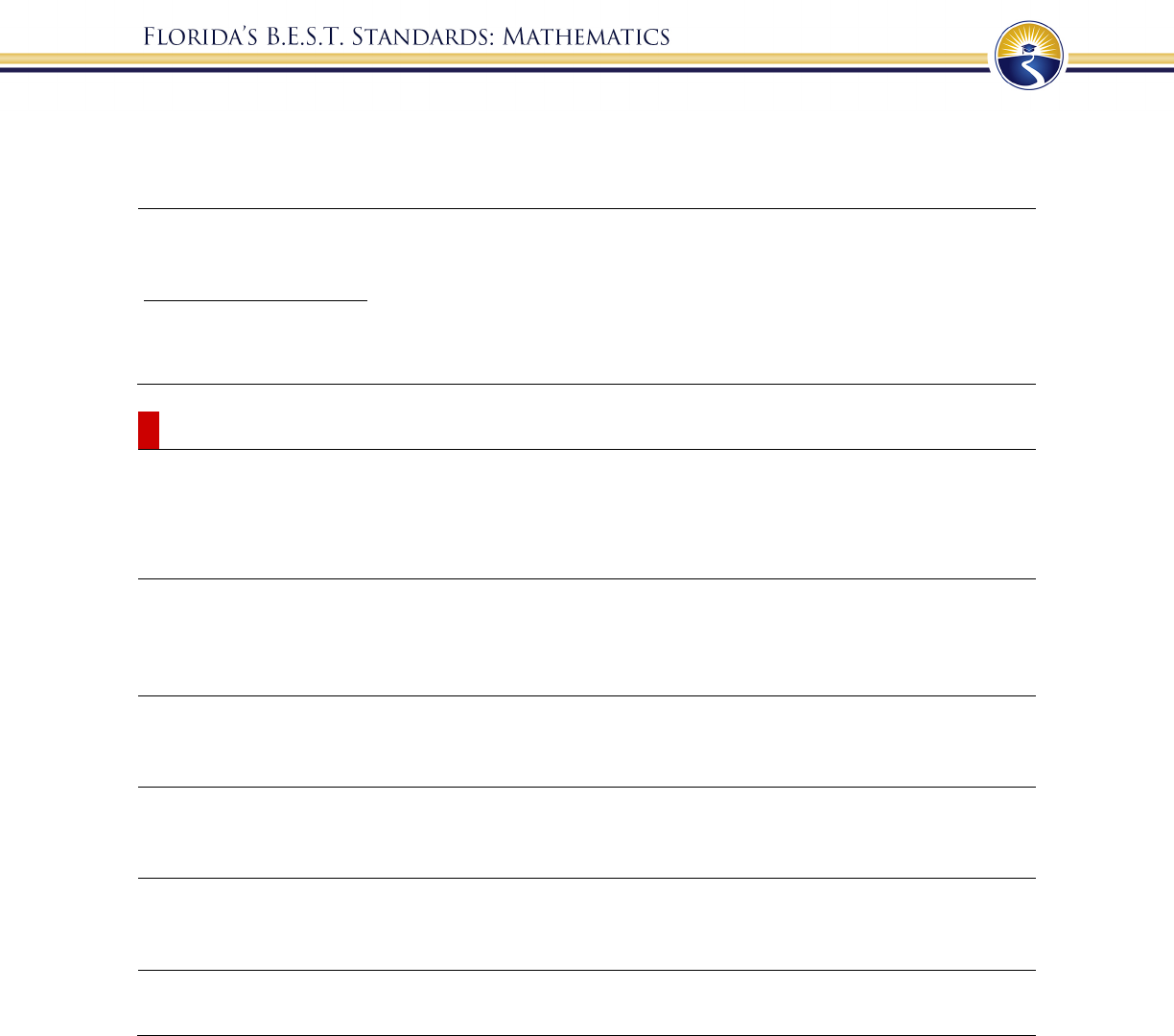
159
MA.912.LT.4.9
Construct logical arguments using laws of detachment, syllogism, tautology,
contradiction and Euler Diagrams.
MA.912.LT.4.10
Judge the validity of arguments and give counterexamples to disprove
statements.
Benchmark Clarifications:
Clarification 1: Within the Geometry course, instruction focuses on the connection to proofs within the
course.
MA.912.LT.5 Apply properties from Set Theory to solve problems.
MA.912.LT.5.1
Given two sets, determine whether the two sets are equal, whether one set is a
subset of another or if one is the power set of the other.
MA.912.LT.5.2
Given a relation on two sets, determine whether the relation is a function,
determine the inverse of the relation if it exists and identify if the relation is
bijective.
MA.912.LT.5.3
Partition a set into disjoint subsets and determine an equivalence class given
the equivalence relation on a set.
MA.912.LT.5.4
Perform the set operations of union, intersection, difference, complement and
cross product.
MA.912.LT.5.5
Explore relationships and patterns and make arguments about relationships
between sets by using Venn Diagrams.
MA.912.LT.5.6
Prove set relations, including DeMorgan’s Laws and equivalence relations.

160
9-12 Calculus Strand
MA.912.C.1 Determine limits and continuity.
MA.912.C.1.1
Demonstrate understanding of the concept of a limit and estimate limits from
graphs and tables of values.
MA.912.C.1.2
Determine the value of a limit if it exists algebraically using limits of sums,
differences, products, quotients and composite functions.
MA.912.C.1.3
Find limits of rational functions that are undefined at a point.
MA.912.C.1.4
Find one-sided limits.
MA.912.C.1.5
Find limits at infinity.
MA.912.C.1.6
Decide when a limit is infinite and use limits involving infinity to describe
asymptotic behavior.
MA.912.C.1.7
Find special limits by using the Squeeze Theorem or algebraic manipulation.
MA.912.C.1.8
Find limits of indeterminate forms using L'Hôpital's Rule.
MA.912.C.1.9
Define continuity in terms of limits.
MA.912.C.1.10
Justify whether a function is continuous at a point.
MA.912.C.1.11
Identify the types of discontinuities for a given function.
MA.912.C.1.12
Apply the Intermediate Value Theorem and the Extreme Value Theorem.
MA.912.C.2 Determine derivatives.
MA.912.C.2.1
Apply and interpret derivatives geometrically and numerically.
MA.912.C.2.2
Interpret the derivative as an instantaneous rate of change or as the slope of
the tangent line.

161
MA.912.C.2.3
Prove the rules for finding derivatives of sums, products, quotients and the
Chain Rule.
MA.912.C.2.4
Apply the rules for finding derivatives of sums, products, quotients and the
Chain Rule to solve problems with functions limited to algebraic,
trigonometric, inverse trigonometric, logarithmic and exponential.
MA.912.C.2.5
Prove the rules for finding derivatives of constant, multiple and power.
MA.912.C.2.6
Apply the rules for finding derivatives of constant, multiple and power to
solve problems with functions limited to algebraic, trigonometric, inverse
trigonometric, logarithmic and exponential.
MA.912.C.2.7
Find the derivatives of composite functions using the Chain Rule.
MA.912.C.2.8
Find the derivatives of implicitly defined functions.
MA.912.C.2.9
Find derivatives of inverse functions.
MA.912.C.2.10
Find second derivatives and derivatives of higher order.
MA.912.C.2.11
Find derivatives using logarithmic differentiation.
MA.912.C.2.12
Demonstrate and use the relationship between differentiability and continuity.
MA.912.C.2.13
Define and apply the Mean Value Theorem.
MA.912.C.3 Apply derivatives.
MA.912.C.3.1
Find the slope of a curve at a point, including points at which there are vertical
tangent lines and no tangent lines.
MA.912.C.3.2
Find an equation for the tangent line to a curve at a point and a local linear
approximation.
MA.912.C.3.3
Determine where a function is decreasing and increasing using its derivative.
MA.912.C.3.4
Find local and absolute maximum and minimum points of a function.
MA.912.C.3.5
Determine the concavity and points of inflection of a function using its second
derivative.

162
MA.912.C.3.6
Sketch graphs by using first and second derivatives. Compare the
corresponding characteristics of the graphs of , and ".
MA.912.C.3.7
Solve optimization problems using derivatives.
MA.912.C.3.8
Find average and instantaneous rates of change. Explain the instantaneous rate
of change as the limit of the average rate of change. Interpret a derivative as a
rate of change in applications, including velocity, speed and acceleration.
MA.912.C.3.9
Find the velocity and acceleration of a particle moving in a straight line.
MA.912.C.3.10
Model rates of change, including related rates problems.
MA.912.C.4 Determine integrals.
MA.912.C.4.1
Find approximate values of integrals by using rectangle approximations.
MA.912.C.4.2
Calculate the values of Riemann sums over equal subdivisions using left,
right and midpoint evaluation points.
MA.912.C.4.3
Interpret a definite integral as a limit of Riemann sums.
MA.912.C.4.4
Apply the Trapezoidal Rule to approximate a definite integral.
MA.912.C.4.5
Interpret a definite integral of the rate of change of a quantity over an interval
as the change of the quantity over the interval. That is,
(
)
=
(
)
(), the Fundamental Theorem of Calculus.
MA.912.C.4.6
Evaluate definite integrals by using the Fundamental Theorem of Calculus.
MA.912.C.4.7
Analyze function graphs by using derivative graphs and the Fundamental
Theorem of Calculus.

163
MA.912.C.4.8
Evaluate or solve problems using the properties of definite integrals.
Properties are limited to the following:
•
[
(
)
+ ()]
=
(
)
+
(
)
•
(
)
=
(
)
•
(
)
= 0
•
(
)
=
(
)
•
(
)
+
(
)
=
(
)
• If () () on [, ], then
(
)
(
)
.
MA.912.C.4.9
Evaluate definite and indefinite integrals by using integration by substitution.
MA.912.C.4.10
Apply Riemann sums, the Trapezoidal Rule and technology to approximate
definite integrals of functions represented algebraically, geometrically and by
tables of values.
MA.912.C.5 Apply integrals.
MA.912.C.5.1
Find specific antiderivatives using initial conditions, including finding velocity
functions from acceleration functions, finding position functions from velocity
functions and solving applications related to motion along a line.
MA.912.C.5.2
Solve separable differential equations.
MA.912.C.5.3
Solve differential equations of the form
= as applied to growth and
decay problems.
MA.912.C.5.4
Display a graphic representation of the solution to a differential equation by
using slope fields, and locate particular solutions to the equation.
MA.912.C.5.5
Find the area between a curve and the -axis or between two curves by using
definite integrals.
MA.912.C.5.6
Find the average value of a function over a closed interval by using definite
integrals.
MA.912.C.5.7
Find the volume of a figure with known cross-sectional area, including figures
of revolution, by using definite integrals.

164
Appendix A: Situations Involving
Operations with Numbers
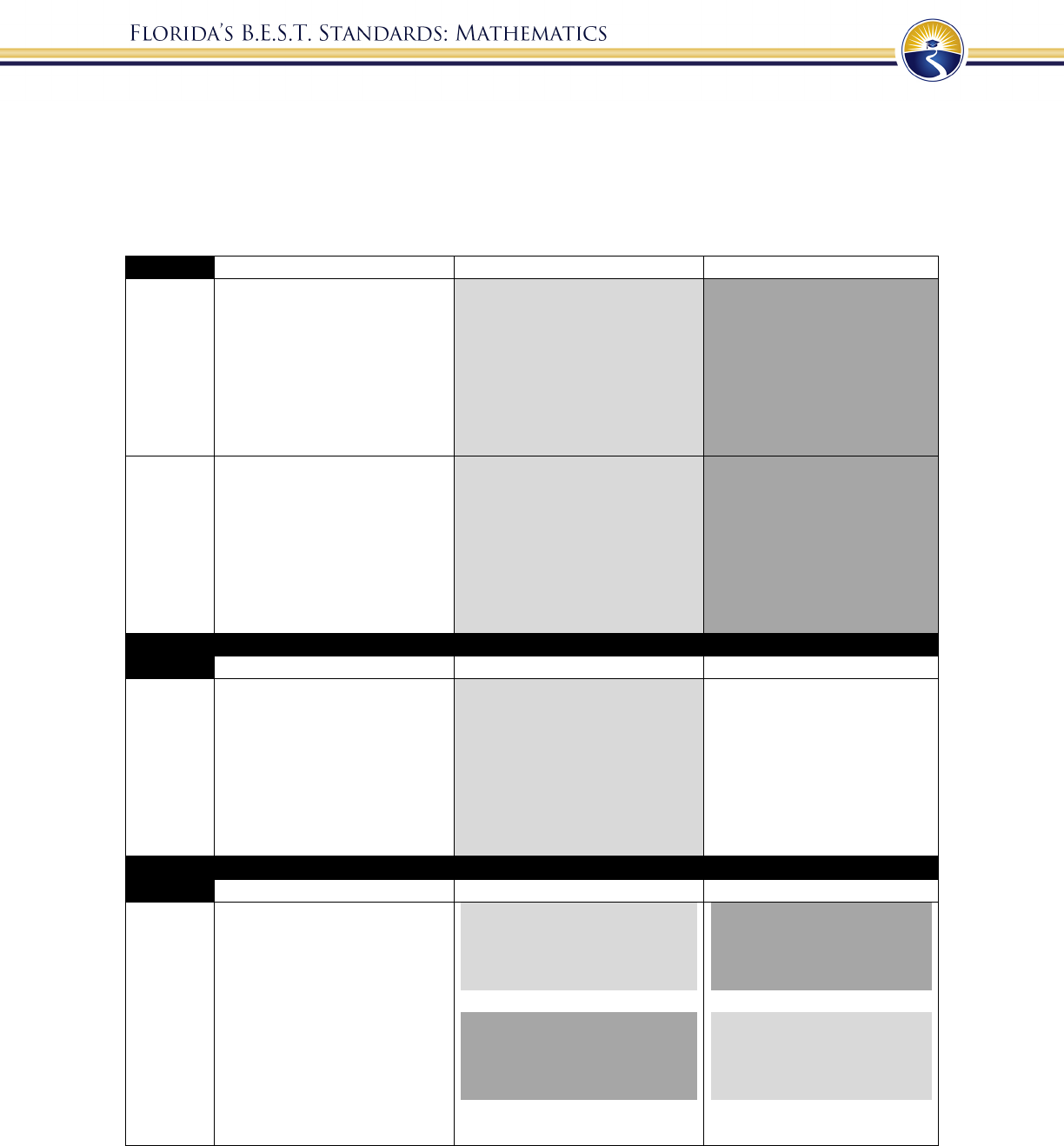
165
Situations Involving Addition and Subtraction
These situations represent the fundamental meanings and uses of addition and
subtraction. The four unshaded situation types are expectations for Kindergarten students. Grade
1 and 2 students should work with all situation types. Darker shading indicates the four most
difficult types that students should work with in Grade 1 but not need master until Grade 2.
Result Unknown
Change Unknown
Start Unknown
Add To
Three birds sat on a wire.
Two more birds landed next
to them. How many birds
are on the wire now?
3 + 2 = ?
Three birds sat on a wire.
Some more birds landed next
to them. Then there were five
birds on the wire. How many
birds landed on the wire next
to the first three?
3 + ? = 5
Some birds were sitting on
a wire. Two more birds
landed there. Then there
were five birds. How many
birds were on the wire to
start?
? + 2 = 5
Take
From
Five snacks were on the
table. Three snacks were
eaten. How many snacks are
on the table now?
5 – 3 = ?
Five snacks were on the table.
Some snacks were eaten.
Then there were two snacks
on the table. How many
snacks were eaten?
5 ? = 2
Some snacks were on the
table. Then three snacks
were eaten. Now there are
two snacks left on the table.
How many snacks were on
the table at the start?
? – 3 = 2
Total Unknown
Addend Unknown
Both Addends Unknown
Put
Together
Three purple pens and two
red pens were in the box.
How many pens are in the
box?
3 + 2 = ?
Five pens are in the box.
Three of them are purple, the
rest are red. How many pens
are red?
3 + ? = 5 5 – 3 = ?
Jennifer has five pens. How
many of them could be
purple and how many of
them could be red?
5 = 0 + 5 5 = 5 + 0
5 = 1 + 4 5 = 4 + 1
5 = 2 + 3 5 = 3 + 2
Difference Unknown
Bigger Unknown
Smaller Unknown
Compare
More: Jim has two pens.
Keisha has five pens. How
many more pens does
Keisha have than Jim?
Fewer: Jim has two pens.
Keisha has five pens. How
many fewer pens does Jim
have than Keisha?
2 + ? = 5 5 – 2 = ?
More: Keisha has three more
pens than Jim. Jim has two
pens. How many pens does
Keisha have?
Fewer: Jim has three fewer
pens than Keisha. Jim has
two pens. How many pens
does Keisha have?
2 + 3 = ? 3 + 2 = ?
More: Keisha has three
more pens than Jim. Keisha
has five pens. How many
pens does Jim have?
Fewer: Jim has three fewer
pens than Keisha. Keisha
has five pens. How many
pens does Jim have?
5 – 3 = ? ? + 3 = 5
Adapted from Box 2-4 of Mathematics Learning in Early Childhood, National Research Council (2009, pp. 32-33).
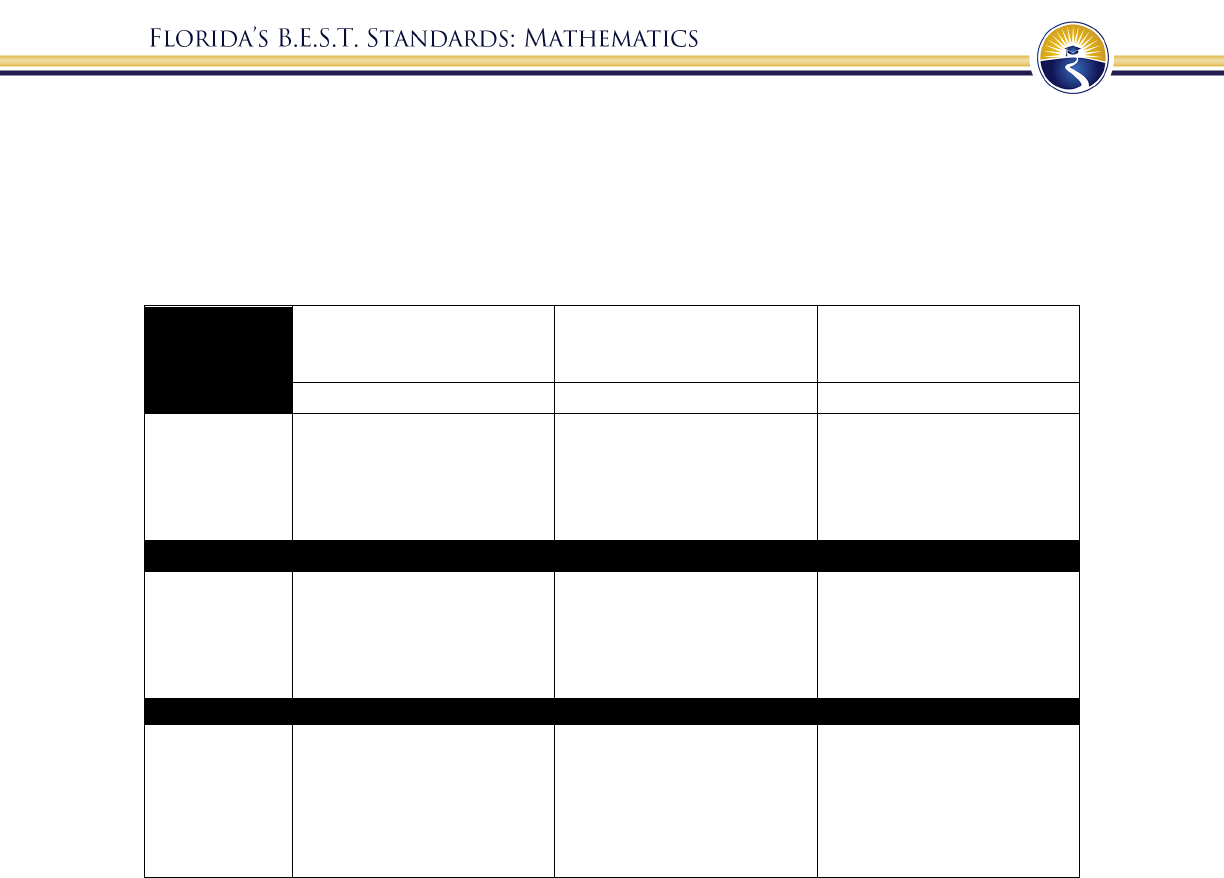
166
Situations Involving Multiplication and Division
These situations represent the fundamental meanings and uses of multiplication and
division. The situations increase in difficulty when moving from the top of the page to the
bottom and from left to right across the page. Students in grade 3 should work with all situation
types but need not master the multiplicative comparisons until grade 4.
Adapted from Box 2-4 of Mathematics Learning in Early Childhood, National Research Council (2009, pp. 32-33).
Unknown Product
Group Size Unknown
(Partitive or Fair Shares
Division)
Number of Groups
Unknown (Quotative or
Measurement Division)
3 × 6 = ?
3 × ? = 18 18 ÷ 3 = ?
? × 6 = 18 18 ÷ 6 = ?
Equal Groups
There are 3 bags with 6
plums in each bag. How
many plums are there in
all?
If 18 plums are shared
equally into 3 bags, then
how many plums will be in
each bag?
If 18 plums are to be
packed 6 to a bag, then
how many bags are
needed?
Arrays
There are 3 rows of apples
with 6 apples in each row.
How many apples are
there?
If 18 apples are arranged
into 3 equal rows, how
many apples will be in
each row?
If 18 apples are arranged
into equal rows of 6
apples, how many rows
will there be?
Multiplicative
Comparisons
A blue hat costs $6. A red
hat costs 3 times as much
as the blue hat. How much
does the red hat cost?
A red hat costs $18 and
that is 3 times as much as a
blue hat costs. How much
does the blue hat cost?
A red hat costs $18 and a
blue hat costs $6. How
many times as much does
the red hat cost as the blue
hat?
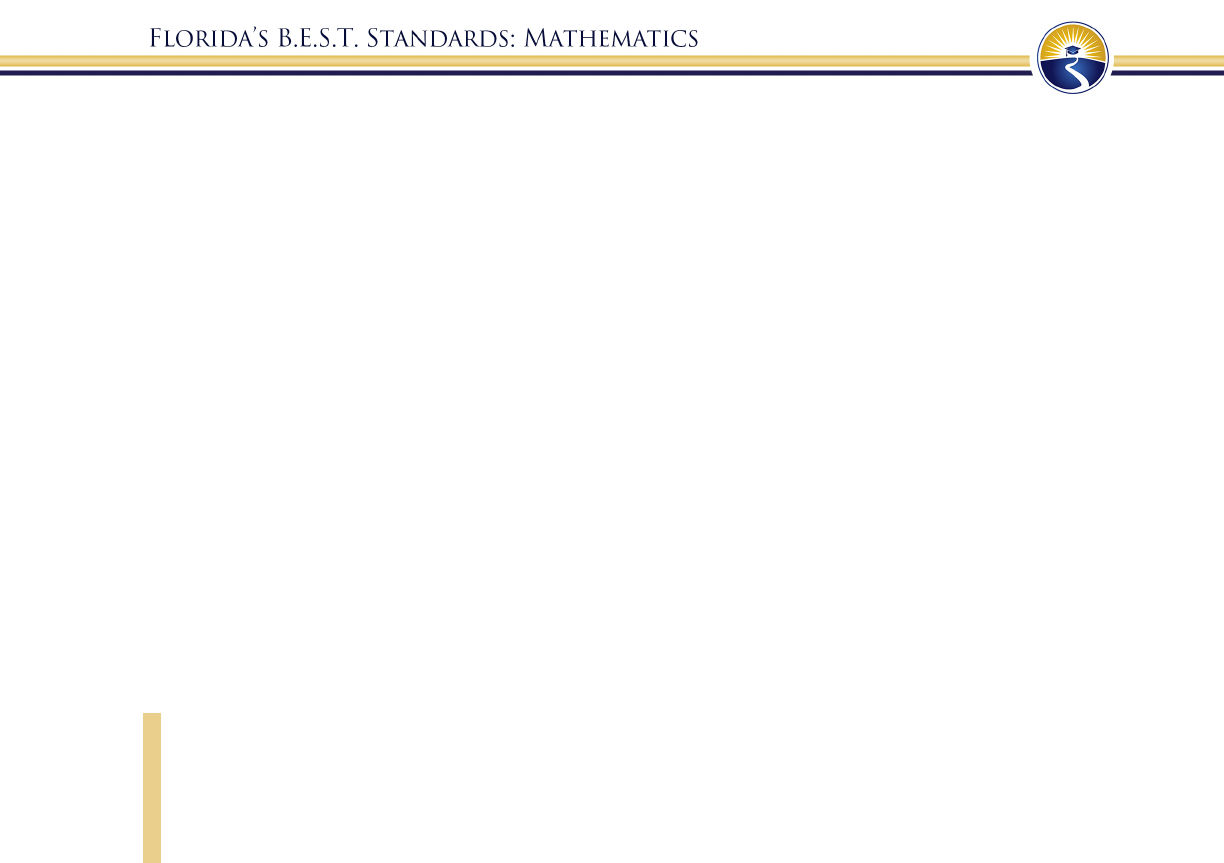
167
Appendix B: Fluency and
Automaticity Chart
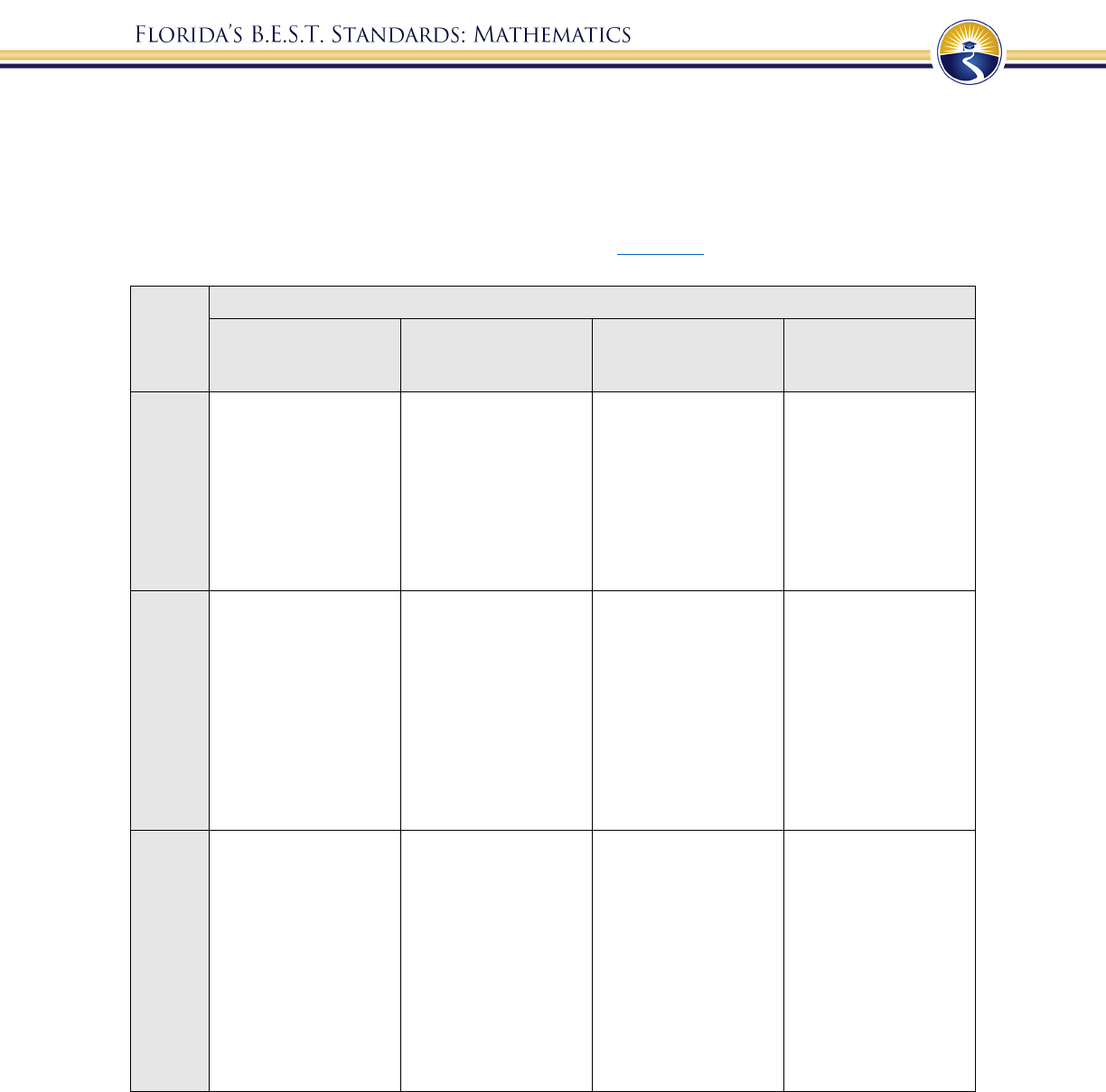
168
Fluency and Recall with Automaticity throughout Grade Levels
The purpose of this table is to provide educators with an overview of procedural fluencies
and recall with automaticity within number sense and operations and measurement from
Kindergarten to Grade 8. This crosswalk should not drive instruction or curriculum. Please refer
to your specific course description that can be found on CPALMS.
Grade
Level
Required Procedural Reliability, Procedural Fluency and Basic Fact Automaticity
Number Sense:
Counting and Place
Value
Operations: Addition
and Subtraction
Operations:
Multiplication and
Division
Measurement
K
Recite numbers to 100
by ones and tens
Count backward within
20
Locate, order and
compare whole numbers
up to 20
Procedural Reliability:
Two one-digit whole
numbers with sums from
0 to 10 and related
subtraction facts
1
Count forward and
backward within 120 by
ones
Skip count by 2s to 20
and by 5s to 100.
Plot, order and compare
whole numbers up to
100
Recall:
Two whole numbers
with sums from 0 to 10
and related subtraction
facts
Procedural Reliability:
Two whole numbers
with sums from 0 to 20
and related subtraction
facts
Length of an object to
the nearest inch or
centimeter
2
Round whole numbers
from 0 to 100 to the
nearest 10
Plot, order and compare
whole numbers up to
1,000
Recall:
Two whole numbers
with sums from 0 to 20
and related subtraction
facts
Procedural Reliability:
Two whole numbers
with sums up to 100 and
subtract a whole number
from a whole number,
each no larger than 100
Length of an object to
the nearest inch, foot,
yard, centimeter or
meter
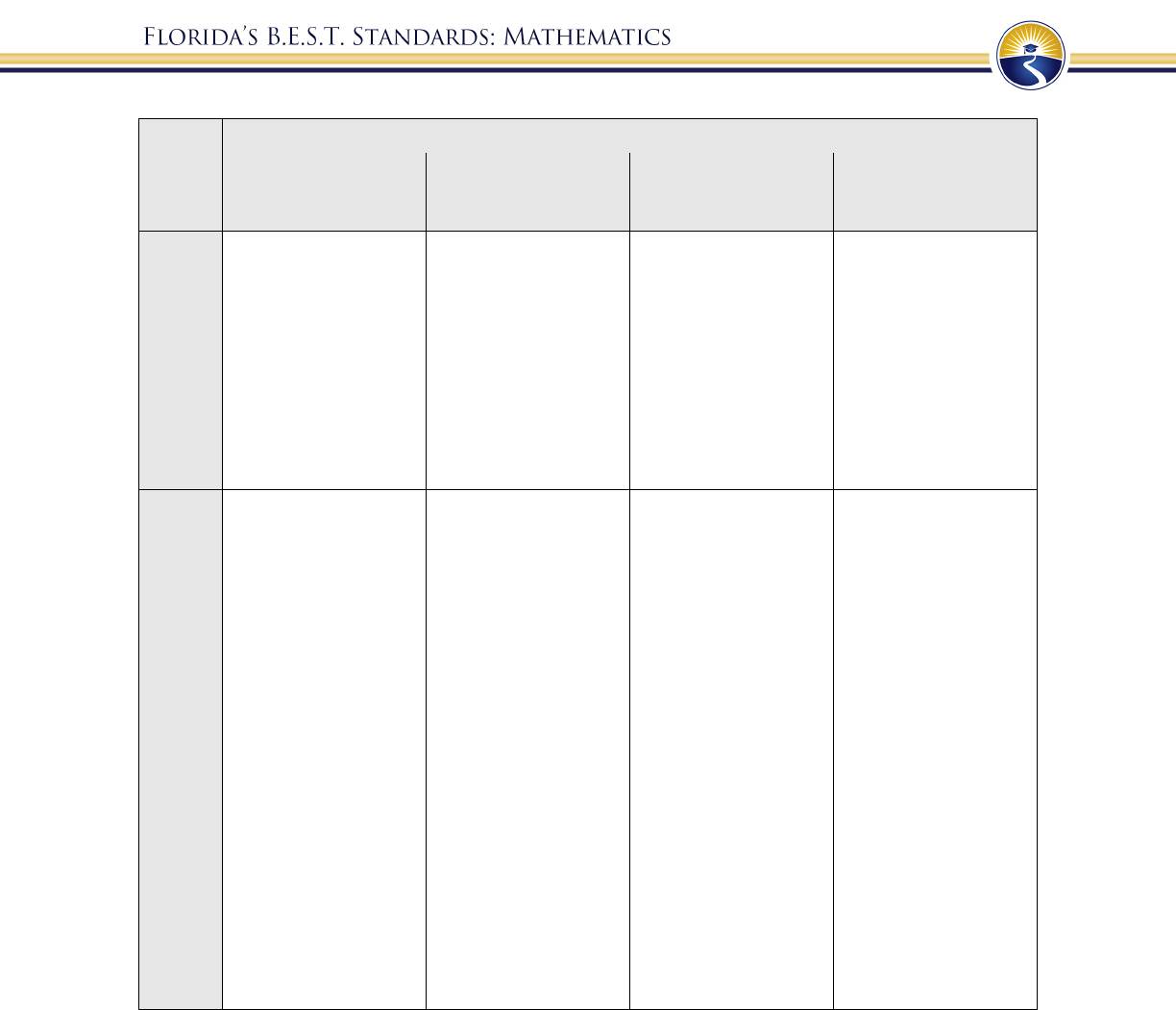
169
Grade
Level
Required Procedural Reliability, Procedural Fluency and Basic Fact Automaticity
Number Sense:
Counting and Place
Value
Operations: Addition
and Subtraction
Operations:
Multiplication and
Division
Measurement
3
Round whole numbers
from 0 to 1,000 to the
nearest 10 or 100
Plot, order and compare:
• whole numbers up
to 10,000
• fractional numbers
with the same
numerator or the
same denominator
Procedural Fluency:
Multi-digit whole
numbers, including
using a standard
algorithm
Procedural Reliability:
Multiplication of a one-
digit whole number by a
multiple of 10 up to 90
or a multiple of 100 up
to 900
Procedural Reliability:
Two whole numbers
with factors from 0 to 12
and related division facts
Length of an object to
the nearest centimeter
and half or quarter inch
Volume of a liquid
within a beaker to the
nearest milliliter and
half or quarter cup
Temperature to the
nearest degree
4
Round whole numbers
from 0 to 10,000 to the
nearest 10, 100 or 1,000.
Plot, order and compare:
• multi-digit whole
numbers up to
1,000,000
• decimals up to the
hundredths
• fractions with
different numerators
and different
denominators,
including mixed
numbers and
fractions greater
than 1
Procedural Reliability:
Two fractions with like
denominators, including
mixed numbers and
fractions greater than 1
Recall:
Two whole numbers
with factors up to 12 and
related division facts
Procedural Reliability:
Multiplication of a
whole number up to
three digits by a whole
number up to two digits
Procedural Fluency:
Multiplication of a two-
digit whole number by a
two-digit whole number,
including using a
standard algorithm
Procedural Reliability:
Division of a whole
number up to four digits
by a one-digit whole
number
Length of an object
Volume of a liquid
within a beaker
Weight of an object
Mass of an object
Temperature of an
object
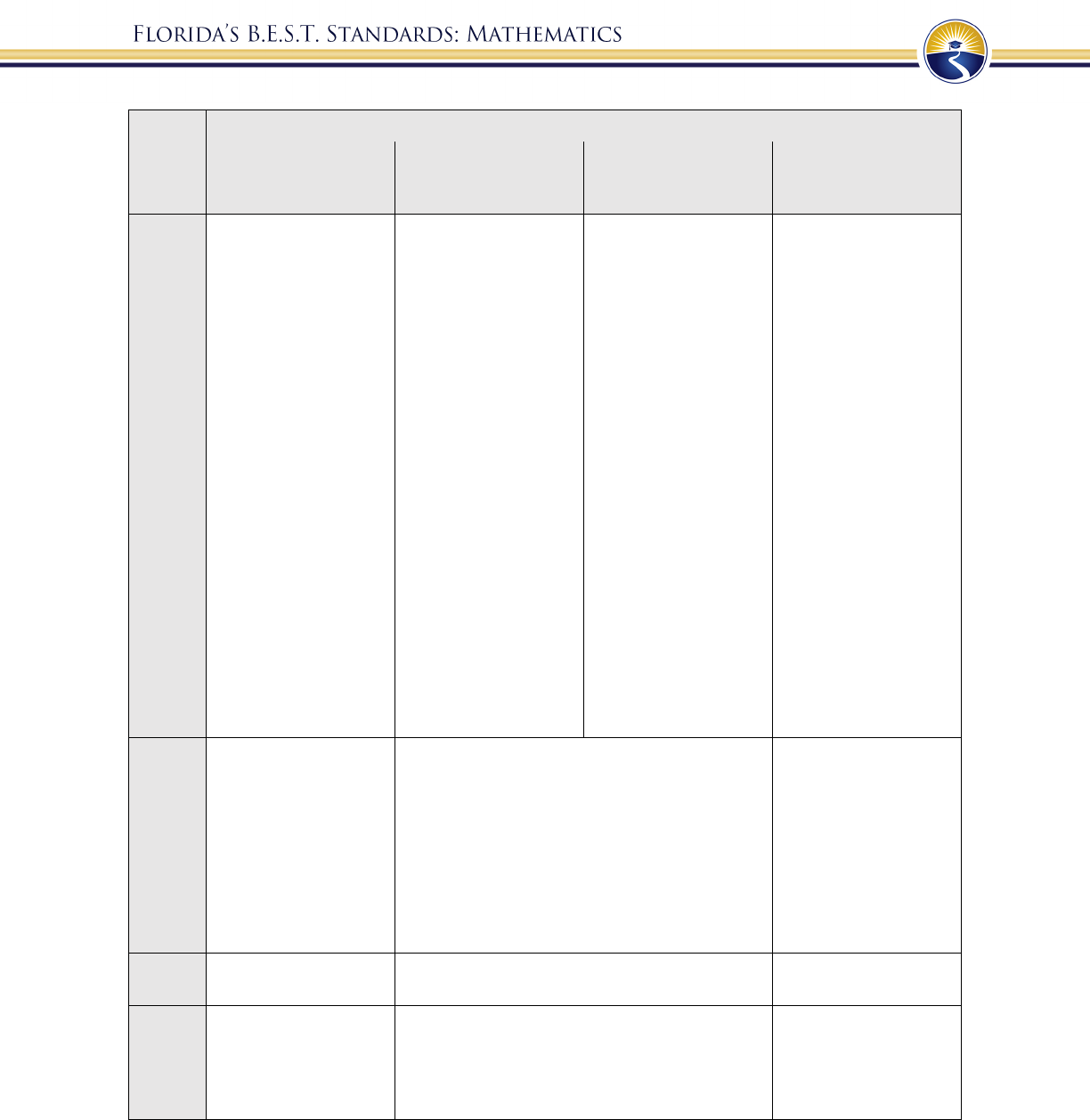
170
Grade
Level
Required Procedural Reliability, Procedural Fluency and Basic Fact Automaticity
Number Sense:
Counting and Place
Value
Operations: Addition
and Subtraction
Operations:
Multiplication and
Division
Measurement
5
Round multi-digit
numbers with decimals
to the nearest hundredth,
tenth or whole number
Plot, order and compare
multi-digit numbers with
decimals up to the
thousandths
Procedural Fluency:
Multi-digit numbers
with decimals to the
thousandths, including
using a standard
algorithm
Procedural Reliability:
Fractions with unlike
denominators, including
mixed numbers and
fractions greater than 1
Procedural Fluency:
Multiplication of multi-
digit whole numbers,
including using a
standard algorithm
Procedural Fluency:
Division of a whole
number up to five digits
by two digits, including
using a standard
algorithm
Procedural Reliability:
Multiply a multi-digit
number with decimals to
the tenths by one-tenth
or by one-hundredth
Procedural Reliability:
Multiplication of a
fraction by a fraction,
including mixed
numbers and fractions
greater than 1
6
Plot, order and compare
rational numbers
Procedural Fluency:
Positive multi-digit decimals, including using a
standard algorithm
Procedural Fluency:
Positive fractions, including mixed numbers and
fractions greater than 1
Procedural Fluency:
Integers
7
Procedural Fluency:
Rational numbers
8
Plot, order and compare
rational and irrational
numbers
Procedural Fluency:
Numbers expressed in scientific notation
Procedural Fluency:
Laws of Exponents
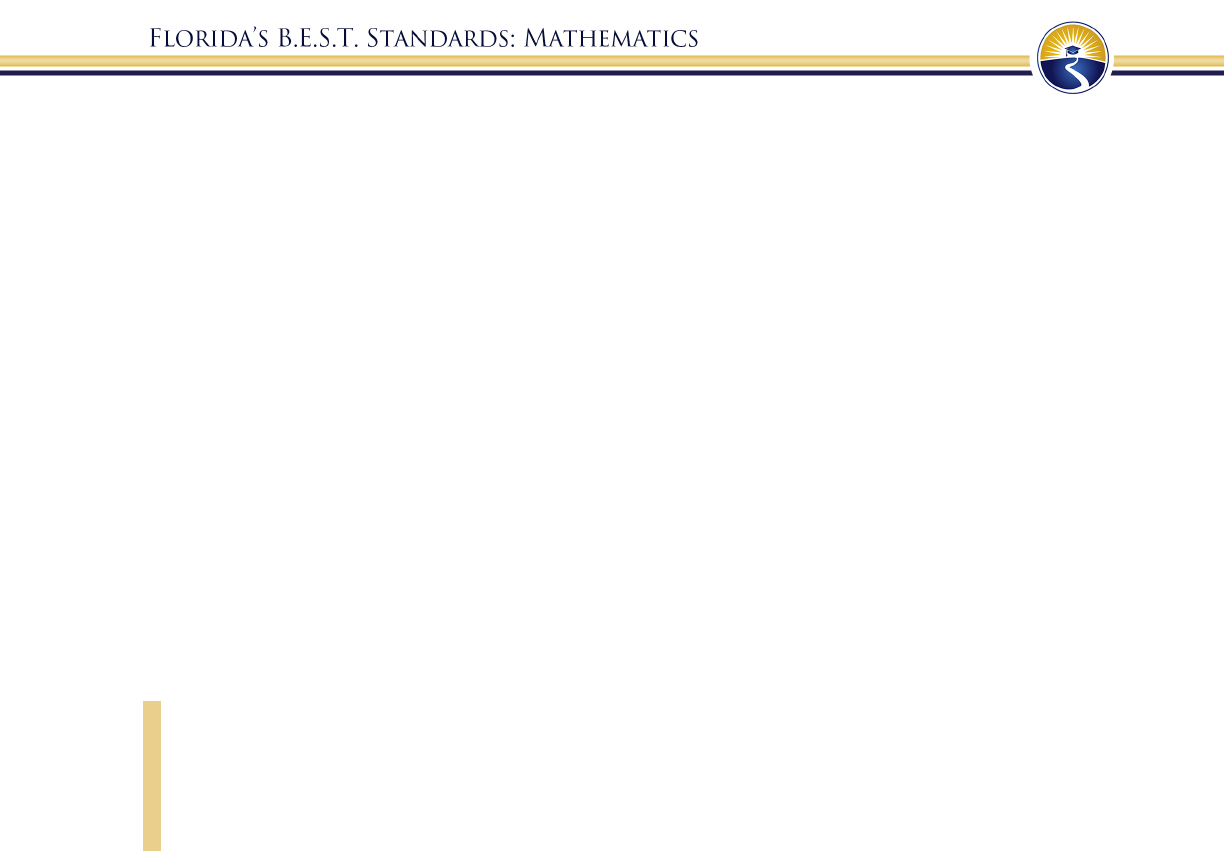
171
Appendix C: K-12 Mathematics
Glossary
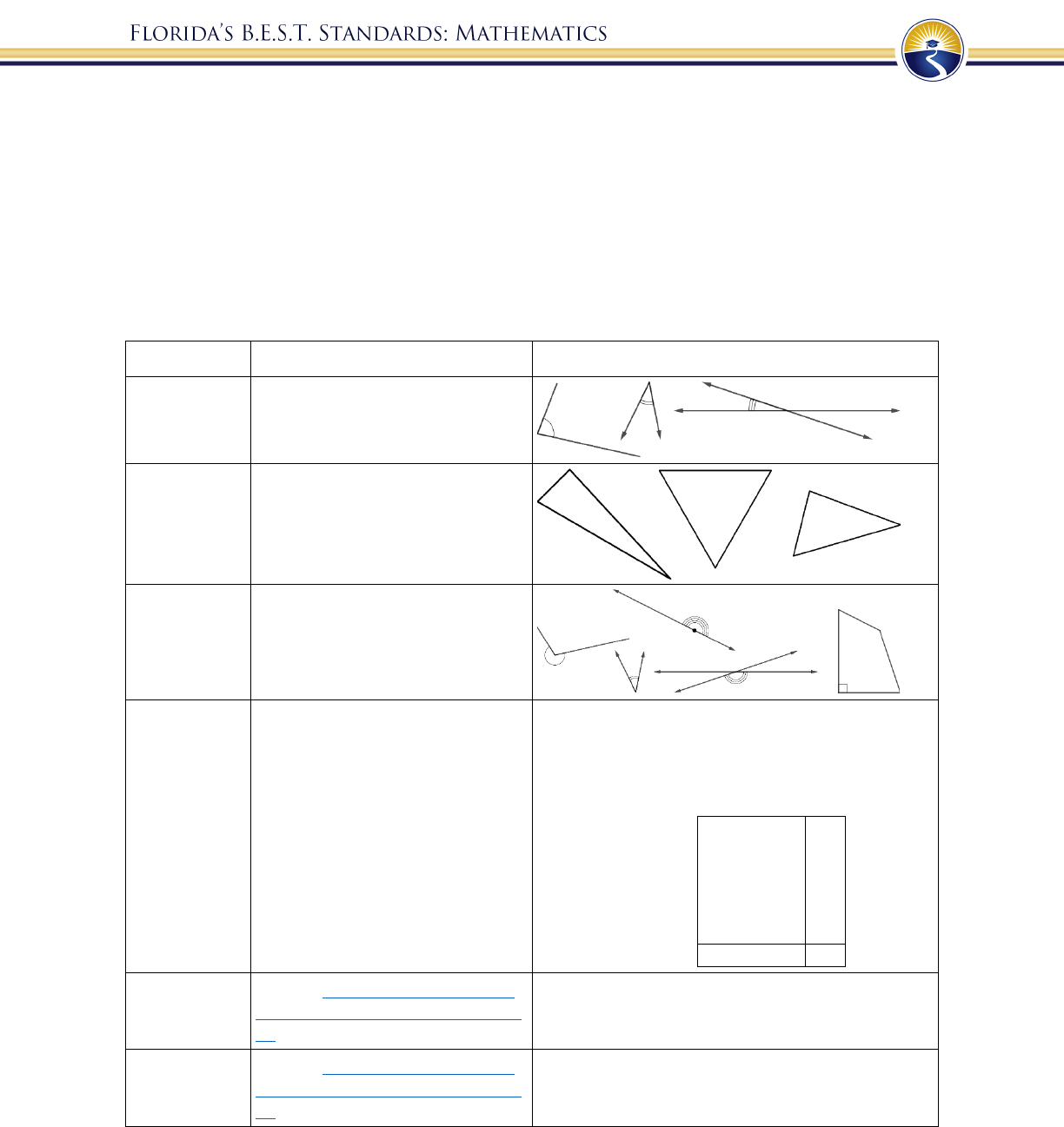
172
K-5 Mathematics Glossary
The following glossary is a reference list provided for teachers to support the
expectations of the Florida’s B.E.S.T Standards for Mathematics for Kindergarten to grade five.
This glossary is not intended to comprise a comprehensive vocabulary list for teachers or
students. The Florida Department of Education (FDOE) recognizes that there may be alternative
definitions for some terms that are also mathematically correct, however, the intention here is to
provide common language and shared understanding among all stakeholders in the state of
Florida.
Vocabulary
Definition
Example
acute angle
An angle larger than 0º and smaller
than 90º.
acute triangle
A triangle with all interior angles
smaller than 90°.
angle
Angles are formed wherever two
lines, segments, or rays intersect.
area model
A rectangular diagram that utilizes
the decomposition of side lengths
by place value to multiply numbers
using the distributive property.
32 × 12 can be thought of as
(30 × 10) + (30 × 2) + (2 × 10) + (2 × 2)
which is equivalent to 384. This is demonstrated in
the area model below.
10
2
30
300
60
2
20
4
associative
property of
addition
Refer to Properties of Operations,
Equality and Inequality (Appendix
D).
(5 + 6) + 9 = 5 + (6 + 9)
associative
property of
multiplication
Refer to Properties of Operations,
Equality and Inequality (Appendix
D).
(2 × 3) × 8 = 2 × (3 × 8)

173
Vocabulary
Definition
Example
automaticity
In mathematical activities, the
ability to act according to an
automatic response or pattern
which is easily retrieved from
long-term memory. Usually results
from repetition and practice.
bar graph
A visual display of categorical data
values where each category is
represented by a bar whose height
represents the number in that
category.
benchmark
angles
Widely recognized angles that are
used to classify and estimate angle
measures, including 30º, 45º, 60º,
90º.
Cardinality
Principle
The understanding that when the
objects in a collection are being
counted, the last count word in the
counting sequence represents the
total number of items in the
collection.
categorical
data
A type of data which is divided
into groups.
Examples of categorical data are type of pet, hair
color, favorite sport/game, etc.
circle
A perfectly round two-dimensional
figure, where all points on the
circle are equidistant from the
center.
0
2
4
6
8
Fish Dog Cat Lizard
What type of pet do you have?

174
Vocabulary
Definition
Example
circle graph
A visual display of categorical
data. The whole set of data is
represented by the circle and its
interior. The categories are
represented by fractional parts of
the circle. Also called a pie chart.
commutative
property of
addition
Refer to Properties of Operations,
Equality and Inequality (Appendix
D).
2 + 3 = 5 and 3 + 2 = 5
commutative
property of
multiplication
Refer to Properties of Operations,
Equality and Inequality (Appendix
D).
2 × 3 = 6 and 3 × 2 = 6
composite
figure
A two- or three-dimensional figure
that can be decomposed into
smaller figures.
A rectangle can be decomposed into two right
triangles.
The polygons below could be decomposed into the
smaller figures represented by the dotted lines.
composite
number
A whole number greater than 1
that has at least one whole-number
divisor other than 1 and itself.
4 is composite because it has three unique, whole-
number divisors: 1, 2, 4
24 is composite because it has eight unique, whole-
number divisors: 1, 2, 3, 4, 6, 8, 12, 24
23 is not
composite because it only has two unique,
whole-number divisors: 1, 23
1 is not composite because it only has one unique,
whole-number divisor: 1
1
9
4
5
1
Methods of Traveling to School
Walk Car Bus Bicycle Train
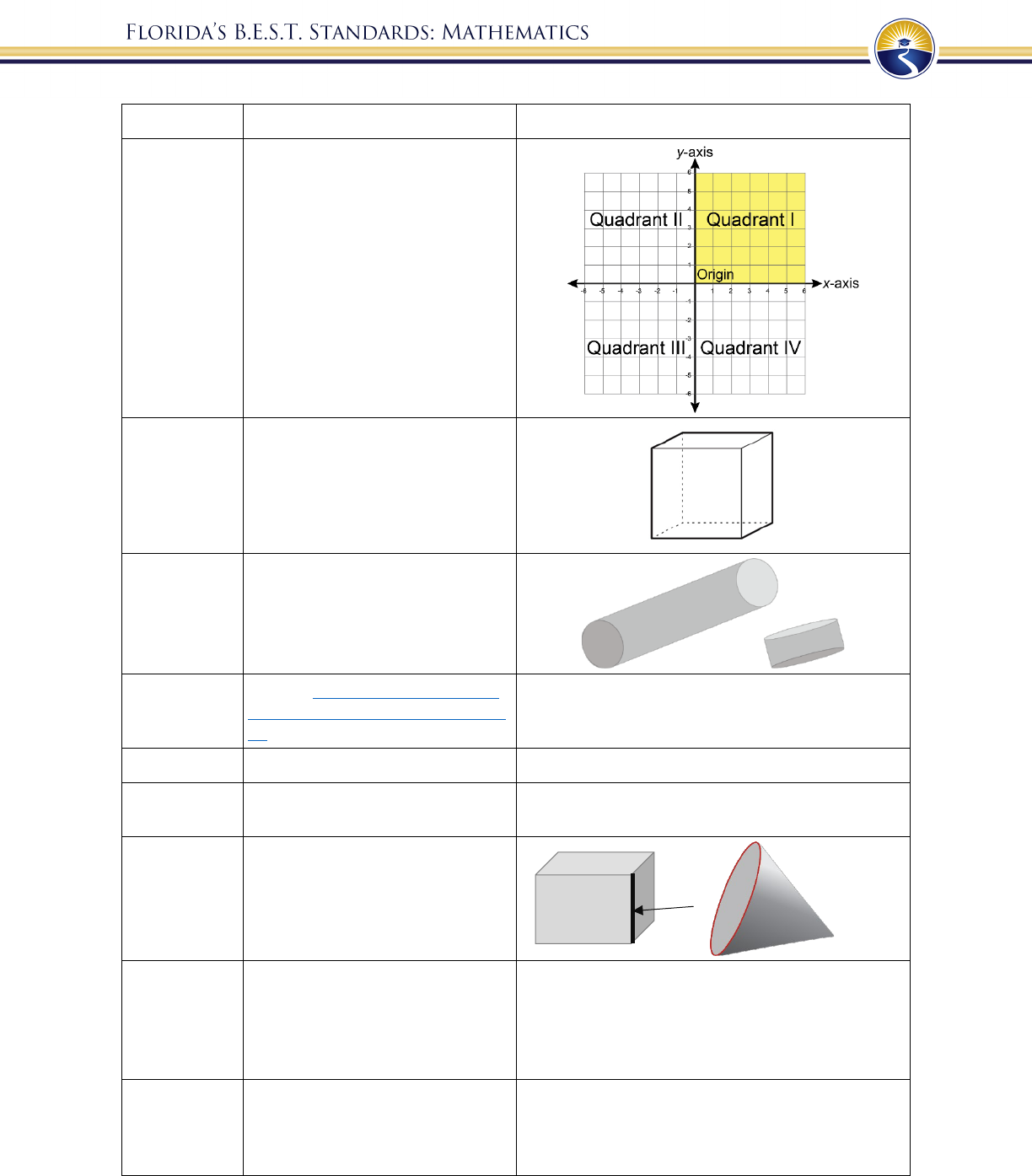
175
Vocabulary
Definition
Example
coordinate
plane (first
quadrant)
An infinite two-dimensional space
bounded on two sides by two
perpendicular scaled axes. The
axes intersect at the origin. Each
point in the coordinate plane is
represented by a pair of
coordinates that represent the
distances from each axis. The
origin is represented by the
coordinate pair (0,0).
cube
A rectangular prism with six
congruent square faces.
cylinder (right
circular)
A figure containing two congruent,
parallel, circular bases whose
edges are connected by a
perpendicular curved surface.
distributive
property
Refer to Properties of Operations,
Equality and Inequality (Appendix
D).
6
(
2 + 3
)
= (6 × 2) + (6 × 3)
dividend
A quantity that is to be divided.
In the equation 6 ÷ 2 = 3, 6 is the dividend.
divisor
The number by which another
number is divided.
In the equation 6 ÷ 2 = 3, 2 is the divisor.
edge
In a figure, the segment or curve
where two faces intersect.
equal sign
The equal sign is placed between
two quantities or expressions to
indicate they have the same value
or represent the same value.
7 = 3 + 4
4 × 2 = 5 + 3
5+? = 17 is true if ? = 12.
equation
A mathematical relation statement
where two equivalent expressions
and values are separated by an
equal sign.
55 ÷ 5 = 24 13
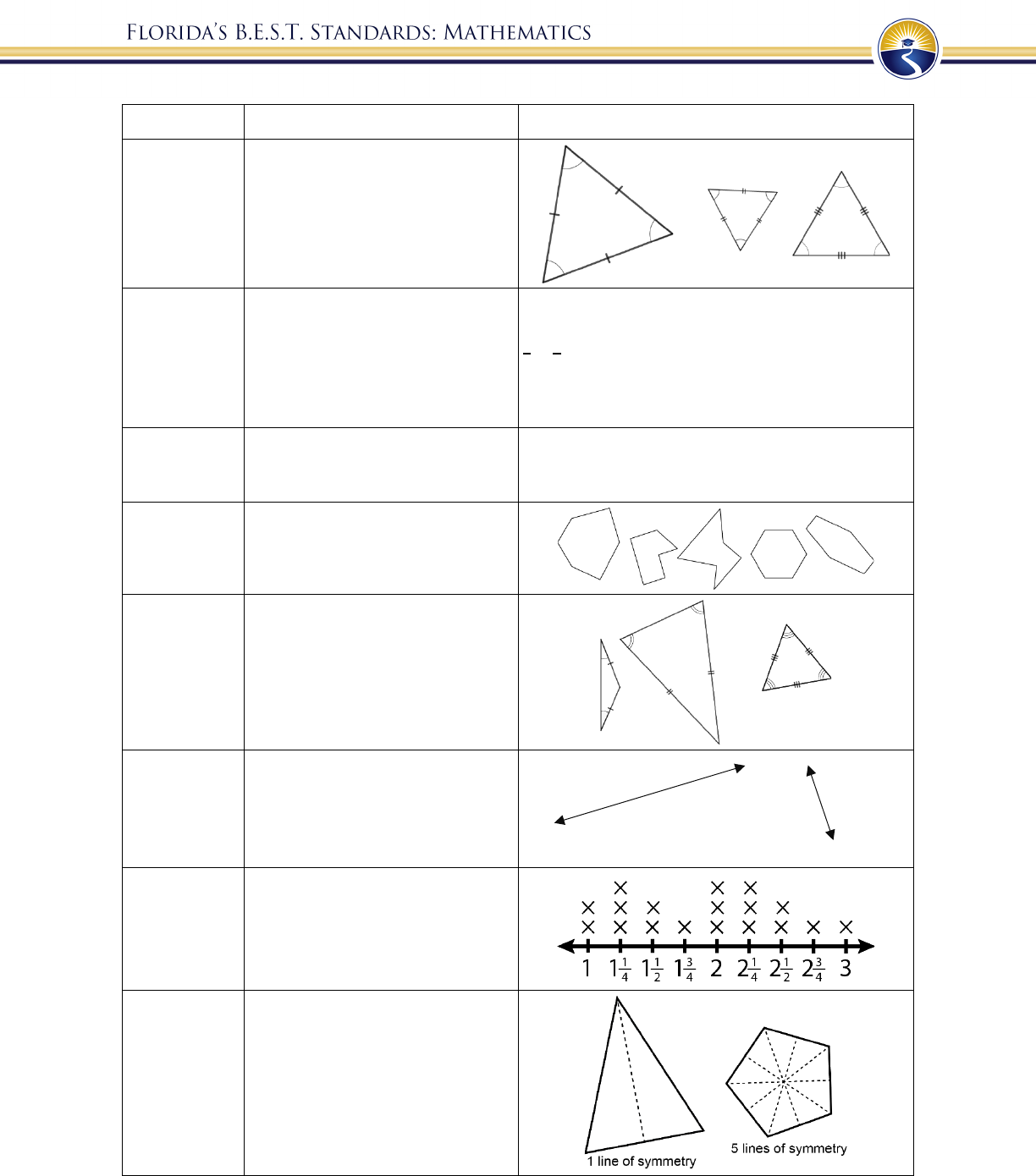
176
Vocabulary
Definition
Example
equilateral
triangle
A triangle with three equal-length
sides and three 60-degree interior
angles. Also known as an
equiangular triangle.
expression
A mathematical statement
containing numerals, operators,
grouping symbols and symbols or
variables for unknown values. An
expression does not contain an
equal sign or inequality symbol.
4 × 2
factors (of
positive whole
numbers)
Whole numbers into which a
positive whole number can be
evenly divided.
1, 3, 5, and 15 are factors of 15
One is a factor of every whole number.
hexagon
A polygon containing exactly six
sides and six vertices.
isosceles
triangle
A triangle containing at least two
equal length sides and two equal
interior angle measures. Sub-class
includes equilateral triangles.
line
In geometry, a straight path that
extends infinitely in both
directions. Represented in
diagrams as line with arrowheads
at both ends.
line plot
A method of visually displaying a
distribution of data values where
each data value is shown as a dot
or mark above a number line. Also
known as a dot plot.
line of
symmetry
A line that divides a figure into
two parts with the same shape and
size. When the figure is folded
along the line of symmetry, the
two parts match.
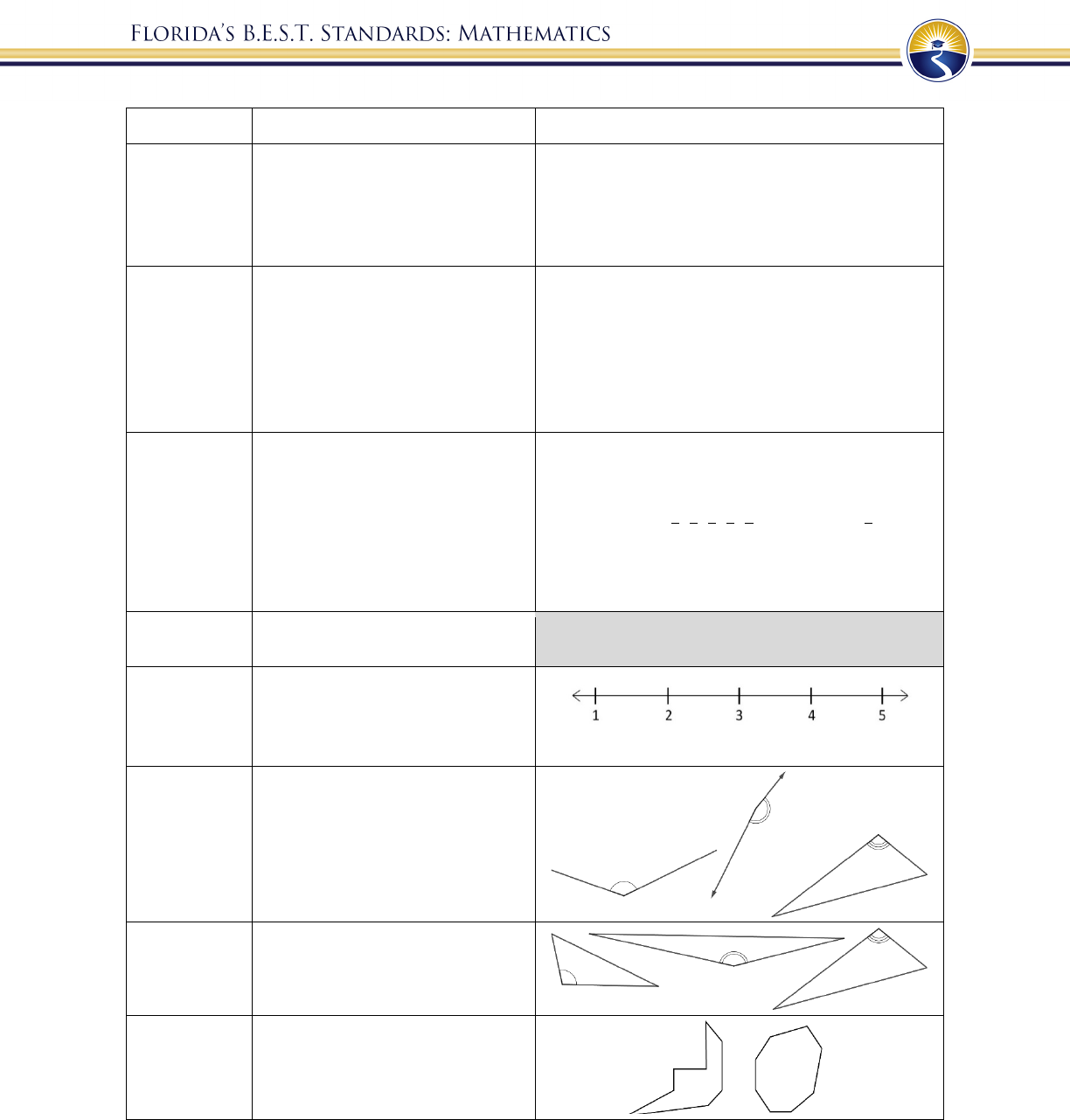
177
Vocabulary
Definition
Example
mean
The arithmetic average of a set of
numbers found by dividing the
sum of all values by the number of
values. It is a measure of central
tendency.
For the data set {2.3, 5.1, 9, 9, 11.5, 12, 17.1}, the
mean is 9.4.
For the data set {8, 9, 27, 11, 5, 3}, the mean is
10.5.
median
The middle of an ordered list of
values. If the list has an odd
number of values, it is the middle
value of that list. If the list has an
even number of values, it is the
mean of the two middle values. It
is a measure of central tendency.
For the data set
{23, 25, 26, 37, 40, 42, 44, 44, 48, 90}, the median
is 41.
For the data set {4, 7, 8, 11, 14, 16, 20}, the median
is 11.
mode
The value found most often in a set
of numbers. There may be no
mode, one mode, or more than one
mode in a set of numbers. It is a
measure of central tendency.
For the data set {3.3, 5, 13.7, 6.2, 9.3, 9}, there is no
mode.
For the data set
,
,
,
,
, the mode is
.
For the data set {32, 73, 88, 35, 42, 73, 33, 88, 64},
the modes are 73 and 88.
natural
number
The counting numbers {1, 2, 3, 4,
5…}.
number line
A straight line with evenly spaced
marks labeled with successive
numbers. Values are plotted as
points on the line.
obtuse angle
An angle larger than 90º and
smaller than 180º.
obtuse triangle
A triangle containing one interior
angle larger than 90º.
octagon
A polygon containing exactly eight
sides and eight vertices.
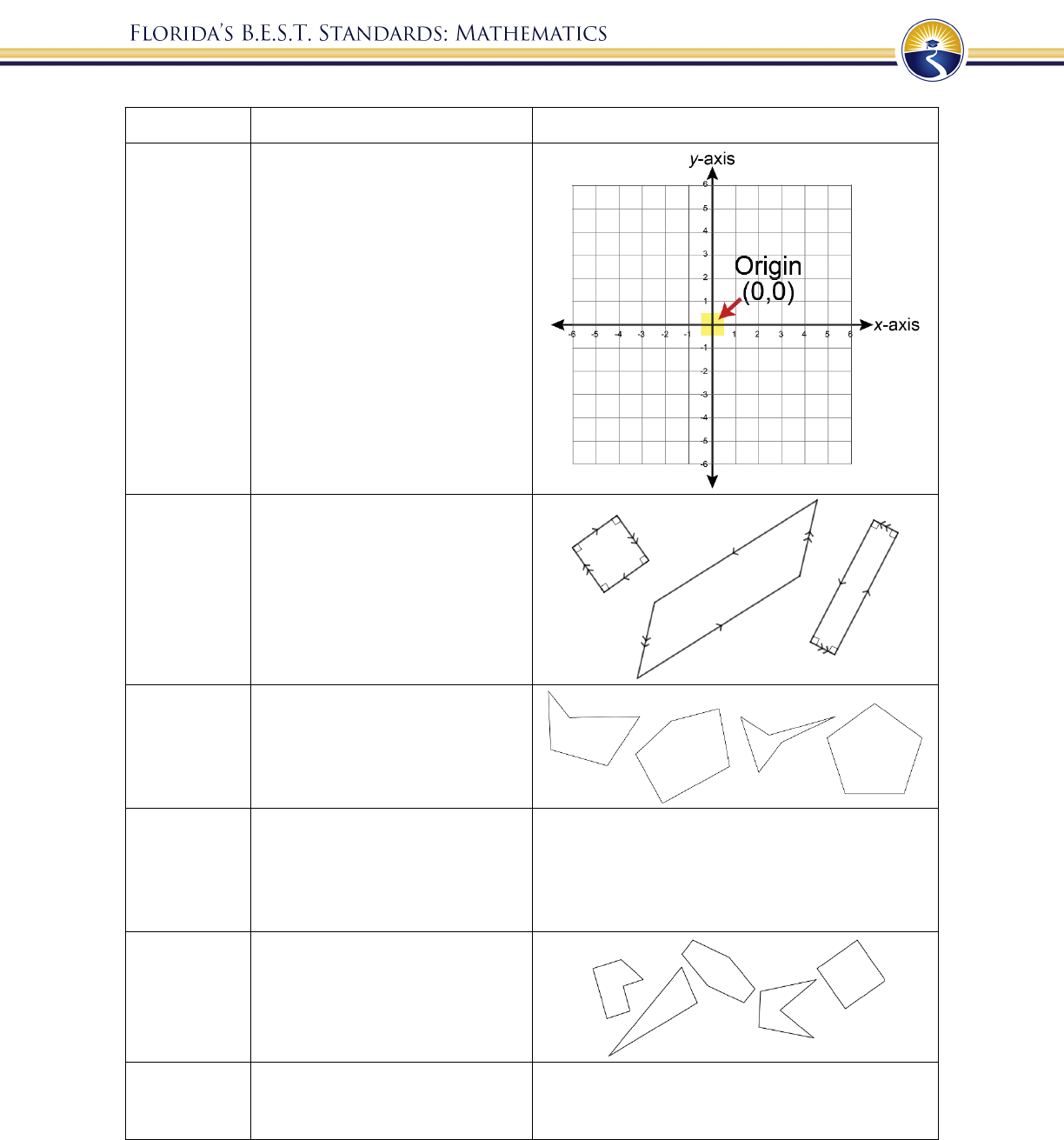
178
Vocabulary
Definition
Example
origin
In the coordinate place, the
location where the x-axis and y-
axis intersect. The coordinates of
the origin are (0,0).
parallelogram
A quadrilateral containing two
pairs of parallel sides. A member
of the following shape classes:
polygons, quadrilaterals,
trapezoids. Sub-classes include
rectangles, rhombi, and squares.
pentagon
A polygon containing exactly five
sides and five vertices.
perimeter (of a
polygon)
The sum of the side lengths of a
polygon.
Rectangle: = + + +
= 2+ 2
Square: = + + +
= 4
polygon
A closed two-dimensional figure
composed of at least three straight
sides and three vertices.
prime number
A whole number greater than 1
that is not divisible by any whole
number other than 1 and itself.
17 is a prime number.
16 is not a prime number.
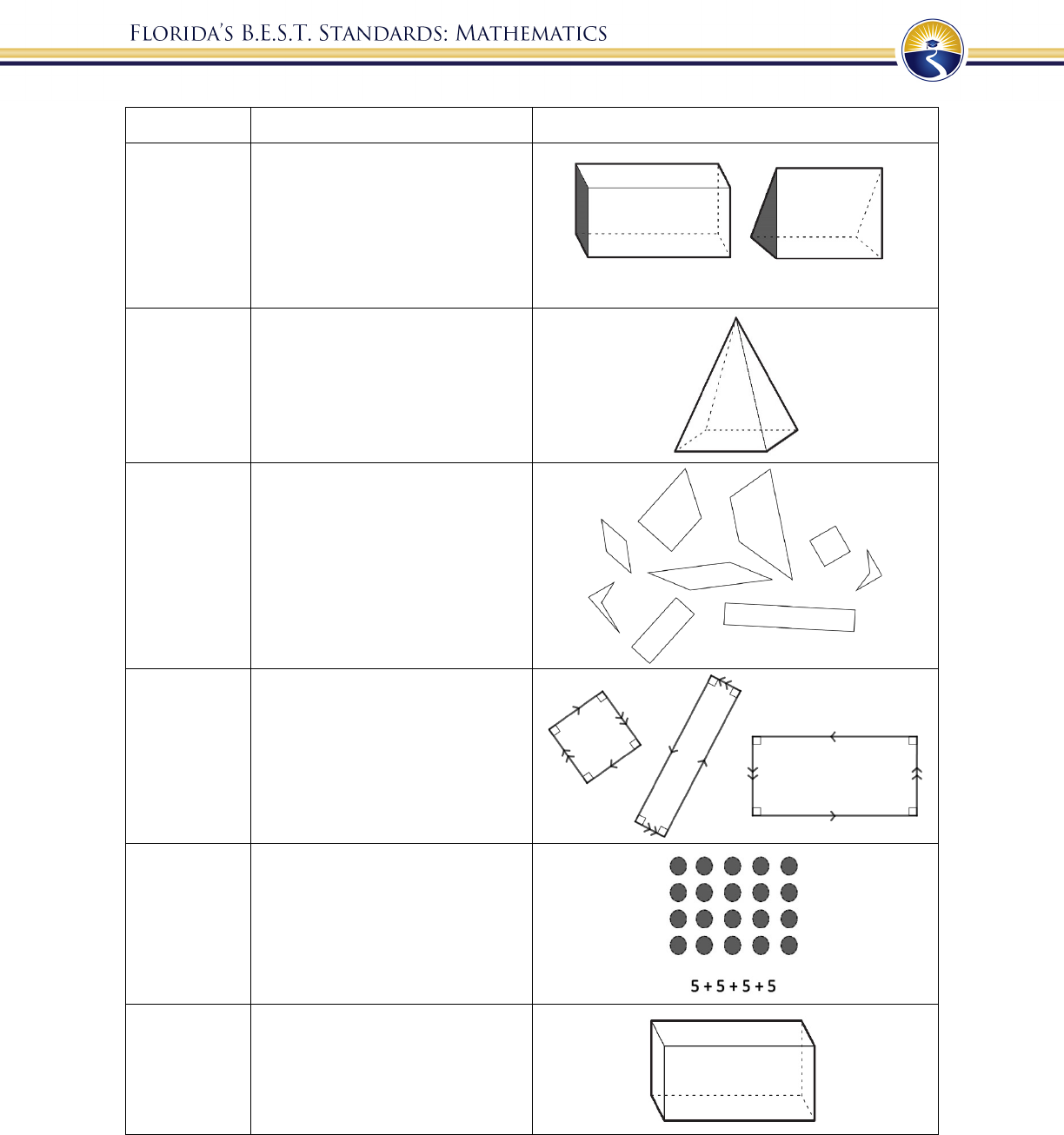
179
Vocabulary
Definition
Example
prism (right)
A figure with two parallel bases
that are the same shape and size.
The bases are connected by
rectangular faces that are
perpendicular to the bases. A box
with identical polygons on each
end.
pyramid
(regular)
A figure containing a polygonal
base and triangular faces. The
triangular faces have the same size
and shape and they connect the
sides of the base to a common
point called the apex.
quadrilateral
A polygon with exactly four sides
and four vertices. Sub-classes
include trapezoids, parallelograms,
rectangles, rhombi, and squares.
rectangle
A quadrilateral containing four
right angles. Rectangles may be
oblong or square. A member of the
following shape classes: polygons,
quadrilaterals, trapezoids,
parallelograms. Squares form a
sub-class.
rectangular
array
An arrangement of objects or
symbols in rows and columns. All
rows have an equal number and all
columns have an equal number.
rectangular
prism
A prism with rectangular bases.
Cubes form a sub-class.
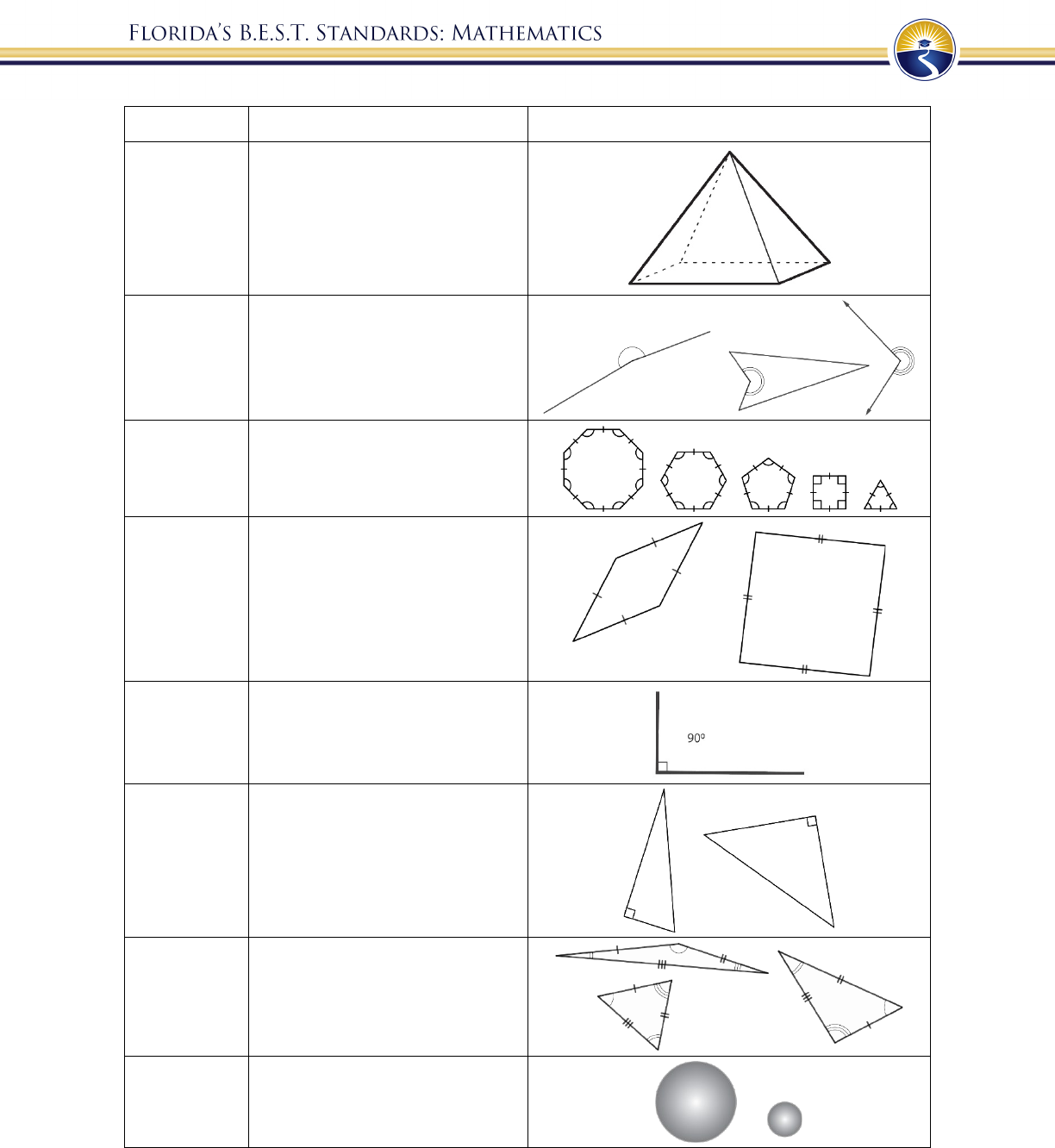
180
Vocabulary
Definition
Example
rectangular
pyramid
A pyramid with a rectangular base.
reflex angle
An angle larger than 180º and
smaller than 360º.
regular
polygon
A polygon containing all equal-
length sides and all equal-measure
interior angles.
rhombus
A quadrilateral containing four
equal-length sides. A member of
the following shape classes:
polygons, quadrilaterals,
trapezoids, parallelograms.
Squares form a sub-class.
right angle
An angle measuring exactly 90º.
right triangle
A triangle containing an interior
right angle.
scalene
triangle
A triangle containing three unequal
side lengths and three unequal
angle measures.
sphere
A three-dimensional figure with all
points equidistant from a point
called the center.
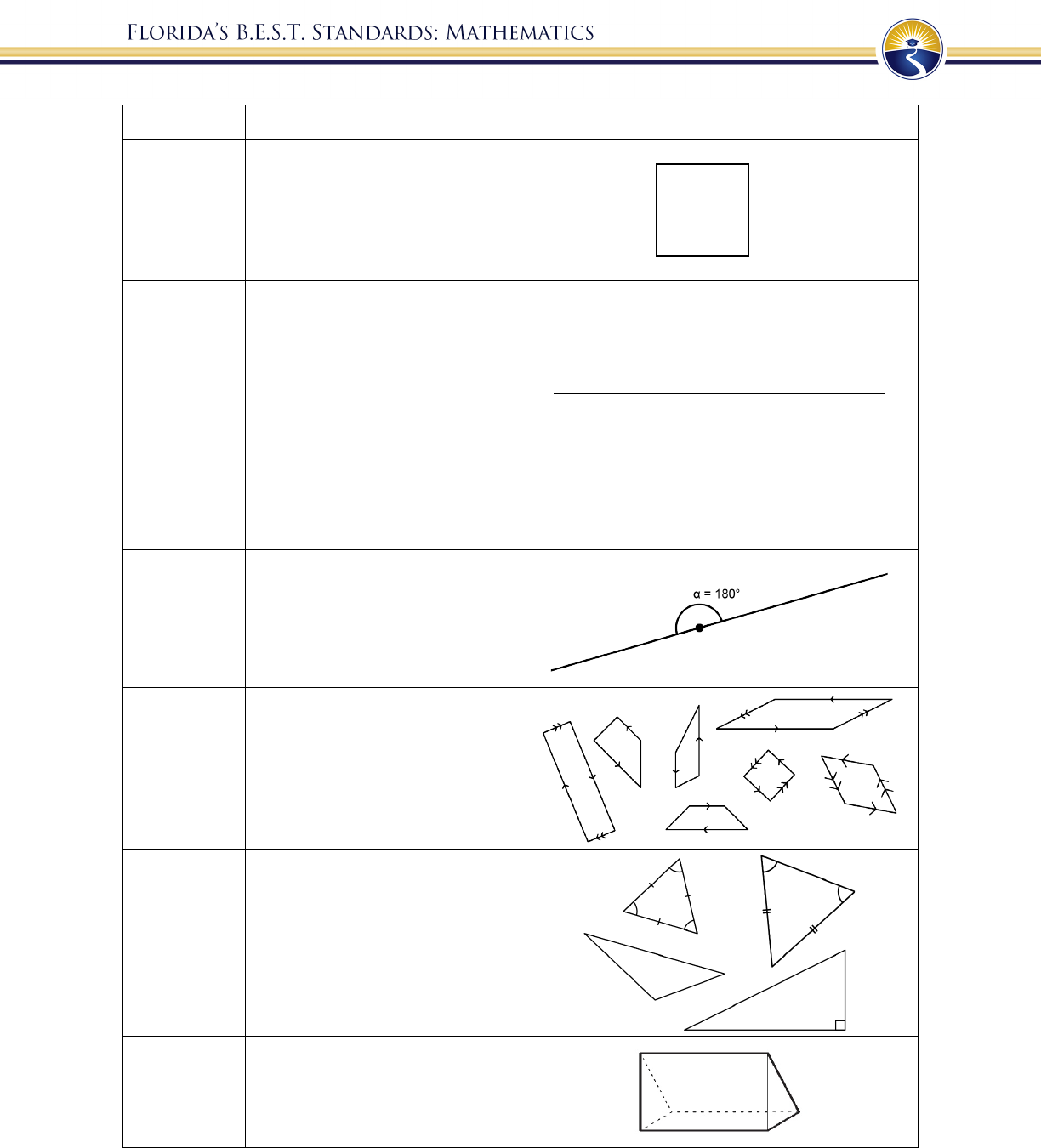
181
Vocabulary
Definition
Example
square
A quadrilateral with four right
angles and four equal-length sides.
A member of the following shape
classes: polygons, quadrilaterals,
trapezoids, parallelograms,
rectangles, rhombuses.
stem-and-leaf
plot
A table that organizes data by
place value to compare data
frequencies.
The data set {1, 4, 5, 8, 10, 11, 13, 27, 27, 28, 30,
31, 31, 40, 44, 63, 66} can be organized in a stem-
and-leaf plot as shown below.
stem
leaf
0
1, 4, 5, 8
1
0, 1, 3,
2
7, 7, 8
3
0, 1, 1,
4
0, 4,
5
6
3, 6
straight angle
An angle measuring exactly 180º.
trapezoid
A quadrilateral with at least one
pair of parallel sides. A member of
the following shape classes:
polygons, quadrilaterals. Sub-
classes include parallelograms,
rectangles, rhombuses, and
squares.
triangle
A polygon with exactly three sides
and three vertices.
triangular
prism
A prism with triangular bases.
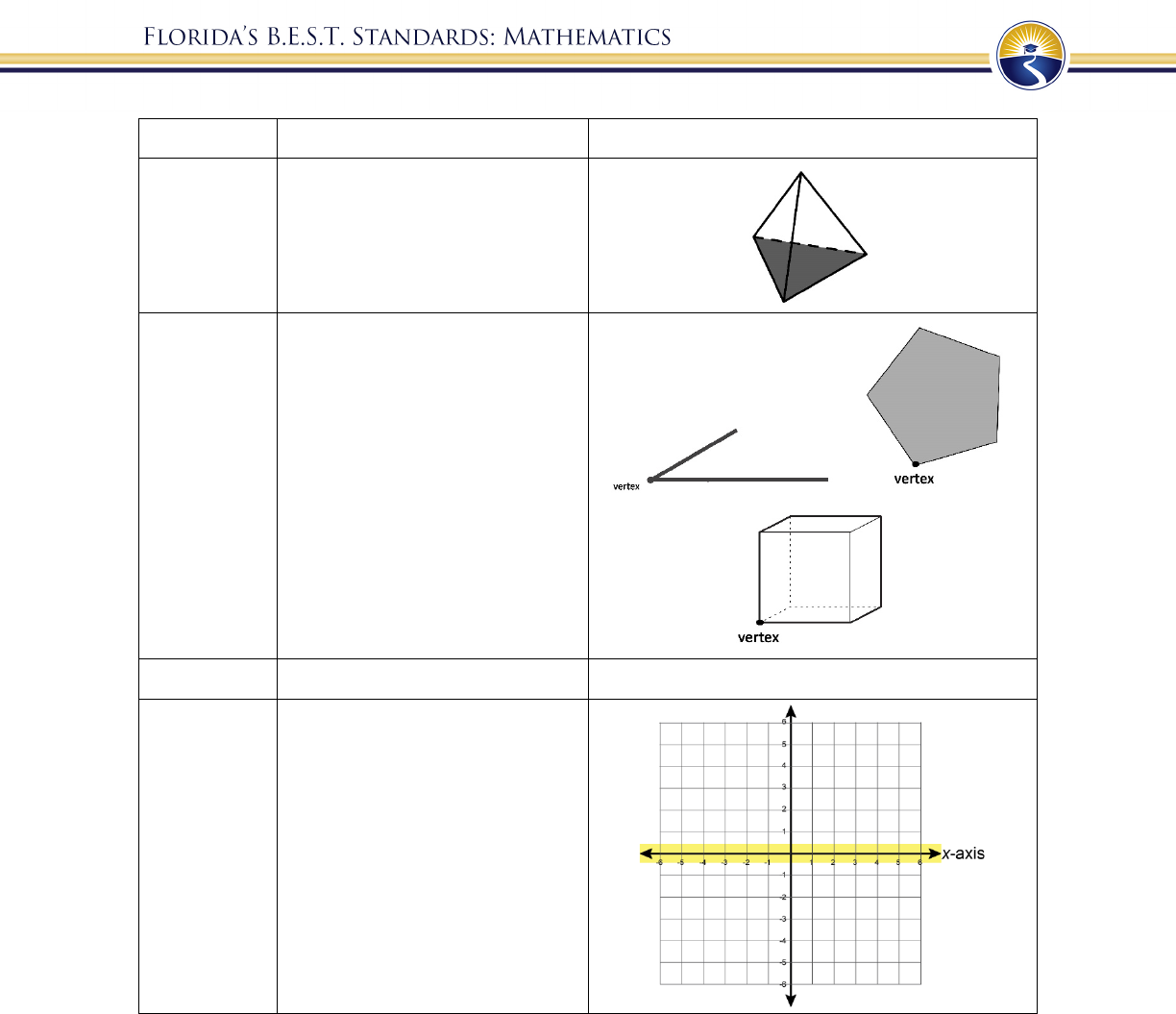
182
Vocabulary
Definition
Example
triangular
pyramid
A pyramid with a triangular base.
vertex (of a
figure)
The point at which the rays or
sides of an angle, the sides of a
two-dimensional figure, or the
edges of a three-
dimensional figure
meet.
whole number
The natural numbers and zero.
{0, 1, 2, 3, 4, 5,…}.
x-axis
The horizontal axis in certain
graphs, and in the coordinate
system. In the coordinate system,
the x-axis divides positive y-values
from negative y-values, and the y-
value of any point lying on the x-
axis equals zero.
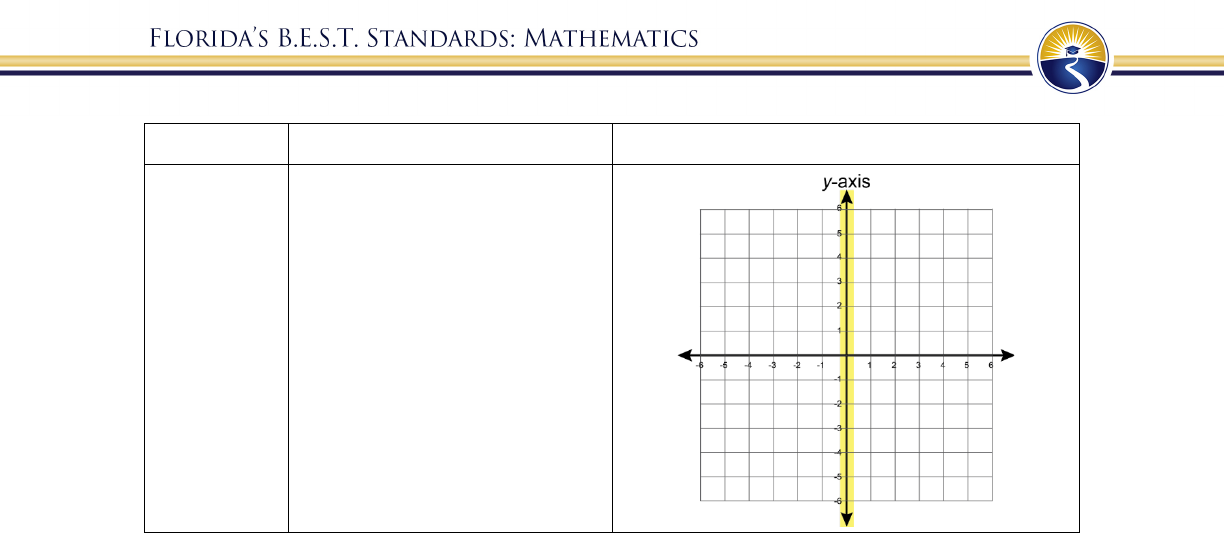
183
Vocabulary
Definition
Example
y-axis
The vertical axis in certain graphs,
and in the coordinate system. In
the coordinate system, the y-axis
divides positive x-values from
negative x-values, and the x-value
of any point lying on the y-axis
equals zero.
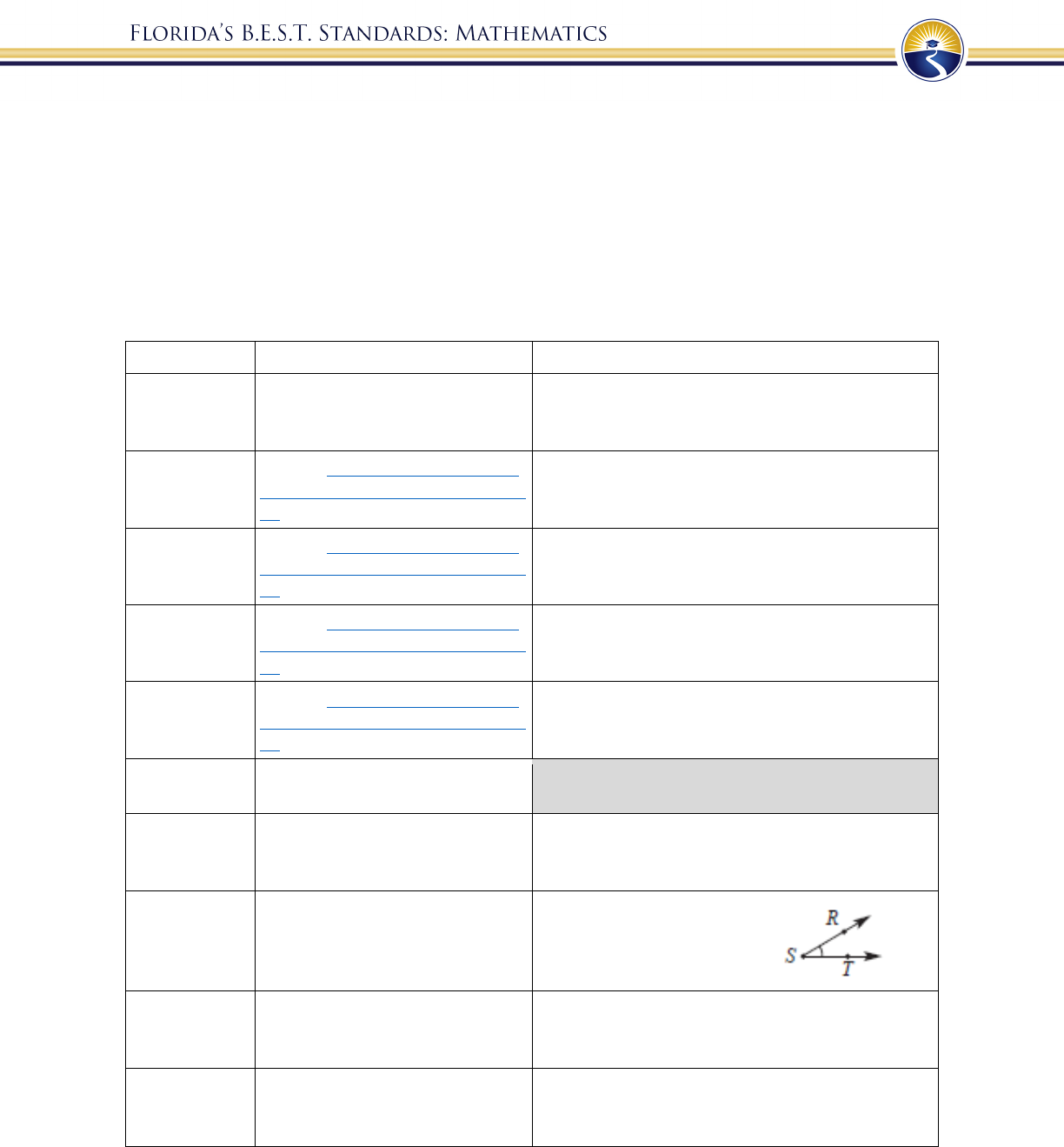
184
6-12 Mathematics Glossary
The following glossary is a reference list provided for teachers to support the
expectations of the Florida’s B.E.S.T Standards for Mathematics for grades six to twelve. This
glossary is not intended to comprise a comprehensive vocabulary list for teachers or students.
The Florida Department of Education (FDOE) recognizes that there may be alternative
definitions for some terms that are also mathematically correct, however, the intention here is to
provide common language and shared understanding among all stakeholders in the state of
Florida.
Vocabulary
Definition
Example
absolute value
A number’s distance from zero (0)
on a number line. Distance is
expressed as a positive value.
|
3
|
= 3 and
|
3
|
= 3
additive
identity
property
Refer to Properties of Operations,
Equality and
Inequality (Appendix
D).
5 + 0 = 5
additive
inverse
property
Refer to Properties of Operations,
Equality and Inequality (Appendix
D).
In the equation 3 + 3 = 0, 3 and 3 are additive
inverses of each other
addition
property of
equality
Refer to Properties of Operations,
Equality and Inequality (Appendix
D).
If 3 = 7, then 3 + 3 = 7 + 3.
addition
property of
inequality
Refer to Properties of Operations,
Equality and Inequality (Appendix
D).
If 3 > 7, then 3 + 3 > 7 + 3.
algorithm
A step-by-step way to solve a
problem.
analytic
geometry
The branch of mathematics that
uses functions and relations to
study geometric phenomena.
The description of ellipses and other conic sections
in the coordinate plane by quadratic equations
angle
(
)
Angles are formed wherever two
lines, segments or rays intersect.
Angles are measured in degrees.
In the figure, the angle can
be named , , .
area
The measure, in square units, of
the inside region of a closed two-
dimensional figure.
The area of a rectangle with dimensions 5 units by
8 units is 40 square units.
arithmetic
sequence
A sequence of numbers in which
each consecutive pair of numbers
has a common difference.
The th term of an arithmetic sequence with the
first term
and common difference is given by
=
+
(
1
)
, where is a positive integer.
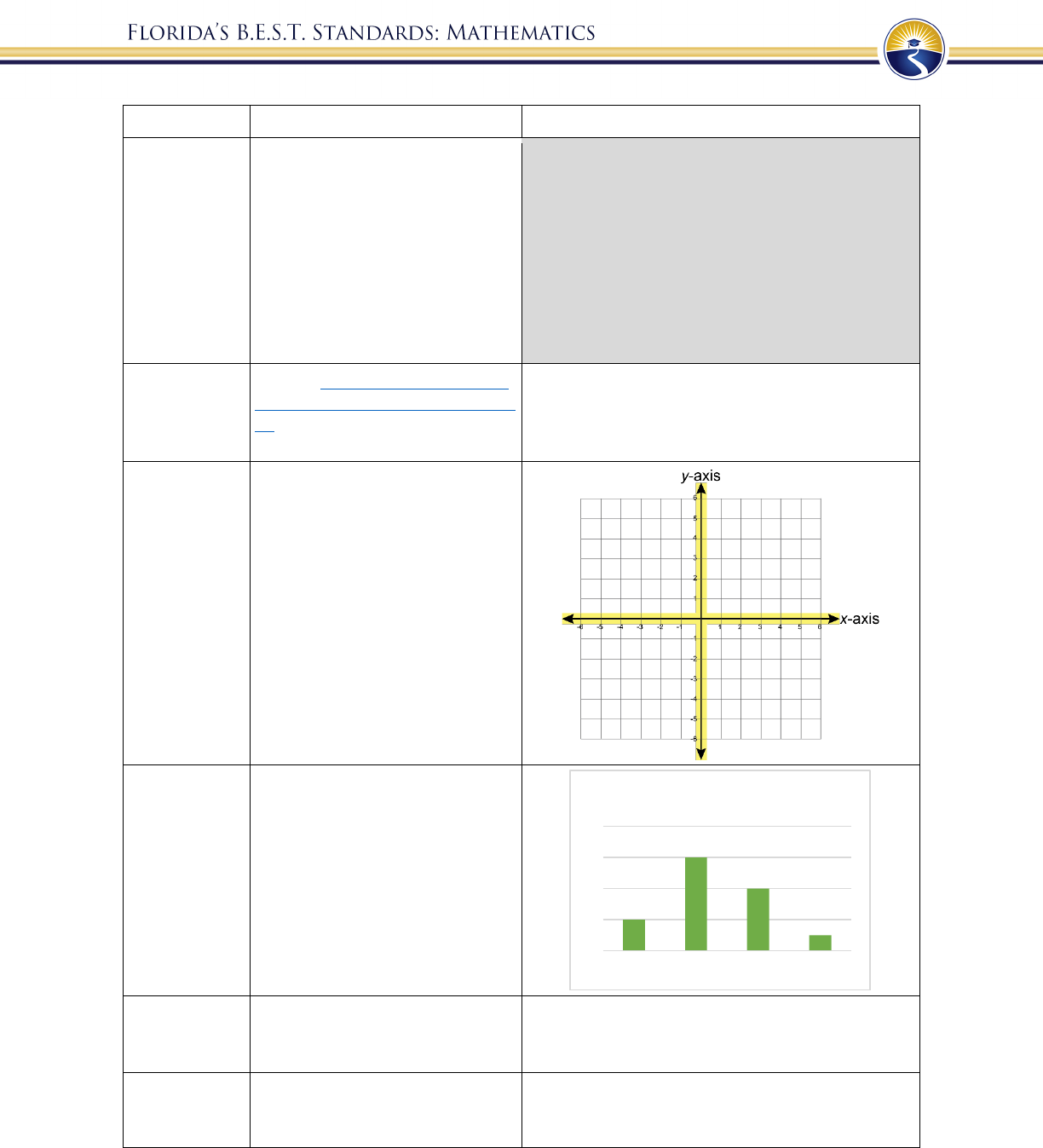
185
Vocabulary
Definition
Example
association
A way to describe the form,
direction or strength of the
relationship between the two
variables in a bivariate data set.
For numerical data, descriptions
include linear or nonlinear;
positive or negative; strong or
weak. For categorical data,
descriptions include strong or
weak.
associative
property
Refer to Properties of Operations,
Equality and Inequality (Appendix
D).
(
5 + 6
)
+ 9 = 5 + (6 + 9)
(
2 × 3
)
× 8 = 2 × (3 × 8)
axes (of a
graph)
The horizontal and vertical
number lines used in a coordinate
plane system.
bar graph
A visual display of categorical
data values where each category is
represented by a bar whose height
represents the number in that
category. Bar graphs can be
represented vertically or
horizontally.
base (of an
exponent)
The number used as a factor in
exponential form.
is the exponential form of × × . The
variable is called the base, and the numeral 3 is
called the exponent.
bivariate data
Data that measures two
characteristics of a population.
hair color and eye color
height and weight
0
2
4
6
8
Fish Dog Cat Lizard
What type of pet do you have?

186
Vocabulary
Definition
Example
box plot
A plot displaying the spread or
distribution of a data set using a
five number summary, the
minimum, lower quartile, median,
upper quartile and maximum. It is
also called a box-and-whisker
plot.
capacity
The amount of space that can be
filled in a container. Both capacity
and volume are used to measure
three-dimensional spaces;
however, capacity usually refers to
fluid measures, whereas volume is
measured in cubic units.
categorical
data
A type of data which is divided
into groups. Categorical data are
qualitative.
Examples of categorical data are type of pet, movie
genre, favorite sport/game, etc.
central angle
An angle that has its vertex at the
center of a circle with radii as its
sides.
circle graph
A visual display of categorical
data. The whole set of data is
represented by the circle and its
interior. The categories are
represented by fractional parts of
the circle. Also called a pie chart.
circumference
The distance around a circle.
A circle with radius 3 units has a circumference of
6 units.
circumscribed
polygon
A polygon that is surrounded by a
circle that is as small as possible.
If it is a regular polygon, then
each vertex intersects the circle.
3%
70%
9%
11%
7%
Methods of Traveling to School
Walk Car Bus Bicycle Train
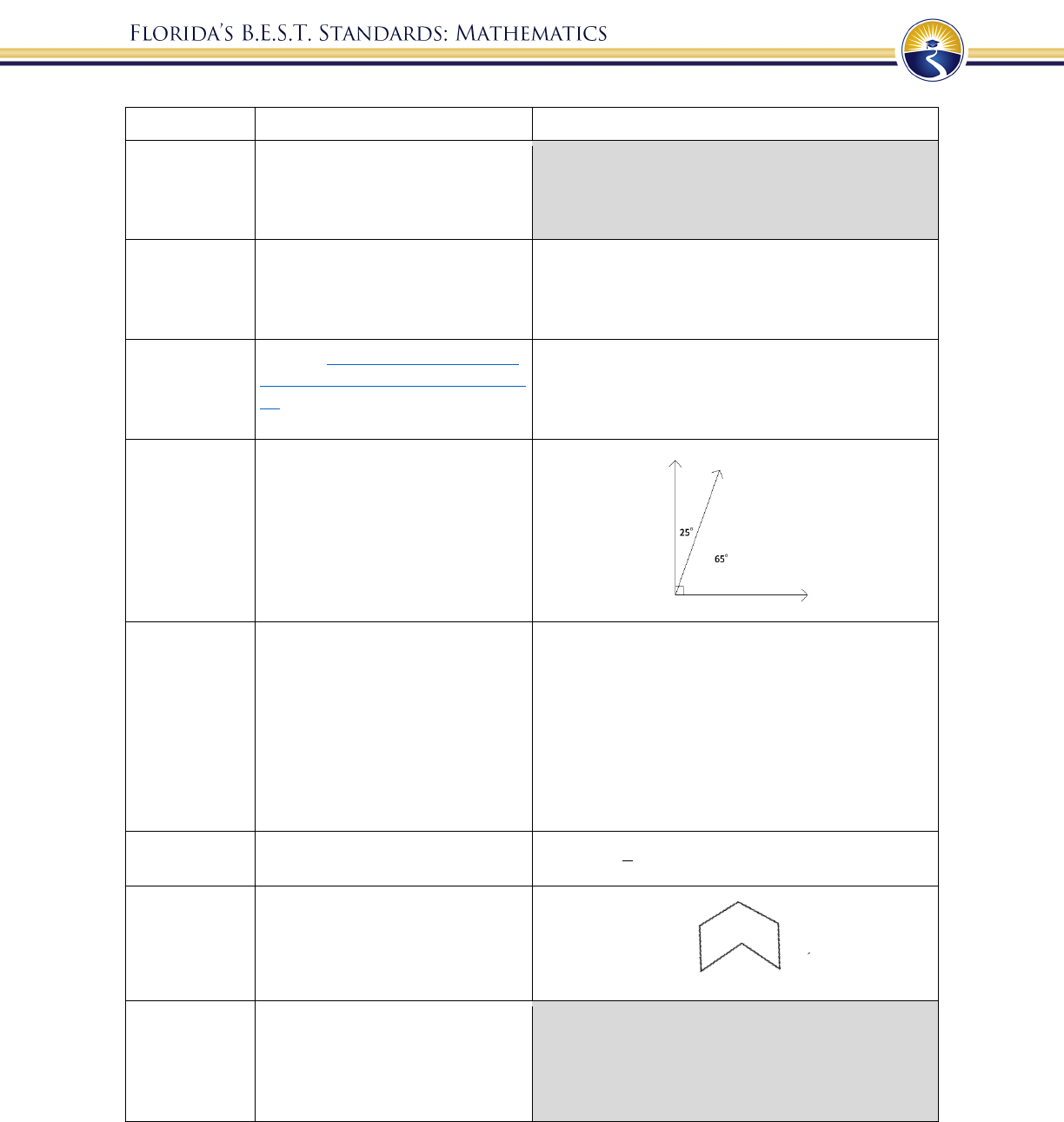
187
Vocabulary
Definition
Example
cluster (data)
Data that are in a close group on a
scatter plot or univariate
numerical data that have similar
values.
coefficient
The number or constant that
multiplies a variable in an
algebraic expression. If no number
is specified, the coefficient is 1.
Within the expression 4, 4 is the coefficient.
Within the equation = + , m is the
coefficient of .
commutative
property (of
addition or
multiplication)
Refer to Properties of Operations,
Equality and Inequality (Appendi
x
D).
2 + 3 = 3 + 2
4 × 7 = 7 × 4
complementary
angles
Two angles whose measures sum
to 90°.
composite
number
A whole number greater than 1
that has at least one whole-
number
factor other than one and itself.
4 is composite because it has three unique, whole-
number factors: 1, 2, 4
24 is composite because it has eight unique, whole-
number factors: 1, 2, 3, 4, 6, 8, 12, 24
23 is not
composite because it only has two unique,
whole-number factors: 1, 23
1 is not composite because it only has one unique,
whole-number factor: 1
compound
inequality
A conjunction of two or more
inequalities.
4
3
5
concave
polygon
A polygon with one or more
diagonals that have points outside
the polygon. See convex polygon.
conditional
relative
frequency
The ratio of a joint relative
frequency and a marginal relative
frequency. Equivalently, the ratio
of a relative frequency and a
marginal frequency.
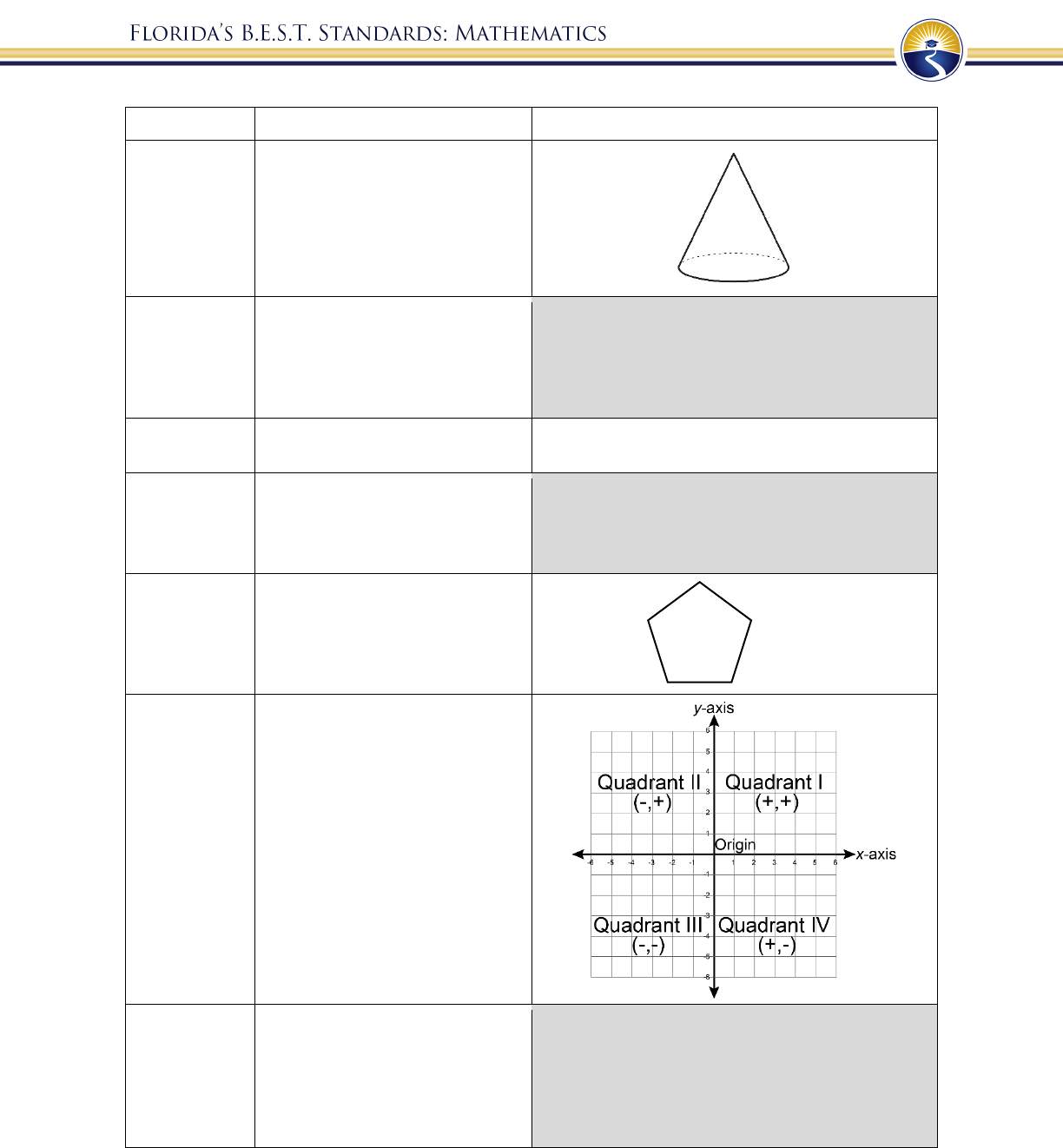
188
Vocabulary
Definition
Example
cone
A three-dimensional figure with a
circular base and an apex that is
connected to the base by a
collection of line segments that
form a curved surface.
congruent
Having exactly the same shape
and size. Equivalently, two figures
are congruent if one can be
mapped to the other using a rigid
transformation.
constant of
proportionality
The constant value of the ratio of
two proportional quantities.
In the equation = , is the constant of
proportionality.
converse of
Pythagorean
Theorem
If the lengths , and of the
three sides of a triangle satisfy the
relationship
+
=
, then
the triangle is a right triangle.
convex
polygon
A polygon with each interior angle
measuring less than 180°. All
diagonals of a convex polygon lie
inside the polygon. See concave
polygon.
coordinate
plane
A plane determined by two
perpendicular number lines called
axes. The axes intersect at the
origin. Each point in the
coordinate plane is represented by
a pair of coordinates that represent
the direction and distance from
each axis. The origin is
represented by the coordinate pair
(0,0).
coordinate
A number used to locate a point
on a number line. One of the
numbers in an ordered pair, or
triple, that locates a point on a
coordinate plane or in coordinate
space, respectively.

189
Vocabulary
Definition
Example
corresponding
angles
Angles that are in the same
position on two parallel lines in
relation to a transversal.
cube
A rectangular prism with six
congruent square faces.
customary
units
The units of measure used in the
United States.
• Customary units for length
include inches, feet, yards,
and miles.
• Customary units for weight
include ounces, pounds, and
tons.
• Customary units for volume
include cubic inches, cubic
feet, and cubic yards.
• Customary units for capacity
include fluid ounces, cups,
pints, quarts, and gallons.
cylinder
(circular)
A figure containing two
congruent, parallel, circular bases
whose edges are connected by a
curved surface. The net of the
cylinder consists of a
parallelogram and two circles.
data
Values that are collected together
for reference or analysis.
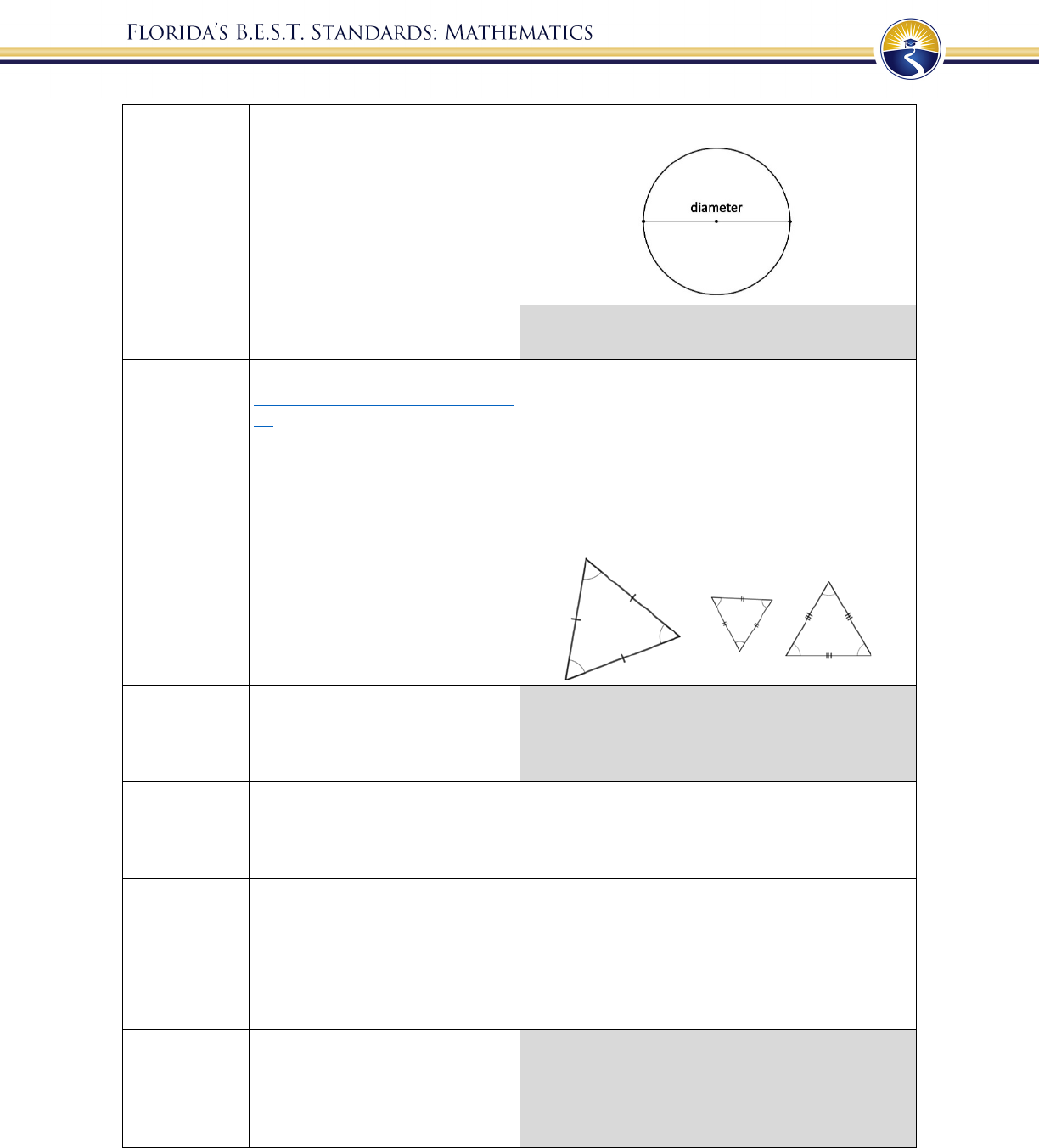
190
Vocabulary
Definition
Example
diameter
A line segment from any point on
the circle passing through the
center to another point on the
circle.
dilation
A proportional increase or
decrease in size in all directions.
distributive
property
Refer to Properties of Operations,
Equality and Inequality (Appendix
D).
(
+
)
= +
domain
The complete set of possible
values of the input of a function or
relation. The domain may vary
depending on the context. See
range (of a relation or function).
In the relation {
(
6, 1
)
,
(
1, 2
)
,
(
4, 6.1
)
,
(
6, 3
)
},
the domain is the set of numbers {6, 1, 4, 6}.
equilateral
triangle
A triangle with three equal-length
sides and three 60° interior angles.
Also known as an equiangular
triangle.
estimation
The use of methods to determine a
reasonably accurate
approximation, without
calculating an exact answer.
event
A set of possible outcomes
resulting from an experiment. In
general, an event is any subset of a
sample space.
In the experiment of rolling a single six-sided die,
an example of an event is {5, 6}. That is, the roll
could be a 5 or a 6.
exponent
(exponential
form)
The number of times the base
occurs as a factor.
is the exponential form of × × . The
variable is called the base, and the numeral 3 is
called the exponent.
exponential
function
An exponential function is a
function with a constant percent
rate of change.
Exponential function can be written in the
form =
, where a 0 and b > 0.
experimental
probability
The ratio of the number of times
an event occurs to the total
number of trials or times the
activity is performed. Also called
empirical probability.
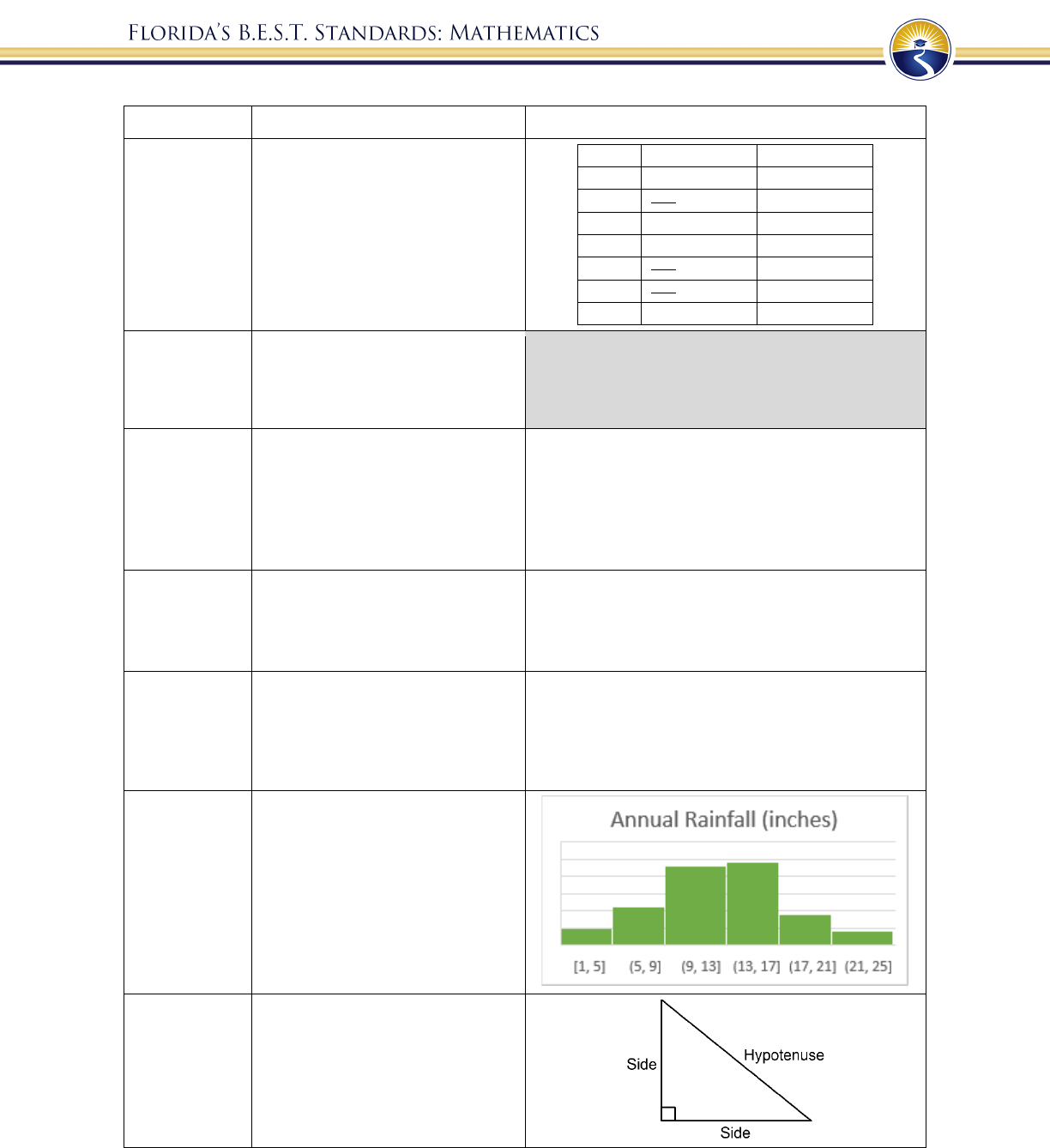
191
Vocabulary
Definition
Example
frequency table
A table that shows how often each
item, number, or range of
numbers
occurs in a set of data.
Size
Tally Marks
Frequency
2
II
2
3
IIII
5
4
IIII
4
5
IIII
4
6
IIII I
6
7
IIII II
7
Total
28
function
A mathematical relation for which
each element of the domain
corresponds to exactly one
element of the range.
function
notation
A notation that describes a
function. For a function when
is a member of the domain, the
symbol
(
)
denotes the
corresponding member of the
range.
(
)
= + 3
geometric
sequence
A sequence of numbers in which
each consecutive pair of numbers
has a common ratio.
The th term an of a geometric sequence with first
term
and common ratio r is given by
=
()
, where is any positive integer,
0
and 0.
greatest
common factor
(GCF) of two
or more whole
numbers
The largest whole number that
evenly divides the given whole
numbers.
7 is the greatest common factor of 14, 28 and 49.
histogram
A visual display of numerical data
using bars along a number line
with no spaces between the bars.
The height of each bar represents
either the frequency or relative
frequency of data within that
interval.
hypotenuse
The longest side of a right
triangle; the side opposit
e the right
angle.
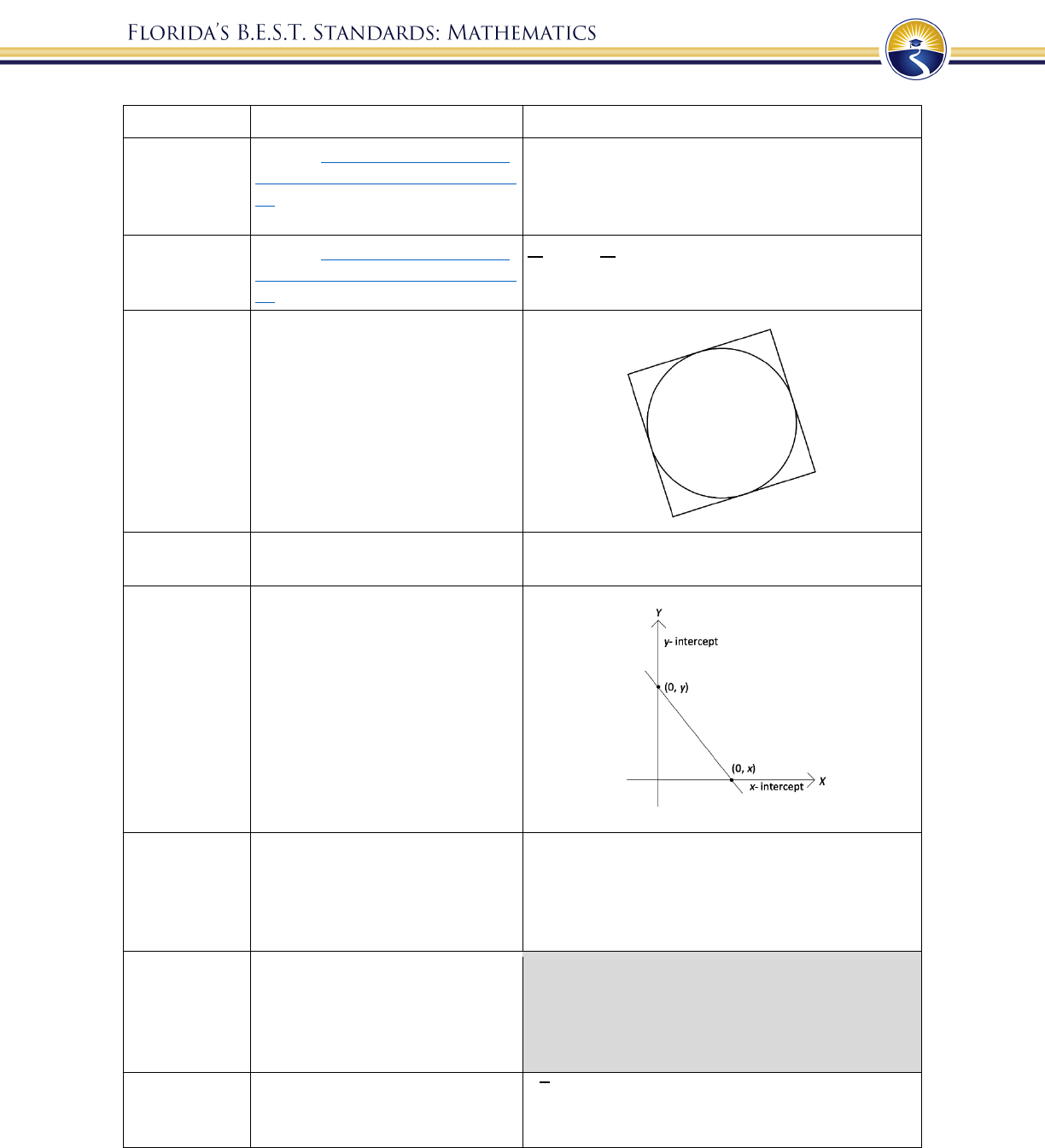
192
Vocabulary
Definition
Example
identity
property of
addition
Refer to Properties of Operations,
Equality and Inequality (Appendix
D).
0 + 4.25 = 4.25
identity
property of
multiplication
Refer to Properties of Operations,
Equality and Inequality (Appendix
D).
× 1 =
inscribed circle
in a polygon
The largest possible circle that can
be drawn in the interior of a
polygon. If it is a regular polygon,
then each side of the polygon is
tangent to the circle.
integers
Whole numbers and their
opposites.
{. . . 4, 3, 2, 1, 0, 1, 2, 3, 4 . . . }
intercept
The value of a variable when all
other variables in the equation
equal 0. On a graph, the values
where a function crosses an axis.
interquartile
range (IQR)
A measure of variation in a set of
numerical data, the interquartile
range is the distance between the
first and third quartiles of the data
set. See quartile and box plot.
Example: For the data set
{1, 3, 6, 7, 10, 12, 14, 15, 22, 120}, the interquartile
range is 15 6 = 9.
inverse
functions
Two functions, =
(
)
and =
(
)
, are said to be inverses when
(
(
)
) = and (
(
)
) = .
The function inverse to () is
denoted
().
irrational
number
A real number that cannot be
expressed as a ratio of two
integers.
2
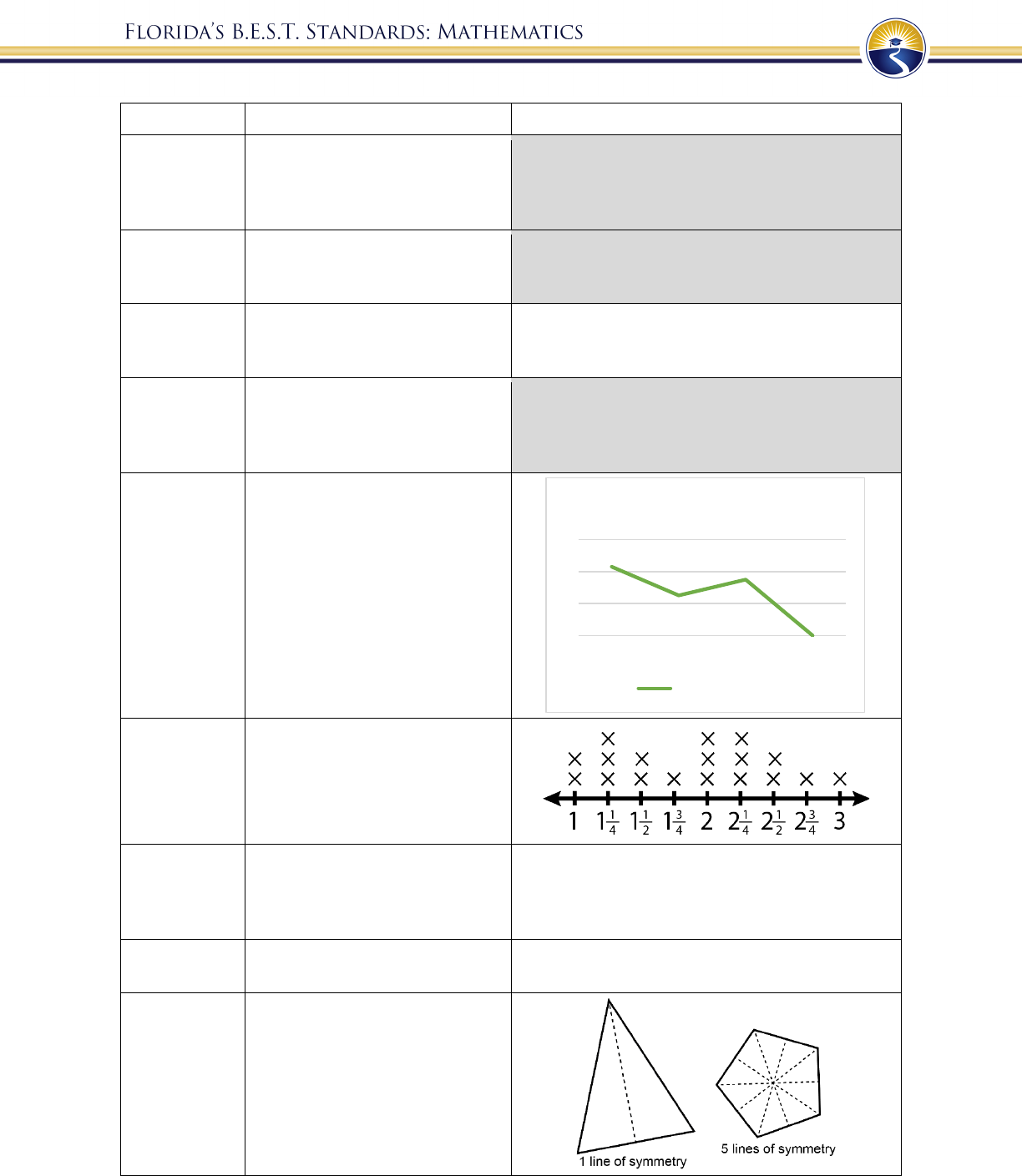
193
Vocabulary
Definition
Example
joint frequency
In a two-way table, joint
frequency is the number of times a
combination of two conditions
occurs.
joint relative
frequency
Joint relative frequency is the ratio
of the joint frequency and the total
number of data points.
least common
multiple
(LCM)
The lowest number that is a
multiple of two or more given
numbers.
The least common multiple of 6 and 9 is 18.
line of fit
A line drawn on a scatter plot to
estimate the relationship between
two sets of data. Also known as a
trend line. See scatter plot.
line graph
A graph that displays numerical
data using connected line
segments.
line plot
A visual display of data values
where each data value is shown as
a dot or mark above a number
line. Also known as a dot plot.
linear
expression (or
linear
equation)
A polynomial expression or
equation that contains a term of
degree 1, but no term of higher
degree.
7 + 6
= 6.4578
linear function
A function that has a constant rate
of change.
A linear function can be written in the form =
+ .
line of
symmetry
A line that divides a figure into
two congruent parts, so that the
reflection of either part across the
line maps precisely onto the other
part.
0
2
4
6
Day 1 Day 2 Day 3 Day 4
Daily Rainfall
Inches of Rainfall
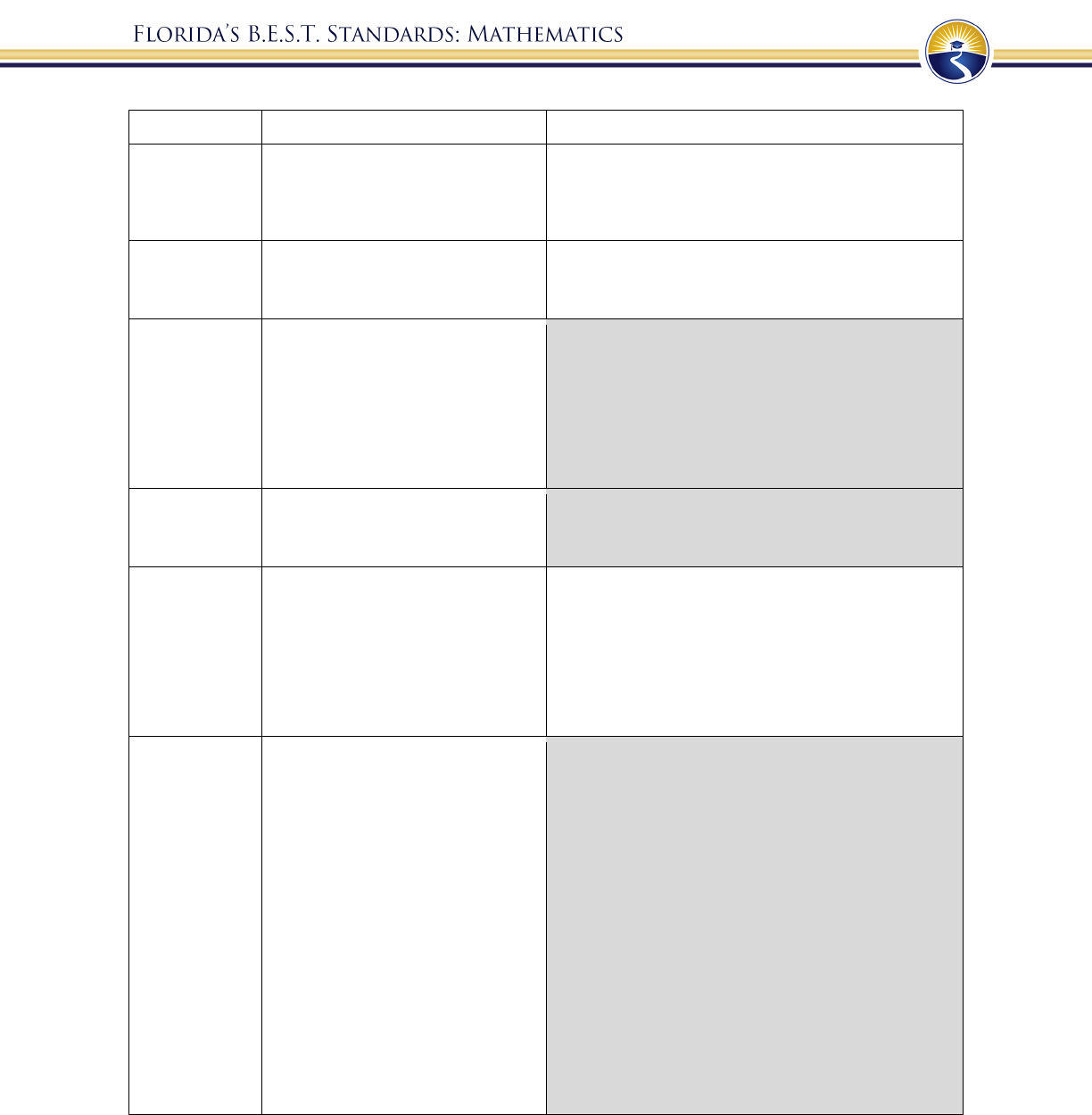
194
Vocabulary
Definition
Example
matrix
A rectangular array of numbers or
variables.
(
)
1 0
0 1
mean
The arithmetic average of a set of
numbers. It is a measure of central
tendency.
For the data set {1, 3, 6, 7, 10, 12, 14, 15, 22, 120},
the mean is 21.
measures of
center
A numerical value used to
describe the overall clustering of
data in a set, or the overall central
value of a set of data. The three
most common measures of central
tendency are the mean, median,
and mode.
measures of
variability
A numerical value that measures
how much a data set varies from a
central value.
median
The middle of an ordered list of
values. If the list has an odd
number of values, it is the middle
value of that list. If the list has an
even number of values, it is the
average of the two middle values.
It is a measure of central tendency.
For the data set
{23, 25, 26, 37, 40, 42, 44, 44, 48, 90}, the median
is 41.
For the data set {4, 7, 8, 11, 14, 16, 20}, the median
is 11.
metric units
The units of measure used in most
of the world. Like the decimal
system, the metric system uses the
base 10.
• Metric units for length include
millimeters, centimeters,
meters, and kilometers.
• Metric units for mass include
milligrams, grams, and
kilograms.
• Metric unit
s for volume include
cubic millimeters, cubic
centimeters, and cubic meters.
• Metric units for capacity
include milliliters, centiliters,
liters, and kiloliters.
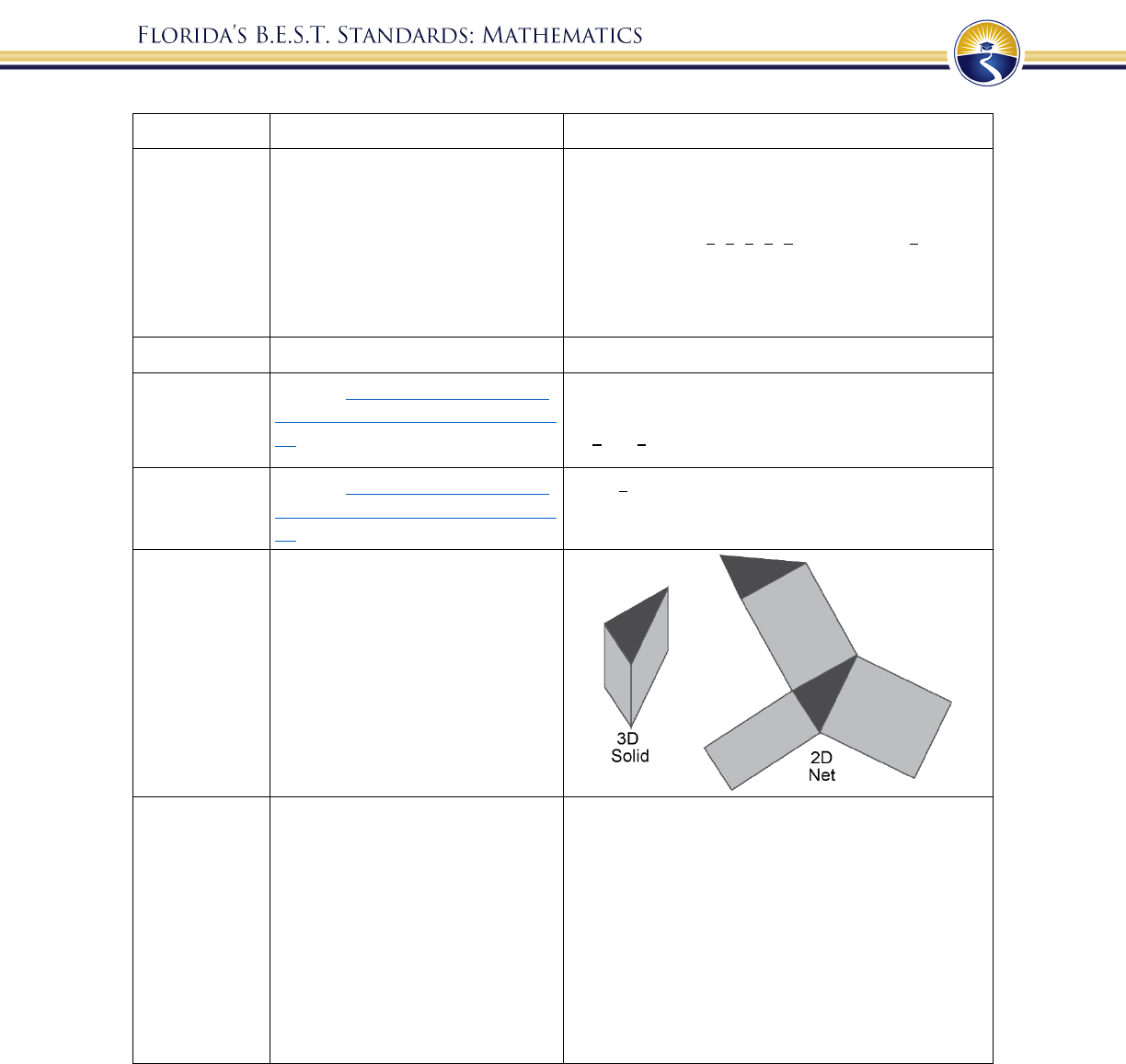
195
Vocabulary
Definition
Example
mode
The value found most often in a
set of numbers. There may be no
mode, one mode, or more
than one
mode in a set of numbers. It is a
measure of central tendency.
For the data set {3.3, 5, 13.7, 6.2, 9.3, 9}, there is no
mode.
For the data set
,
,
,
,
, the mode is
.
For the data set {32, 73, 88, 35, 42, 73, 33, 88, 64},
the modes are 73 and 88.
monomial
A polynomial with one term.
5
, 8, and 4
multiplicative
identity
Refer to Properties of Operations,
Equality and Inequality (Appendix
D).
9 1 = 9
1
=
multiplicative
inverse
(reciprocal)
Refer to Properties of Operations,
Equality and Inequality (Appendix
D).
4 and
. Zero (0) has no multiplicative inverse.
net
A two-dimensional diagram that
can be folded or made into a three-
dimensional figure.
order of
operations
The order of performing
computations is to first work
within grouping symbols using the
order of operations. Then simplify
terms with exponents. Next, while
reading from left to right, perform
multiplication and division in the
order in which it appears. Finally,
while reading from left to right,
perform addition and subtraction
in the order in which it appears.
5
+
(
12 2
)
÷ 2 3 × 2
5
+ (10) ÷ 2 3 × 2
25 + 10 ÷ 2 3 × 2
25 + 5 6
30 6
24
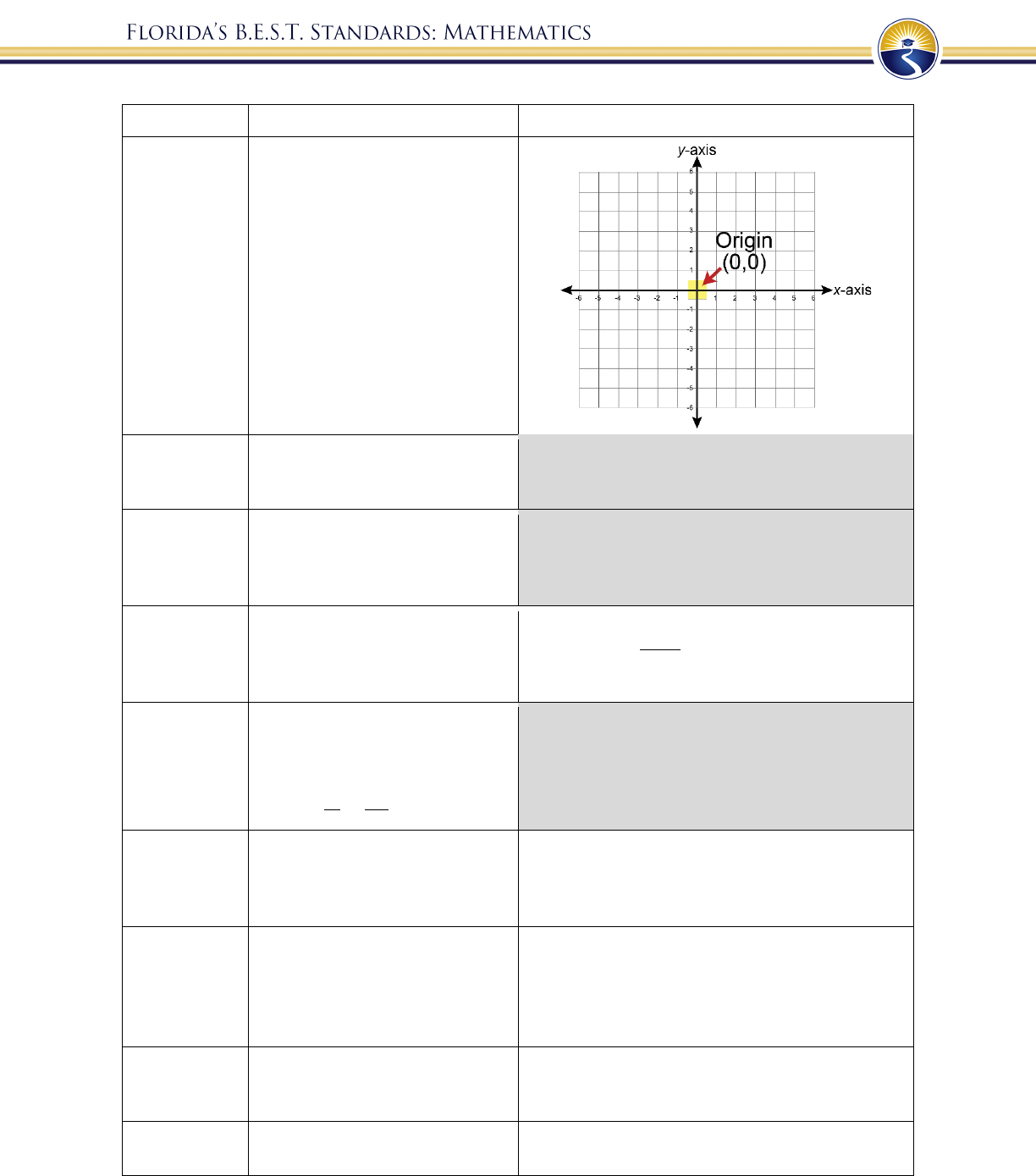
196
Vocabulary
Definition
Example
origin
The point of intersection of the -
and -axes in a rectangular
coordinate system, where the -
coordinate and -coordinate are
both 0.
outlier
A value that is much higher or
much lower than the other values
in a set of data.
percent of
change
The difference between a final
value and an initial value,
expressed as a percentage of the
initial value.
percent error
The difference between the
estimated number and the actual
number as a percentage of the
actual value.
If the estimate is 95 and the actual is 89, the
percent error is
6.74%.
pi (π)
The symbol designating the ratio
of the circumference of a circle to
its diameter. It is an irrational
number. Common approximations
are 3.14,
or
.
piecewise
function
A function defined by multiple
sub functions, each of which
applies to a certain interval of the
main function’s domain.
An absolute value function, =
|
|
, is an example
of a piecewise function.
polynomials
The sum or difference of terms
which have variables raised to
non-negative integer powers and
which have coefficients that may
be real or complex.
5
2
+ 13
+
(
1 +
)
+
population (in
data analysis)
The entire set of cases or
individuals under consideration in
a statistical analysis.
A poll given to a sample of voters is designed to
measure the preferences of the population of all
voters.
prime
factorization
The expression of a number as the
product of prime factors.
The prime factorization of 72 is
2 × 2 × 2 × 3 × 3.
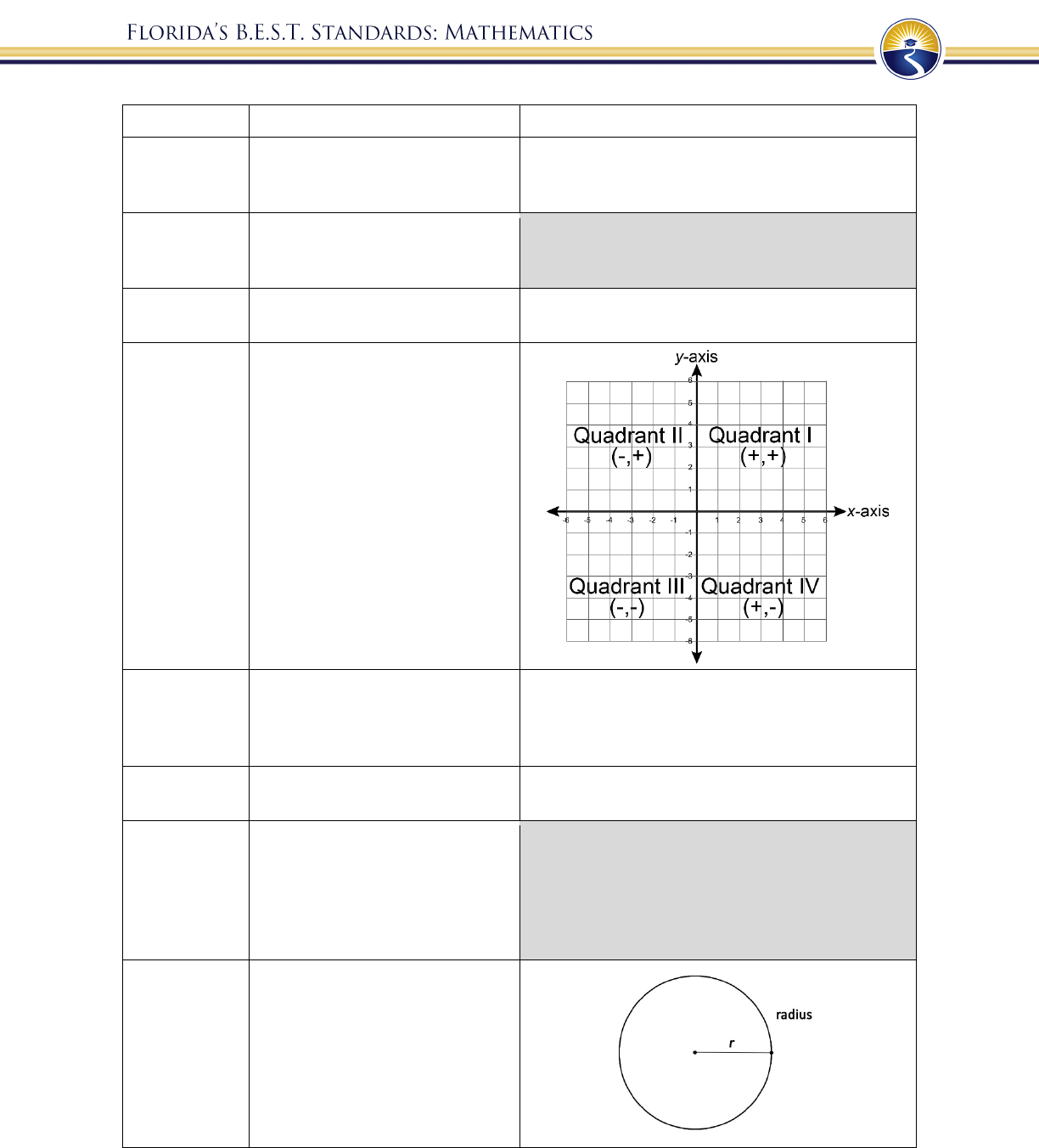
197
Vocabulary
Definition
Example
prime number
A whole number greater than 1
that is not divisible by any whole
number other than 1 and itself.
17 is a prime number.
16 is not a prime number.
principal
square roots
The principal square root is the
positive square root of a real
number.
proportional
relationships
A collection of pairs of numbers
that are in equivalent ratios.
If = , then is said to be directly proportional
to and the constant of proportionality is .
quadrant
Any of the four regions separated
by the axes in a coordinate plane.
quadratic
expression (or
quadratic
equation)
A polynomial expression or
equation that contains a term of
degree 2, but no term of higher
degree.
8 4+ 9.2
8.3 = 3(+ 2.1)
quadratic
function
A polynomial function with
degree of 2.
A quadratic function can be expressed in the form
=
+ + .
quartiles
For a data set with median M, the
first quartile is the median of the
data values less than M and the
third quartile is the median of the
data values greater than M. The
second quartile is the median M.
radius
A line segment extending from the
center of a circle or sphere to a
point on the circle or sphere.
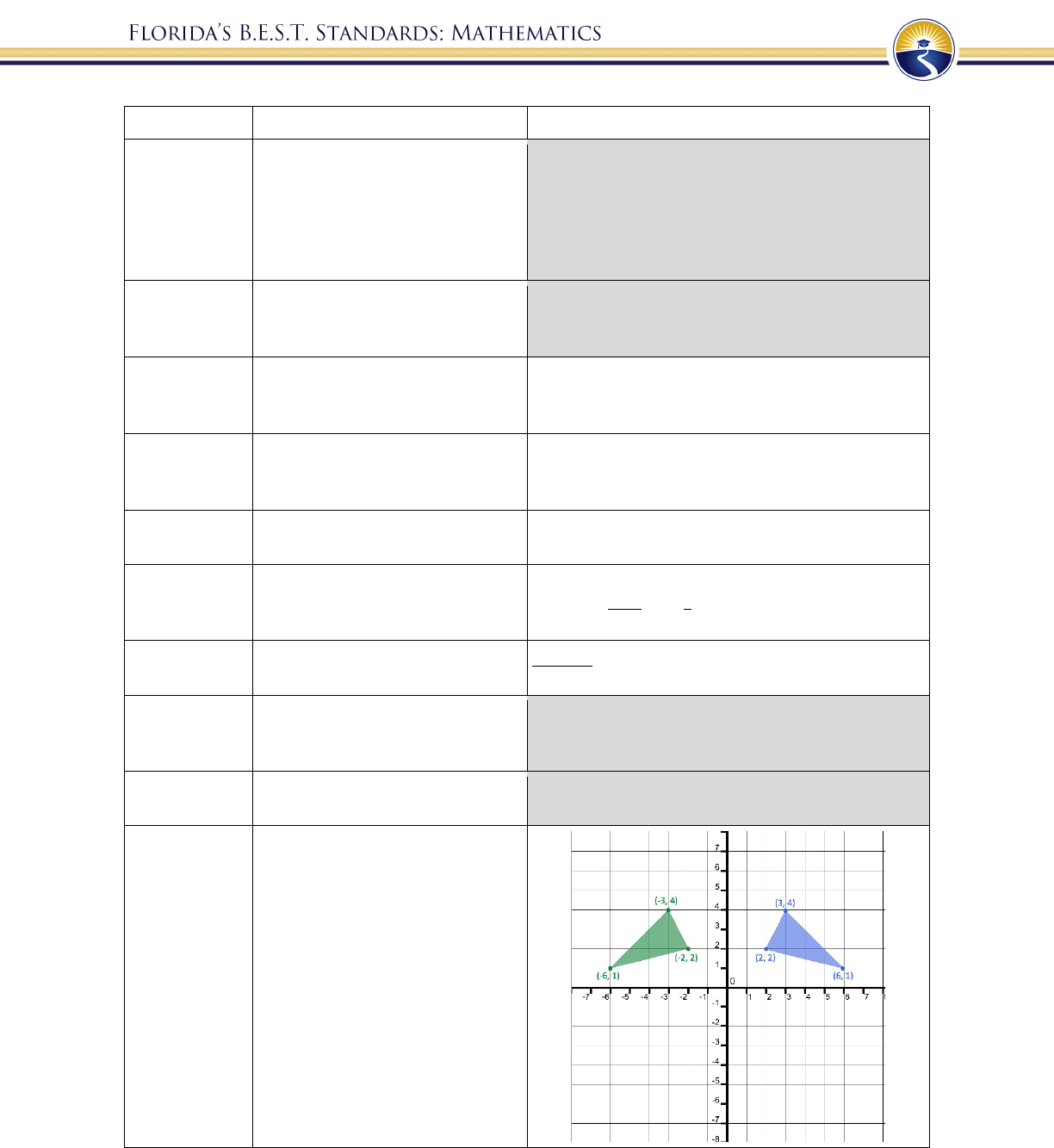
198
Vocabulary
Definition
Example
random
sampling
A smaller group of people or
objects chosen from a larger group
or population by a process giving
equal chance of selection to all
possible people or objects, and all
possible subsets of the same size.
random
variable
An assignment of a numerical
value to each outcome in a sample
space.
range (of a
data set)
The difference between the
highest data value and the lowest
data value.
For the data set {3.3, 5, 13.7, 6.2, 9.3, 9}, the range
is 10.4.
range (of a
relation or
function)
The complete set of possible
values of the output of a relation
or function. See domain.
In the relation {
(
6, 1
)
,
(
1, 2
)
,
(
4, 6.1
)
,
(
6, 3
)
},
the range is the set of numbers {3, 1, 2, 6.1}.
rate
A ratio that compares two
quantities of different units.
feet per second
rate of change
The ratio of change in one
quantity to the corresponding
change in another quantity.
Given the order pairs (7, 5) and (0, 11), the rate of
change is
=
.
rational
expression
A quotient of two polynomials
with a non-zero denominator.
rational
number
A real number that can be
expressed as the ratio of two
integers.
real numbers
The set of all rational and
irrational numbers.
reflection
A transformation that produces the
mirror image of a geometric figure
across a line of reflection.

199
Vocabulary
Definition
Example
regular
polygon
A polygon that is both equilateral
(all sides congruent) and
equiangular (all angles congruent).
relation
A set of input-output pairs.
repeated
experiment
A random experiment done with
the same conditions and
parameters as a previous one.
rigid
transformation
A transformation of points in
space consisting of a sequence of
one or more translations,
reflections, or rotations. Rigid
transformations preserve distances
and angle measures (congruency).
rotation
A transformation of a figure by
turning it about a center point or
axis. The amount of rotation can
be expressed in the number of
degrees. The direction of the
rotation for two-dimensional
figures can be expressed as
clockwise or counterclockwise.
sample space
In a probability model for a
random process, a list of the
individual outcomes that are to be
considered.
scale
The numeric values, set at fixed
intervals, assigned to the axes of a
graph.
scale factor
The constant that is multiplied by
the length of each side of a figure
to produce an image that is the
same shape as the original figure.
scale model
A model or drawing based on a
ratio of the dimensions for the
model and the actual object it
represents.
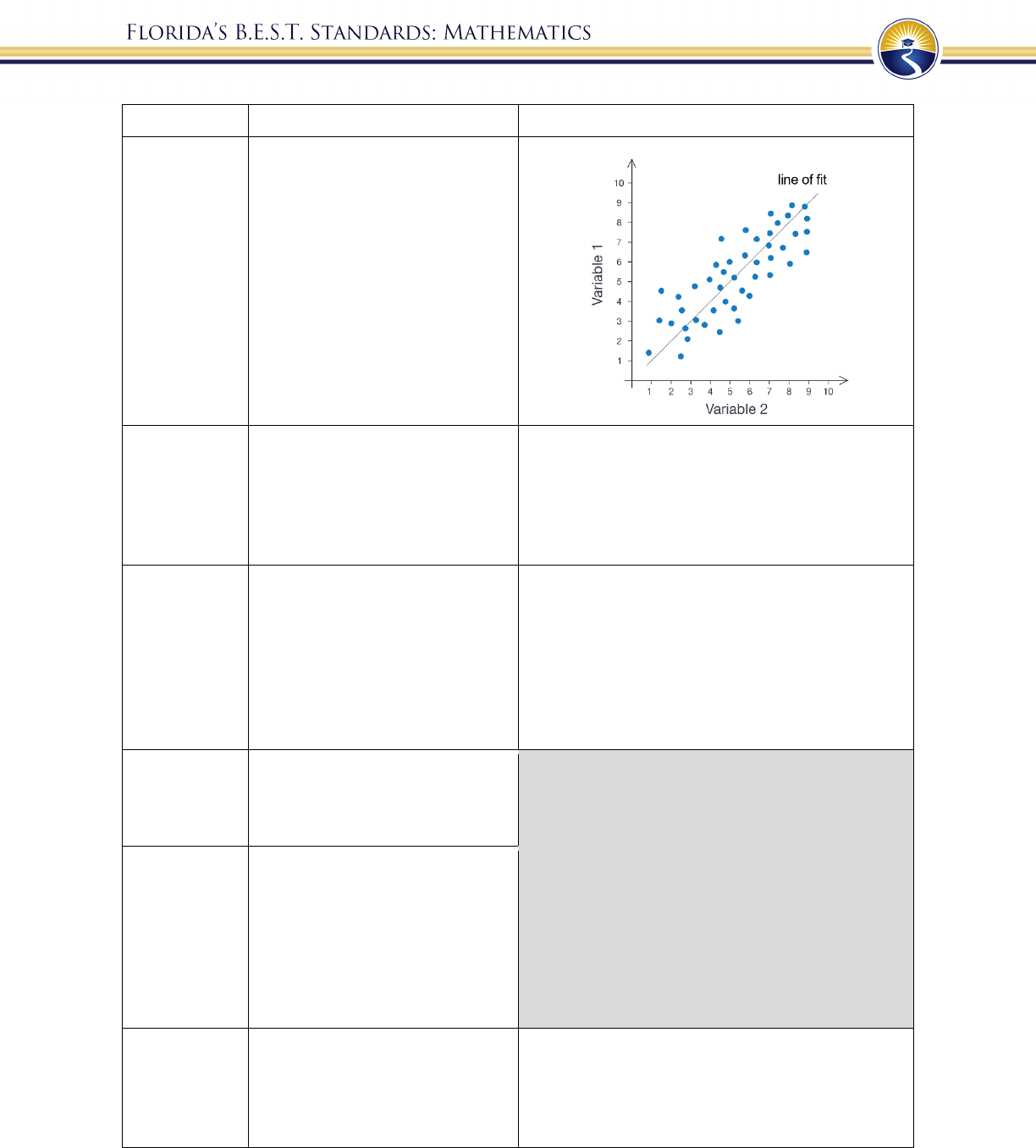
200
Vocabulary
Definition
Example
scatter plot
A graph in the coordinate plane
representing a set of bivariate
numerical data that is used to
observe the relationship between
two variables. See line of fit.
scientific
notation
A method of writing very large or
very small numbers using
exponents in which a number is
expressed as the product of a
power of 10 and a number that is
between 1 and 10.
7.59 × 10
= 759,000
set-builder
notation
A shorthand used to write sets,
often sets with an infinite number
of elements. The set {: > 0} is
read aloud, "the set of all such
that is greater than 0." It is read
aloud exactly the same way when
the colon : is replaced by the
vertical line | as in {| > 0}.
{: 3} - the set of all real numbers except 3.
{
|
< 5} - the set of all real numbers less than 5.
{2+ 1: is an integer} - the set of all odd
integers (e.g. ..., 3, 1, 1, 3, 5...).
significant
digits
The nonzero digits of a number
and the zeros that are included
between them or any trailing zeros
that are considered to be precise.
similarity
Having exactly the same shape but
not necessarily the same size.
Equivalently, two figures are
similar if one can be mapped to
the other using a rigid
transformation combined with a
dilation, including cases with a
scale factor of 1.
simple interest
A method of computing interest.
Interest is computed from the
(original) principal alone no
matter how much money has
accrued so far.
= (1 + ), where
= final amount
= principal, or original amount
= number of years
= rate of interest per year
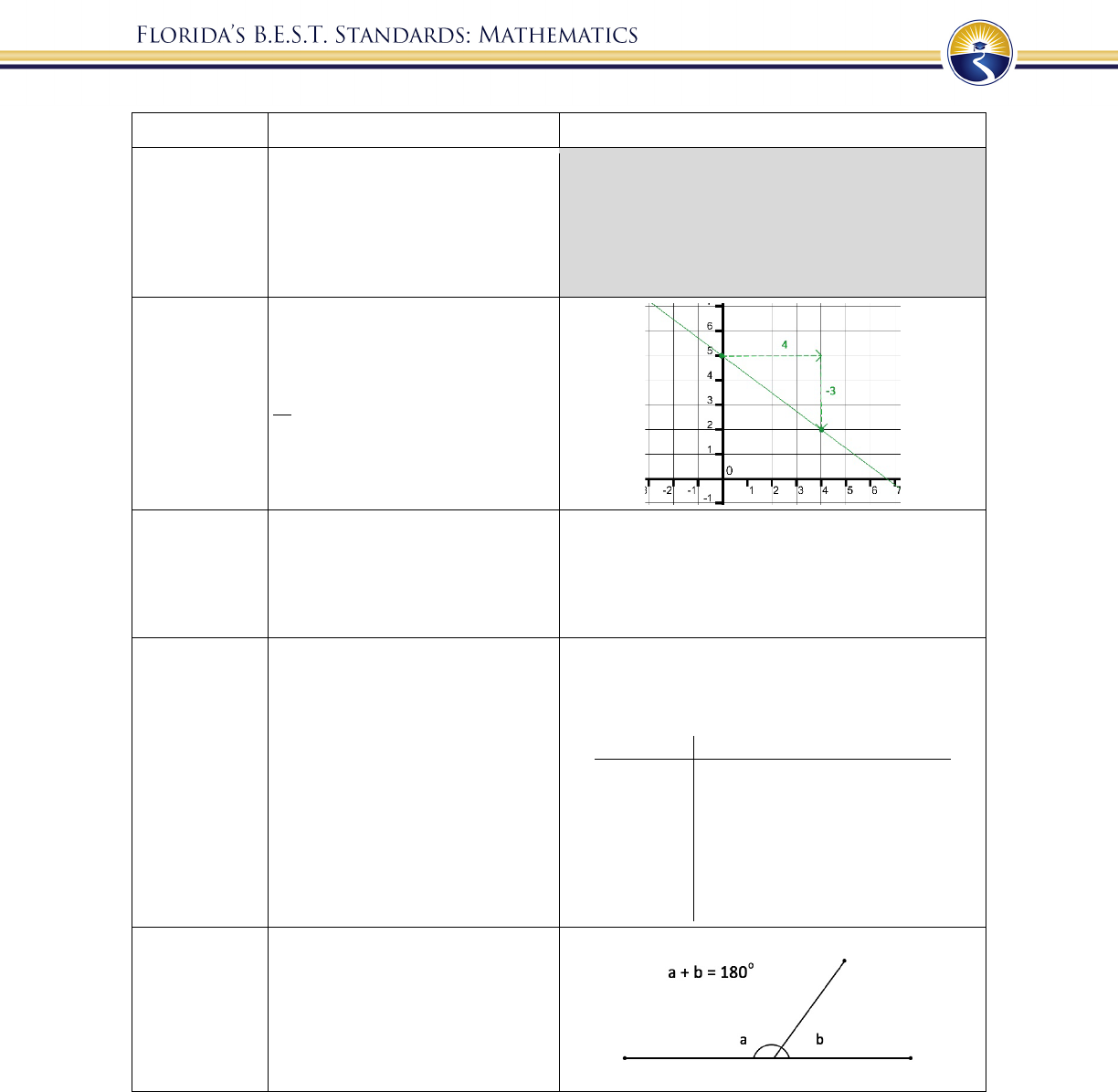
201
Vocabulary
Definition
Example
simulation
A simulation is an approximate
imitation of a statistical
experiment, often done with a
computer program to examine the
statistics of a large quantity of
trials.
slope
The ratio of the change in the
vertical direction ( direction) to
change in the horizontal direction
( direction), often expressed as
.
statistical
question
A question that can be answered
by collecting data. Often there will
be variability in the data.
What time of the day do students get home from
school?
What type of toppings do 7
th
graders like on their
pizza?
stem-and-leaf
plot
A table that organizes data by
place value to compare data
frequencies.
The data set {1, 4, 5, 8, 10, 11, 13, 27, 27, 28, 30,
31, 31, 40, 44, 63, 66} can be organized in a stem-
and-leaf plot as shown below.
stem
leaf
0
1, 4, 5, 8
1
0, 1, 3,
2
7, 7, 8
3
0, 1, 1,
4
0, 4,
5
6
3, 6
supplementary
angles
Two angles with measures the
sum of which is exactly 180°.

202
Vocabulary
Definition
Example
theoretical
probability
A number between 0 and 1
representing the likelihood of an
event in a theoretical model based
on a sample space. If all outcomes
in the sample space are equally
likely, then theoretical probability
of an event is the ratio of the
number of outcomes in the event
to the number of outcomes in the
sample space.
translation
A transformation in which every
point in a figure is moved in the
same direction and by the same
distance.
If the preimage has the coordinates (2, 4), (4, 2)
and (2, 1) and is translated to the left 6 units, its
image will have the coordinates (4, 4), (2, 2)
and (4, 1).
transversal
A line that intersects two or more
lines in the same plane at different
points.
trigonometric
function
Any of the six functions (sine,
cosine, tangent, cotangent, secant,
cosecant) that, for an acute angle
of a right triangle, may be
expressed in terms of ratios of
sides of the right triangle.
unit rates
A ratio comparing a number of
units of one quantity to one unit of
a second quantity.
vertical angles
The opposite angles formed when
two lines intersect.
-intercept
The value of at the point where
a line or graph intersects the -
axis. The value of is 0 at this
point.
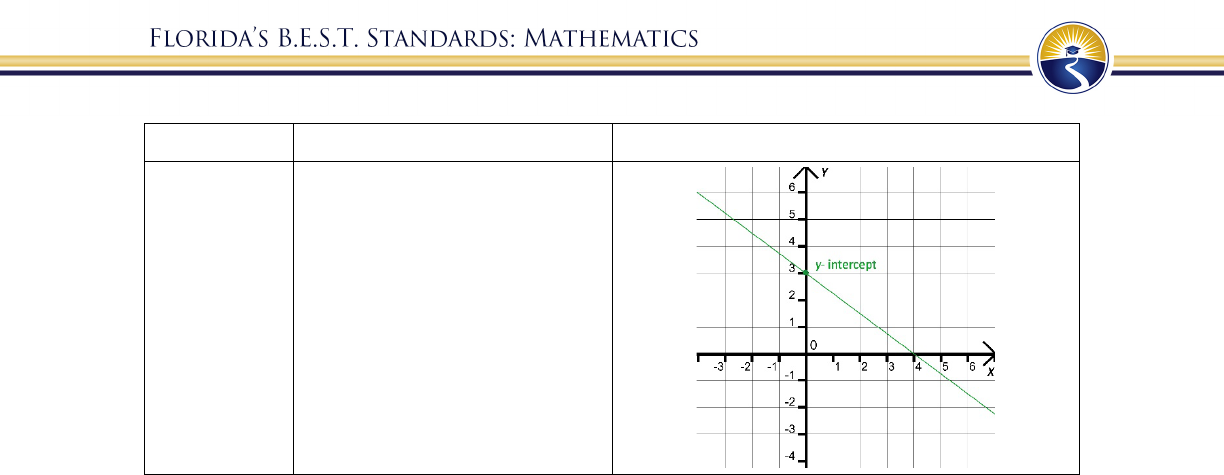
203
Vocabulary
Definition
Example
-intercept
The value of at the point where
a line or graph intersects the -
axis. The value of is 0 at this
point.
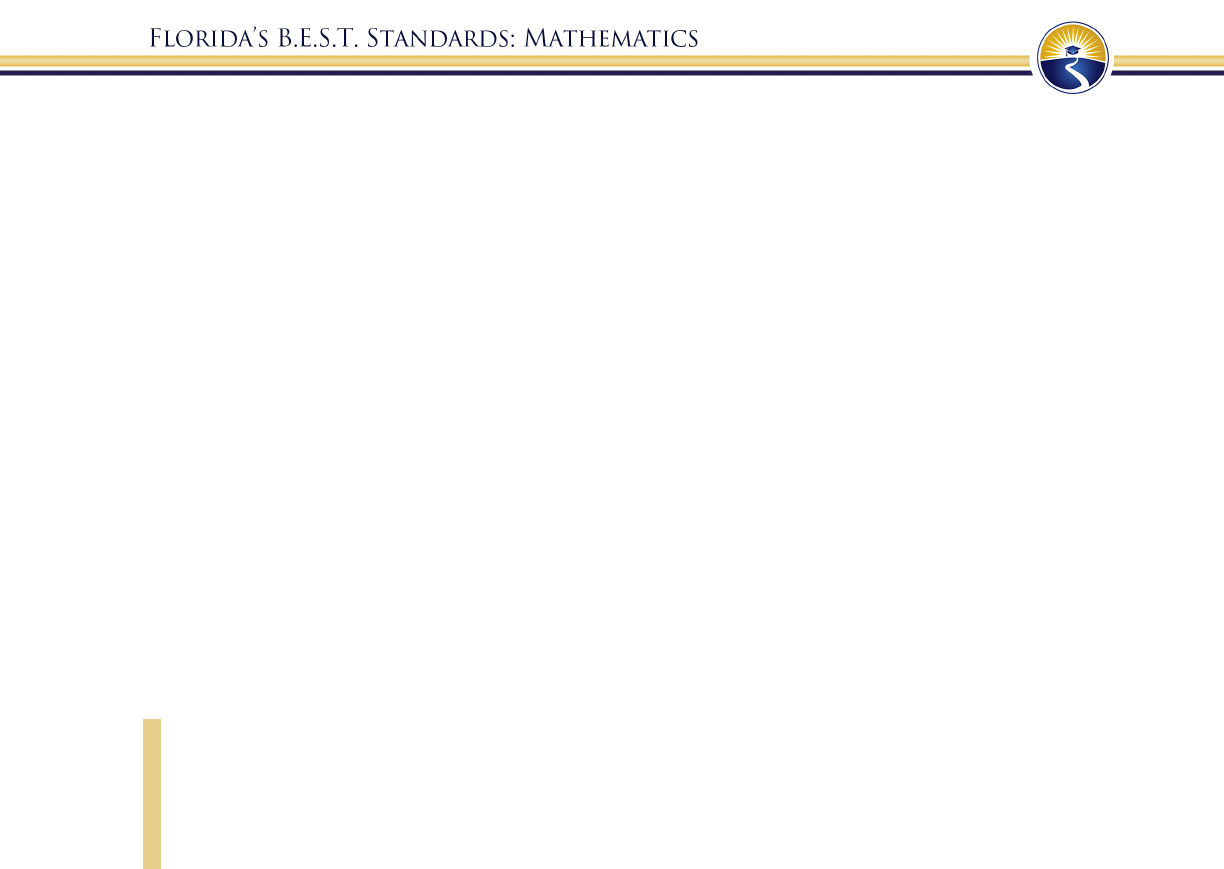
204
Appendix D: Properties of Operations,
Equality and Inequality

205
Properties of Operations
The table below illustrates the properties of operations. For each property, the variables
, and stand for arbitrary numbers in a given number system. The properties of operations
apply to the rational number system, the real number system and the complex number system.
Property of Operation
Example
Associative property of addition
(
+
)
+ = + (+ )
Commutative property of addition
+ = +
Additive identity property of zero
+ 0 =
0 + =
Existence of additive inverses
For every there exists so that +
(
)
= 0 and
() + = 0.
Associative property of multiplication
(
×
)
× = × (× )
Commutative property of multiplication
× = ×
Multiplicative identity property of one
× 1 =
1 × =
Existence of multiplicative inverses
For every 0 there exists
so that ×
= 1 and
× = 1.
Distributive property of multiplication
over addition
×
(
+
)
= (× ) + (× )
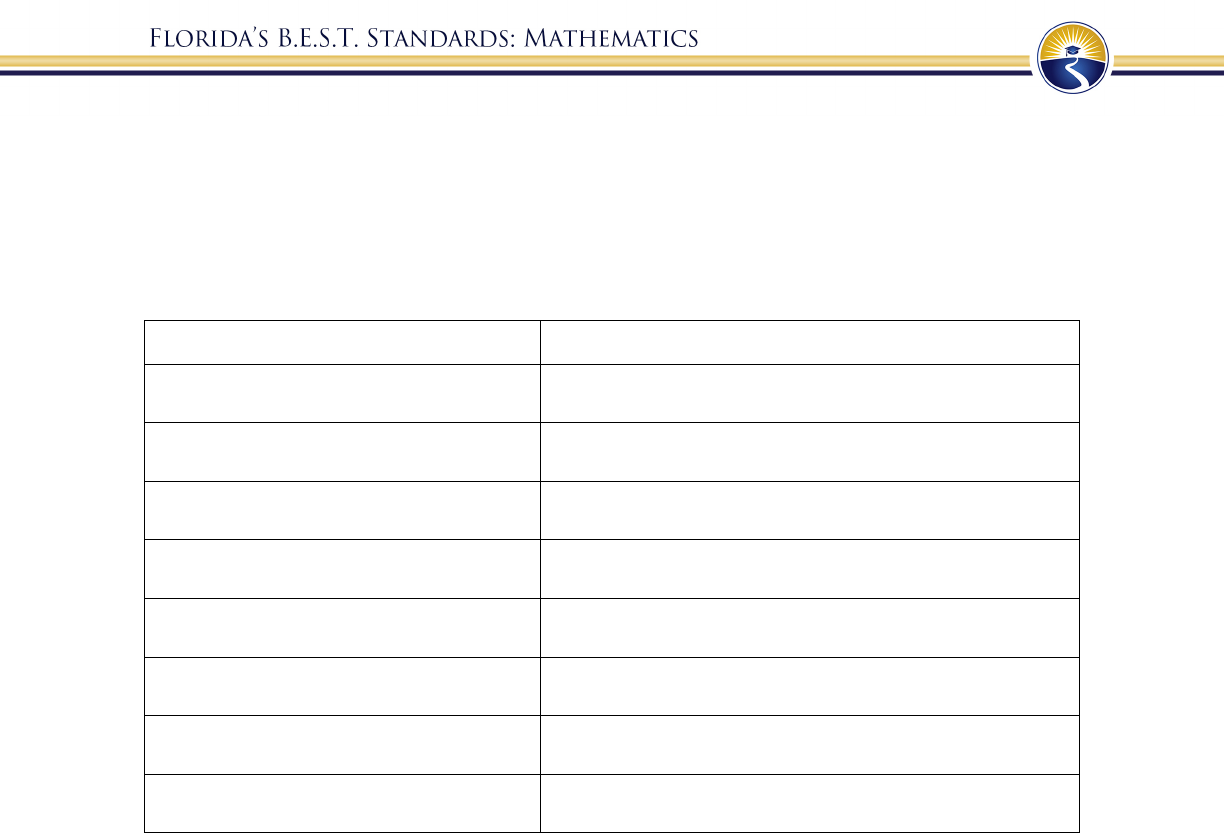
206
Properties of Equality
The table below illustrates the properties of equality. For each property, the variables ,
and stand for arbitrary numbers in a given number system. The properties of equality apply to
the rational number system, the real number system and the complex number system.
Property of Equality
Example
Reflexive property of equality
=
Symmetric property of equality If = , then = .
Transitive property of equality
If = and = , then = .
Addition property of equality
If = , then + = + .
Subtraction property of equality
If = , then = .
Multiplication property of equality
If = , then × = × .
Division property of equality
If = and 0, then ÷ = ÷ .
Substitution property of equality
If = , then may be substituted for in any
expression containing .

207
Properties of Inequality
The table below illustrates the properties of inequality. For each property, the variables ,
and stand for arbitrary numbers in a given number system. In addition, exactly one of the
following is true: < , = or > . The properties of inequality apply to the rational
number system and the real number system.
Property of Inequality
Example
Asymmetric property of inequality
If > , then < .
Transitive property of inequality
If > and > , then > .
Addition property of inequality
If > , then + > + .
Subtraction property of inequality
If > , then > .
Multiplication property of inequality
If > and > 0, then × > × .
If
>
and
< 0
, then
× < ×
.
Division property of inequality
If > and > 0, then ÷ > ÷ .
If > and < 0, then ÷ < ÷ .

208
Appendix E: K-12 Formulas
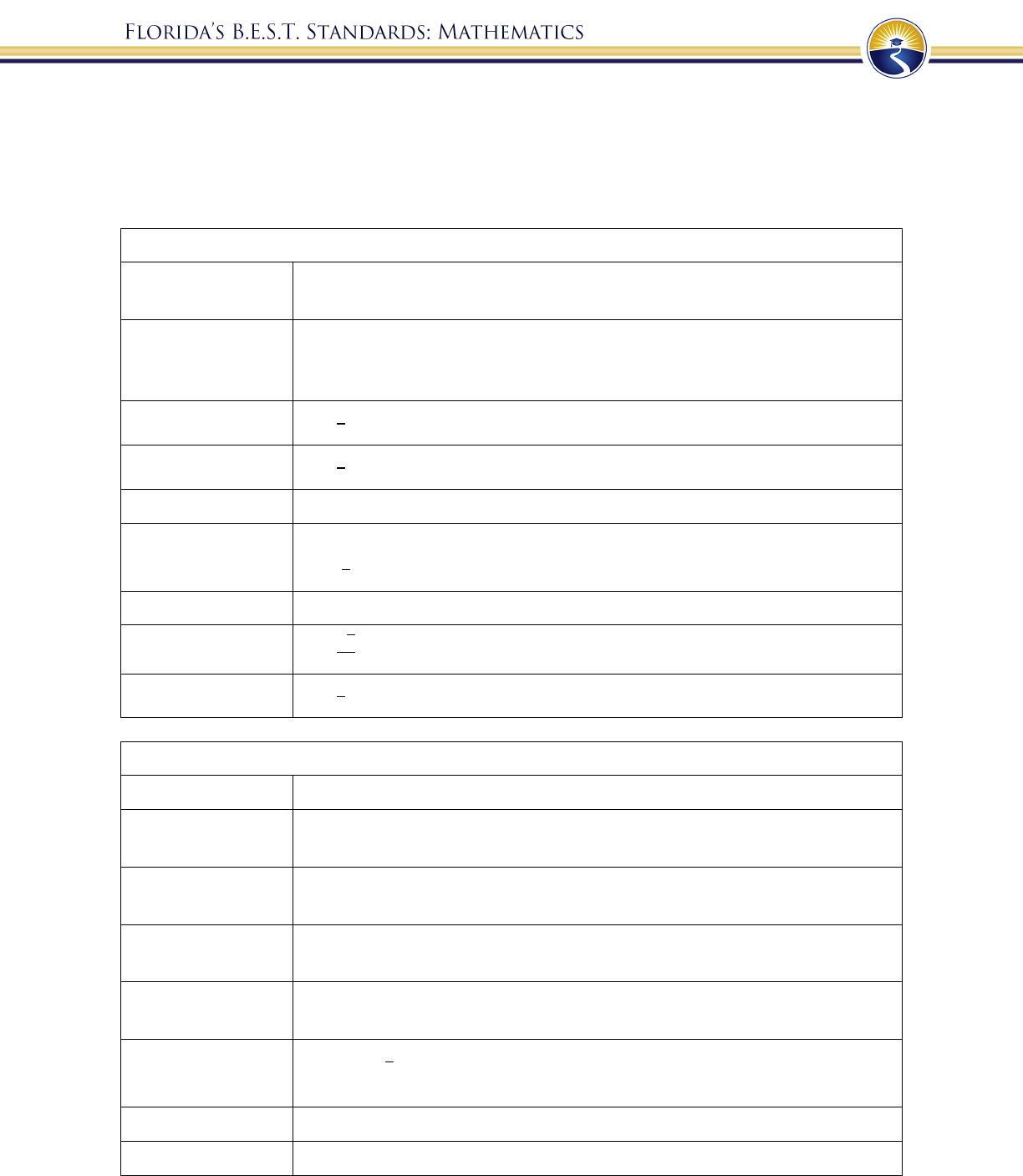
209
K-12 Formulas
The following formulas are provided for teachers and are not intended to comprise a
comprehensive formula list for students. The formulas defined in the table below pertain to the
Florida Mathematics Benchmarks for Grades K-12.
Area of a two-dimensional figure
Rectangle
= , where is the length and is the width
= , where is the base and is the height
Square
= , where is the length and is the width
= , where is the base and is the height
=
, where is the side length
Triangle
=
, where is the base and is the height
Trapezoid
=
(
+
)
, where
and
are the bases and is the height
Parallelogram
= , where is the base and is the height
Rhombus
= , where is the base and is the height
=
, where
and
are the diagonals
Circle
=
, where is the radius
Equilateral triangle
=
, where is the side length
Regular Polygon =
, where is the perimeter and is the apothem
Surface Area of a three-dimensional figure
Cube
= 6
, where is the side length
Prism
= 2+ , where is the area of the base, is the perimeter of the
base and is the height
Cylinder
= 2+ , where is the area of the base, is the perimeter of the
base and is the height
Cone
= +
, where is the area of the base, is the radius and
is
the slant height
Pyramid
= + ( ), where is the area of the base and (each
face) is the area of each face
Regular pyramid
= +
, where is the area of the base, is the perimeter of the
base and
is the slant height
Sphere
= 4
, where is the radius
Hemisphere
= 3
, where is the radius and the area of the flat side is included
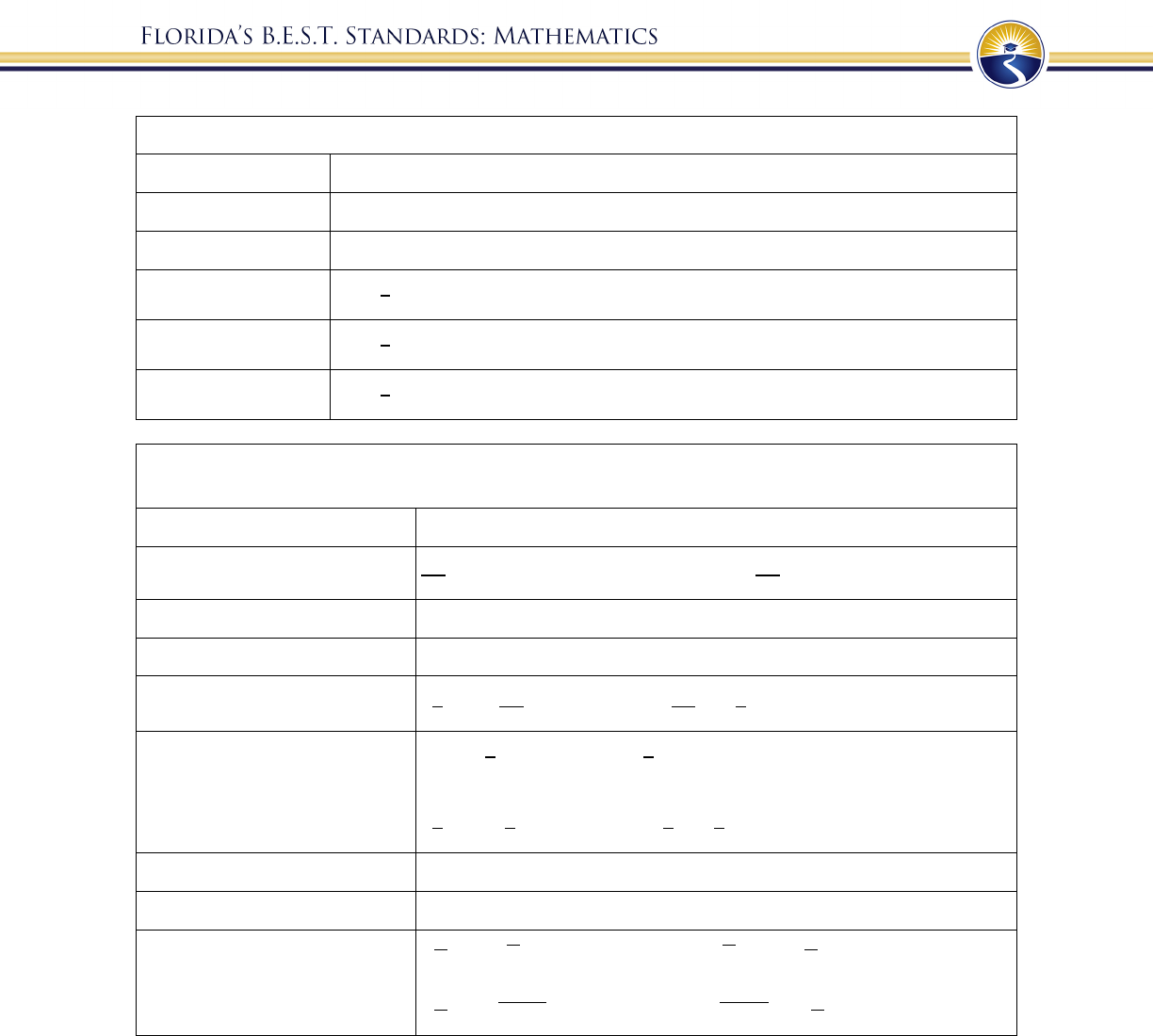
210
Volume of a three-dimensional figure
Cube
=
, where is the side length
Prism
= , where is the area of the base and is the height
Cylinder
= , where is the area of the base and is the height
Cone =
, where is the area of the base and is the height
Pyramid =
, where is the area of the base and is the height
Sphere =
, where is the radius
Laws of Exponents
(where and are integers and and are real numbers)
Product of powers
=
and conversely
=
Quotient of powers
=
and conversely
=
Power of a power
(
)
=
and conversely
= (
)
Power of a product
()
=
and conversely
= ()
Power of a quotient
=
and conversely
=
, where 0
Negative exponent
=
and conversely
=
, where 0
=
and conversely
=
, where , 0
Identity exponent
=
Zero exponent
= 1, where 0
Rational,
Fractional exponent
=
and conversely
=
, where 0
=
(
)
and conversely
(
)
=
, where
0

